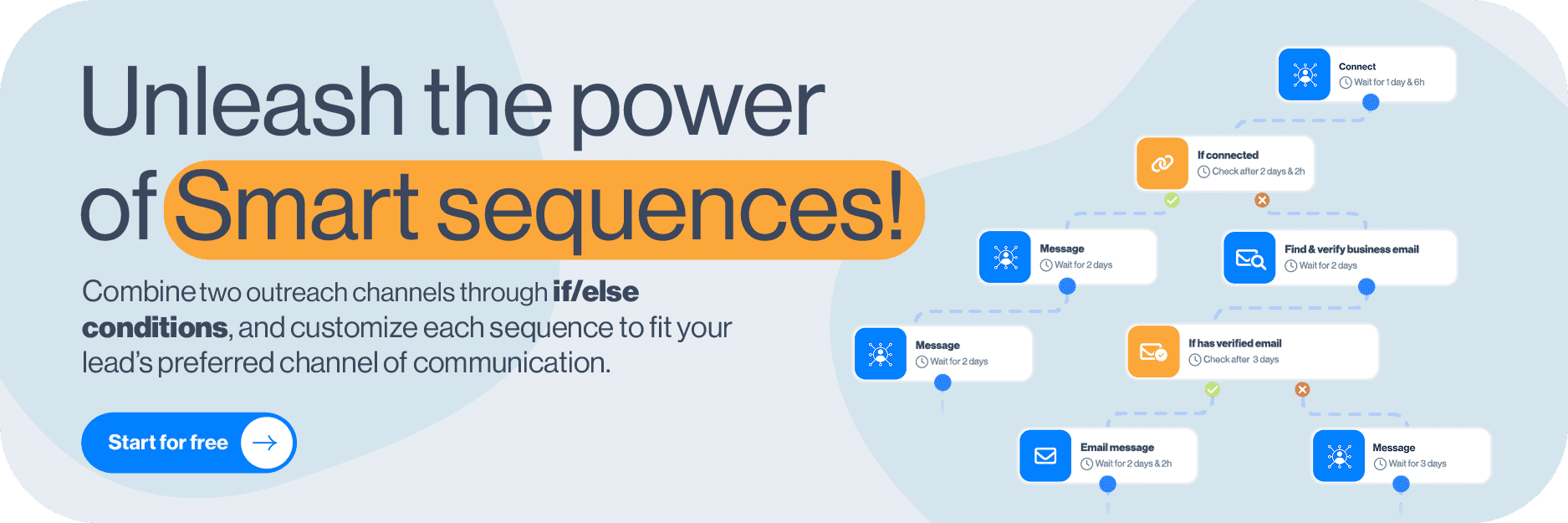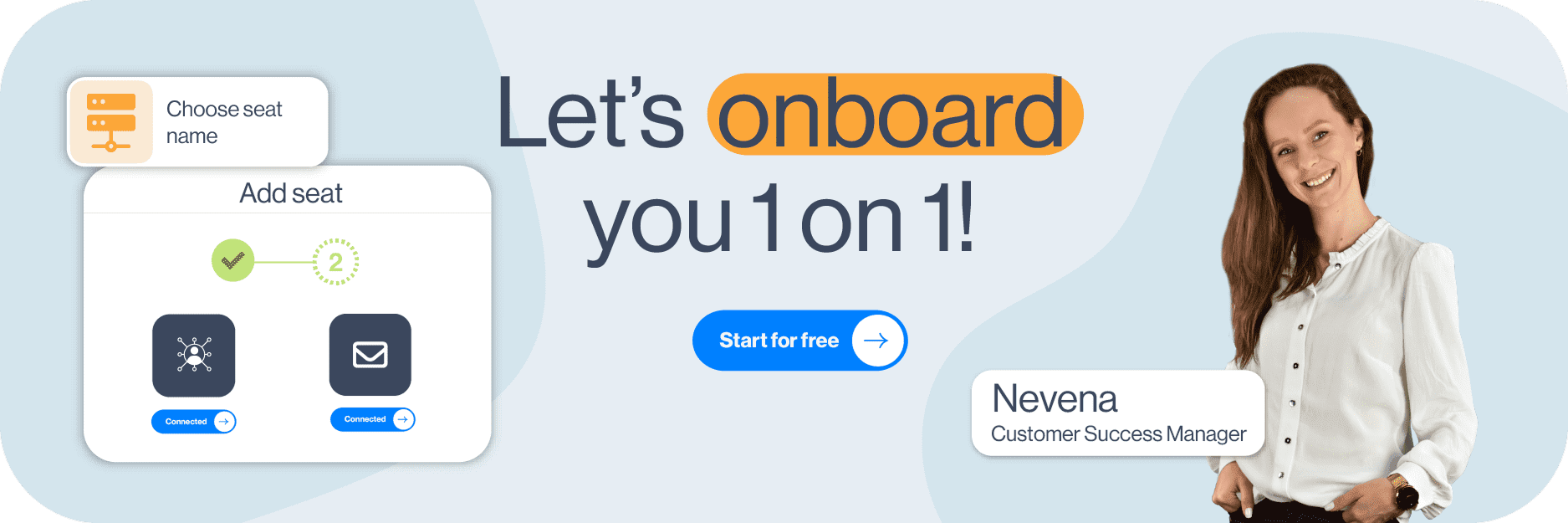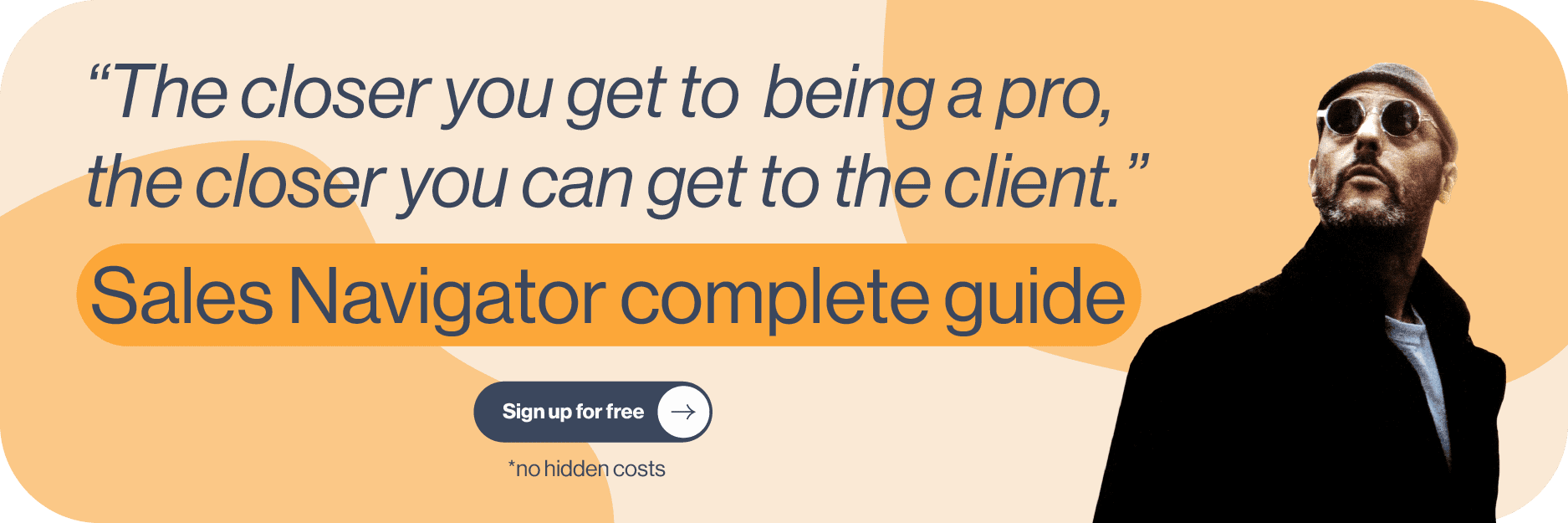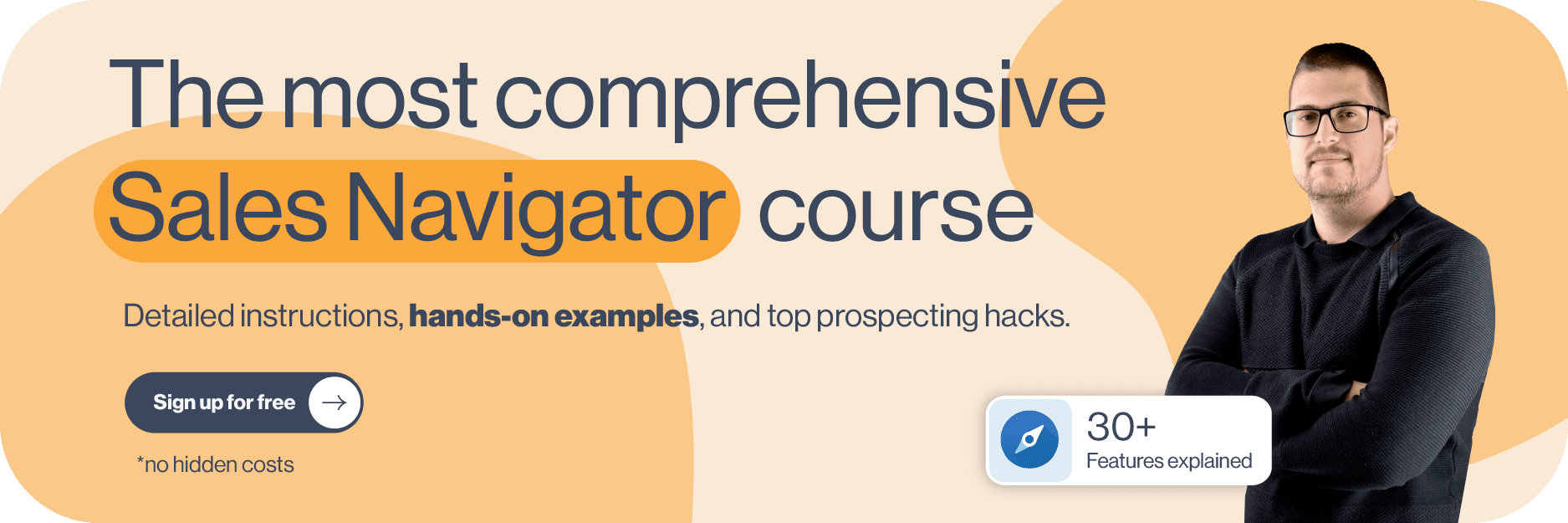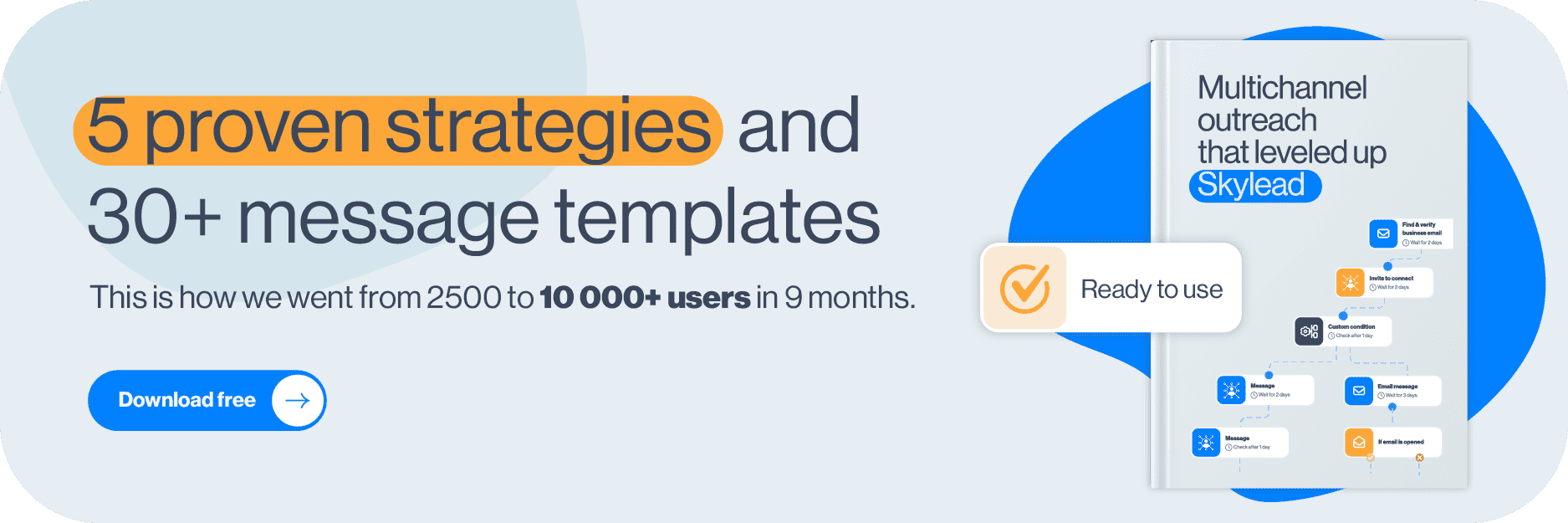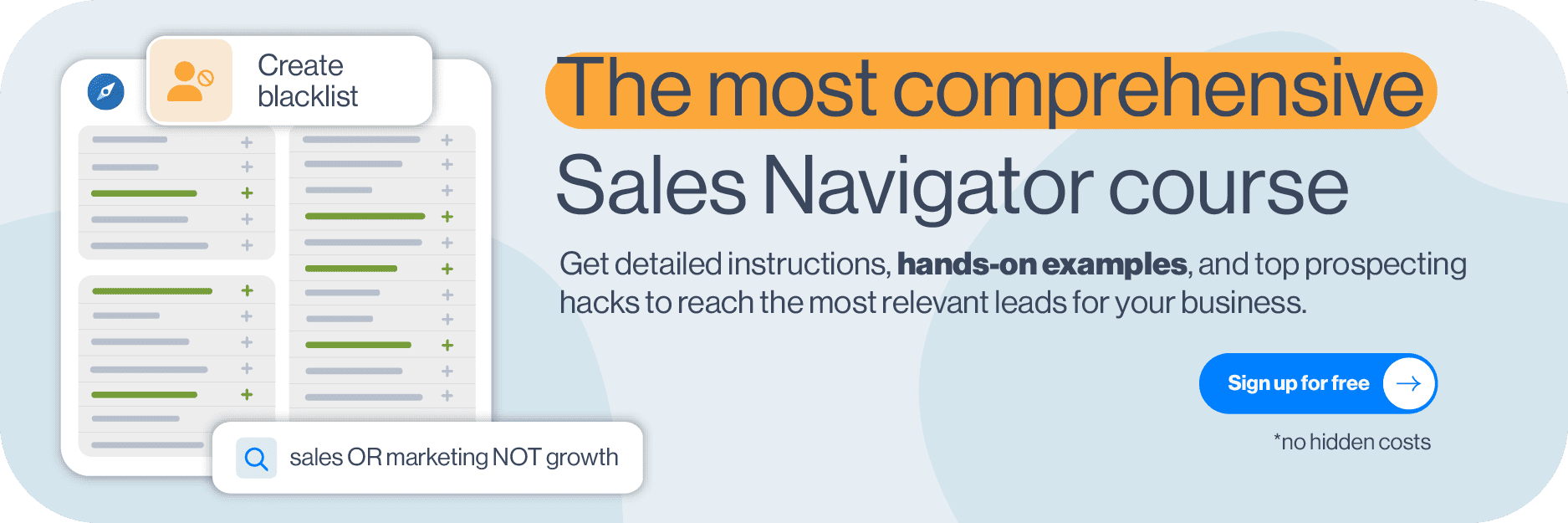If you are looking to scale your outreach, you've likely come across Instantly.ai. This cold outreach software, launched in 2021, promises to help you find, contact, and close your ideal clients.
But before you commit to it, there are a few things to consider.
Is it worth the investment?
What do others have to say about it?
And how does it compare to other tools on the market?
If you're ready to get answers to these questions, dive into our review that reveals:
- Notable Instantly.ai features
- Downsides to using it
- Real users’ opinions on the tool
- How much it costs
We’ve even added a list of 12 alternatives, just in case Instantly features do not fulfill your business needs.
Let’s jump right in!
Instantly.ai or alternatives?
Instantly.ai is one of the best cold email software and an email management platform that’s quickly become popular for email outreach.
This cloud-based tool allows users to set up automated email campaigns with follow-ups to reach leads at scale.
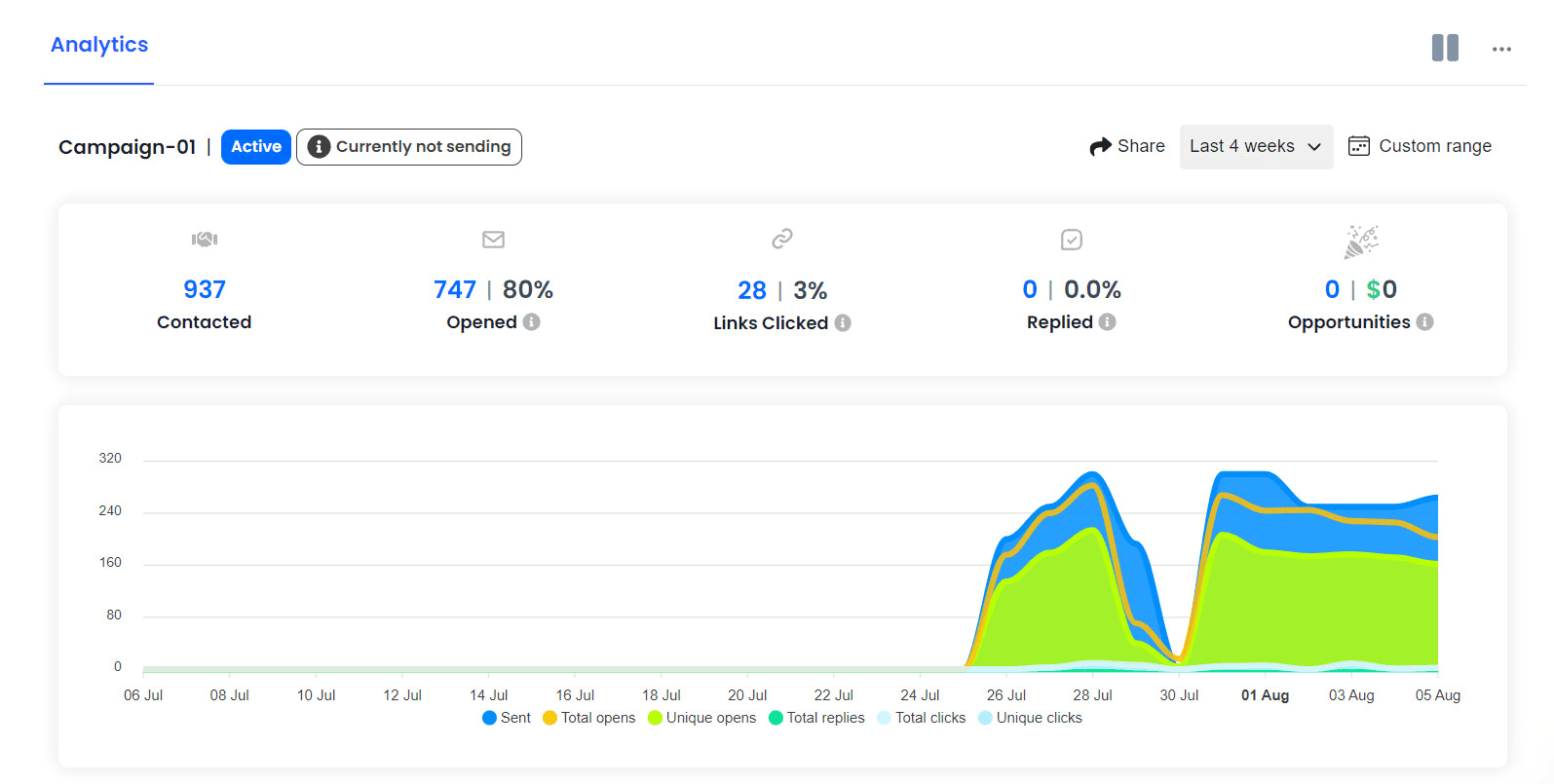
Users can add leads to their campaigns by either importing a CSV file with lead information or using Instantly.ai’s native B2B Lead Finder tool.
The software also offers a Unibox, which consolidates all email conversations in one place and various options for message personalization.
Speaking of personalization, to enhance your outreach, you can use its:
- Pre-set or custom variables
- Spintax - multiple variations of a text to avoid repetition
- Liquid syntax - dynamic text based on data
Additionally, Instantly.ai supports A/Z testing, which lets you test up to 26 different versions of email copy.
Data from Instantly.ai can be pushed to different CRMs and tools via Zapier webhooks.
However, the platform also has a built-in CRM that helps track lead statuses and enables you to make calls and send SMS directly from the platform.
Finally, the software can verify your leads' emails, reducing the chance of bounces and protecting your domain's reputation.
With the basics covered, let’s take a closer look at Instantly.ai’s main features.
Instantly.ai features
Unlimited email accounts
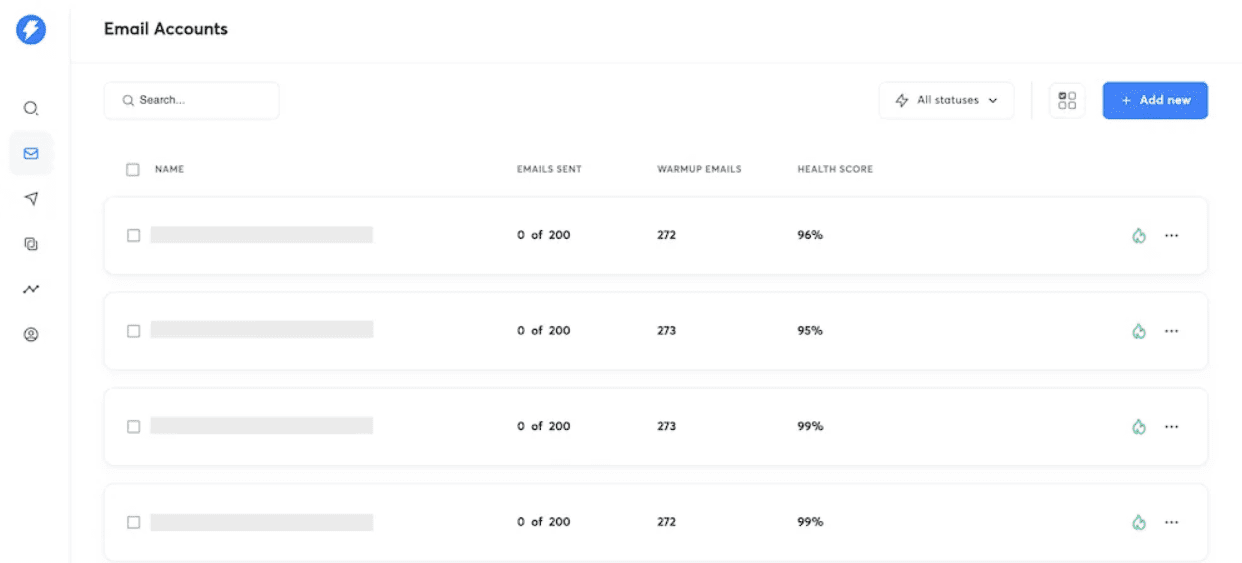
Instantly.ai allows you to connect and manage unlimited email accounts.
As they like to say, this enables you to:
‘’Infinitely scale your outreach.’’
However, despite being able to connect unlimited email accounts, the tool caps the number of active leads and emails you can send per month based on the subscription plan.
Nonetheless, Instantly.ai is still useful for email outreach, especially for those who need to reach a large number of leads quickly.
Why? Because you can use all connected accounts in the same campaign.
This is possible due to the software’s inbox rotation feature. This feature alternates sending emails from different accounts. In turn, it helps you send more emails daily without triggering automation detection.
Unlimited email warm-up
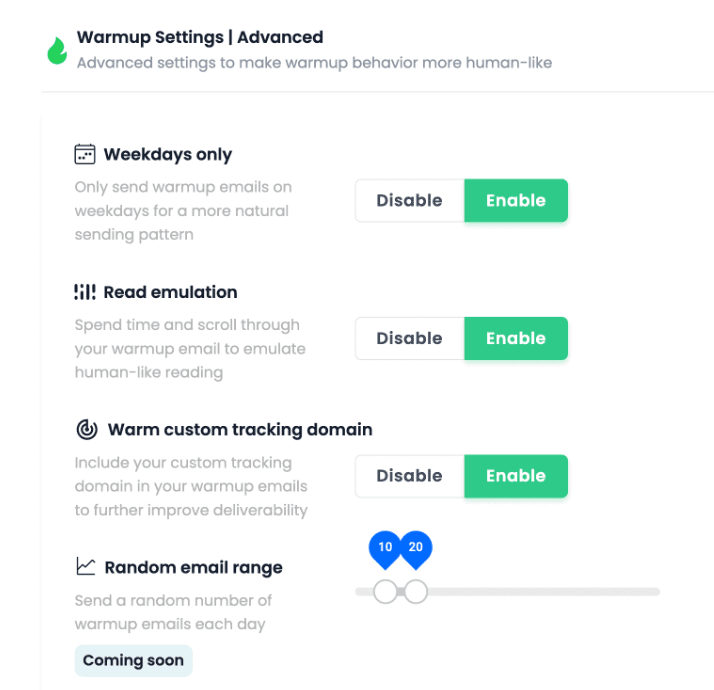
Instantly.ai is one of the few sales outreach tools (or outreach tools in general) with a built-in unlimited email warm-up functionality.
This means that you can warm up every new email address that you connect to it to ensure that:
- Fewer emails end up in spam
- Your sender’s reputation remains optimal
B2B Lead Finder
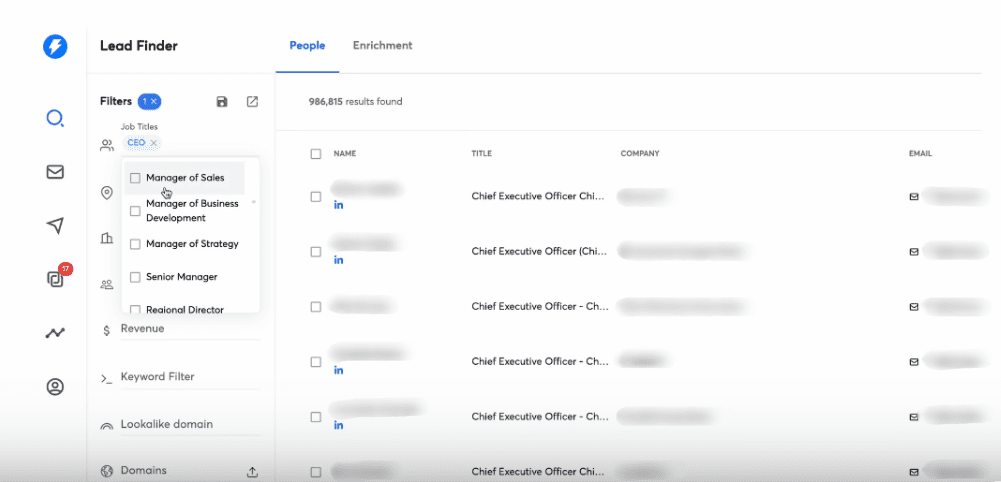
Instantly's B2B Lead Finder is a database with 160M contacts designed to help find leads that are highly relevant and accurate.
The feature relies on a range of filters — some of which match Sales Navigator filters. These include:
- Job Titles
- Location
- Industry
- Employees
- Revenue
- Domains
- ...etc.
What's more, the feature supports keyword-based searches and lets you apply multiple filters simultaneously. This helps you better narrow your search and pinpoint the most promising leads according to your Ideal Customer Profile (ICP) and buyer persona.
Another useful feature of the Lead Finder is Lead Enrichment. To use it, upload a list of contacts, and the system will enrich it with additional data.
Instantly.ai disadvantages
Instantly.ai excels in many aspects. However, certain disadvantages make it less than ideal and position other tools as superior.
Instantly.ai doesn’t support multichannel outreach of any kind.
Moreover, email sequences that you can create with Instantly.ai are pretty basic. You can’t set them up to adjust based on your leads’ behavior. So, if your leads don’t respond, there’s not much you can do.
Why, yes, messages can be personalized. Unfortunately, rich media content, including images and GIFs, can’t.
Analytics could also be improved to provide deeper insight into campaign performance. Additionally, there is no option to export stats to CSV or PDF.
While Instantly.ai claims you can scale your outreach infinitely, that's not quite accurate. In fact, their basic plan lets you send 5,000 emails per month only. Consequently, the mid-tier plan limits you to 100,000 emails, and the top plan caps at 500,000 emails.
Plus, they limit the number of leads you can upload to the platform. Depending on the plan, you can either upload 1,000, 25,000, or 100,000 leads.
Finally, while the tool can enrich your leads’ information, including their emails, this functionality will cost you extra. Not to mention, there are limits to how many leads you can enrich.
This is a huge con, considering that a certain tool lets you send tens of thousands of emails a month and verify as many emails as you want at no additional cost.
But we’ll get to that shortly.
What Instantly.ai reviews say
While doing the research, we stumbled across both positive and negative Instantly.ai reviews.
As for the positive aspects, we noticed many users are praising the interface.
For instance, one of them, Jonas R, says:
‘’The automation of follow-ups and the user-friendly interface make it incredibly efficient for managing my cold outreach campaigns.’’
On the other hand, Zirva Z. has pointed out certain flows in her review:
‘’The leads aren't great, and being limited to adding only 100 at a time is really frustrating.’’
She also went on to mention that:
‘’It's not very useful unless you have a really high budget.’’
Instantly.ai pricing
Instantly.ai has 2 main pricing categories — Sending & Warmup and Leads — with multiple sub-plans.
Sending & Warmup is the pricing plan for sending and warming up emails.
As such, it doesn’t include access to the B2B Lead Finder and is divided into 3 individual sub-plans.
The pricing varies and is determined based on the number of leads you can upload and emails you can send.
| Growth | $37/mo per account |
| Hypergrowth | $97/mo per account |
| Light Speed | $358/mo per account |
Meanwhile, Leads plans are meant to streamline prospecting and entail full access to the B2B Lead Finder feature.
There are a total of 4 of these. They differ in price depending on the number of leads you can verify and include:
| Growth Leads | $37.9/mo per account |
| Supersonic Leads | $77.6/mo per account |
| Hyperleads | $169.3 per account |
| Enterprise | Custom / Contact sales for pricing details |
But remember, if you want to use Instantly.ai to send and warm up emails and generate leads, you can’t purchase a plan from a single category. Instead, you’ll need one from each.
This means that the price of using the software can quickly skyrocket.
For instance, if you were to subscribe to their lowest-tier subscriptions, you’d pay a total of $84 for both each month. On the other hand, their highest-tier plans combined set you back an exorbitant $850 a month.
That said, you might be better off using a tool that offers much more at a lower price.
12 best Instantly.ai alternatives
Are you interested in exploring other software on the market? If so, here are 12 compelling alternatives to Instantly.ai that may provide you with better value for your money.
1. Skylead
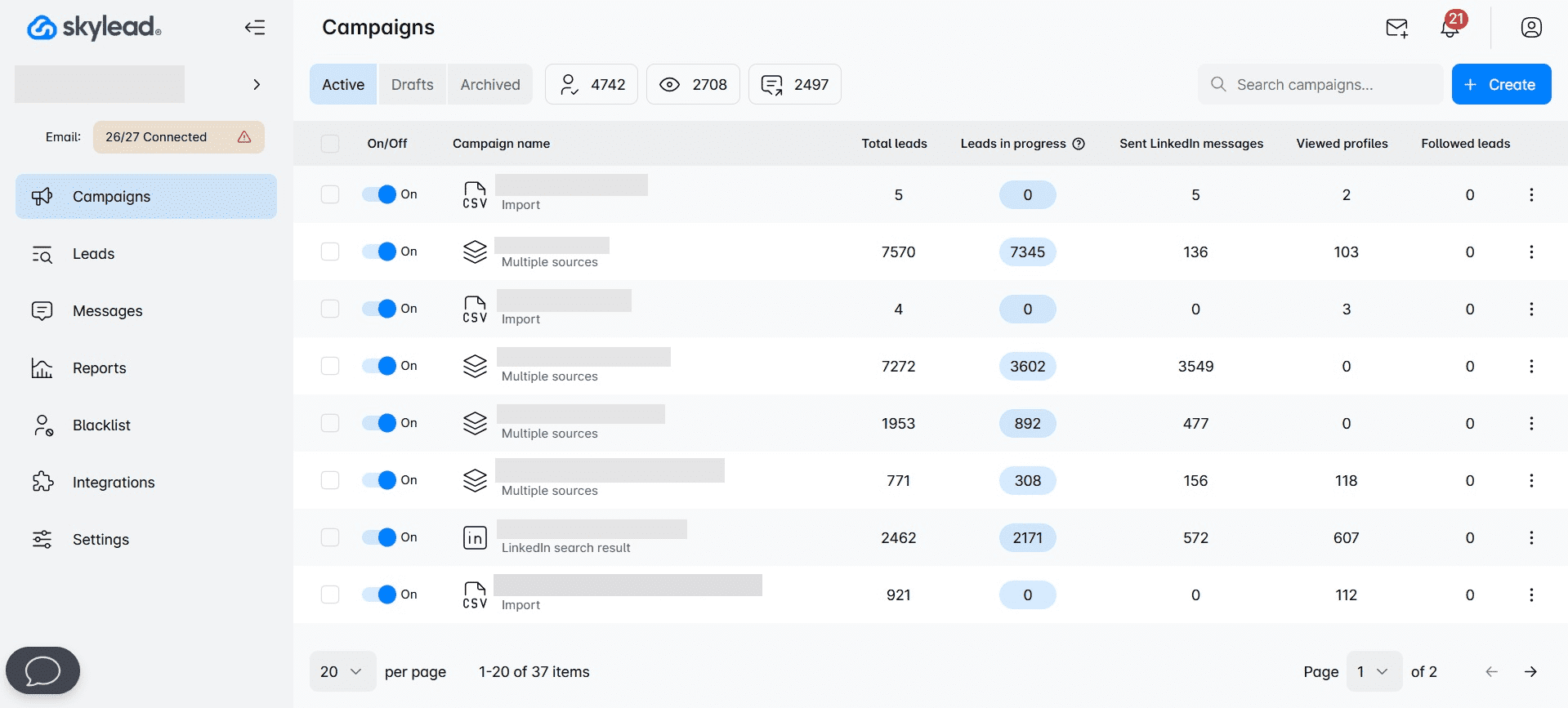
Well, hello - that’s us! 😊
Skylead is a leading cloud-based multichannel sales engagement tool that is 100% compliant with LinkedIn's ToS.
It's commonly used by:
- Sales professionals and entrepreneurs who aim to free up as much as 11 hours a week for booking 3x more meetings.
- Marketing professionals seeking to distribute content and secure more backlinks.
- Recruiters on the hunt for the best talent.
- Lead generation agencies focused on acquiring high-quality leads for their clients.
The biggest difference between Instantly.ai and Skylead is the support for another professional social media platform.
As a matter of fact, our software allows you to create multichannel campaigns that combine different outreach actions. All thanks to our Smart sequences.
The tool also lets you personalize messages with preset and custom variables. While at it, you can even engage in A/B testing to determine how to best approach leads.
However, what truly sets Skylead apart in the personalization department is our native image and GIF personalization feature.
Not to mention, Skylead also offers infinite email warm-up, courtesy of our partnership with an email warm-up tool, InboxFlare.
Finally, our tool comes with advanced reporting capabilities and even supports CSV and PDF exports. You can also integrate it with any CRM or tool you like using Zapier webhooks or API.
Now, let’s get deeper into our features that are changing the outreach game as we know it.
Email automation
Much like Instantly.ai, Skylead lets you add unlimited email accounts to help you send tens of thousands of emails a month.
However, unlike it, it doesn’t limit the number of active leads you can have. You can input unlimited leads, allowing you to reach out to more people.
If you were wondering how it’s possible to send thousands of emails a month, well, it’s because our tool supports inbox rotation. This means that Skylead alternates sending emails from different accounts to keep you within safe limits on each.
Email discovery & verification
Namely, our software can find and verify your leads’ emails. In turn, it reduces the chances of bounces that impact deliverability and your sender’s reputation.
And guess what? You can take advantage of this feature without breaking your campaign creation flow.
Just add the Find & Verify Email step to your sequence for the tool to find and double-verify the existence of your leads’ emails.
The best thing about this feature is that it has one of the highest, if not the highest, email-finding probabilities on the market.
Not to mention, it’s both unlimited and comes at no extra cost. In other words, as long as you’re subscribed to the tool, you can use it as much as you want.
This makes Skylead more cost-effective than Instantly.ai, which requires a separate subscription to enrich emails.
Smart sequences
And that brings us to the star of the show: Smart sequences.
In essence, they are algorithms that combine outreach actions with if/else conditions. As a result, you get coherent outreach flows that helps you unfold outreach according to the way your prospects behave. That said, here's one smart sequence example.
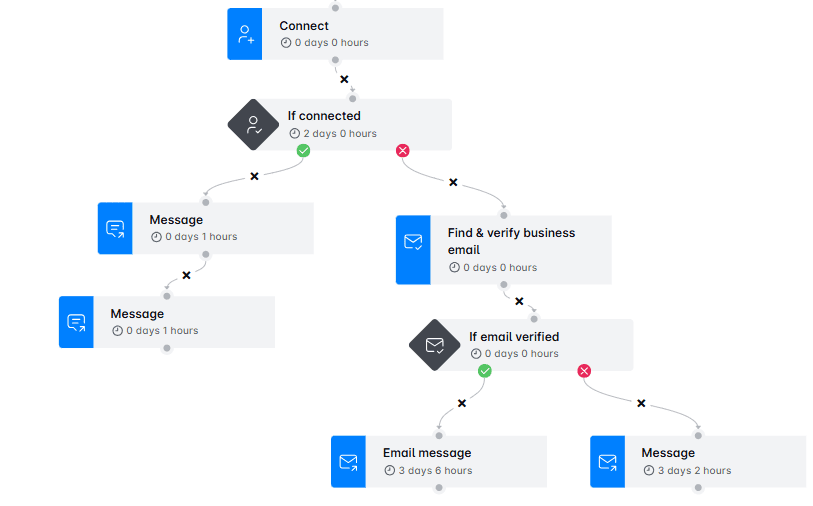
Of course, there are a thousand more ways this can go. Smart sequence builder is your playground, so feel free to experiment with different branching paths.
Or, you can try our tried and tested Smart sequences templates inside the tool for guaranteed results!
Smart inbox
Smart inbox, although serving the same purpose as Instantly.ai’s Unibox, is far superior. That’s because it doesn’t only aid email management. It also lets you manage your conversations from both platforms.
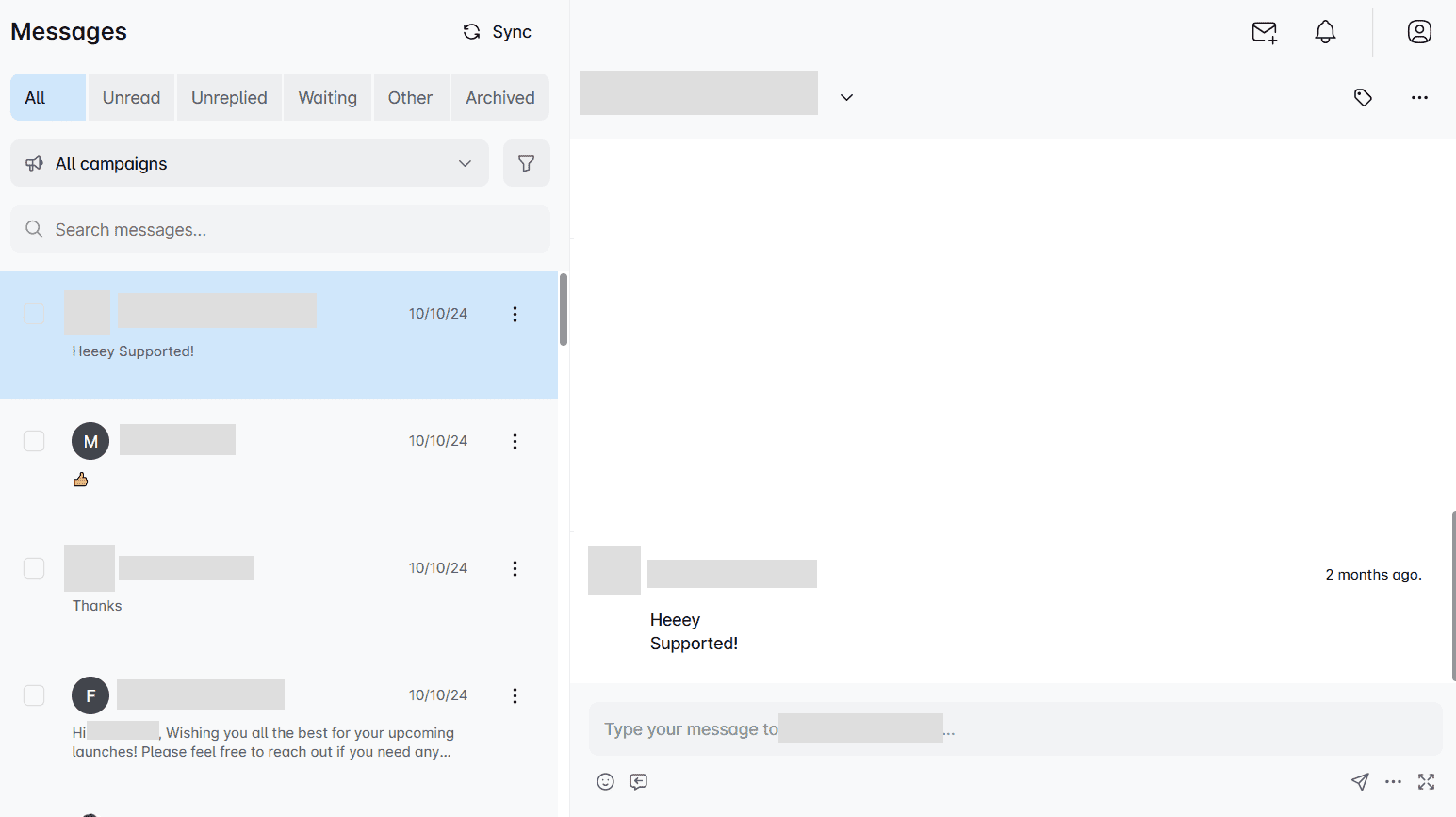
But what makes our Smart inbox truly irreplaceable is the opportunity to label chats. These labels are great because they can help you keep track of ROI and conversions. That said, you can choose between a couple of predefined ones or add your own.
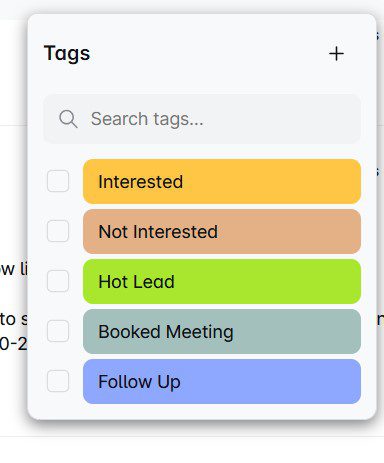
Image & GIF personalization
They say a picture is worth a thousand words. And we agree, which is why we introduced our image and GIF personalization feature.
Believe it or not, by personalizing visuals for each recipient, you can increase your response rate to more than 63%.
That said, our image and GIF editor lets you upload any picture you like and personalize it with:
- Your lead’s name
- Their and/or your profile image
- Their and/or your company logo
- A custom message
The choice is yours! Either way, you’ll surely leave a lasting impression.
In fact, just look at the astonishing 76% response rate we got using the following visual!
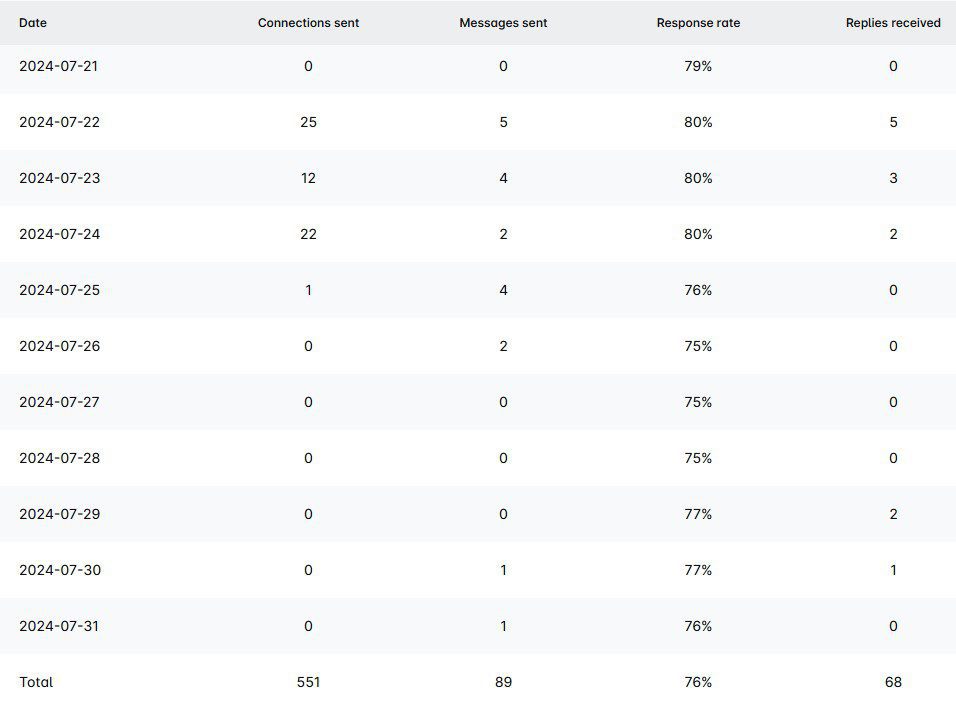
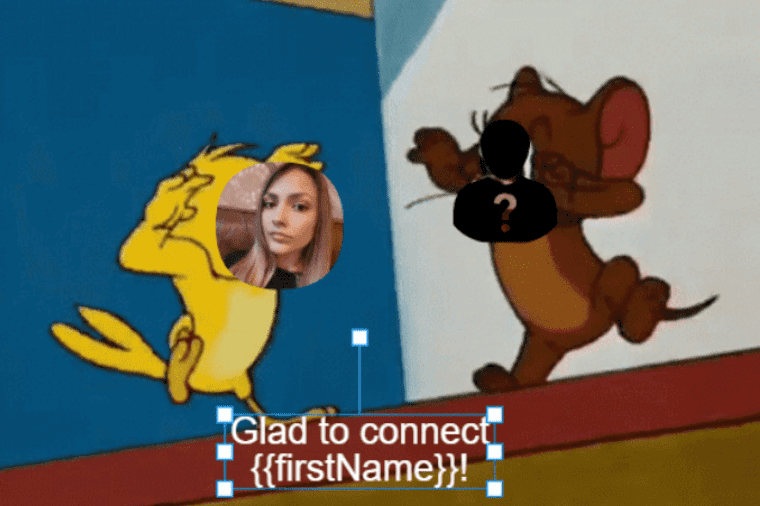
Advanced analytics
Speaking of results, Skylead comes equipped with advanced analytics, which are available on the Reports page.
Here, you can see how all of your campaigns are performing or examine the stats for a single campaign.
That said, there are 3 ways to observe results:
- In a graph form, to visually compare oscillations between different metrics;
- In table-view, to observe fluctuations on a daily basis;
- Step-by-step, to see how your A/B tests are performing.
Unlike Instantly.ai, Skylead even lets you download these reports. The good news is that there are 2 different formats to choose from: CSV and PDF.
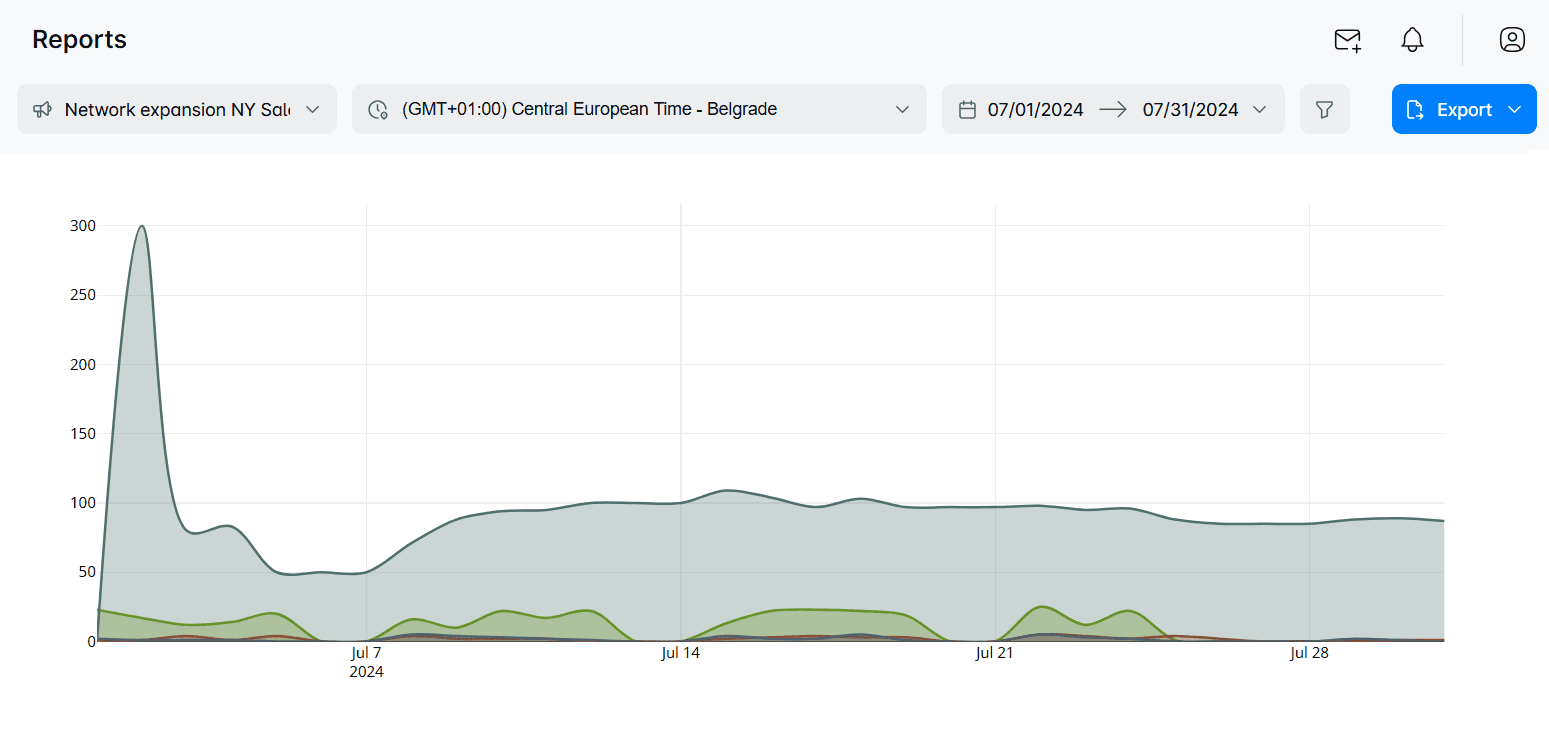
What Skylead reviews say
Skylead reviews are positive, with people praising it for what it has helped them accomplish.
For instance, Daniel Hoffmann, a Managing director at Toplevel Performance, has said that:
“Since I’ve started working with these clients and using Skylead, I have earned approximately $33.000.”
In the meantime, NewPoort's founder, Toine Boelens, has highly praised our Smart sequences and email finder and verifier:
‘’If/else conditions in Smart Sequences are also great. It's low code, so it's great because I'm not good at coding yet. I also like the Find & verify business email step, which finds email addresses most of the time. So you get, like, two ways you can get in touch with the client. ‘’
Instantly.ai vs. Skylead
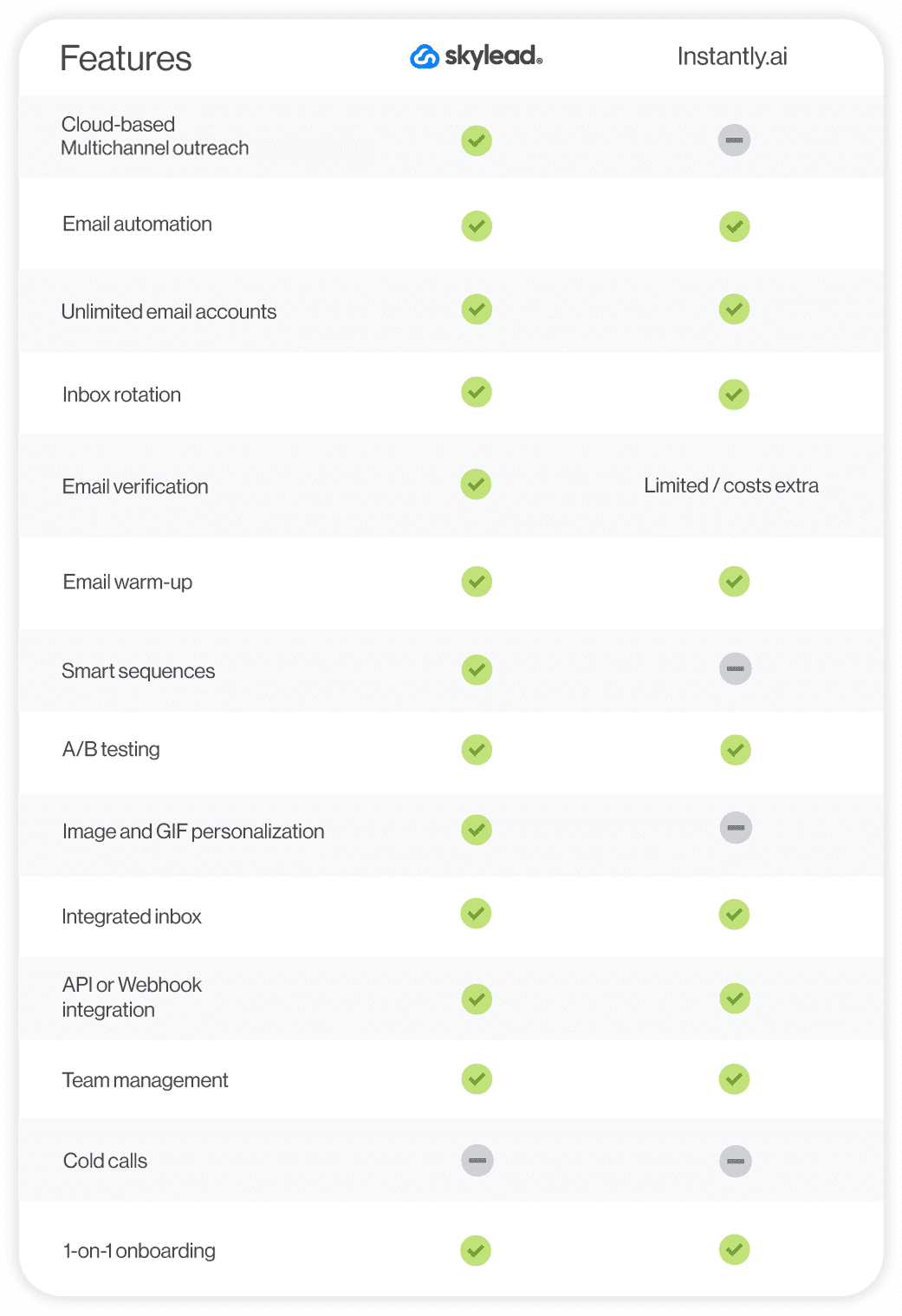
Pricing
Skylead has a singular plan that costs $100 per seat. To test out the tool and its functionalities, feel free to take advantage of our 7-day free trial period. Moreover, our customer support remains available for a 1-on-1 onboarding call—completely free of charge!
2. Lemlist
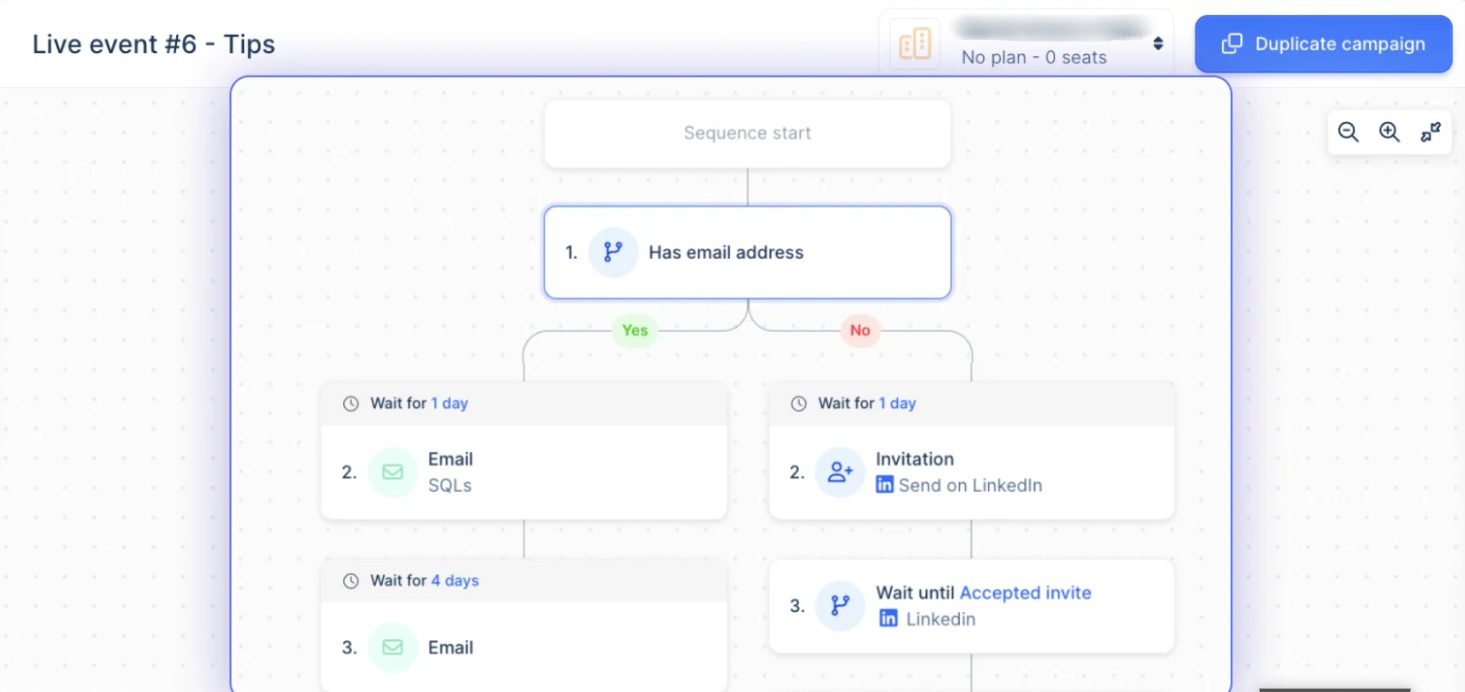
Lemlist is a cloud-based tool primarily used for email outreach. Nonetheless, its higher-tier subscription supports multichannel outreach, letting you add automatic LinkedIn actions and calls to the mix. That said, it may not comply with LinkedIn's ToS like Skylead does.
In terms of LinkedIn automation, the tool can visit your lead's profiles, invite them to connect, and send them a message. Moreover, you can add conditions to your sequences to cover several outreach scenarios.
You can also perform any other action on LinkedIn. However, you’ll need to add it as a manual step to your campaign, the same as calls.
The software offers advanced personalization features, including custom images, intro lines, and dynamic landing pages.
It's also known for Lemwarm, a built-in email warm-up tool that helps emails stay away from spam.
Now, even though Lemlist comes with an email finder and verifier, like Skylead and Instantly.ai, it limits the number of emails you can discover and verify by plan. In fact, even with their most expensive plan, you can only discover and verify up to 1,000 emails a month. If your needs exceed this, you can purchase additional credits. However, this comes at a cost of $1 per 100 verified emails.
That's not it for limitations, though. For instance, you can't connect unlimited email accounts to the tool. Moreover, although Lemlist offers a B2B lead database with over 450M contacts, the quality of leads isn't the highest.
This is somewhat compensated for with the Chrome extension for prospecting on LinkedIn. However, considering that Chrome extensions inject code into LinkedIn that may jeopardize your account, you might want to think twice before using it.
Instantly.ai vs. Lemlist
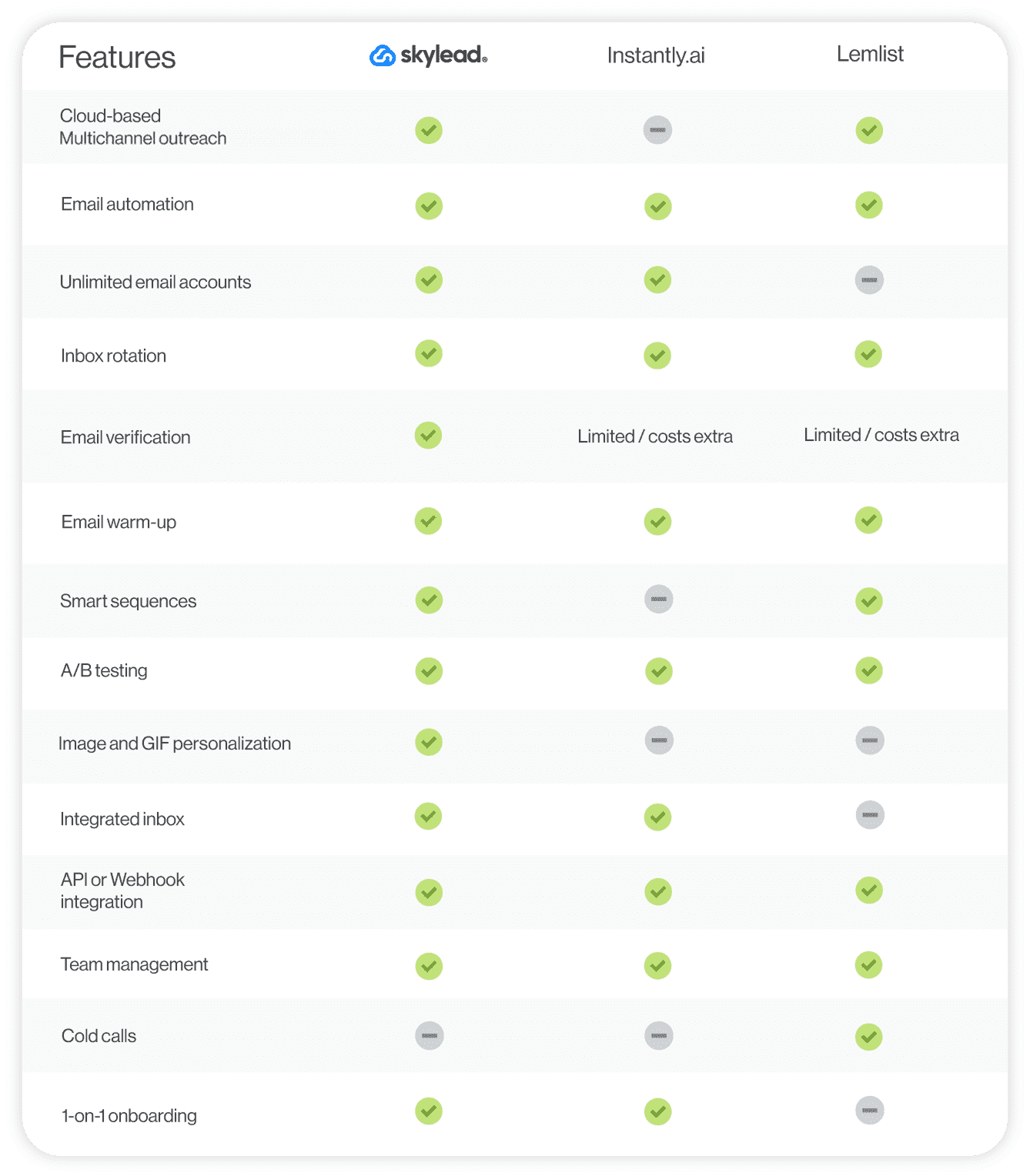
Pricing
| Email Starter | $39/mo per user with 1 sending email address |
| Email Pro | $69/mo per user with 3 sending email addresses |
| Multichannel Expert | $99/mo per user with 5 sending email addresses |
| Outreach Scale | $159/mo per user with 15 sending email addresses |
| Outbound agency | Contact sales for pricing details |
3. Apollo
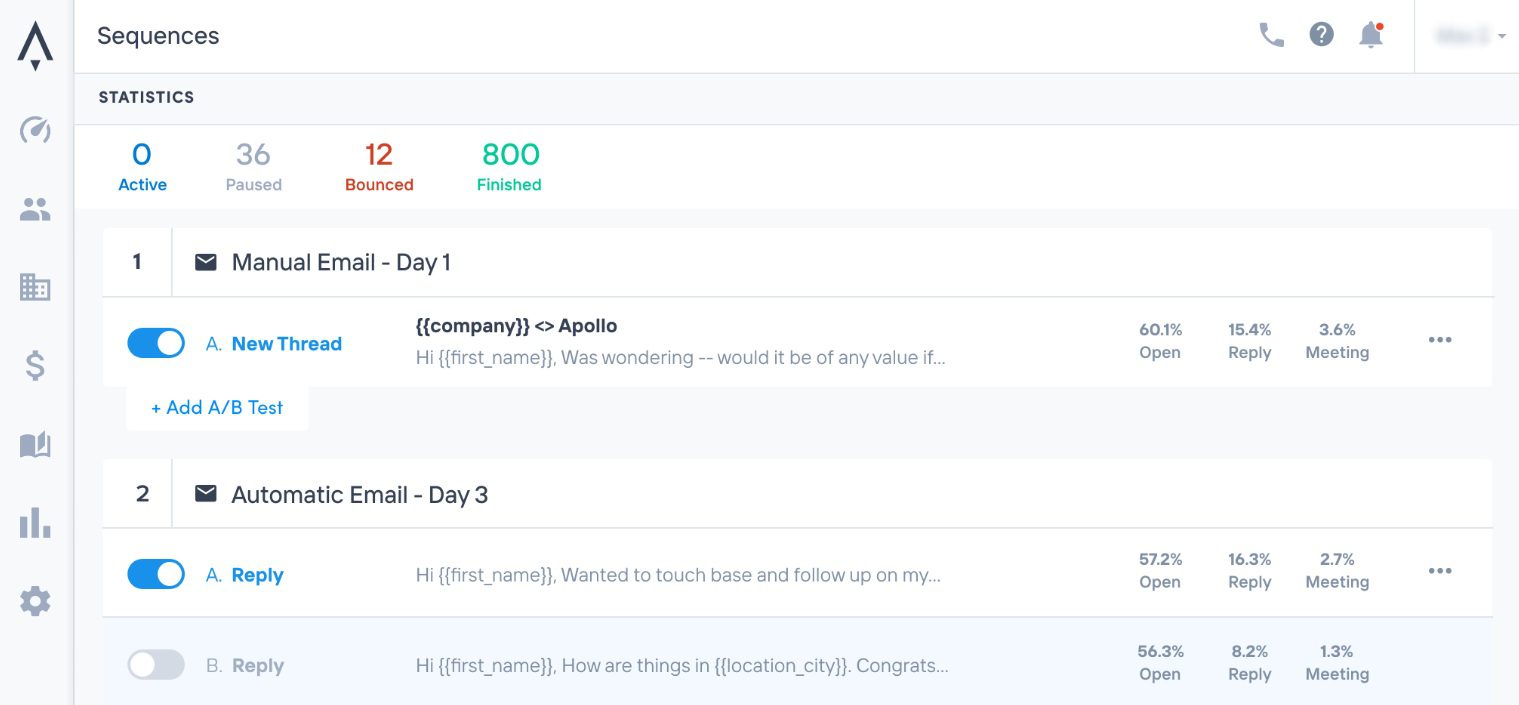
Apollo.io is a multichannel sales engagement platform that combines email, LinkedIn outreach, and cold calls in seamless sequences.
It allows users to set up campaigns that feature both automatic and manual emails.
When engaging leads via LinkedIn, Apollo can automate connection requests, messages, and interactions with posts.
However, its multichannel sequences—known as Playbooks—are relatively simple. Namely, unlike Skylead's Smart sequences, they don't unfold according to your lead's behavior, making them less than ideal.
Regarding integrations, the platform natively integrates with tools like Pipedrive, HubSpot, and Slack.
The software also has A/B testing capabilities, which help optimize outreach efforts. Additionally, it comes with a built-in AI writing assistant that those previously using ChatGPT for sales writing may find convenient.
Now, in terms of pulling leads into a campaign, Apollo does it through its databases of over 275M contacts. However, certain users have complained about the quality of these leads.
Like Lemlist, the platform can also scrape new leads from LinkedIn. However, this process, yet again, involves using a Chrome extension and could lead to account penalties. This means that the tool is not compliant with LinkedIn's ToS.
Instantly.ai vs. Apollo
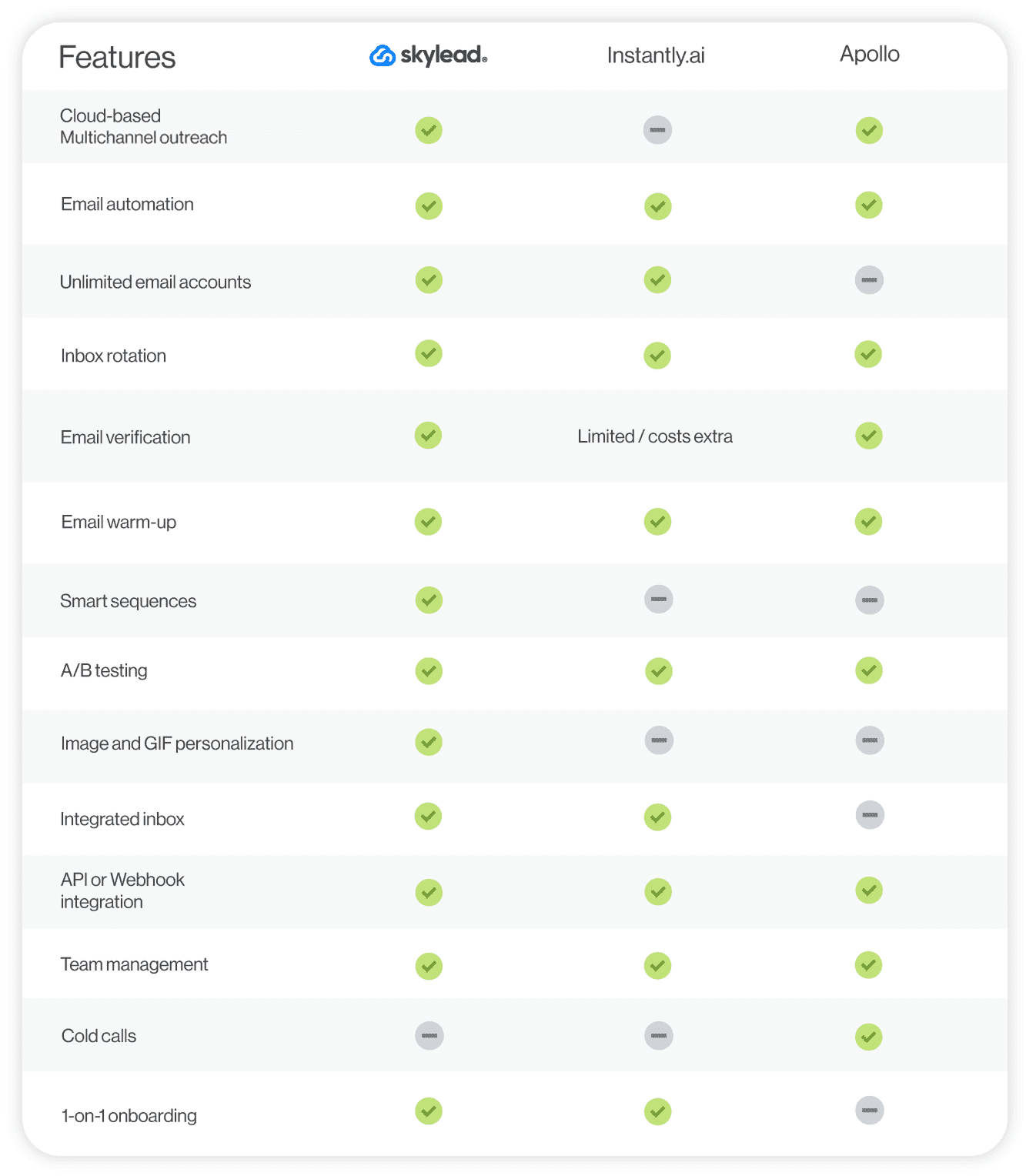
Pricing
| Free | $0/mo per user with 1 email account / 2 sequences |
| Basic | $59/mo per user with 1 email account / Unlimited sequences |
| Professional | $99/mo per user with 5 email accounts / Unlimited sequences |
| Organization | $149/mo per user with 15 email accounts / Unlimited sequences (minimum 3 users / billed annually) |
4. Smartlead.ai
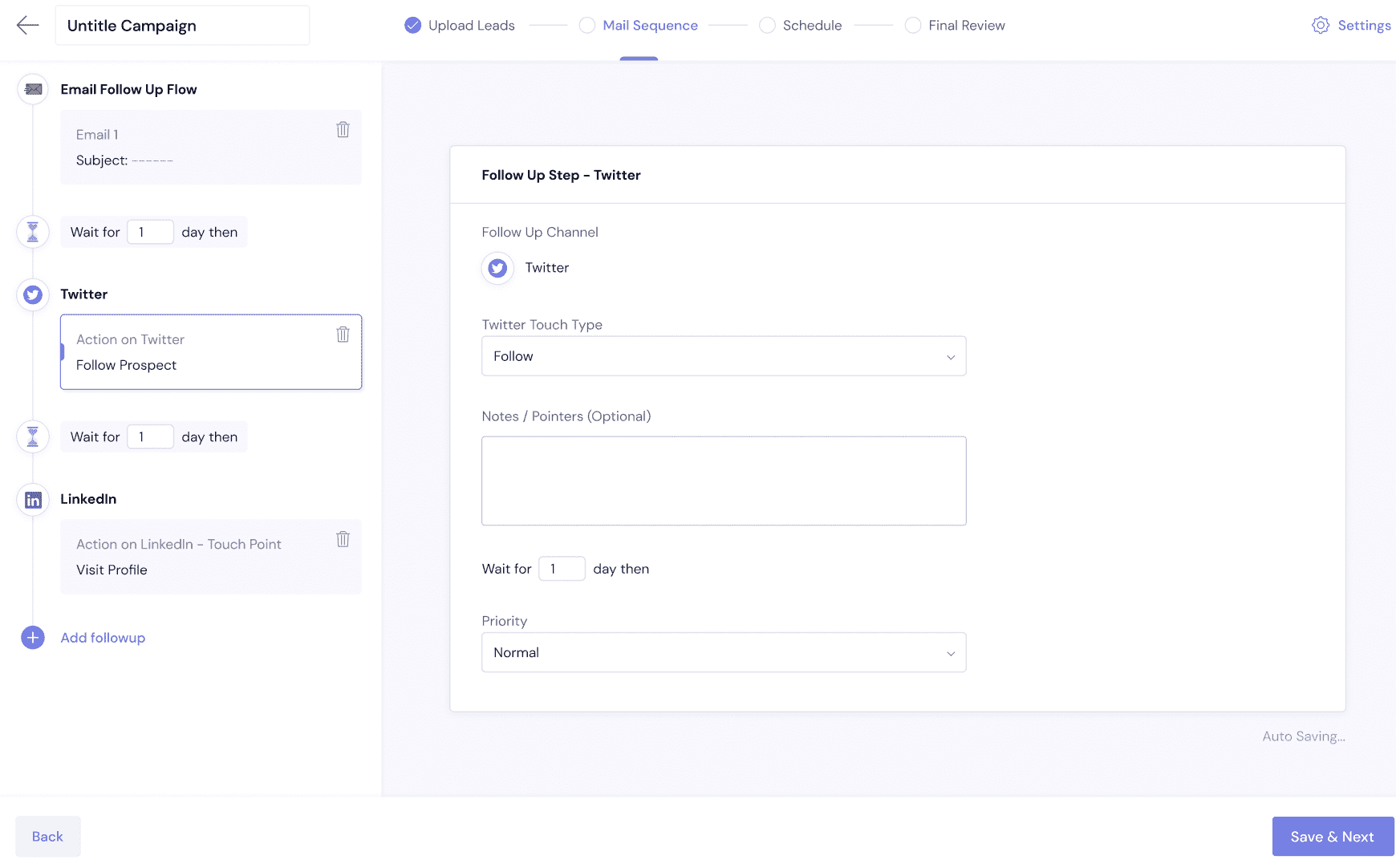
Smartlead is a robust email outreach tool designed to automate and streamline lead generation efforts.
It supports unlimited email accounts and email warmups, features inbox rotation, and uses a Master Inbox for streamlined email management.
The platform offers advanced personalization options like variables, spintax, and liquid syntax, along with split testing capabilities for up to 26 email variants.
Smartlead also integrates with various CRMs, including HubSpot, via API and webhooks.
However, it has some drawbacks.
Additionally, it lacks image and GIF personalization and an email discovery feature that Skylead has.
Finally, while you can create subsequences for each campaign to make it reactive to your leads' behavior, you must break the campaign creation flow to do so. Not to mention, you can only add leads to your campaign through a CSV file or HubSpot.
Instantly.ai vs. Smartlead.ai
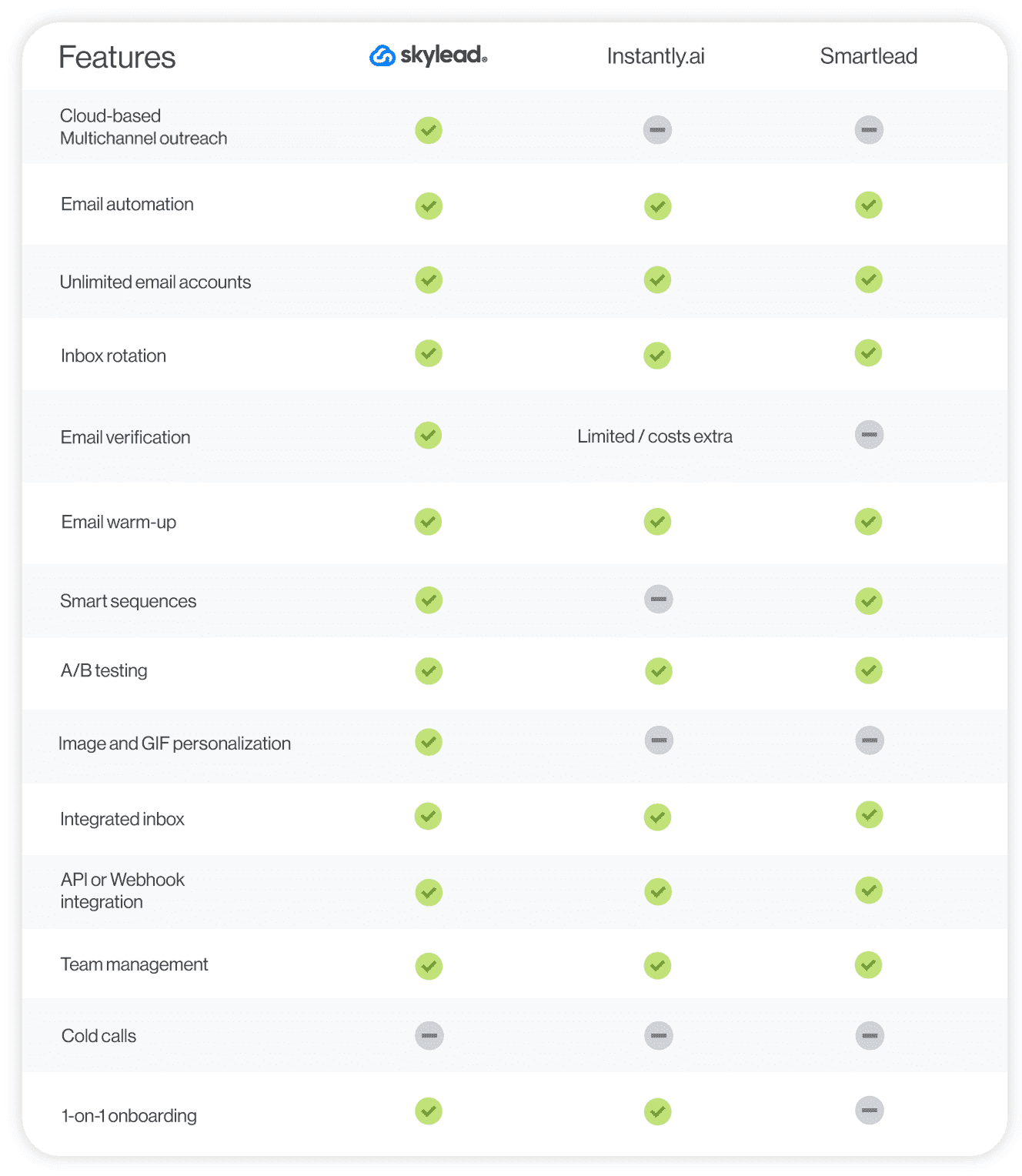
Pricing
| Basic | $39/mo per account with 2,000 active leads |
| Pro | $94/mo per account with 30,000 active leads |
| Custom | starting at $174/mo per account with up to 12M active leads |
Pro and Custom plans support adding additional seats, with each costing $29 a month.
5. Mailshake
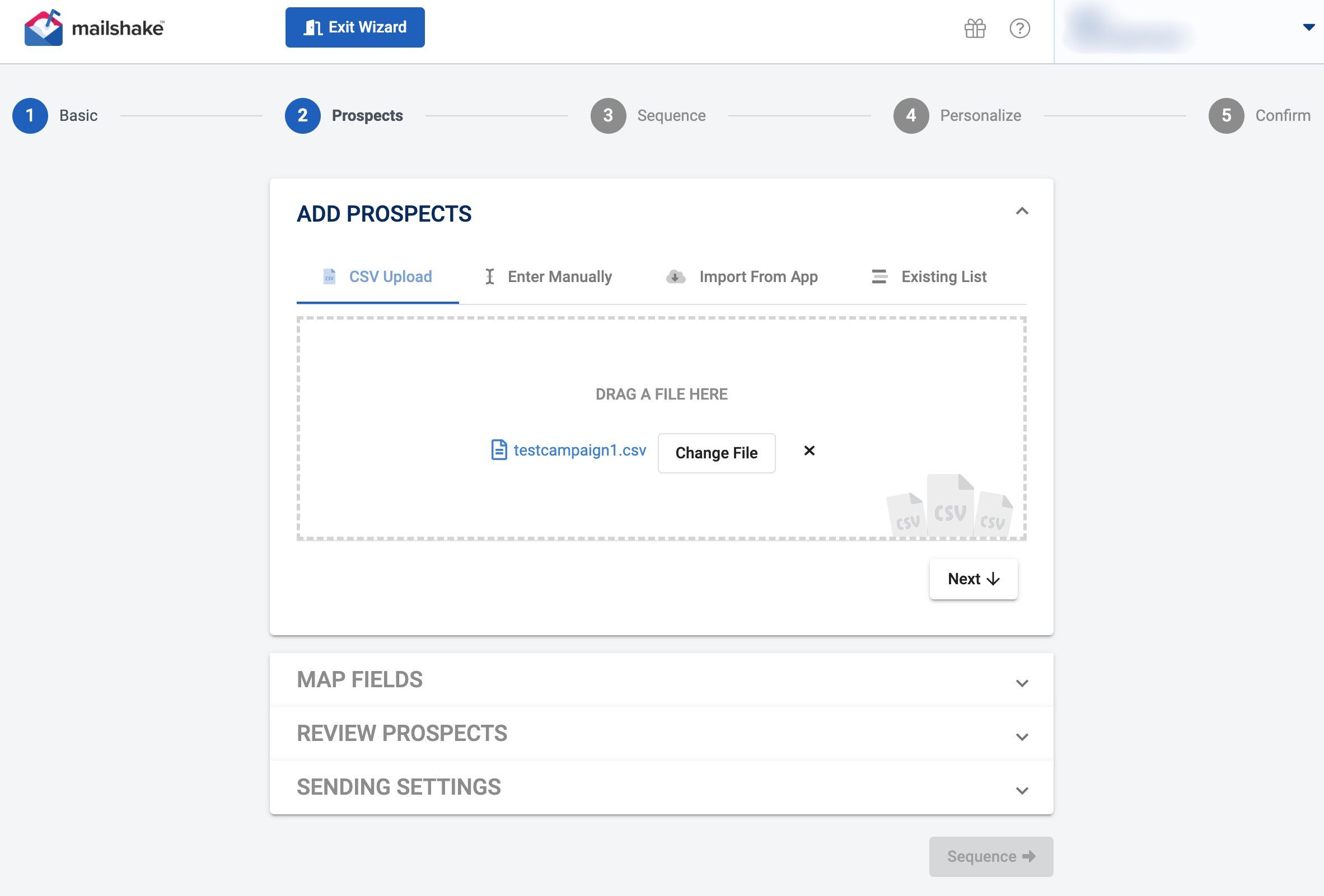
Mailshake is a cloud-based tool designed primarily for sending emails and follow-ups.
Nonetheless, it does have a Chrome extension that transforms it into a multichannel outreach and may violate LinkedIn's ToS. You can use to set up simple outreach sequences to automatically:
- View your leads' profiles on LinkedIn,
- Send them invites to connect,
- And messages.
At the same time, you can use the extension for cold-calling purposes, as it comes with a built-in dialer and call recorder. However, this option is available strictly for leads based in the US and Canada.
Moreover, you can integrate the tool with more than 1,000 software via Zapier webhooks. In terms of native integrations, there are those with Pipedrive and Hubspot.
A/B testing is supported, too, and so is inbox rotation. Unfortunately, you can't connect unlimited email accounts to Mailshake as you can with Skylead and Instantly.ai. In fact, the highest-tier subscription limits you to a maximum of 5 accounts.
LinkedIn automation and calls are restricted to the highest-tier plan, too.
Lastly, the use of a Chrome extension for LinkedIn actions risks account restrictions.
Instantly.ai vs. Mailshake
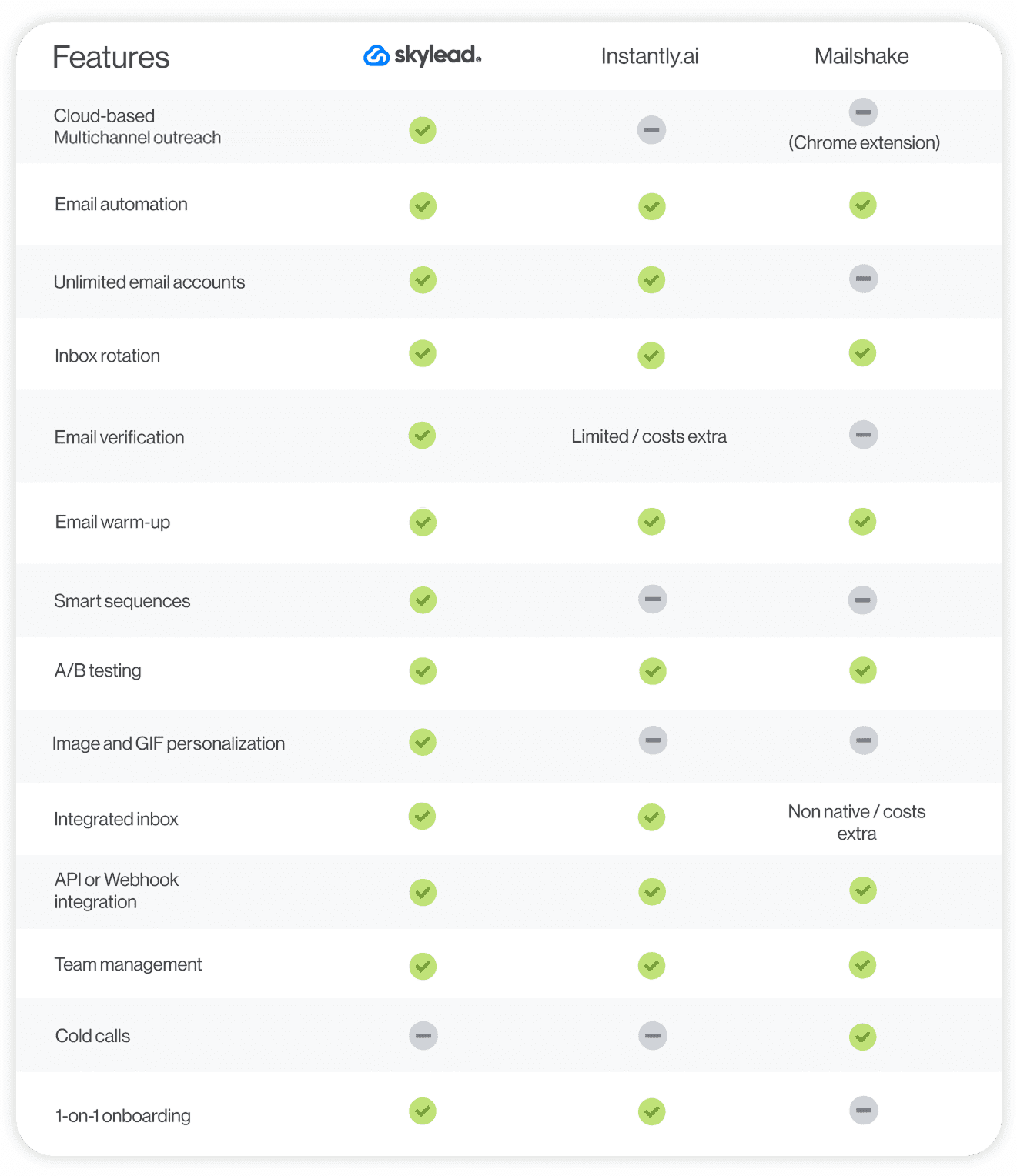
Pricing
| Starter | $29/mo per user with 1 sending email address |
| Email Outreach | $59/mo per user with 2 sending email addresses |
| Sales Engagement | $99/mo per user with 5 sending email addresses |
6. Woodpecker
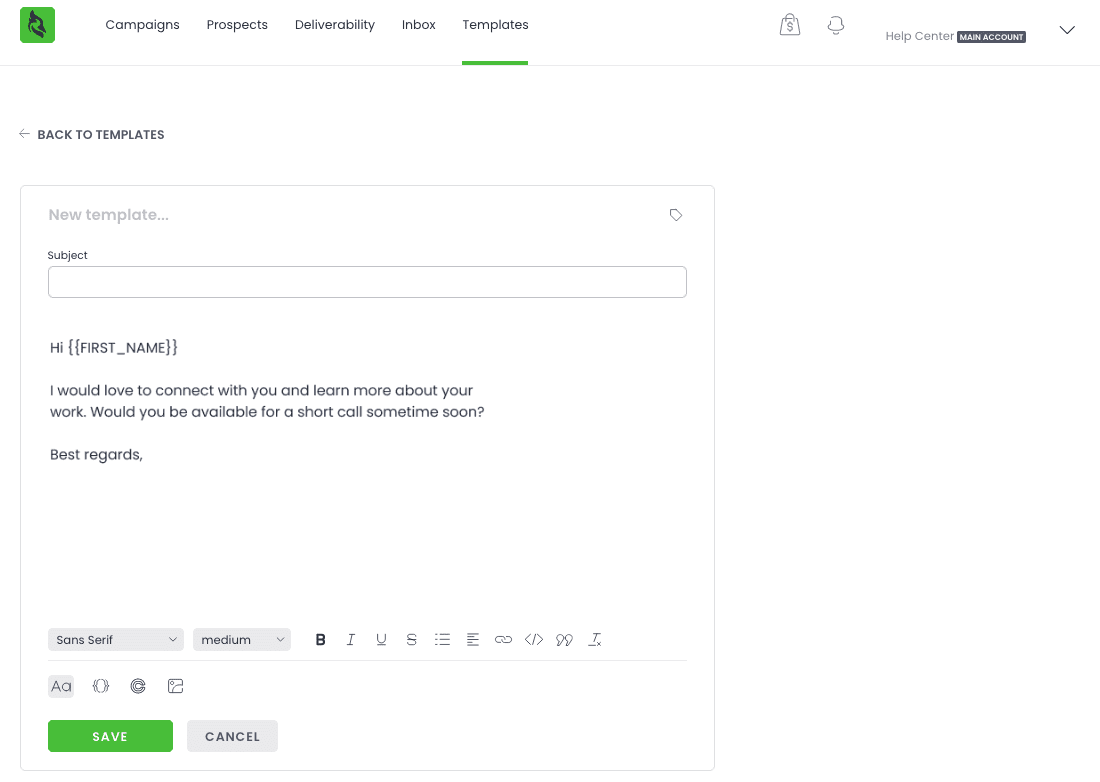
Woodpecker is a tool that automates emails and follow-ups to help individuals connect with ideal clients.
What's great about it is that it lets you connect as many email accounts to it as you want, just as Skylead, Instantly.ai, and Smartlead do. The same can be said about inbox rotation.
Sequences you can create with Woodpecker are condition-based. This means they adapt according to the way your leads behave.
With Woodpecker, you can A/B test up to 5 different variations of your message copy. And if you have trouble writing, its AI writing assistant is there to help.
Moreover, the tool supports plenty of 3rd party integrations, such as the one with Dux-Soup. This integration allows its users to tap into LinkedIn outreach, not just email, but it will cost you more.
That said, not everything's ideal with this tool.
Why, yes, the Dux-Soup integration turns Woodpecker into a multichannel outreach solution. The catch is, however, that they must subscribe to Dux-Soup’s Turbo plan for this to be made possible. This raises the cost of a subscription that's already steep and depends heavily on the number of contacted prospects.
Instantly.ai vs. Woodpecker
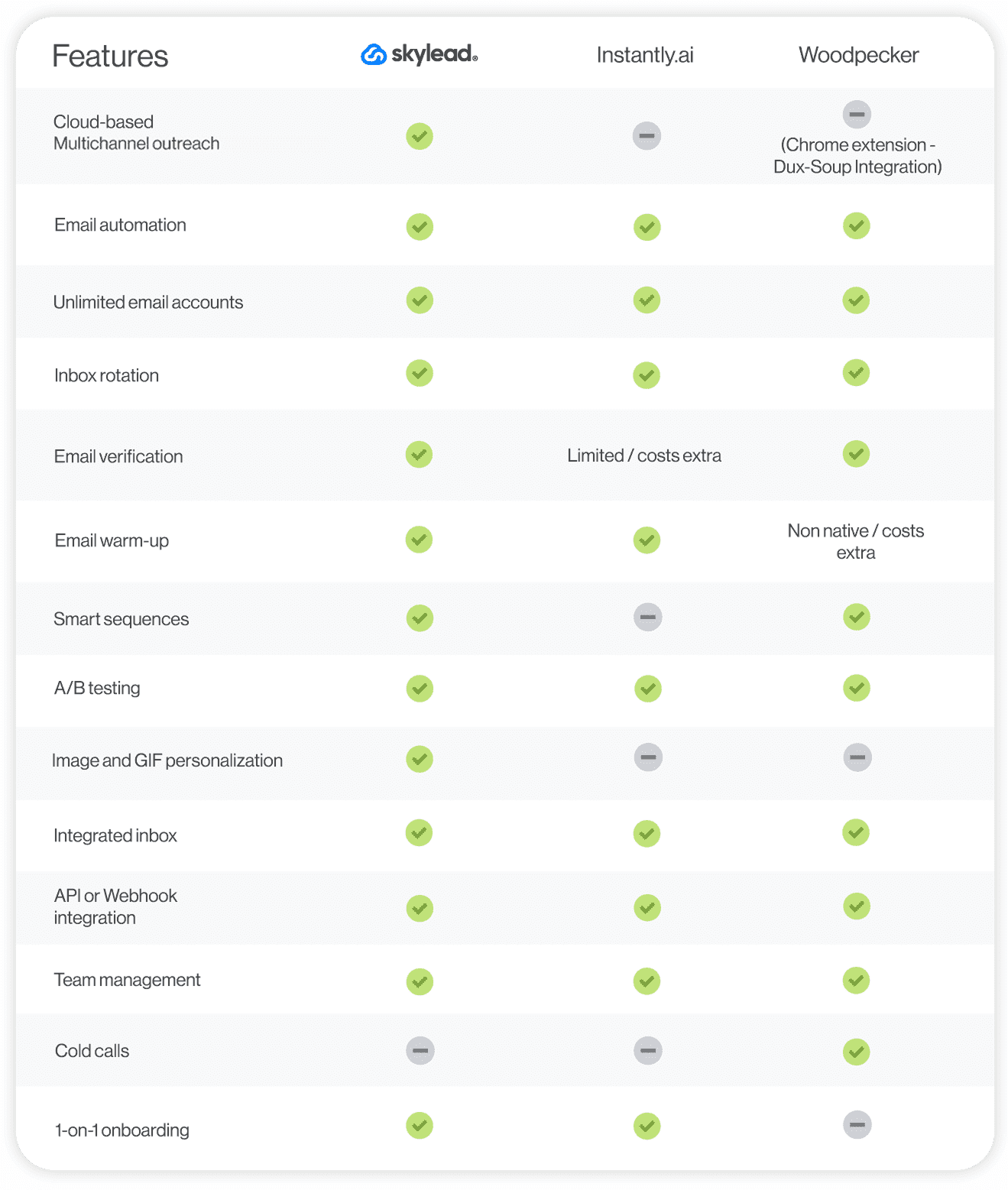
Pricing
| Cold Email | Starting at $29/mo per user |
| Agency | Starting at $29/mo per user |
| Custom | Contact sales for pricing details |
The exact cost of the Cold Email and Agency plan is determined by the number of leads contacted. It ranges between $29 for 500 contacted leads and $395 a month for 25,000.
Although price points for these plans are the same, they differ in one thing: the Cold Email plan is designed for individuals, whereas the Agency plan is meant to be used by teams. That said, the latter supports adding additional users at the price of $27 per each.
Additionally, the Dux-Soup integration adds an extra $55 a month to the subscription.
7. Salesloft
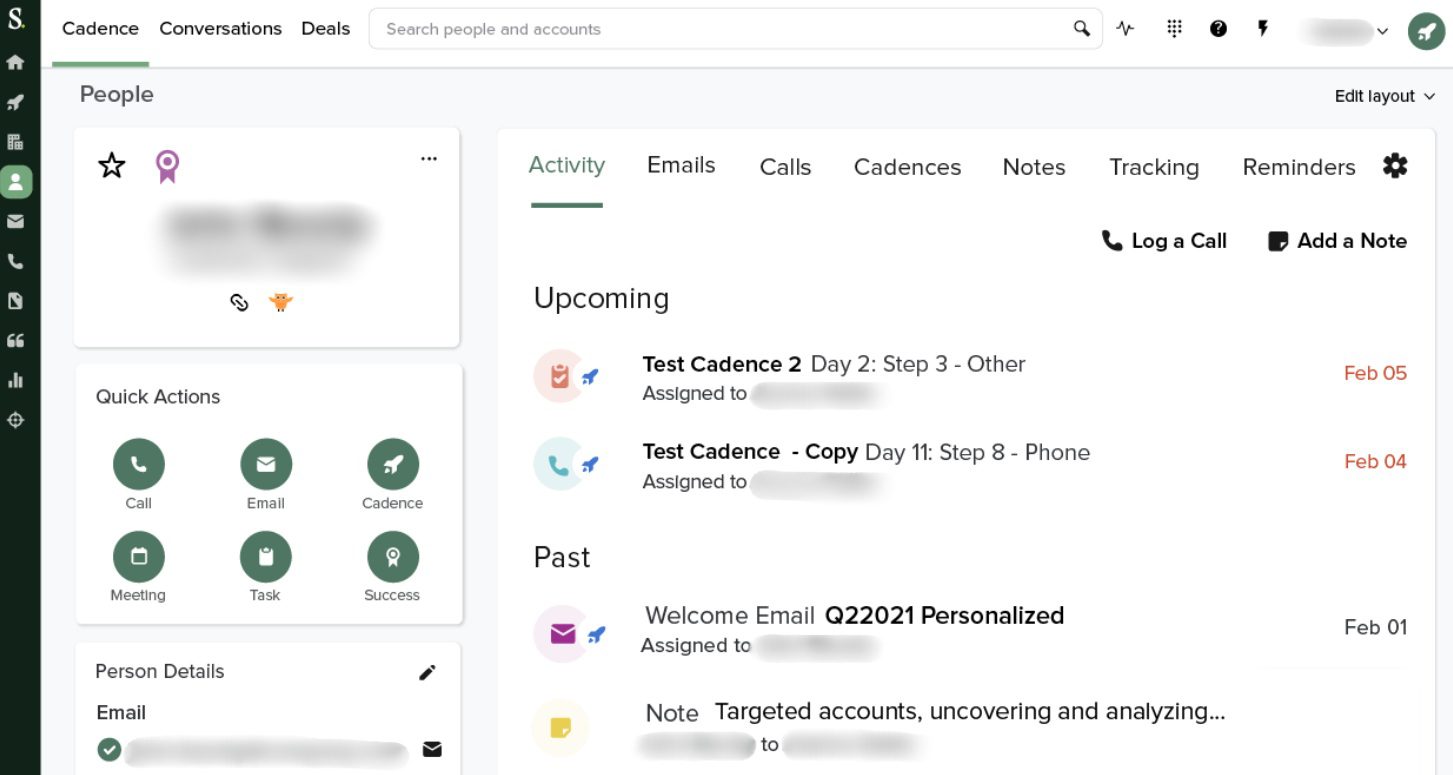
Salesloft is a cloud-based sales engagement platform ideal for sales teams that want to automate workflows and connect with more prospects.
Its Cadences—a form of campaign—integrate email, phone, and Sales Navigator tasks, though only emails are automated.
Nonetheless, the platform shines in email tracking and advanced analytics, offering A/B testing and customizable email templates.
However, Salesloft only integrates with Sales Navigator, missing support for LinkedIn Premium and Recruiter accounts.
Additionally, it lacks the Smart sequences that Skylead has, which limits touchpoints with leads.
Users have also complained about a less user-friendly interface and a buggy dialer.
Instantly.ai vs. Salesloft
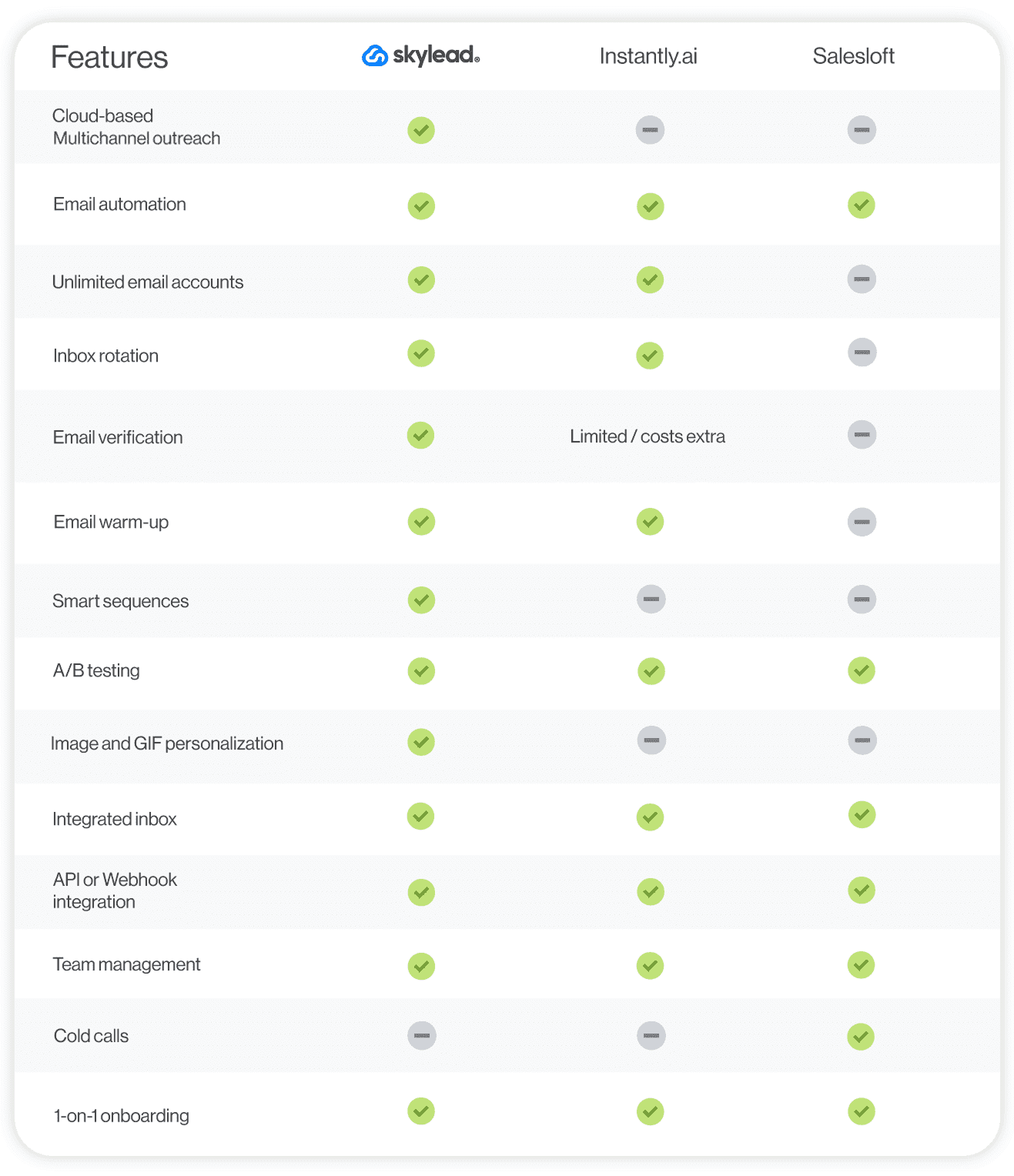
Pricing
At this time, Salesloft doesn’t disclose its pricing details for either of its plans: Essentials, Advanced & Premier. Instead, upon visiting the "Pricing" page, their bot prompts you to contact their team for a tailored quote.
However, the information on the Internet suggests that users are paying anywhere from $75 to $125 per user a month.
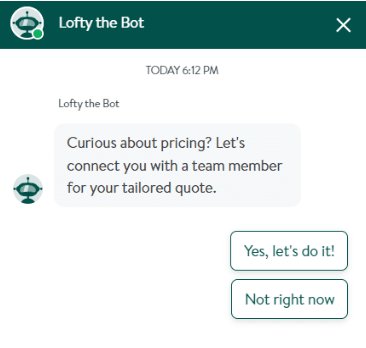
8. Outreach.io
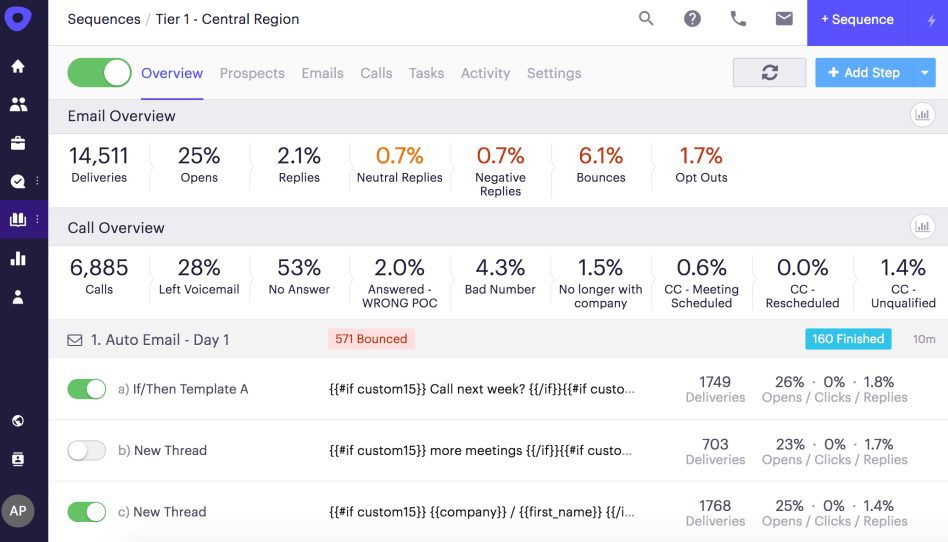
Outreach.io is a complete sales engagement platform designed to streamline the sales process for enterprise teams.
It integrates email, phone, LinkedIn, and live chat into a unified workflow, allowing for seamless multichannel outreach.
The platform lets you create personalized outreach sequences with automated follow-ups and response-based triggers. However, any actions on LinkedIn that are part of your sequences must be completed manually which means they are compliant with LinkedIn's ToS.
The tool integrates well with popular CRMs like Salesforce and HubSpot for smooth data synchronization.
Key features include robust email tracking, detailed analytics, A/B testing, and a library of customizable email templates.
Outreach.io also provides AI-driven sentiment analysis, call scheduling, and a pipeline calculator to estimate necessary sales expenses.
Its conversation intelligence tool, Kaia, offers real-time call transcription and insights, enhancing sales interactions and coaching.
In terms of cons, it's worth noting that the platform can be expensive for small businesses. Furthermore, no free trial is available, and the interface is complex.
Also, the platform connects to Sales Navigator accounts only and caters primarily to sales professionals. As such, it may lack features that marketing experts and lead generation agencies need, such as email discovery and verification.
Lastly, users can connect a maximum of 2 email accounts to the tool unless otherwise outlined in the contract.
Instantly.ai vs. Outreach.io
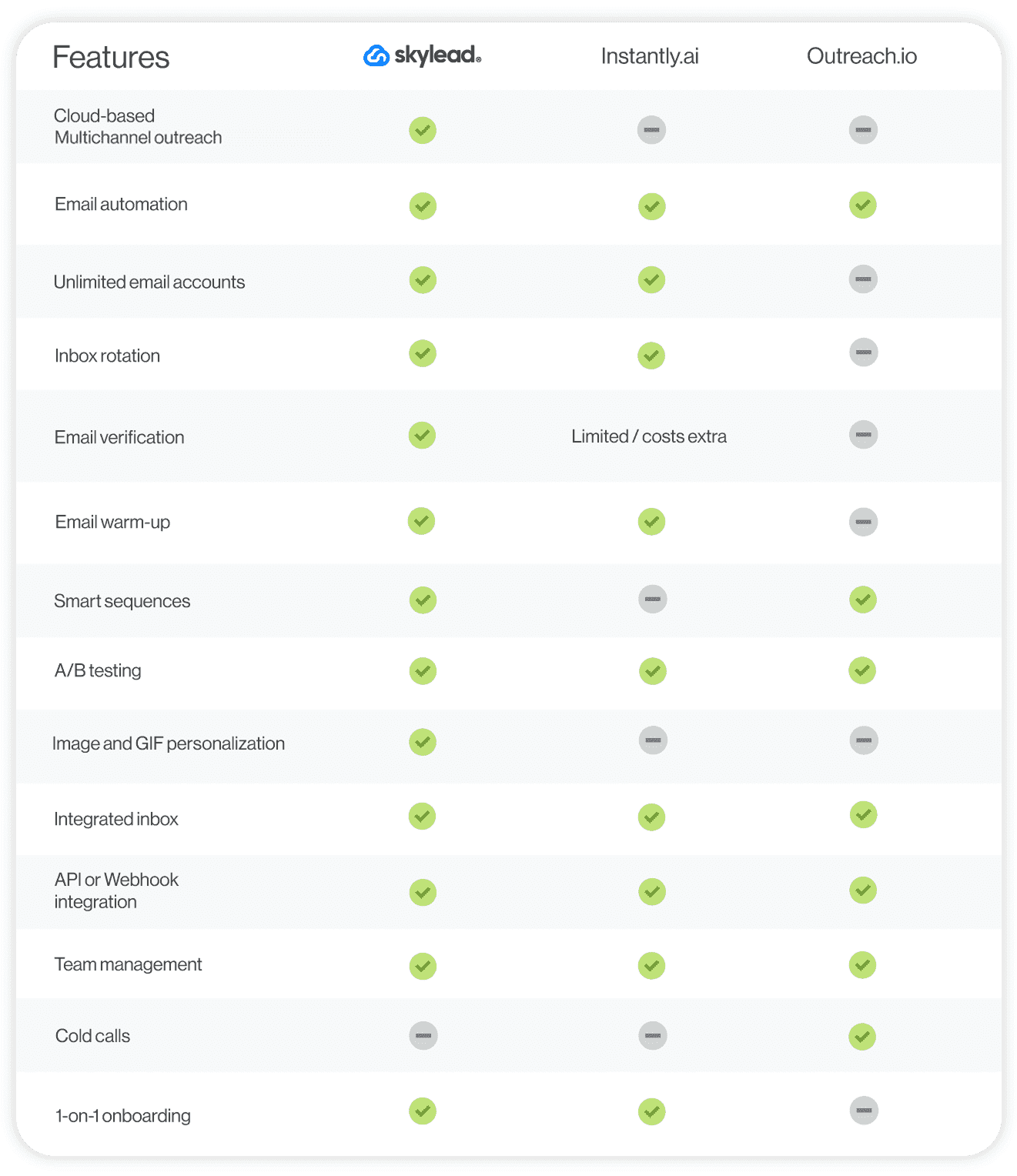
Pricing
Much like Salesloft, Outreach.io doesn’t disclose pricing details to non-users. Instead, the price is customized and heavily depends on the number of users within a team.
However, we did some research online and found that one user was quoted $130 per month per user, with a minimum requirement of 20 users.
9. QuickMail
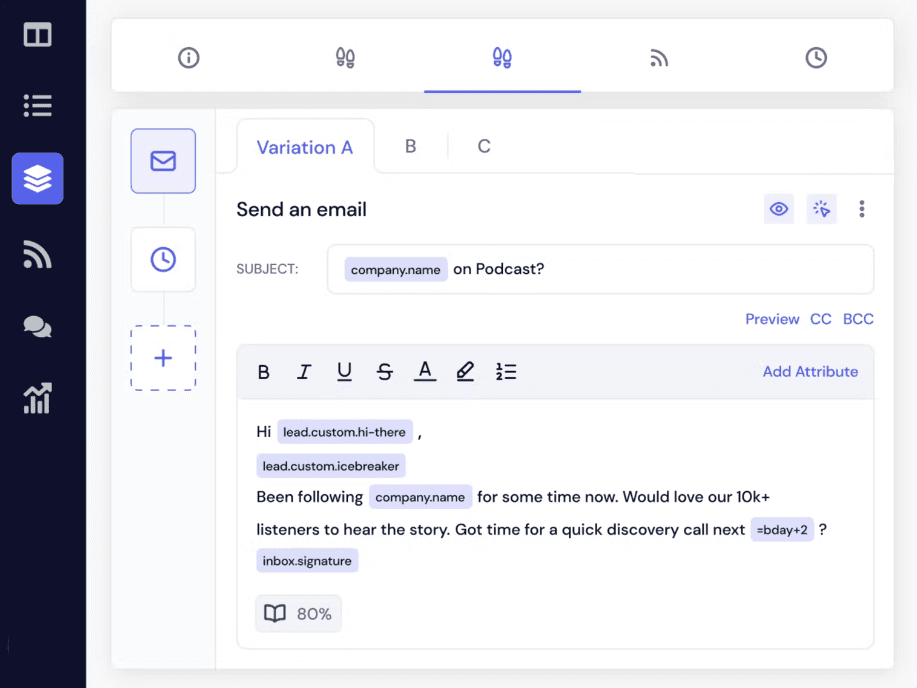
QuickMail is an effective outreach tool that goes beyond email campaigns.
It supports multichannel outreach, combining email, LinkedIn, calls, and SMS to help you reach your prospects where they are.
Linked outreach actions that QuickMail can perform are automatic and include:
- Profile views
- Connection requests
- Messages
This means that they are not compliant with LinkedIn ToS like Skylead is. Contrary to tools like Skylead, which lets you import leads directly from LinkedIn, QuickMail offers 2 import options: a CSV file or Google Drive.
The tool comes with a built-in email warm-up and an inbox rotation feature that maintains high deliverability rates. It supports A/B testing and natively integrates with popular CRMs like Pipedrive and HubSpot. Nonetheless, you can integrate any tool with it via Zapier.
While email verification is available, QuickMail relies on 3rd party tools for this.
Similarly, Image and GIF personalization, while there, isn't native. For this, you’ll need Hyperise, which incurs additional costs.
Moreover, if you want to use LinkedIn in your outreach, you'll need QuickMail’s Chrome extension, which can put your account at risk.
You can add unlimited team members to your QuickMail account. However, you can connect a maximum of 50 email accounts and 15 LinkedIn accounts to the tool. And this is for the highest-tier subscription.
Instantly.ai vs. QuickMail
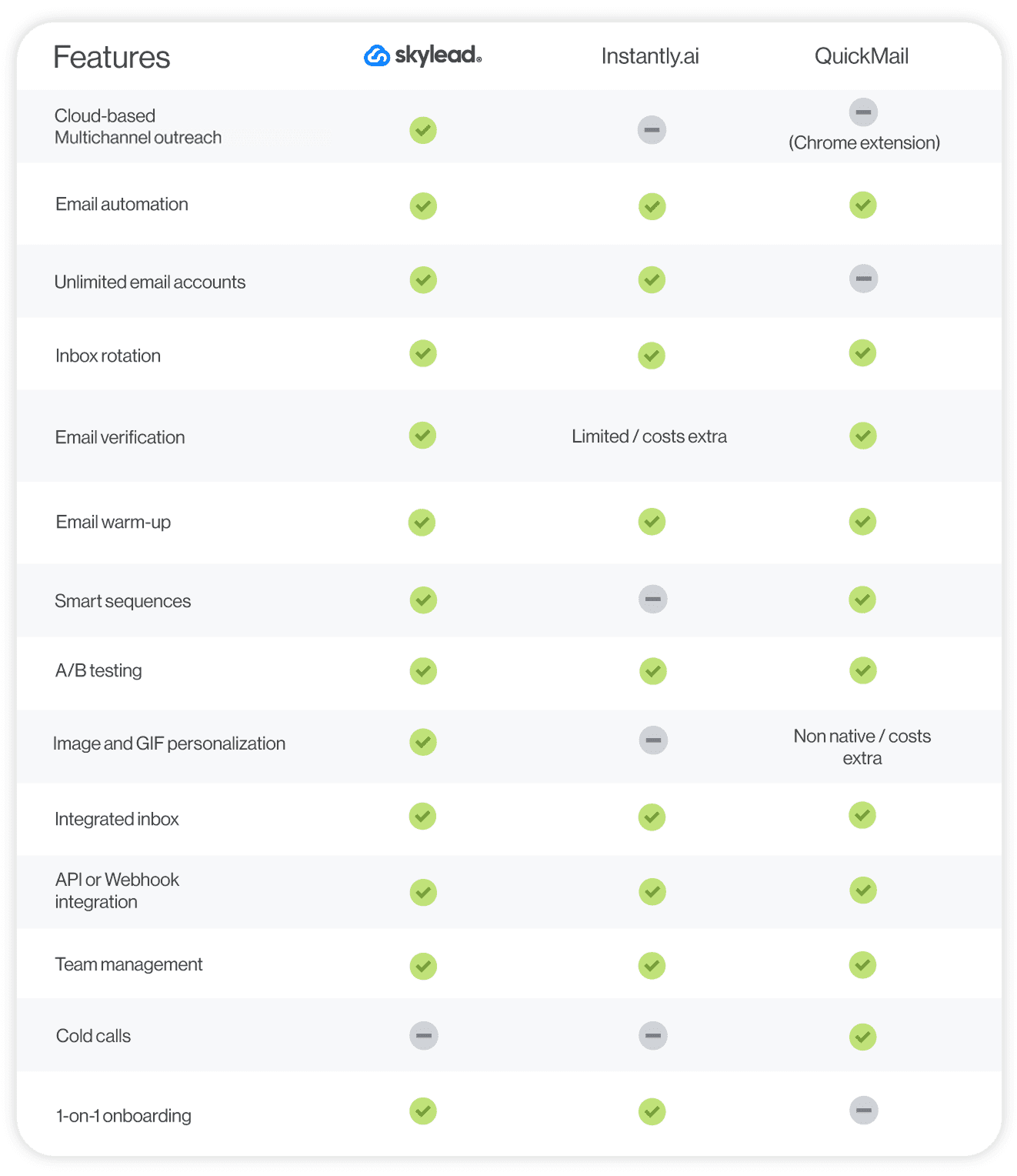
Pricing
| Basic Plan | $49/mo for 1 LinkedIn account and 5 email addresses |
| Pro Plan | $89/mo for 5 LinkedIn accounts and 20 email addresses |
| Expert Plan | $129/mo for 15 LinkedIn accounts and 50 email addresses |
10. Snov.io
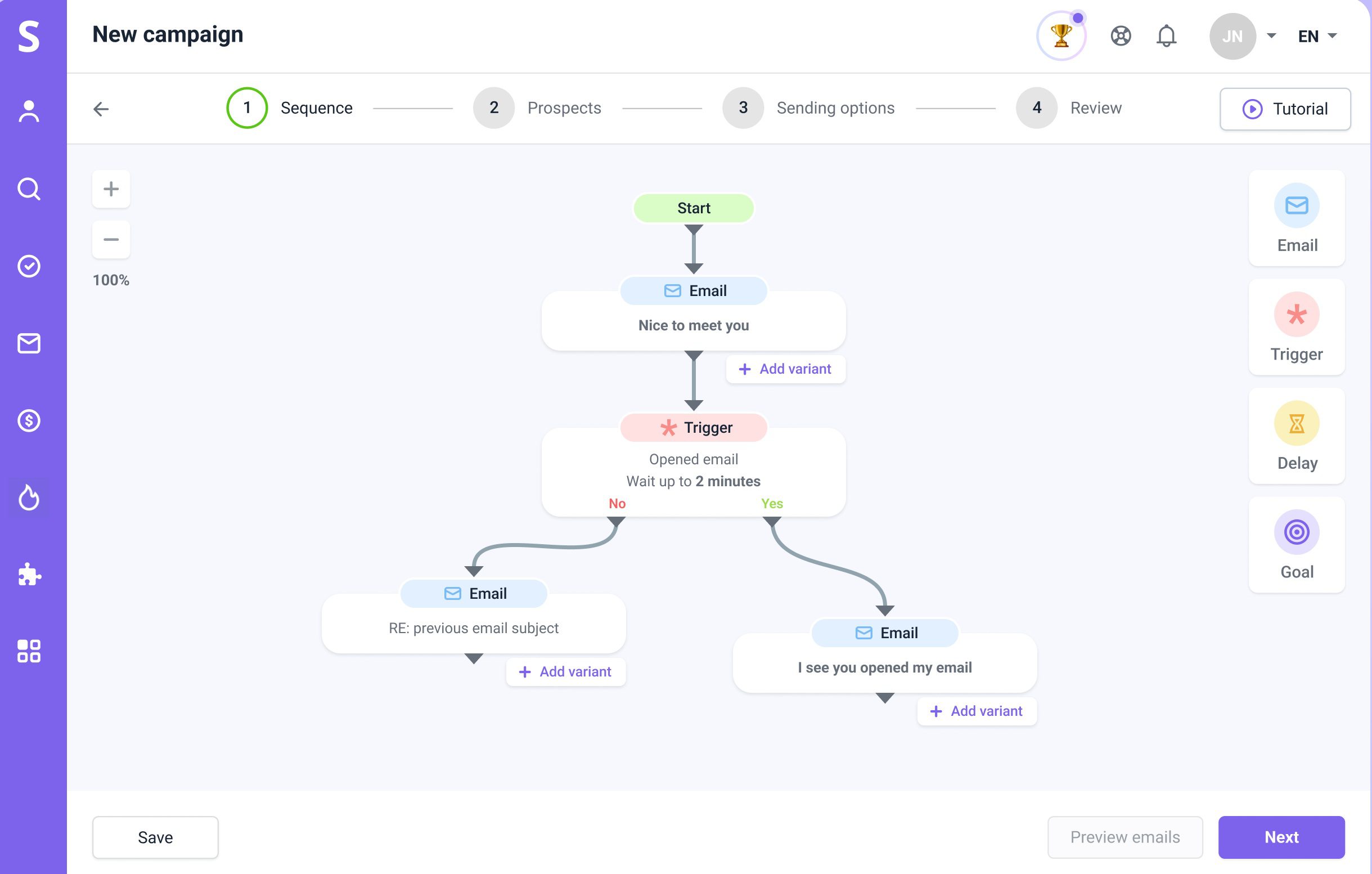
Snov.io is a cloud-based multichannel outreach tool that lets you create automated campaigns that combine emails and LinkedIn touches. These include profile visits, post likes, messages, and connection invites.
The platform lets you add "triggers" to your sequences, similar to Skylead's if/else conditions. These make your outreach smart and adaptable based on how your prospects react.
Additionally, Snov.io comes with a built-in email warm-up tool and a CRM. While the CRM isn’t the most advanced, it has enough functionality to be a good choice for those on a budget.
Snov.io can verify your leads' emails, but this feature isn’t unlimited. In fact, the number of emails you can verify depends on your plan.
Furthermore, for LinkedIn automation, you’ll need to pay an extra $69 per LinkedIn account you want to add to the software.
While Snov.io's LinkedIn automation is cloud-based, the tool prompts you to use their 2 Chrome extensions:
- One for prospecting on LinkedIn
- Another for finding leads' emails across the web.
However, if you choose to use them, be cautious: they may put your account at risk as this tool is not compliant with LinkedIn's ToS.
Instantly.ai vs. Snov.io
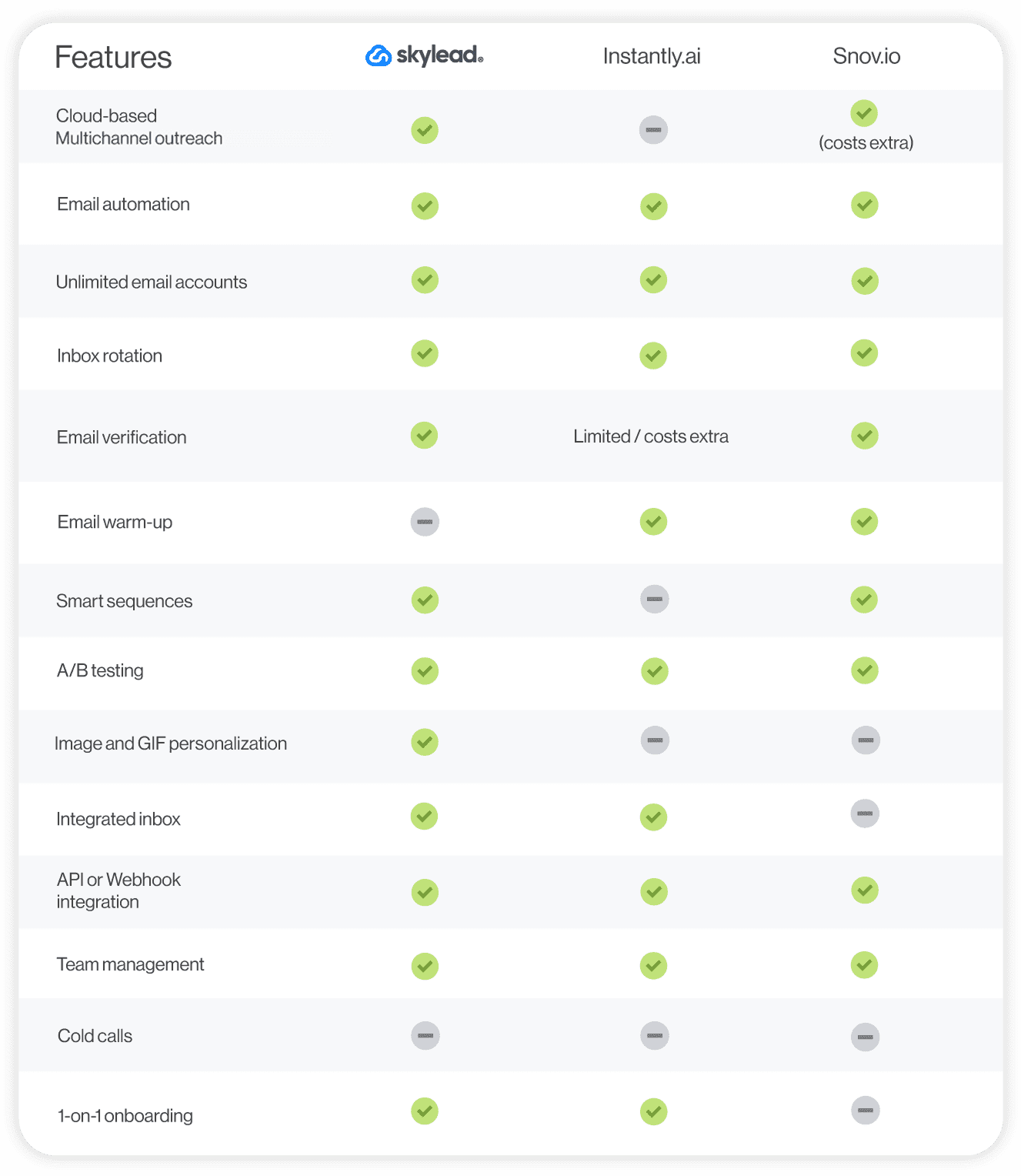
Pricing
| Starter | $39/mo per account | |
| Pro - has 4 sub-plans that differ in price based on the number of leads you can contact | Pro 5K | $99/mo per account |
| Pro 20K | $189/mo per account | |
| Pro 50K | $369/mo per account | |
| Pro 100K | $738/mo per account | |
| Managed Service | $3,999/mo per account | |
11. Salesblink
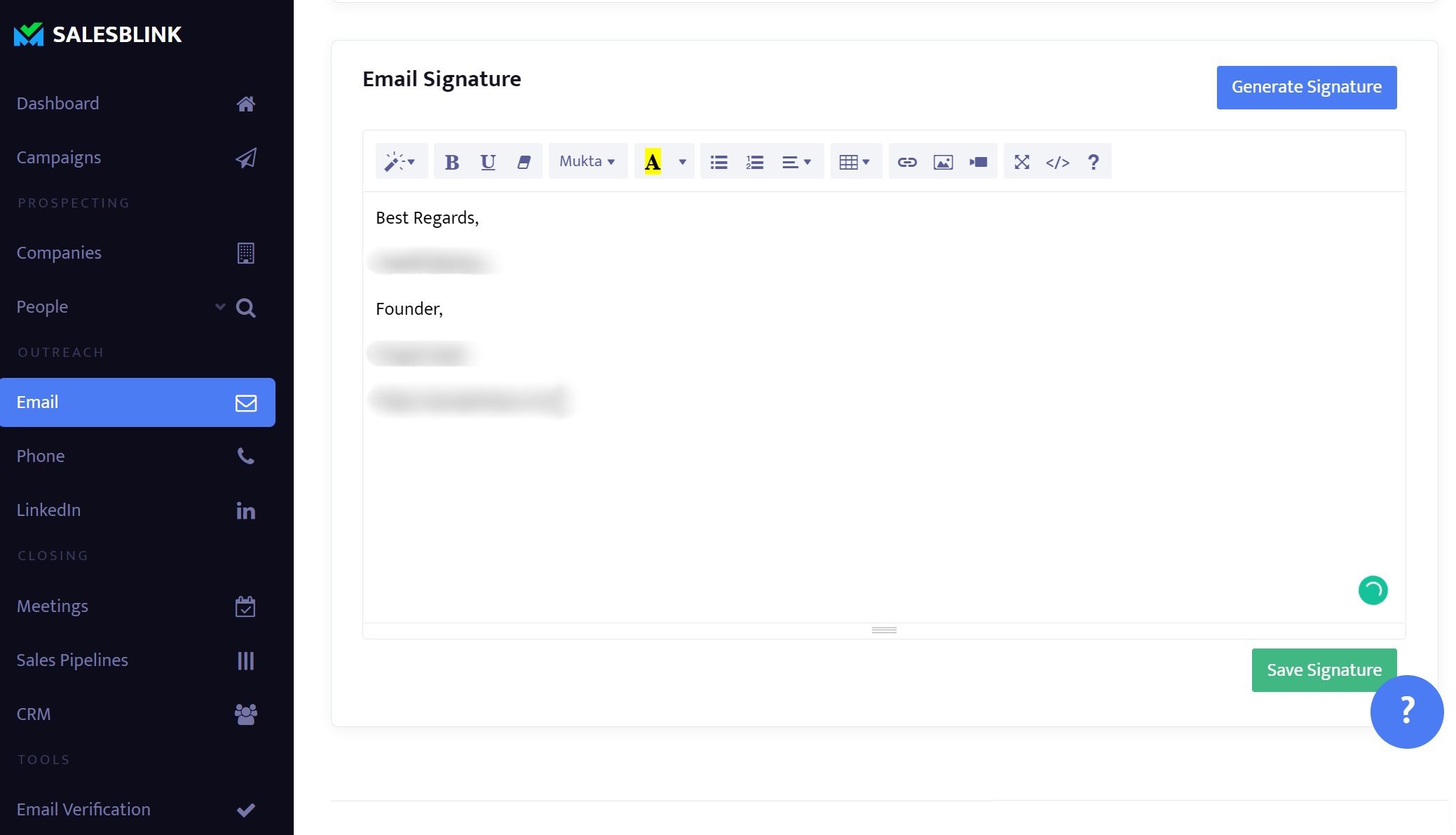
SalesBlink is one of the best Insantly.ai alternatives for cold emailing.
It uses its AI, BlinkGPT, to craft smart email sequences with follow-ups that adapt based on your leads' behavior.
Plus, with its email warm-up feature, your messages are more likely to land in your leads’ inboxes instead of their spam folders.
SalesBlink lets you connect unlimited email accounts and automatically rotates them while sending emails, thus keeping you within safe limits.
Furthermore, it comes with a Unified inbox that keeps all your conversations in one place, similar to Skylead, Instantly.ai, and Smartlead.
Although SalesBlink supports adding multichannel tasks to your sequences, these tasks need to be done manually making them complaint with LinkedIn's ToS.
The tool also provides email verification, but this feature is limited. Simultaneously, it isn't available to the subscribers to the lowest-tier plan.
Instantly.ai vs. Salesblink
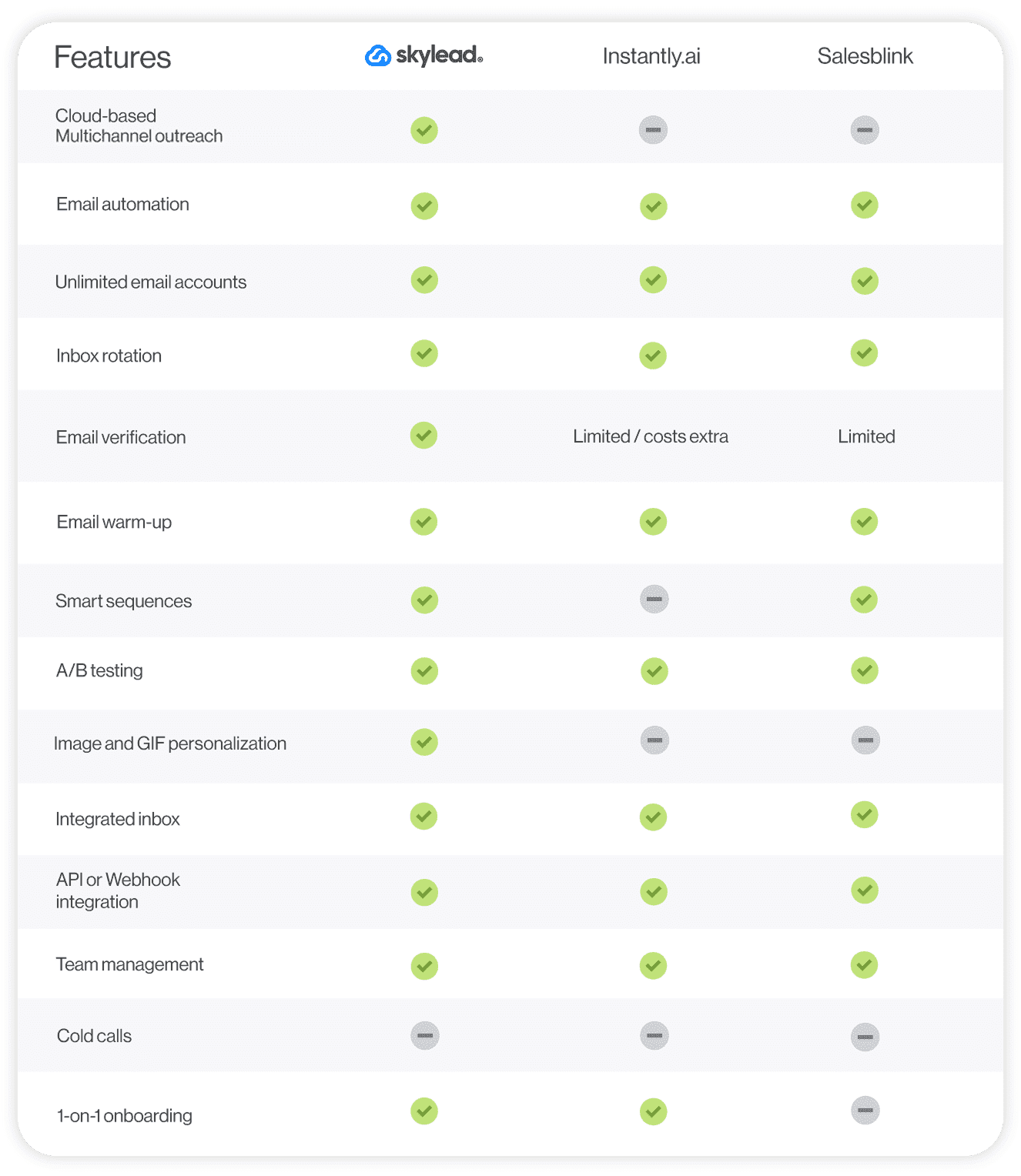
Pricing
The number of emails you can send with the software depends on your plan.
For example, the basic plan lets you send up to 6,000 emails, while the top tier allows up to 100,000.
| Scale | $29/mo per account |
| Growth | $99/mo per account |
| Business | $199/mo per account |
12. Hunter.io
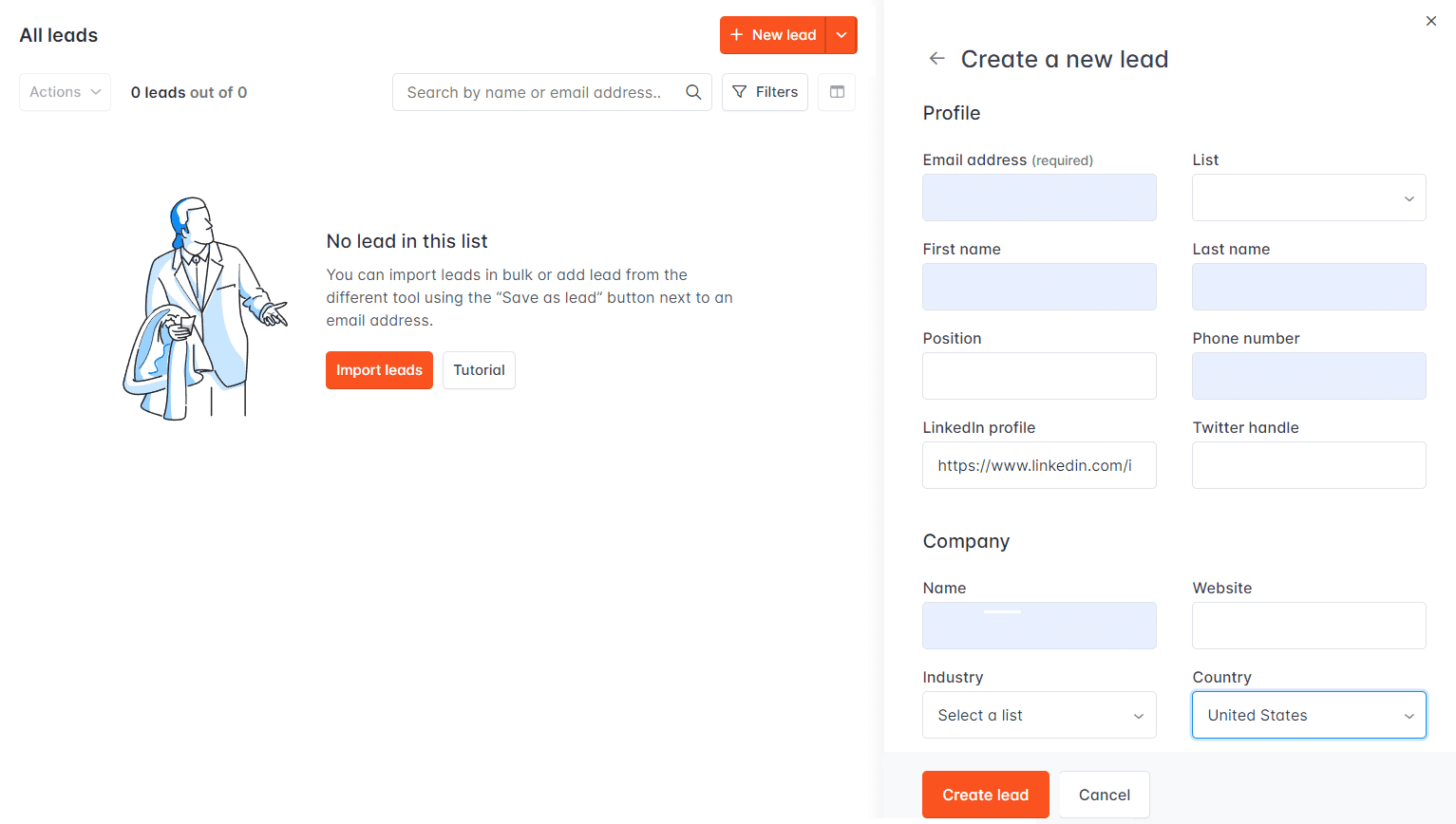
Hunter.io is a tool renowned for its email finding and verification capabilities.
It boasts a user-friendly interface and frequently updates its database with new publicly available emails.
One of its standout features is the ability to invite team members and grant role permissions, which makes team collaboration much easier.
Additionally, Hunter.io offers multiple cold email templates and supports integrations with various CRMs and software via Zapier.
However, there are some limitations. For example, you can only create outreach campaigns if you connect a Gmail or Outlook account. Other email service providers are not supported. It also lacks features like A/B testing, advanced message personalization, and email warm-up.
Furthermore, the tool requires a bit of a learning curve, and the support response time can be slow.
Instantly.ai vs. Hunter.io
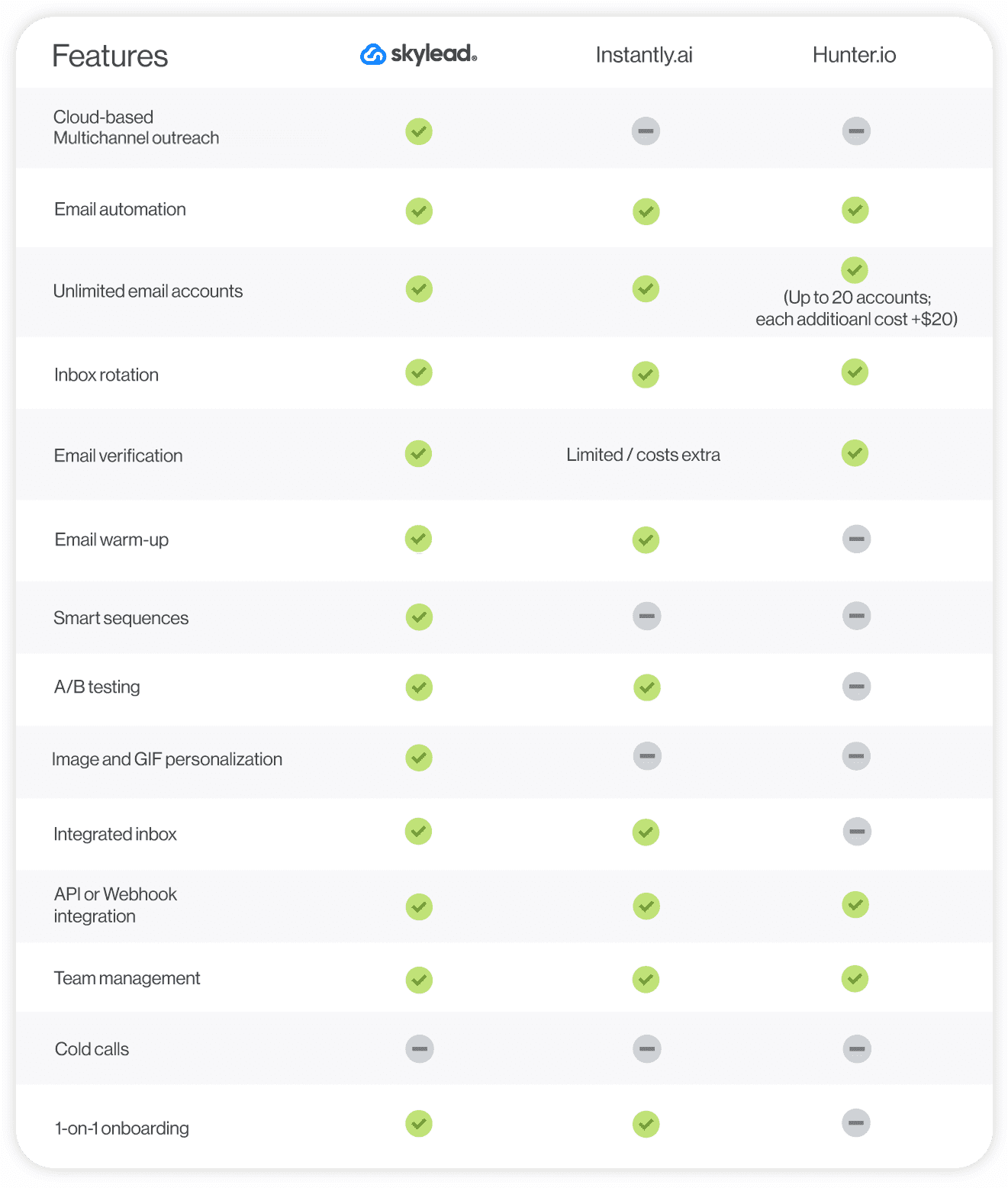
Pricing
| Free | 0€/mo per account with 1 sending email address |
| Starter | 49€/mo per account with 3 sending email addresses |
| Growth | 149€/mo per account with 10 sending email addresses |
| Business | 499€/mo per account with 20 sending email addresses |
| Enterprise plan | Contact sales for pricing details |
How to cancel Instantly.ai subscription?
If you’re not satisfied with Instantly.ai, you can cancel your subscription and try another tool from our list.
Here's how:
- Log into your account.
- Go to the Billing page.
- Under your active plan (s), find the "Cancel plan" button. Click it to confirm your cancellation.
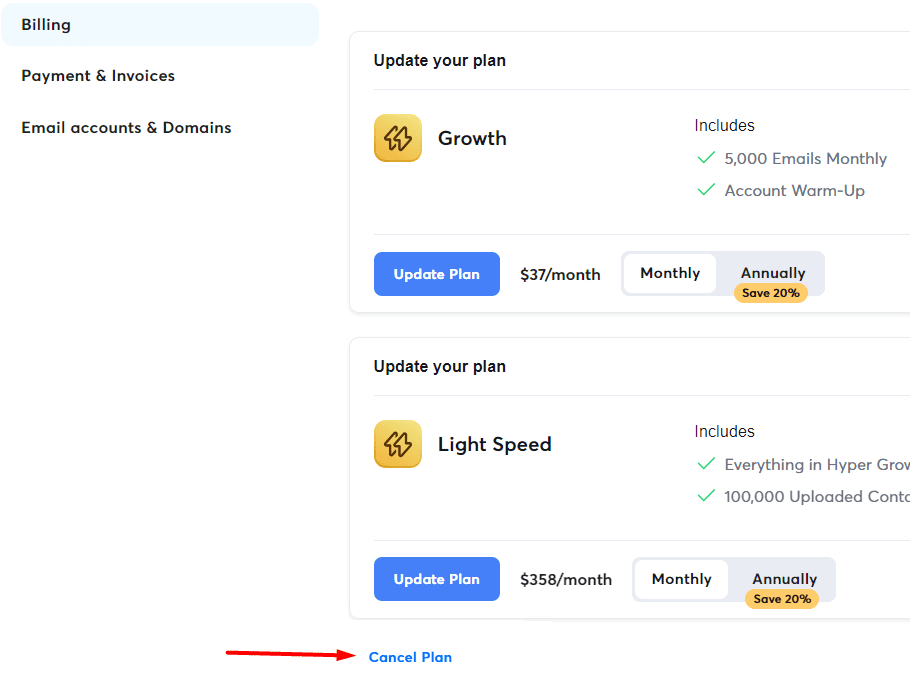
If you have one plan only, you can use it until the end of the billing cycle.
However, if you have both a Lead Finder and Email Outreach plan and cancel only one, the cancellation of said plan takes effect immediately.
Also, if you want to cancel multiple plans, keep in mind that you'll need to cancel each one individually.
Lastly, to confirm your plan is canceled, look at the date listed next to the plan on the Billings page.

Frequently asked questions (FAQs)
What is instantly.ai?
Instantly.ai is an advanced email automation tool designed to help individuals manage their email campaigns more effectively. It offers a range of features, including unlimited email accounts, email warm-up, B2B Lead Finder, and a Unibox.
What does instantly AI do?
Instantly.ai automates various aspects of cold emailing and customer relationship management. It helps users manage multiple email accounts, warm up emails to improve deliverability, find new leads, and keep track of them. The platform also consolidates all emails into a single inbox, making it easier to manage conversations and follow-ups.
How to use instantly.ai?
Using Instantly.ai is easy. Just create an account, add and configure email accounts, and use the email warm-up feature to prepare your accounts for sending. Then, create and launch your email campaigns and manage interactions through Unibox. Finally, use the tracking and analytics page to analyze campaign performance.
Is instantly.ai free?
Instantly.ai is not free but offers various pricing plans to suit different needs and budgets. Each plan provides access to a range of features, allowing you to choose the one that best fits your requirements.
Does Instantly AI have a free trial?
Yes, instantly.ai offers a free trial for new users. This allows you to test out the platform and its features before committing to a paid plan.
How many emails can you send with instantly AI?
The number of emails you can send per month depends on the plan. For instance, the lowest plan limits you to sending 5,000 a month, whereas the Custom plan allows you to send more than 500,000.
Instantly.ai vs. alternatives: What’s the better option?
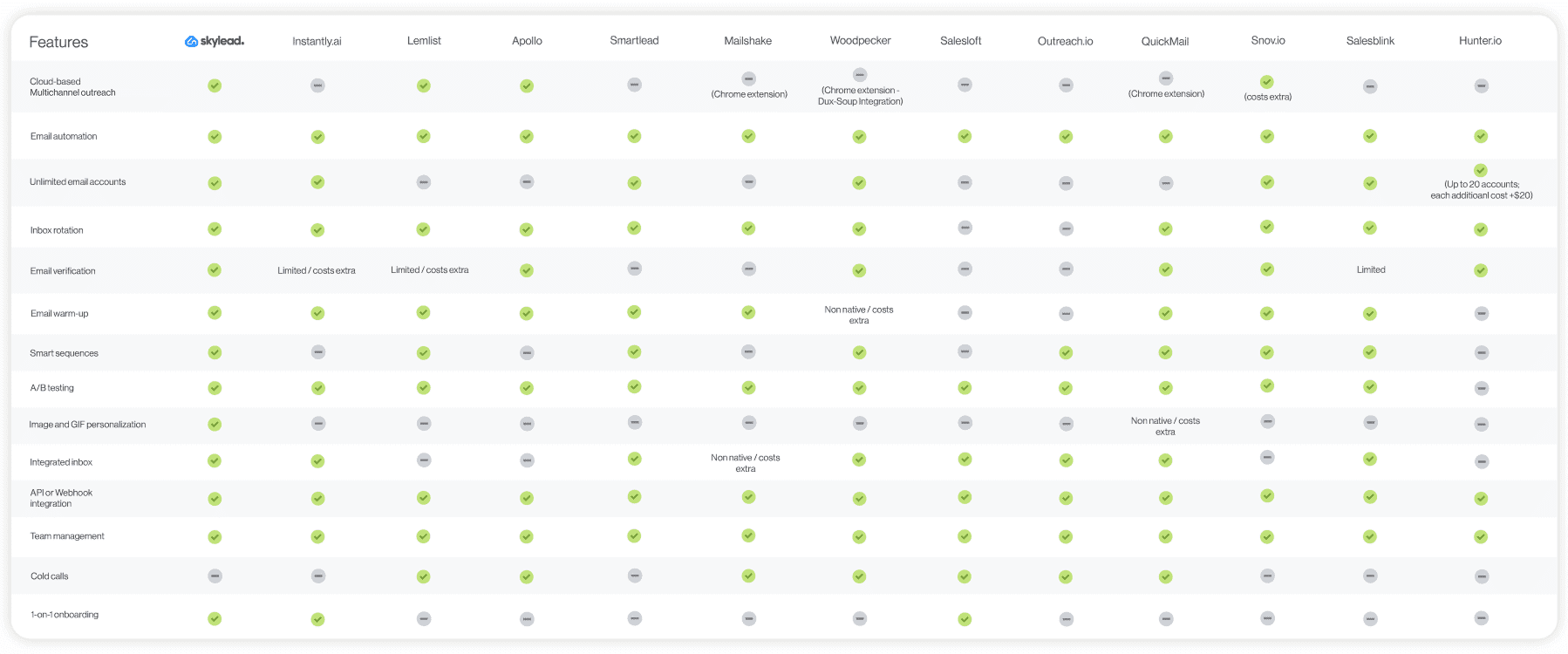
And there you have it—our deep dive into Instantly.ai and its top 12 alternatives.
As you’ve discovered, Instantly.ai has some powerful features. But it's not perfect, mainly because of the lack of multichannel outreach support that tools like Skylead have.
That said, if your strategy relies heavily on engaging prospects across multiple channels, Instantly may not be for you.
Luckily, your perfect alternative is out there, waiting for you to discover it.
We've given you the options. Now, it's up to you to try them out.
But why not start with Skylead?
With a 7-day free trial, you can experience the true power of email and LinkedIn automation combined.
So, come chat with us, sign up, and begin scaling your outreach — to infinity and beyond!
Disclaimer: Skylead is not affiliated, endorsed by, or connected with LinkedIn in any way.
LinkedIn is a social media for professionals, and it’s classified as the number #1 choice for lead generation. This is because it now counts more than 900 million LinkedIn users. Moreover, according to the official LinkedIn stats, 4 out of 5 drive some business decisions. So no wonder that marketing, recruiting and sales teams make LinkedIn outreach part of their daily work routine.
LinkedIn outreach is a vast topic, and there are many misconceptions and good tips on how to do it. That is why we decided to create a detailed LinkedIn outreach guide that uncovers the following:
- Benefits of LinkedIn outreach;
- What medium is better to use for the outreach - LinkedIn or email;
- Strategies, rules, and methods that work best and those that do not;
- How to use LinkedIn for outreach in 4 easy steps and build positive relationships;
- Some of the best outreach message templates you can use;
- Answers to most burning questions about LinkedIn outreach.

What is LinkedIn outreach?
LinkedIn outreach is a process of sending connection requests and messages to your potential clients via LinkedIn. It’s the best way to expand your network, get in touch, warm up, and build positive relationships with your leads.
The 5 main benefits of Linkedin outreach
It’s not just about the ability to send LinkedIn connection requests, InMails, or other LinkedIn messages, but what you will accomplish with them. Here are the benefits you can expect if you use LinkedIn and every aspect of it in the outreach process.
1. Reach high-quality B2B leads with ease.
LinkedIn has over 900 million professionals from every industry in the world. So it's no wonder this audience has twice the buying power of the average web audience (LinkedIn). Therefore, sales teams can rest assured that with the right filters and top LinkedIn lead generation strategies, they can find the most qualified business-to-business leads for their business.
2. Increased reply rate.
LinkedIn is, first and foremost, a social media platform where you can find various information about your leads. That said, the secret to LinkedIn outreach is personalization and genuine conversation. By looking at your lead's profile, you can search for any information to personalize your message. Whatever you find, be it a mutual connection or a post they shared, you can reference that in your outreach message and thus increase your acceptance and reply rate.
3. Target B2B leads with more precision.
Marketers no longer need to struggle to find professionals on Instagram or Facebook. Instead, they can find and reach out to their potential leads easier with targeting and retargeting options via LinkedIn ads. Moreover, they can generate greater awareness for their product or service. LinkedIn marketer can also easily contact their target audience via sponsored InMail ads and experience 2x more conversions.
4. Find ideal employees.
One of the best perks of LinkedIn is that recruiters can publish job posts for free. However, they can also find the best employee for their business by tapping into a larger pool of talent and headhunting the ideal candidates directly.
5. Break the wall and reach out to recruiters.
By using job posting websites, you can’t get a hold of recruiters. However, LinkedIn allows you to find, send a connection request and reach out to the hiring managers in your ideal company. This way, you can explain why you are perfect for the job or get feedback on your application, all of which you cannot do on other platforms.
LinkedIn vs email outreach - Which one is better?
Both LinkedIn and email channels are used extensively for outreach. However, there is a "slight" advantage to LinkedIn.
The thing is, the social media nature of LinkedIn allows more genuine communication between its users. On the other hand, cold email outreach is distant and often perceived as spammy since, among other things, you cannot always see and find out more about the person behind the cold message.
And the end result can be measured shown in numbers.
For example, according to the official LinkedIn learning courses, InMails have an average response rate of 18 to 25%. On the contrary, cold emails have only a 3% average response rate, and this happens for a couple of reasons.
Firstly, LinkedIn outreach is more transparent since potential leads can see your LinkedIn profile, work history, bio, or posts. In other words, what they are all about.
Secondly, LinkedIn sends a couple of alerts and reminders when the prospect receives a message. In addition, if the leads have a LinkedIn app installed, they will also receive a notification on their phone. What's more, if you send a follow-up message, LinkedIn will send the same amount of alerts, making it harder for your prospect to forget to reply or ignore.
Lastly, if you use LinkedIn, you can find your ICP and people who work in it in the blink of an eye. This way, you can easily reach out to your potential customers without navigating multiple platforms.
However, with LinkedIn's power, we must recognize email as the outreach channel simply because some users prefer email communication or are inactive on LinkedIn.
That said, it's best to use both LinkedIn and email outreach for optimal results. So, we will discuss it in the LinkedIn outreach rules section below.
LinkedIn outreach methods
LinkedIn offers multiple ways you can use to reach out to your potential customers.
Connection requests
The first outreach action in line is a LinkedIn connection request. You can send a connection request to your 2nd and 3rd-degree connections along with your first message.
This cold message comes with a restriction of 300 characters, so try to keep your personalized message short and sweet. For example, you can reference a mutual connection or that you’d like to discuss the event they attended and wish to connect.
Direct messages
Once the lead accepts your invite, they become your 1st-degree connection, and you can send them a direct message. This message acts as both chat and email since it’s delivered straight to your lead’s inbox along with the notification. In addition, direct messages can be 8,000 characters long or somewhere between 1142 and 2000 words.
InMail messages
If your lead ignores your connection or leaves it pending for a long time, you can always send LinkedIn InMail. These InMail messages are structured as emails and can have up to 200 characters of the subject line and a body of up to 1900 characters. However, keep in mind that shorter InMails get a better response rate.
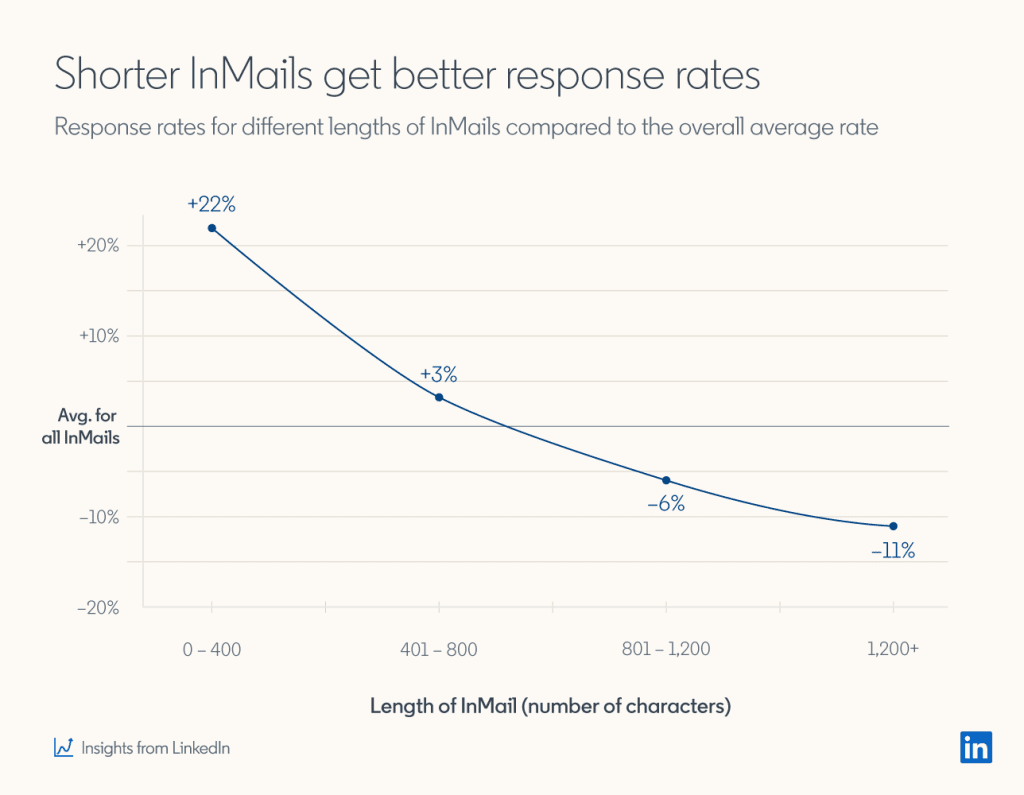
As mentioned before, LinkedIn InMail gets far better results than emails. Especially if you write a message that will generate a high response rate. If you are not sure how to write such messages, here are a couple of LinkedIn InMail examples with a 25% reply rate formula to get inspired, along with impactful LinkedIn inMail subject line examples..
You can send InMails to your 2nd and 3rd-degree connections. However, depending on your subscription plan, you will have different amounts of Inmail credits per month. For example, a LinkedIn premium subscription grants you 15 paid InMail credits. On the other hand, the Sales Navigator account offers 50 paid InMails per month. If you pay a Recruiter Lite subscription, you will have 30 paid InMail credits a month. Recruiter subscribers are also the only LinkedIn members who can purchase additional paid InMail credits.
Apart from paid ones, you can also send 800 free InMails per month. The trick is to find people with their LinkedIn profile set to Open. The easiest way to find people with an open profile is by going to your 2nd or 3rd-degree connection’s premium profile. Then click the Message button. If you see the text Free message at the bottom, that person has an open profile.
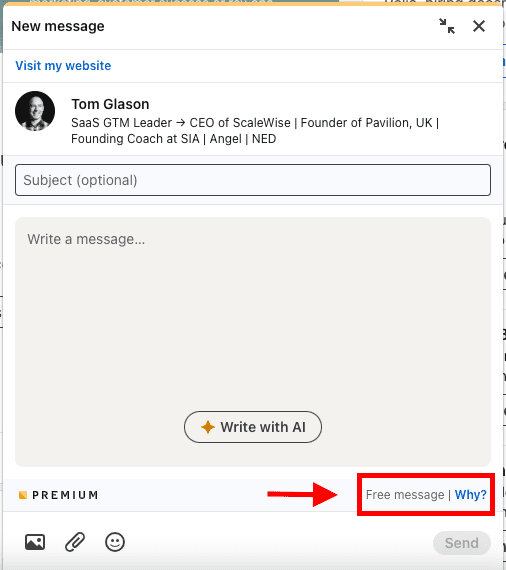
View profile and follow features
And if your outreach falls behind, you can always stop by your lead’s LinkedIn profile to view or follow them. The leads will receive a notification of whichever action you perform. In other words, it will almost always remind them of your message and give them a nudge to respond to you.
LinkedIn outreach in 6 easy steps
1. Define ICP and buyer persona
The first step to finding qualified prospects & leads is creating an Ideal Customer Profile and Buyer Persona.
These documents represent the aspects of your perfect leads and the company they work in. They are the basis for quality lead generation and usually contain specifications such as:
- Job titles;
- The industry they work in;
- Company size;
- Pain points, etc.
ICP and Buyer Persona are best created based on your current customer data, such as who:
- Has the shortest buying cycle;
- Keeps high retention rate;
- And refers your product elsewhere.
In addition, try to keep these documents actionable. In other words, create the specifications so you can use them either for:
- Your prospecting via LinkedIn, Recruiter, or Sales Navigator advanced search filters;
- Or for LinkedIn outreach messaging.
2. Find leads using LinkedIn search & creating lists
The next step is finding prospects that match your ICP and Buyer Persona.
If you use LinkedIn Sales Navigator or Recruiter for lead generation, you are probably familiar with various advanced search filters. Simply use LinkedIn Sales Navigator filters and import all specifications from your ICP or Buyer Persona documents. Then, save the search URL, or create a list of prospects for the next step.
If you don’t have a LinkedIn Sales Navigator account, no worries. You can still use basic filters to find your ideal leads. Or you can use some of these top LinkedIn lead generation strategies.
3. Craft your LinkedIn outreach message and outreach
LinkedIn outreach is all about how you craft your messages. So, here is a nifty hack for you. In general, every message, be it a connection request, InMail, or email, should contain one of the following:
- Your background;
- The purpose of your outreach;
- Personalized points;
- The hook;
- A solution to the pain point.
And aim for the following structure:
- Personalized intro;
- Context;
- Added value;
- CTA.
4. Nurture & engage
Once the lead responds, it’s your job to engage and nurture them to conversion. People skills play a significant role here, so here are a couple of pro tips that will help you:
- Be empathetic so you can understand their problem and how they feel about it.
- Don’t pitch first. Instead, ask them about their specific problem and customize your pitch.
- Be confident.
- Listen actively.
- Read between the lines.
- Understand body language and voice tones when you jump on a meeting.
- Be an expert at what your company does.
Top 9 LinkedIn outreach strategies
Less is more
When you write your outreach messages, it’s crucial to understand that people’s attention span is, on average, 8.25 seconds (The Treetop Therapy). That said, longer sentences and texts that cause TLDR are a no-go. So our first LinkedIn outreach strategy is approaching your leads with fewer words.
Try being straightforward with your LinkedIn messages and avoid fillers such as:
- Hope you are well;
- I was just wondering;
- Have you had the chance to;
- Just touching base;
- I’m following up on;
And so on.
Personalize
This is the essential LinkedIn outreach strategy. By writing personalized outreach messages, we connect on a deeper level with the people and remove any generic communication. This is a perfect base for social selling and securing the path for better response and acceptance rates.
You can personalize your LinkedIn outreach messages with their first name or job title. However, there are more detailed ways to do it, and we will mention them below.
Send free resource
Avoid pitching in your first message. Instead, start your conversation by asking about the lead’s workflow and pain points. Then send them a free resource that helps them solve the problem they mentioned.
If you start your sales engagement this way, you will have more significant success, as you do not appear intrusive. In return, you get the necessary information to tailor your pitch accordingly.
Leverage your connections
The more you have in common with your target audience, the more honest and reliable you appear. That said, how you seem to be can make or break your LinkedIn outreach.
One of the ways to bring similarity to your LinkedIn messages is by leveraging your mutual connections. For example, people are more open to accepting your invitation if you refer someone they know. Here is an example:
Hey {{firstName}}, {{mutualConnectionName}} sent me your profile as they think you are the right person to help me out in my research about {{Topic}}. So let’s connect and talk if you’re up for it.
Leverage LinkedIn Groups
Another way to discover leads for LinkedIn outreach is by leveraging groups. Even though they are not that active anymore, you can still use them to find and reach out to people who are still in these LinkedIn groups.
Find the LinkedIn group your leads are most likely a part of, and click Show all to see all members.

In addition, you can reference a LinkedIn group post in your outreach and ask them about their opinion about it.
Turn events attendees into your leads
LinkedIn lead generation lets you get creative with finding your most qualified leads. One of those creative ways is reaching out to event attendees.
You can find LinkedIn events that focus on the exact problem your company solves with a product or a service. This way, you can target people who are already warmed up for your outreach message.
To get to event attendees, search for the events and click the Attend button.
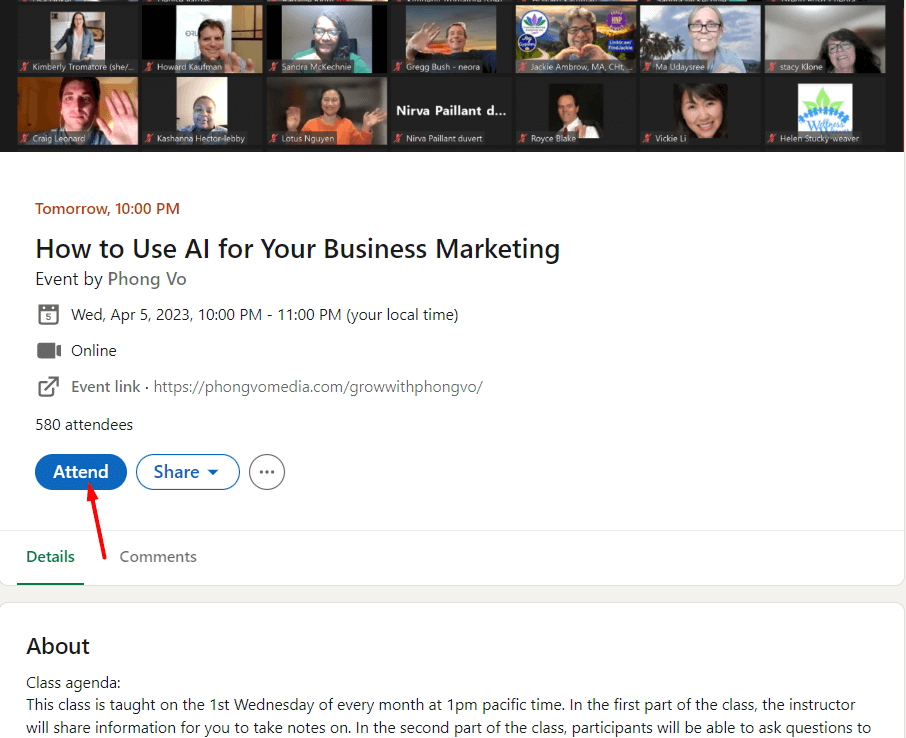
After you've attended, you can check for the list of LinkedIn users who attend this event by clicking Attendees.
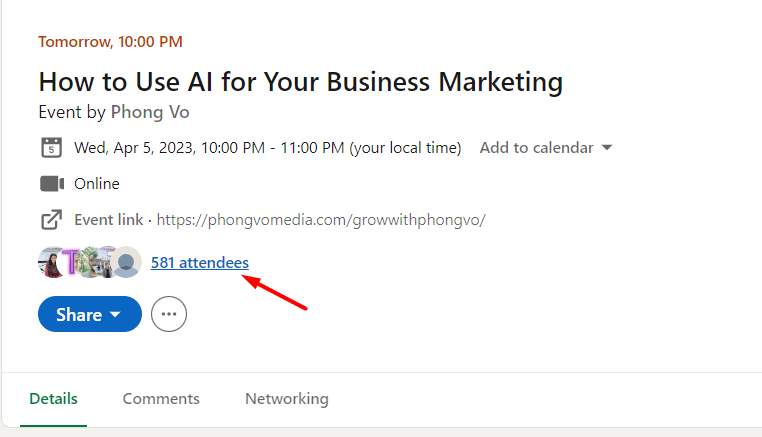
You can then go through the list and create leads in your CRM.
A true hack for LinkedIn outreach here is that you can write personalized messages such as this one:
Hey {{firstName}},
I’ve noticed that you attended {{eventName}}. What did you think about {{eventTakeaway}}? Let’s connect on this.
Contact companies that are hiring
Companies currently hiring or experiencing some change are more likely to be willing to test new products. In other words, these companies emit some buying signals.
Here’s how to find them for the LinkedIn outreach.
If you have a Sales Navigator, finding these companies is a piece of cake. Simply go to Account filters, and under Spotlights, select Job Opportunities.

LinkedIn Sales Navigator will then list company names. You can also narrow your search by selecting other filters, such as Company headcount or Technologies used.. This advanced search will help you find your ICP with the buying signals.
If you are a free or Premium LinkedIn user, you can find these companies by navigating to the LinkedIn search field. Type in the job title, select Jobs and use other filters to narrow your search. Then, go through company names and mark them down in your CRM to find key decision-makers later on.
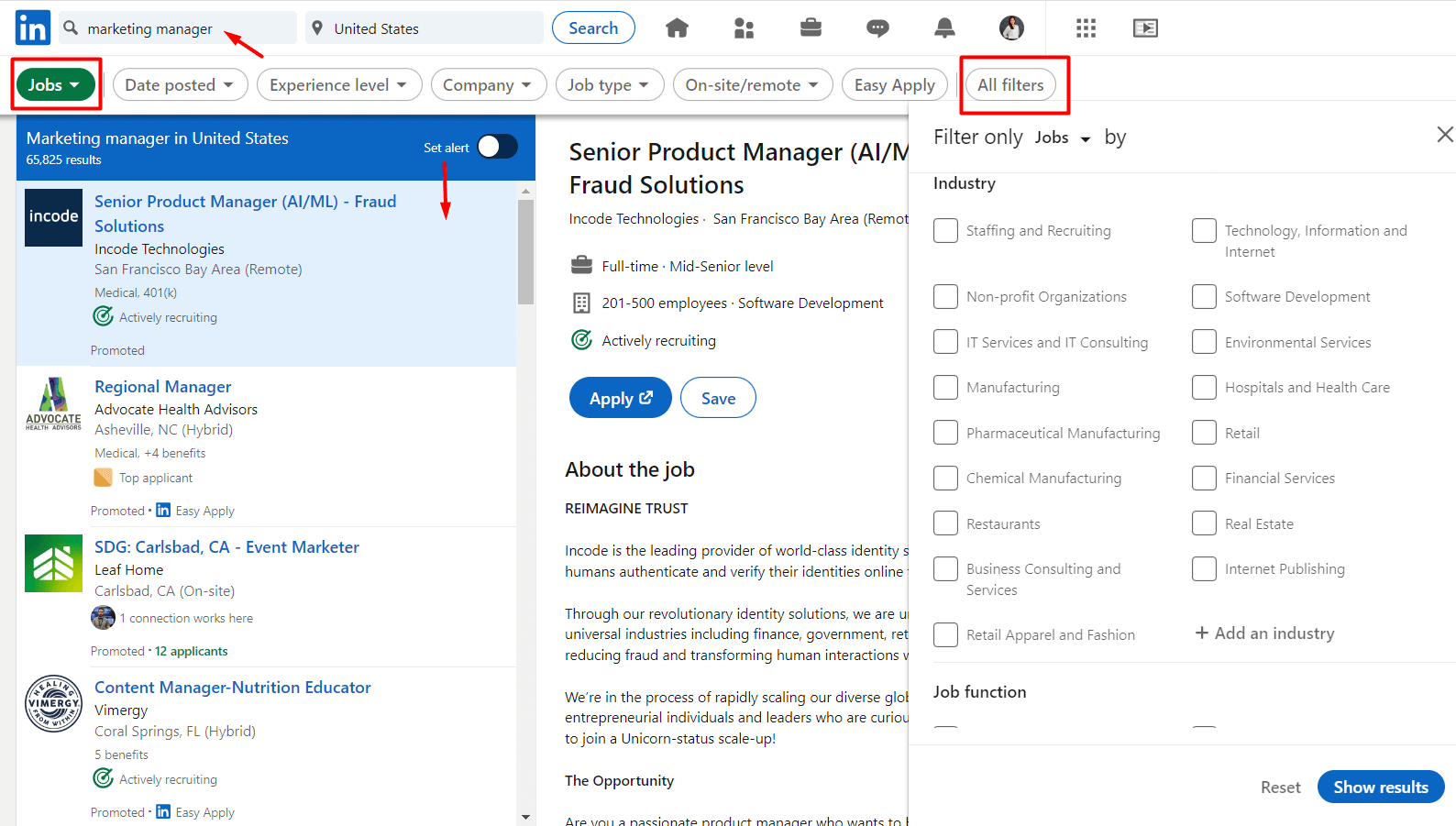
You can then reach out to the decision-makers in these companies by sending them a connection request such as this one:
Hey {{firstName}},
I noticed you are looking for a new {{Occupation}} in your company. Do you plan to change the workflow as well? If so, I have an idea that can help you improve your team's productivity and would like to connect with you.
Engage with people who reacted to a post
You don’t have to reach out only to the leads you found via LinkedIn search. If you find time, scroll through your feed or notifications and check reactions to posts. Then, whenever you see your potential lead engaging, take that opportunity to start the conversation. After all, this is one of the most natural ways to start building relationships with your network and leads.
Use AI to speed up your outreach processes
In just over a year, the integration of AI into our daily lives has transitioned from a futuristic concept to an integral part of our personal and professional routines.
When it comes to the LinkedIn outreach process, there are a few areas where you can use ChatGPT and AI-assisted tools to speed up processes. However, it is important to underline the importance of human intervention to make the AI-generated text sound as natural as possible and to adapt it to different leads and situations.
AI-assisted LinkedIn InMails
Due to their indisputable success rates, LinkedIn recognizes the importance of InMails and now offers AI-assisted InMail writing to its paying members.
All you need to do is open the InMail message window, click on the Write with AI button, and choose among the offered outreach scenarios.
You can ask AI to rewrite the message from scratch, or you can manually adjust some parts for greater impact.
Craft any message with AI-powered tools
In our blog post on how to use ChatGPT for sales, we provided detailed information on how to create prompts and inputs for ChatGPT to create any type of LinkedIn outreach message. In addition to ChatGPT, other AI-powered writing tools such as Grammarly, ProWritingAid, and Clearscope, for example, are also gaining popularity for increasing writing quality, improving grammar and style, and optimizing content for SEO. These AI tools offer valuable assistance in proofreading, editing, and optimizing written content for various purposes.
Use AI-driven content to post on LinkedIn
By consistently sharing valuable and informative content, you can establish yourself as a thought leader in your field, foster meaningful connections, and attract potential leads who resonate with your expertise and insights.
However, as we all know, writing compelling social posts takes time. On top of that, if you want to give value to your audience, every now and then you must additionally research certain topics. This is where ChatGPT and other tools for AI-driven can help you significantly speed up these processes and help you drive engagement on the platform.
7 LinkedIn outreach rules you need to consider
1. Have an optimized profile before you start
Before using your LinkedIn account for cold outreach, you need to sort out your LinkedIn profile and optimize it. In other words, setting up your profile includes:
- Picking the best profile picture and cover photo;
- Creating a catchy LinkedIn headline;
- Write your detailed summary;
- Fill in the experience section.
If you do it thoroughly, people will be more prone to accept your connection request or respond to your InMail message.
2. Think multichannel
Did you know that companies with omnichannel engagement strategies retain 89% of customers (invesp)? Then, don’t just stop at LinkedIn outreach; for the best results, include email outreach as well since it’s still an essential means of correspondence.
This way, you are showing your target audience that you care and that you are expanding your reach. What’s more, you increase the chances of getting a hold of your leads who are not active on LinkedIn. Or in case your lead leaves your invite pending for a long time.
3. Don’t be too salesy
Nowadays, LinkedIn prospecting and cold outreach can’t do anything if your approach is too salesy or spammy. In other words, don’t talk only about your company or a product. Instead, take a legitimate interest in your target audience, build the relationship first, and connect on a human level. It’s the only way without sounding too salesy and a part of the tremendous social selling. So always choose a more genuine approach to nurturing leads.
4. Provide value
Consistently provide value in the form of educational content or throughout the meeting. The pro tip here is to do it after you’ve asked your leads about their pain points. This way, you’re ensuring you are tailoring your value according to what they precisely need and want.
5. Follow up consistently
Leads often do not respond to your message, and it’s not always because they are not interested. Maybe they forgot or were busy at that time.
Suppose your prospect doesn’t respond to your LinkedIn outreach message or email. Send them a follow-up one. After all, if you do, you will increase your chances of receiving a response by 25% (invesp). So why waste it?
To help put your follow–up message together, check out our templates to send follow up emails after no response and get inspired.
6. Revoke old requests
One of the main rules people doing LinkedIn outreach stick by is canceling their LinkedIn invites.
There is a common fear that LinkedIn won’t allow you to send new requests if you accumulate unanswered ones. Unfortunately, the fear is legitimate, as quite a few people have experienced this restriction.
If the lead doesn’t answer the LinkedIn connection request or follow-ups in months, chances are they are not interested anyways. So be sure to lean up your LinkedIn invites regularly.
7 Best LinkedIn outreach templates [Our best picks]
Linkedin outreach message templates for sales
Sales outreach is about the initial impressions. That said, here are a couple of templates that demonstrate those exact points.
Acceptance rate: 34%
Reply rate: 17%
Template
Hey {{firstName}},
I came across your LinkedIn profile and was so inspired by your background in {{industry}} and your passion for {{workAreaOfInterest}}. I’d like to connect and exchange ideas in both areas.
LinkedIn connection request example
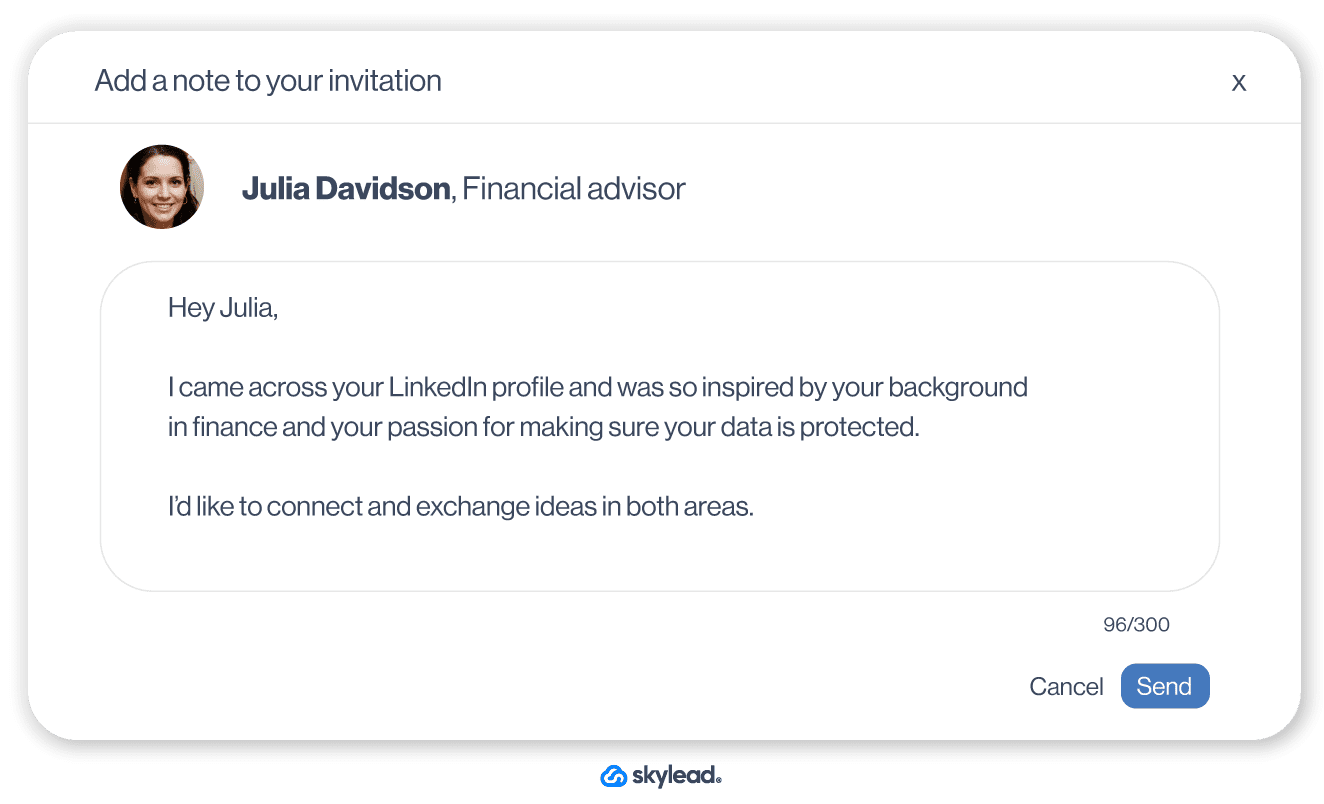
Bonus points if you can reference mutual connection. And if you feel like being humorous, you can spice up your invite with an industry-related joke, such as this one.
Acceptance rate: 53%
Reply rate 27%
Template
How many {{leadPositionTitle}} does it take to screw in a light bulb? None – they’ve automated it. 🙂 Just kidding, {{firstName}}.
But if you really wish to automate al part of your {{leadSectorName}} workflow, let’s chat. I’d like to show you something that would make your life easier. Let’s connect.
LinkedIn connection request example
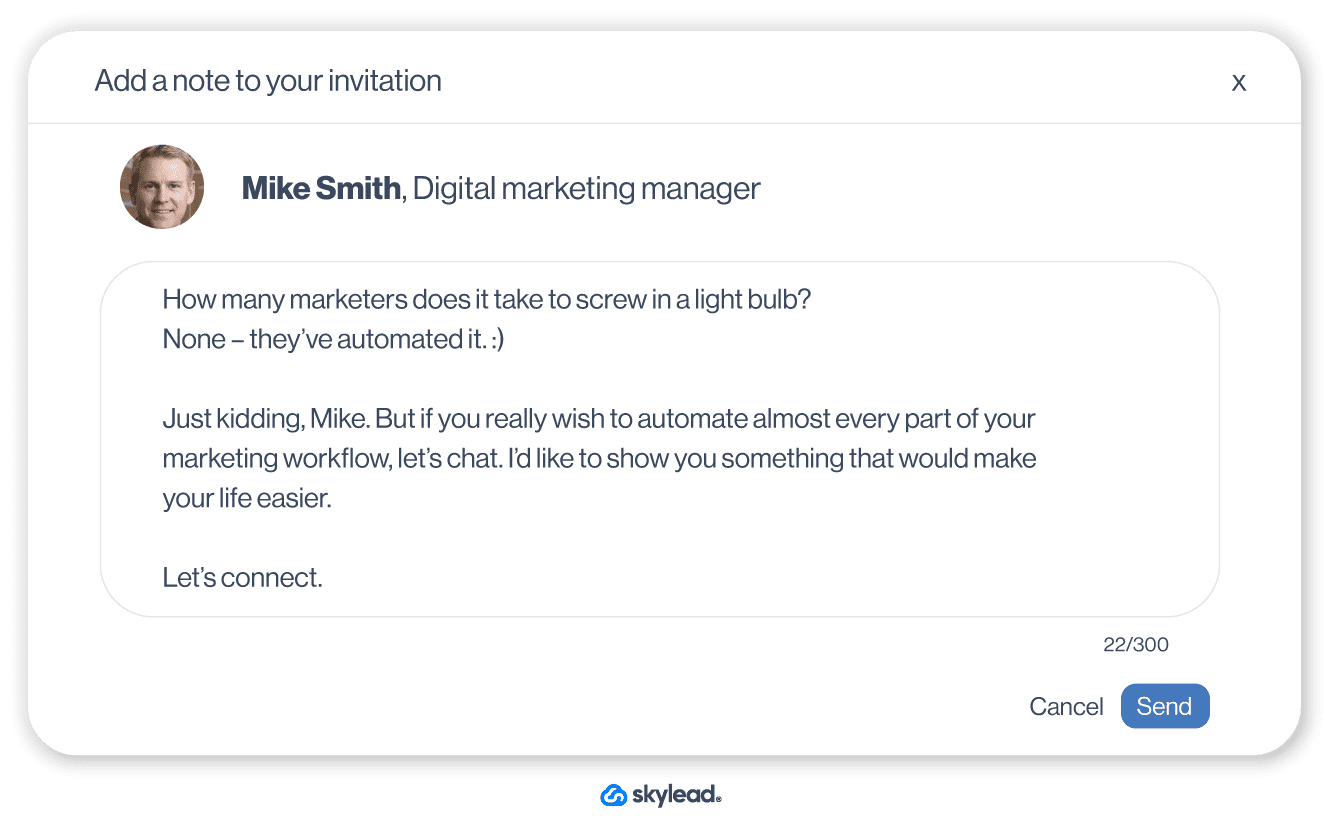
However, if all fall short and your lead doesn’t accept your invite, you can always send a LinkedIn InMail such as this one:
Acceptance rate: 43%
Reply rate: 23%
Template
Subject line: There is a key to solving {{painPoint}}
InMail message:
Hey {{firstName}},
My name is {{yourName}}, and I tried reaching out and connecting via LinkedIn invite. It appears that we didn’t get the chance to connect.
I was very much impressed with your LinkedIn profile. So, I believe your experience and dedication to {{workAreaOfInterest}} make you the perfect person to introduce you to our groundbreaking {{toolSpecification}} tool {{yourSoftwareName}}.
Our tool is created by {{leadPositionTitle}} for {{leadPositionTitle}} and it helps you:
1# {{Benefit}}
2# {{Benefit}}
3# {{Benefit}}
4# {{Benefit}}
I'd love to offer a personalized demo, so you can see hands-on how it works. Let me know if you're up for it, and we'll schedule a 15-minute call asap.
Best, {{yourName}}
InMail example
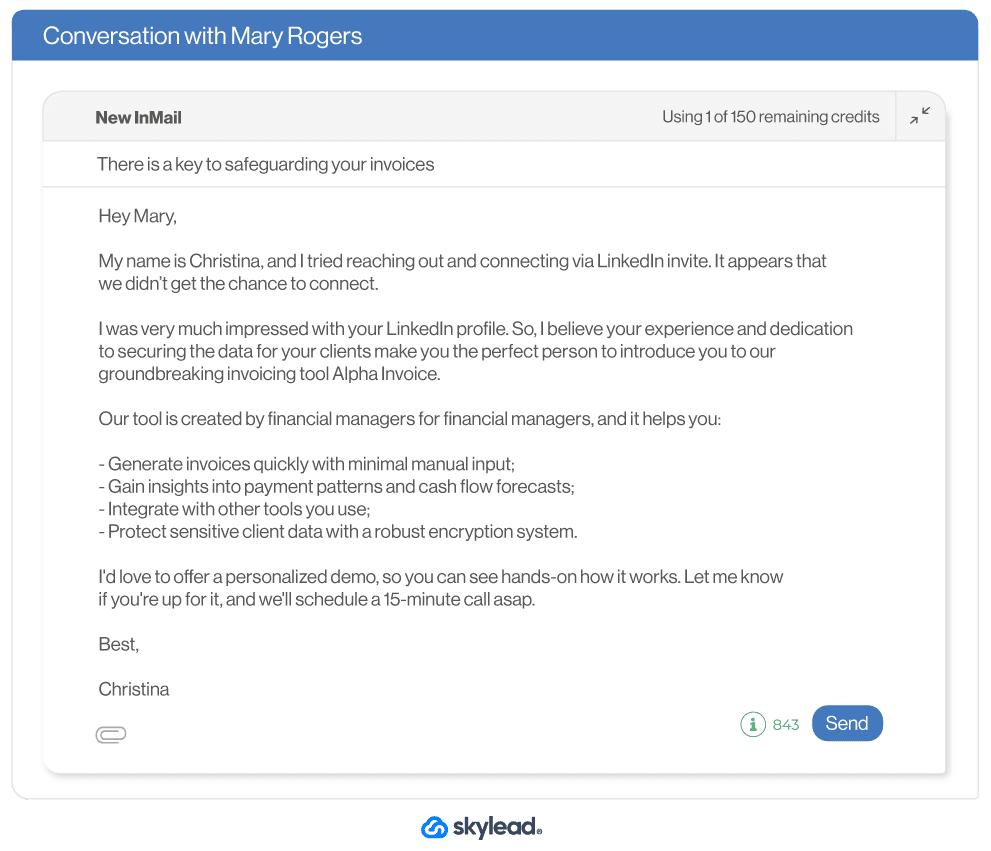
LinkedIn outreach message templates for recruiters
For example, let’s say you wish to reach out to your perfect candidate for the job in your company. Your LinkedIn connection request can sound like this:
Template
Hey {{firstName}},
My name is {{yourName}}, and we’re currently seeking a {{Occupation}}, and I truly believe that this role offers you a platform to leverage your skills and make a significant impact at our company. I’d be happy to share more details about the role and benefits we offer.
LinkedIn connection request example
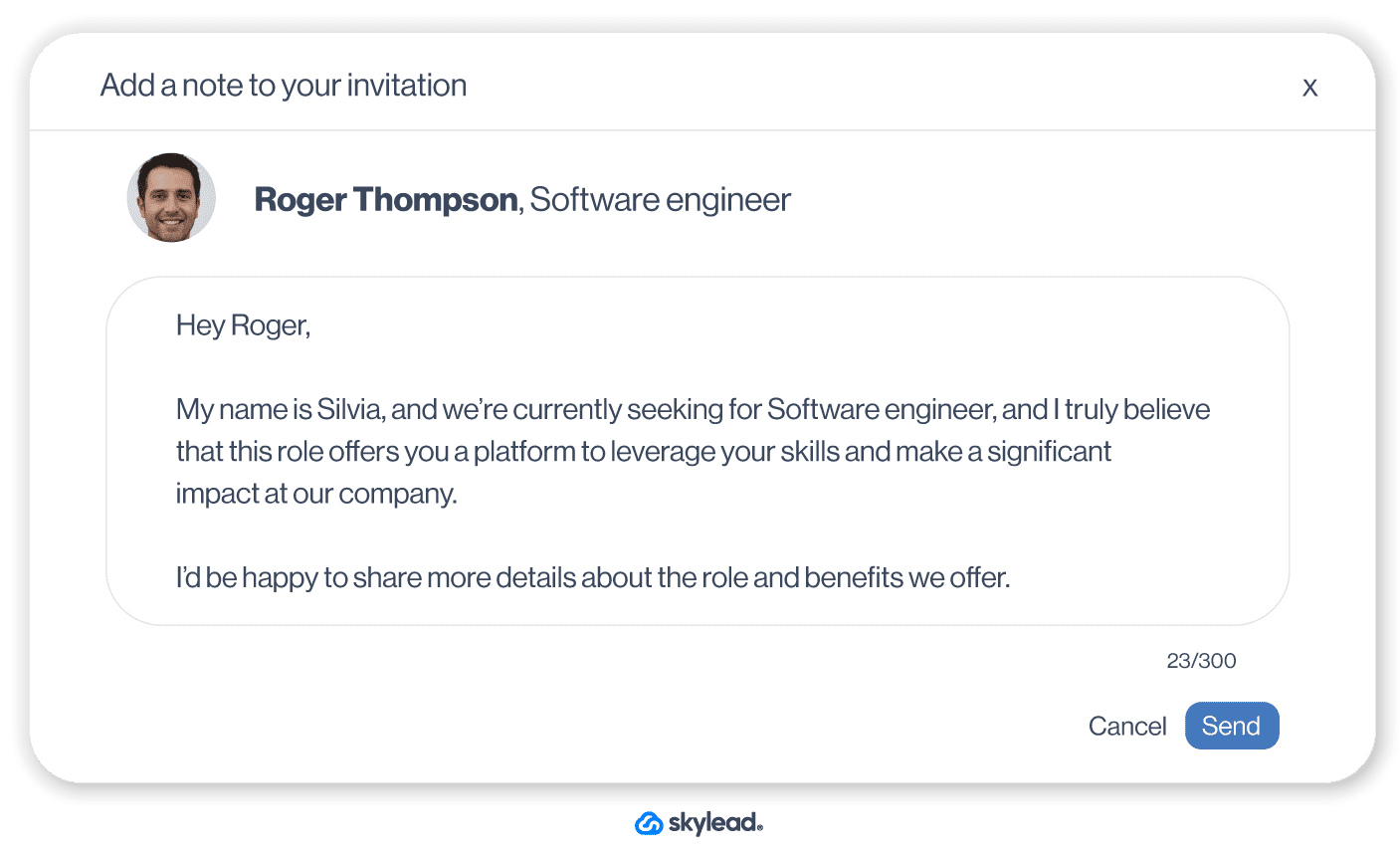
If, however, your ideal candidate doesn’t reply, use InMail format to land straight in their inbox.
Template
Acceptance rate 79%
Reply rate 46%
Subject line: Exciting job opportunity at {{yourCompanyName}}
InMail message:
Hey {{firstName}},
I understand that you may not be actively seeking new opportunities at this time. Still, I truly believe that this role provides you with a platform to leverage your {{Occupation}} skills and make a significant impact at {{yourCompanyName}}.
{{yourCompanyName}} is a {{shortDescription}}, where we take care of our employees and offer the very best, including:
1# {{Benefit 1}}
2# {{Benefit 2}}
3#{{Benefit 3}}
If this opportunity piques your interest, I would be happy to share more details about the role over the call. So let me know, and we can schedule an initial meeting at your earliest convenience.
I hope to hear from you soon.
Warm regards, {{yourName}}
InMail example
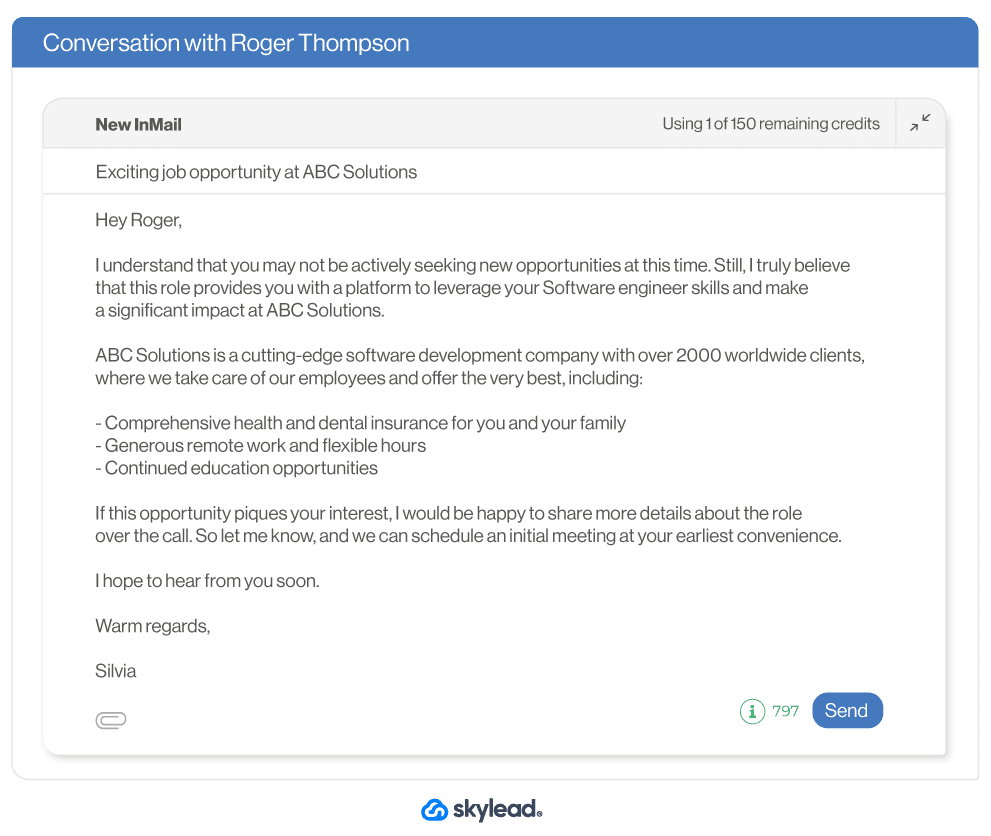
LinkedIn outreach message template for job search
We’ve all been there at one point - reaching out to companies and trying to get ahold of recruiters. Thankfully, you don’t need to search for their email addresses, as LinkedIn allows you to contact a recruiter from your ideal company directly. However, if you really wish to catch their attention, use this connection message template.
Acceptance rate: 67%
Reply rate: 32%
Template
Hello {{firstName}},
I have been following {{companyName}} and I’m impressed by your values, and dedication to innovation. As a skilled {{Occupation}} and enthusiast for {{companyIndustry}} I believe your company could benefit from my background. Let’s meet each other and talk about it.
LinkedIn connection request example
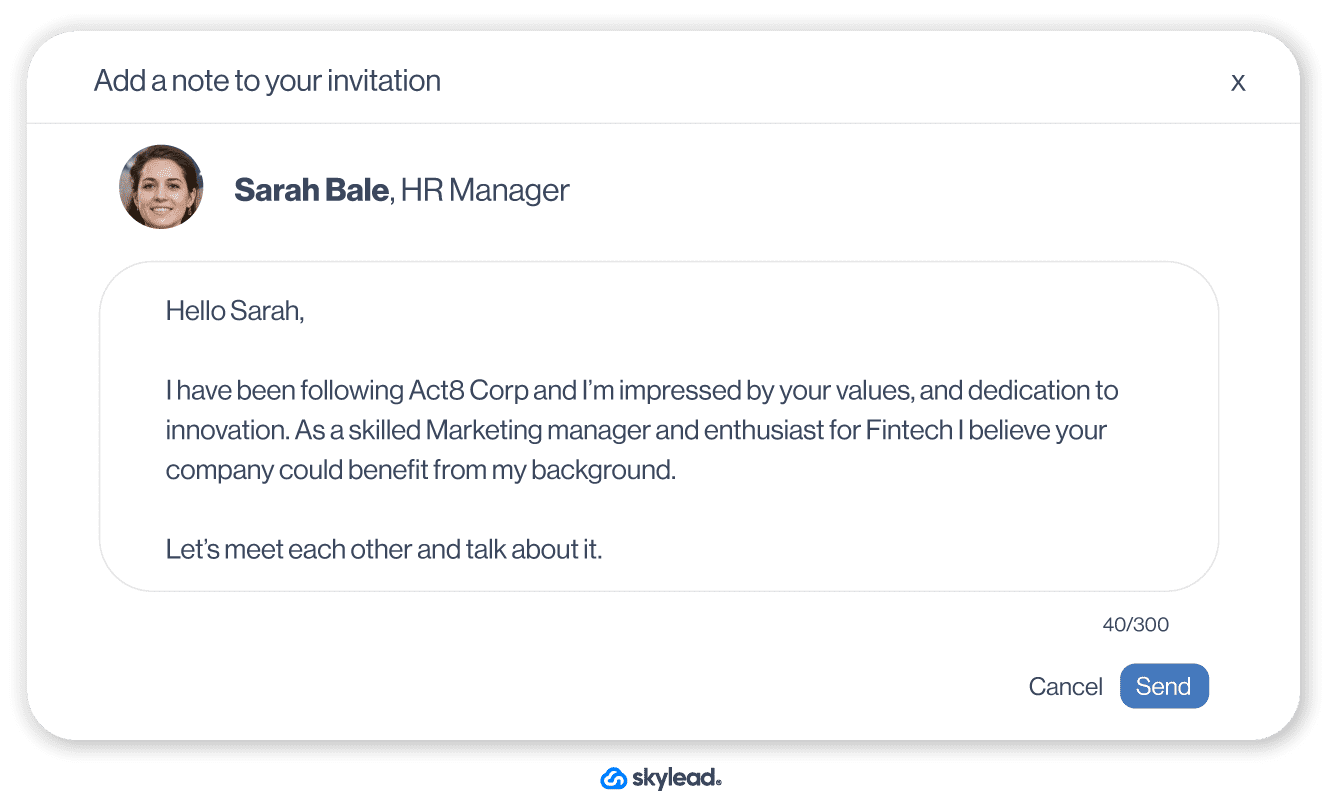
Moreover, if you have a LinkedIn Premium account, even better. You could send them an InMail that looks like this:
Template
Subject line: Proactive and passionate {{Occupation}} ready to make a difference at {{companyName}}
InMail message:
Hey {{firstName}},
My name is {{yourName}}, and I am a skilled {{Occupation}} with extensive experience in {{companyIndustry}}. I have been following {{companyName}} for some time now, and I am incredibly impressed by your {{Achievement}}, values, and dedication to innovation.
As someone really passionate about {{companyIndustry}}, I believe my background and skill set make me an ideal candidate to contribute to your team’s ongoing success.
I have achieved {{specificAccomplishmentOrResult}}, which has led me to {{quantifiable outcome}}. In addition, my expertise in {{specificSkill}} has allowed me to make a significant impact on my team’s performance and overall business growth.
I am excited about the prospect of bringing my skills and enthusiasm to {{companyName}}. I have attached my resume for your review and would be grateful for the opportunity to speak with you about how I could contribute to your team.
If there are any open positions or upcoming opportunities that align with my background, I would appreciate your consideration.
Thank you for taking the time to read my message, and I look forward to hearing from you.
Best, {{yourName}}
InMail example
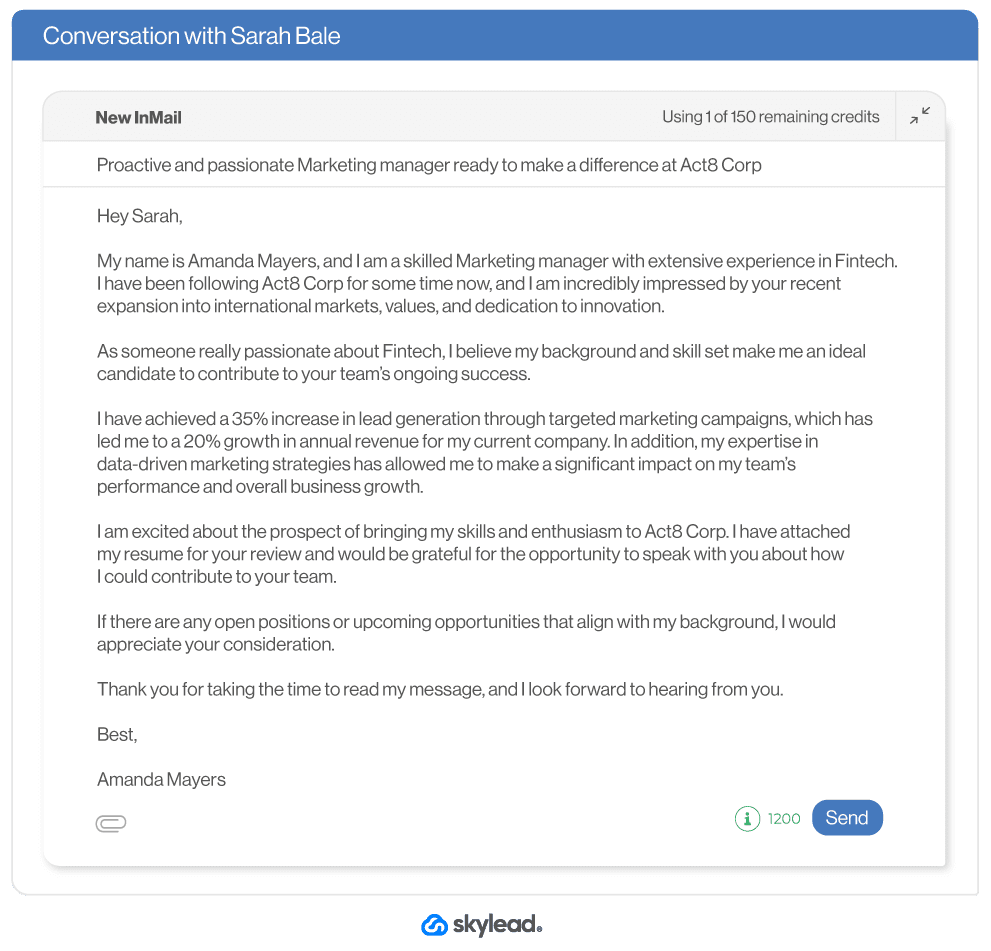
LinkedIn outreach stats
1. Users who have 70+ SSI have 45% more opportunities and are 51% more likely to hit sales targets. Moreover, it will grant you 20% more reach. (Tribal impact)
2. LinkedIn is 277% more effective for lead generation, far more than platforms like Facebook and Twitter. (HubSpot)
3. 92% of potential clients are willing to engage with an industry thought leader, making the thought leadership LinkedIn lead generation strategy very effective (CH Consulting Group).
4. Marketing managers experience up to 2 times higher conversion rates on LinkedIn. (LinkedIn)
5. Sending a personalized InMail will increase your response rate by up to 30%. (LinkedIn)
6. Lead conversion rates on LinkedIn are 3x higher than other ad platforms. (LinkedIn)
7. Audiences exposed to brand and acquisition messages on LinkedIn are 6x more likely to convert. (LinkedIn)
Frequently asked questions about Linkedin outreach
Those were some fascinating stats, ha? 🙂 Before we conclude this blog, let’s answer some frequently asked questions about the topics we didn’t get the chance to mention above.
Is prospecting on LinkedIn worth it?
Yes. LinkedIn prospecting helps you find your ICP and Buyer Persona with filtering options such as company size or industry. Moreover, the lead’s LinkedIn profile usually contains publicly available contact information, such as phone numbers or email addresses, that you can use to contact your leads outside LinkedIn.
What is the success rate of LinkedIn outreach?
LinkedIn outreach success rate depends on your goal and personalization level, but it’s usually high overall. For example, one of our sales team’s campaigns has the following result: out of 2782 connections sent, they experienced a 33% acceptance rate and 17% response. In some cases, the results go even higher.
What is a respectable number of LinkedIn connections?
You can have up to 30,000 connections, but the respected number depends on what you want to achieve. For example, for salespeople and recruiters, it’s essential to connect with as many people as possible to expand their network, thus reaching people outside of it and getting more leads.
Is it better to have followers or connections on LinkedIn?
Followers and connections are equally important, so it depends on your goals. For example, if you are a LinkedIn marketer and wish to focus on sharing content, gaining followers might be better for you. However, salespeople benefit better from the connections, as building relationships is the basis for successful selling.
Ready for LinkedIn outreach?
That’s a wrap-up for LinkedIn lead generation! This has been a wild ride.
Naturally, you can’t memorize everything from this article. Therefore, make sure to bookmark it, so you can return to it and remind yourself about best practices for LinkedIn lead generation.
And if you’re looking for a way to expand your outreach to email, try Skylead for 7 days for free, and experience firsthand how fast you can scale your business!

When talking to prospects, sales reps know that the art of selling revolves around many skills. However, the most important one, hands down, is objection handling.
Prospects might give you many reasons why they don’t need your product/service, from “it’s too expensive,” “I don’t have time,” to “I’m happy with your competitor.” Ouch! We know–it might hurt, but your job is to overcome these obstacles.
But how to turn a “no” into a “yes”? To teach you how to do it, we are drawing from years of our own sales engagement experience to show you:
- Types of objection handling
- A 7-step guide to master handling in sales
- Top 17 objection-handling situations with winning rebuttal examples
What is objection handling in sales?
Objection handling is the process of addressing concerns or doubts raised by a prospect. It uses empathetic listening and other communication techniques to provide solutions or reassurance, with the goal of maintaining a positive relationship and moving closer to a more successful outcome or sale.
Objections may come up for various reasons:
- Poor LinkedIn prospecting
- Failing to find your Ideal customer profile or Buyer Persona from LinkedIn lead generation.
Of course, it could be none of the above. You could have done everything right, yet objections may pop up to create very common outreach obstacles like:
- Inadequate price
- Lack of authority
- Competitors
Why is objection handling important?
Imagine a world where no objection is handled - there would be no deals or revenue at the first mention of a problem or concern. It’s important for salespeople to address these objections properly so the prospect will move through the sales pipeline and convert. But why do objections show up in the first place?
An objection usually appears because there is not enough trust. It’s important to build trust by addressing your prospects’ issues on time, which helps nurture your relationship with them. This can ultimately lead to multiple sales in the future.
Our best advice is not to avoid objections but to use them as a tool to build a stronger relationship with your prospect. You can regularly check up on your prospects' sales journey and find out if there’s any doubt to address by asking questions such as:
- Do you have any concerns about X?
- Is there anything you are worried about regarding X and why?
- Is there any obstacle that would be a deal-breaker and would stop you from using [product/service]?
Types of sales objections
Before we get into the how let’s go over the three common types of objections sales reps encounter on a daily basis in outreach. 👇
Solution-oriented sales objection
When the prospect has a problem, and your product/service can solve the problem, but they’re unsure whether to go for it or not, that is called a solution sales objection type. Andrea, our Head of Sales, says that this is the most common type of objection, and in this case, your job is to persuade the prospect that your product/service is the perfect solution for them.
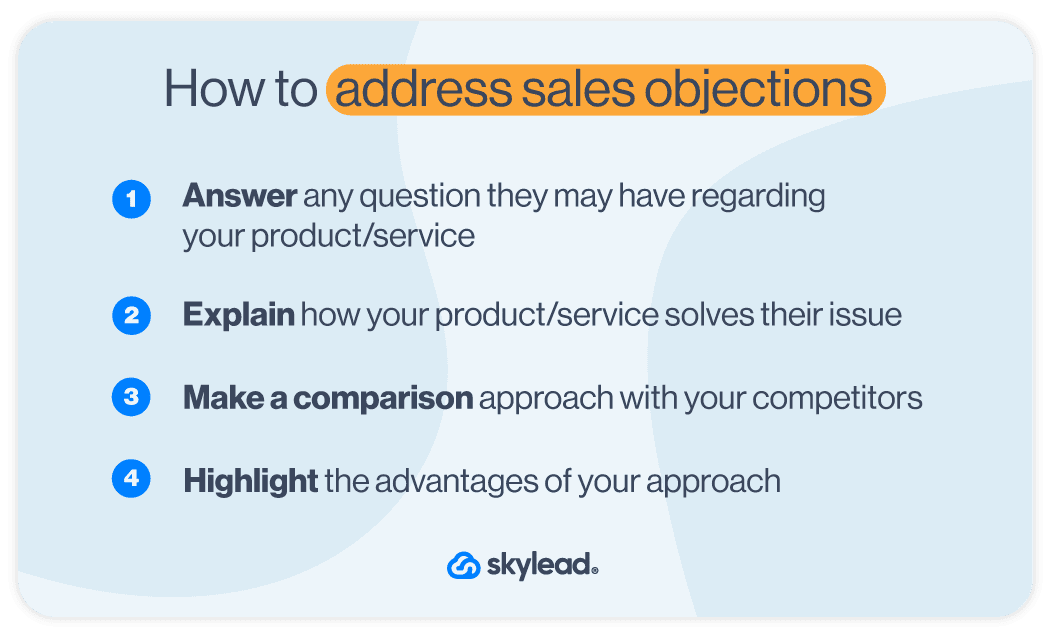
No-problem sales objection
Next, we have the so-called “no-problem” sales objection type. In this situation, the prospect doesn’t perceive the problem as a big deal–in fact, it doesn’t concern him as much. This is a situation where you have to create a sense of urgency and subtly present your product/service as the only solution.
How did this happen? Well, our Account executive, Pavle, says that this objective type might pop up when you show the prospect all features and benefits immediately or without actively listening to what they see as a more important issue.
Problem-oriented sales objection
The hardest one to overcome is the problem-oriented sales objection—the case where the prospect has legitimate issues and doesn’t see how your product/service solves them.
If this is the case, we advise you to first determine if your product can actually help. If it doesn’t, it’s better to be honest with the prospect. This way, you’re actually building a positive relationship that might turn into a good recommendation or a potential future collaboration. However, if it does help, make sure to offer your product and depict it as the logical solution to their pain point.
7 steps to overcome sales objections
Now, let’s look at the tested and trialed steps our sales team always uses when addressing doubts and objections with prospects. 👇
1. Actively listen to prospects
Our Andrea says that to be a successful salesperson, you must learn how to listen rather than reply. Active listening can be described as the most important skill a salesperson should have.
Most of the sales processes nowadays happen remotely and online, so salespeople don’t have the luxury of reading into body language or even tone of voice. The only thing they have is their digital written replies, which is why listening carefully can improve your relationship with the prospect and ultimately lead to a conversion.
2. Repeat what you hear
Since there’s usually no physical interaction between you and your prospect, it’s important that you phrase your questions and answers in a way that replaces a specific reassuring tone of voice and microexpressions on your face. So, when a prospect voices an objection, make sure to repeat it back to them for two reasons:
- To make sure you understand their issue correctly which can help you change their mind later.
- To make them feel valued and heard by you, which builds trust further.
3. Validate concerns
This step comes after you’re sure you understand your prospect’s worries. From this point, you can continue building trust with them by empathizing and showing them you understand their viewpoint. By validating their concerns, you can lead them to the part where you unobtrusively introduce your product/service as a proper solution.
This is how validating concerns looks like in real life:
I understand that implementing a new tool can lead to a rocky adaptation period. Luckily, our all-star support team is here to help ease the transition and get you to operate as before but better.
4. Ask open-ended follow-up questions
When an objection comes in front of your potential sale, your main job is to keep the conversation going. To keep them engaged, be sure to ask follow-up questions. However, you should avoid questions that can be answered with “no” or “yes”.
Instead, focus on open-ended questions that allow your lead to keep communicating their thoughts and worries so you can address them as soon as possible. The more information they give you, the more material you will have to turn the objection around into a sale.
Can you walk me through some of the challenges you're currently facing in managing your {{process/Task}} and how you see the perfect solution to improving your situation?
5. Use social proof
When in doubt, use social proof to change your prospect’s mind. The best way to persuade them is to showcase a customer story, case study, or data addressing their pain points.
Here’s an example of a case where your social proof addresses their objection or pain point:

6. Give them time to think before your next follow-up
In objection handling, there will be situations where your prospect will ask you to give them some time and space to think about their options or to restart the conversation in the future. Your job here is to give them enough time and space but not too much. If you leave them for too long, they might lose track of you and your product/service, and this is why a follow-up that restarts the conversation is an absolute must!
So, be sure to set a time that isn’t too far in the future, and make sure to let your prospect know that you will answer any questions and discuss any news regarding your product/service.
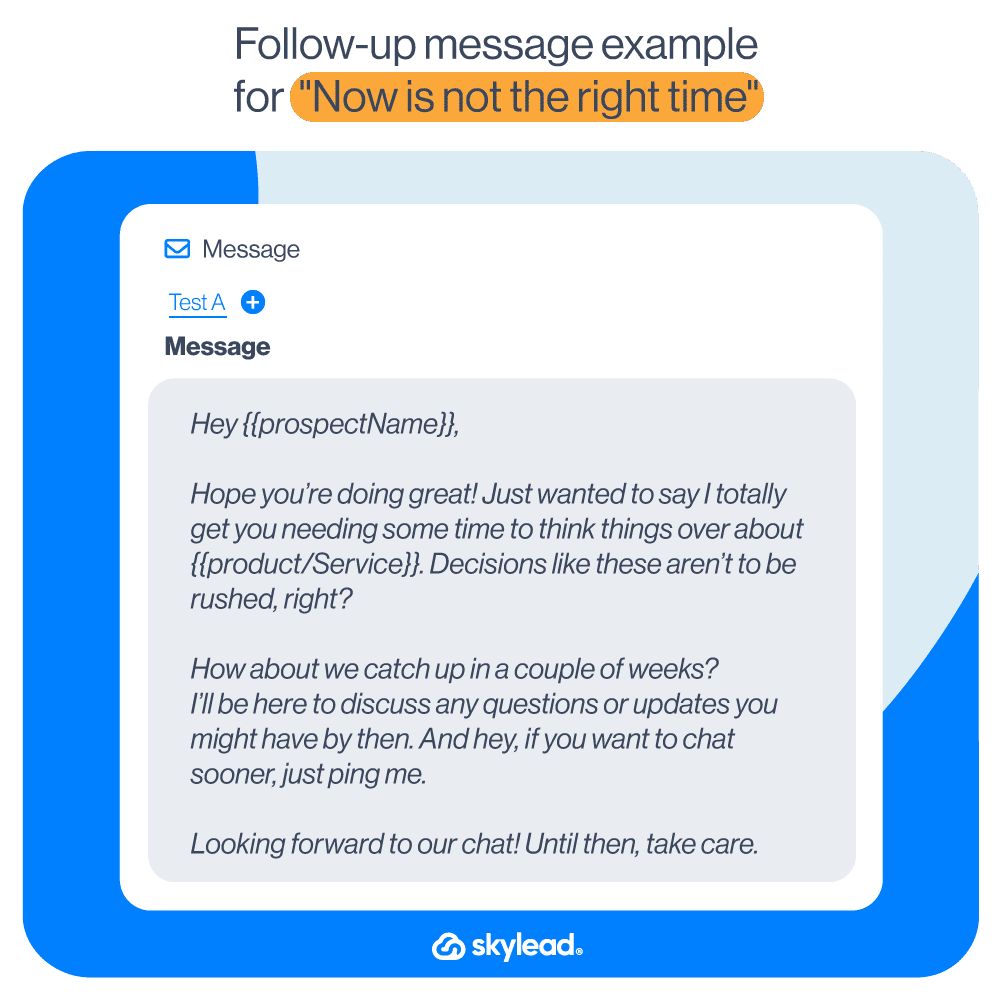
7. Address objections before the prospect does
Ultimately, a good salesperson is the one who can predict and cover potential objections and worries before the prospect mentions them. If you’re working in a certain field and with prospects from a certain industry, you most likely are already familiar with the type of worries that might come up, so it’s good to sew in subtle objection-handling cues into your sales pitch.
Top 17 objection-handling situations with rebuttal examples
Now that we’ve covered why it’s important, the types of objections out there, and our 7-step guide on how to handle and overcome objections, it’s time to look at the 17 most common objections. Our superstar sales team came together to tell us all about the reasons they had to work around over the years. Let’s begin handling objections. ⬇️
#1 I already have a solution
This one is the most common objection, and it usually involves your direct or indirect competitor. The way to work around this is to find your prospect’s pain point that their current solutions don't solve. Depending on how the prospect ends the sentence, your response may vary, so let’s see all the potential scenarios.
Rebuttal examples
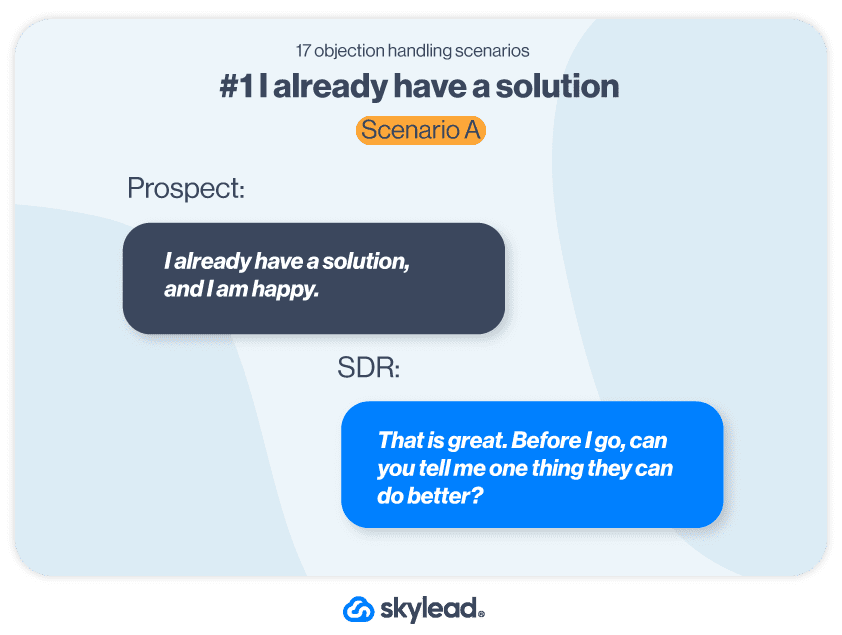
Tease out why they think the solution is good for them, and gather the pain points based on which you can book a meeting. If their feature is really better, leverage the one your product has and think it’s better for the prospect’s business.
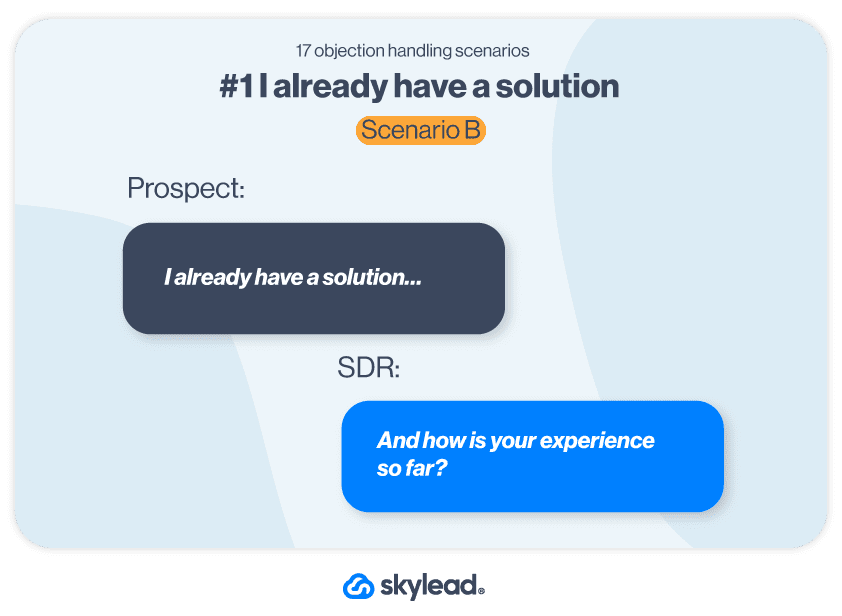
Tease pain points to continue the conversion. Pausing may imply that they are not satisfied with something. Then it’s your job to figure out which part the competitor isn’t covering so you can sweep in and solve the problem.
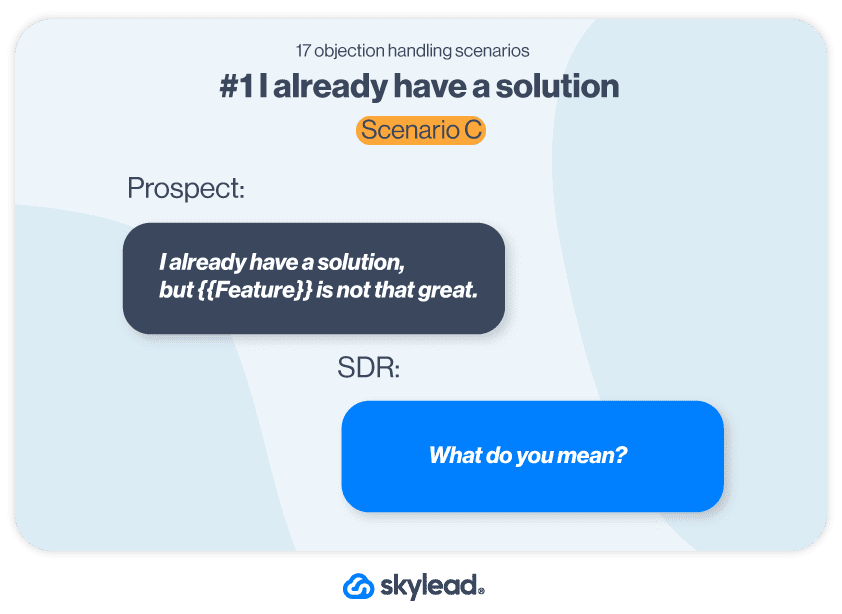
Needless to say this is the best answer you can get, as the prospect immediately pointed out the pain point. Ask more questions, empathize with them, and then underline the value of your product/service to move the conversion process forward.
#2 I am not the right person
From Becc Holland’s experience, the CEO and founder at Flip the Script, sometimes, in cold outreach, you will talk to people who are not the decision-makers. From our experience, if you build a good initial relationship with them, they could point you to, or even connect you with the decision-maker, so don’t dismiss them right away!
Rebuttal examples
Make sure to listen or read carefully if they are indeed the right person or not.
If they are but say they aren’t just to chase you away, structure your objection handling response like this:
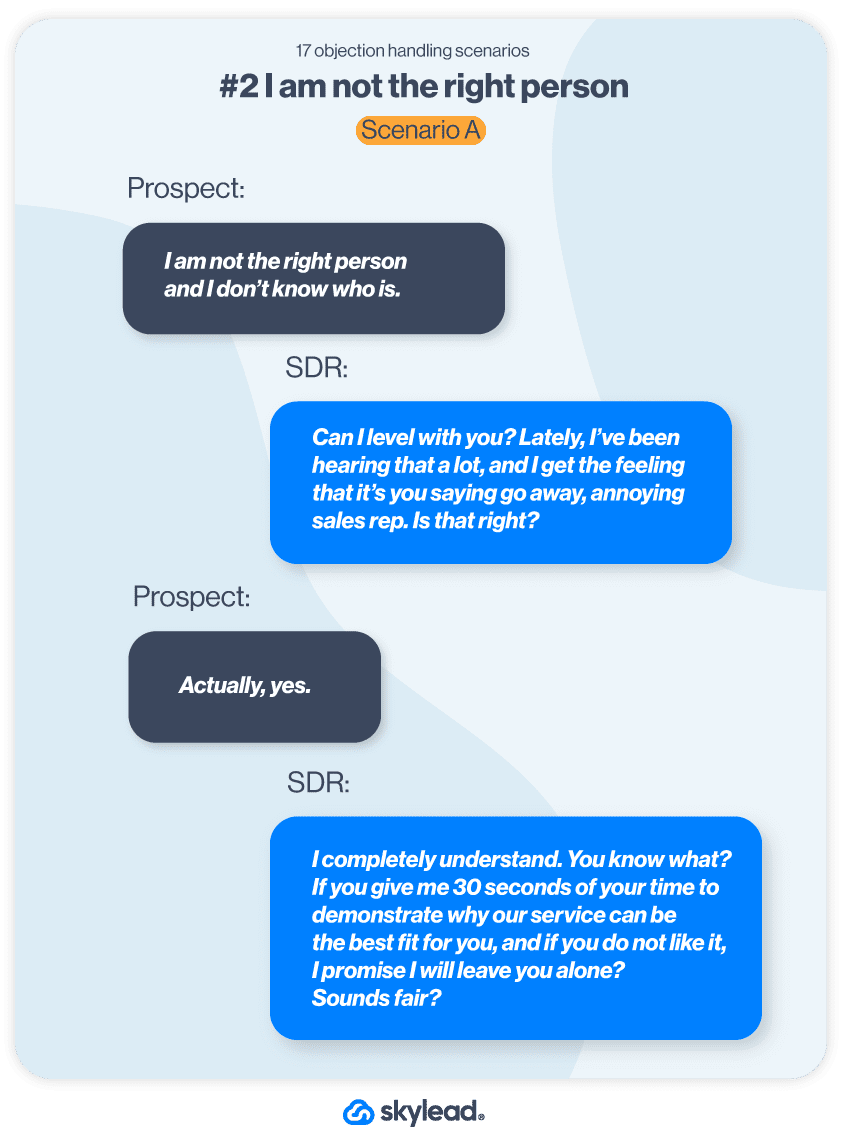
After you ask for consent to pitch and they give it to you, pitch a unique selling point and value proposition to try to close the deal or schedule a demo call.
In case they're not the right person, structure your response like this:
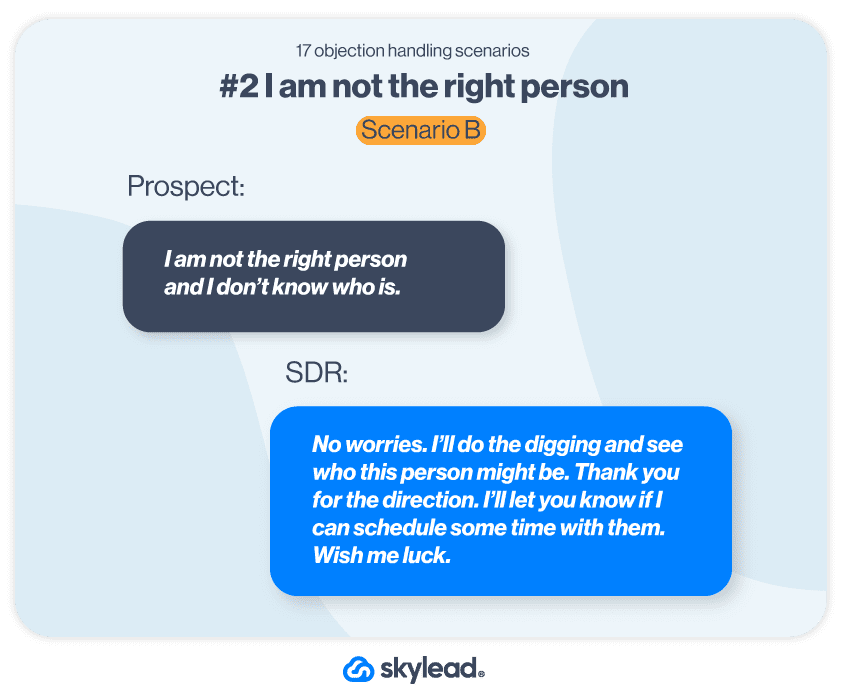
If you find the decision maker, you can always reference the person you spoke with first. If you don't succeed, you can reach back to the first person and ask for additional advice or to point you to the right person.
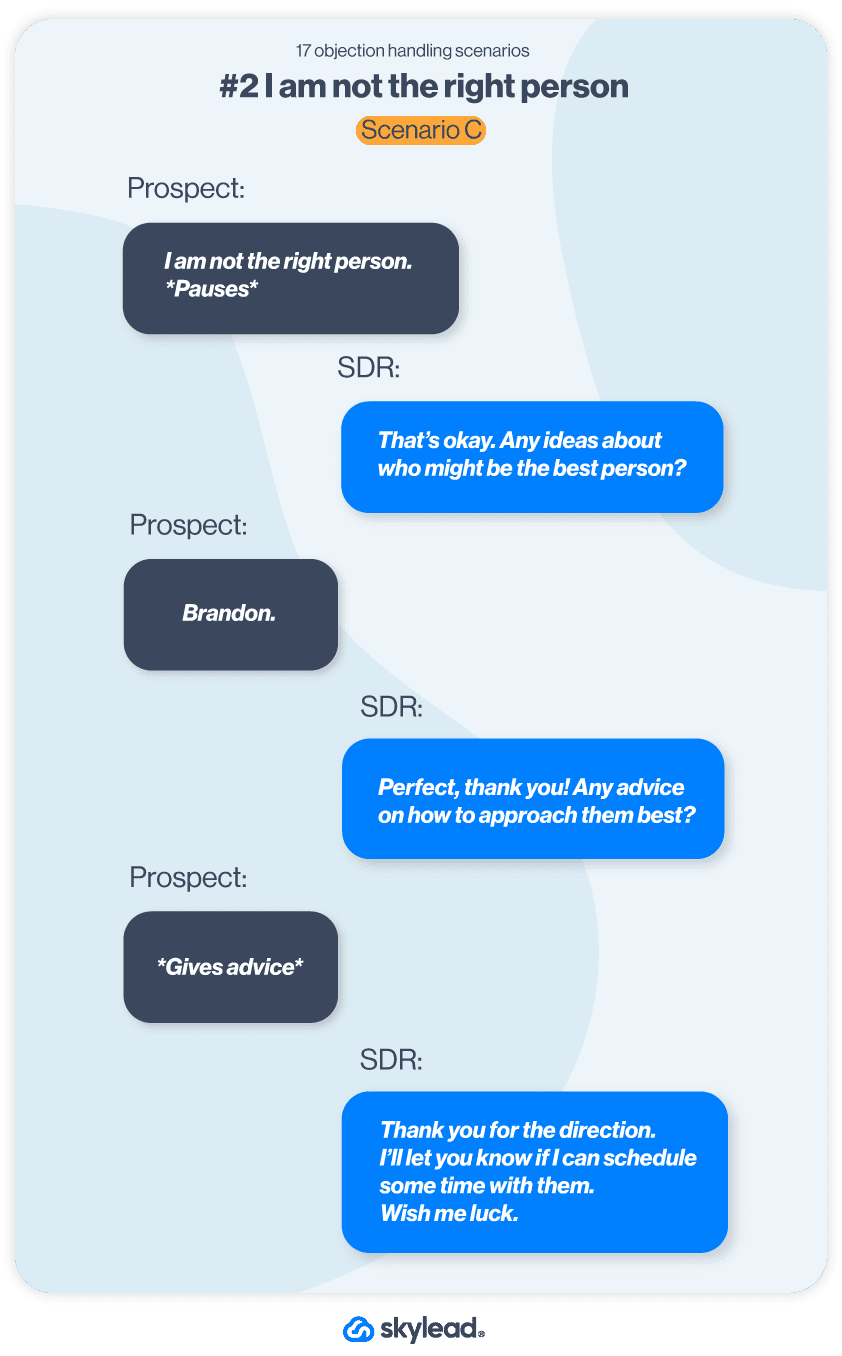
However, if you can’t reach the decision-maker, reach back to the first person and give them an update. Be honest, admit you might have made a mistake, and ask for advice again. The first person will probably want to make things right and reach the decision-maker themselves.
#3 I don’t have time
As an SDR, your job is to prove to your prospects that you are worth their time. For example, by using short sentences you’re showing you respect their time. You will also catch their attention by showcasing the experience of similar people, and then ask for a fragment of their time to pitch or aim to schedule a call for another time.
Rebuttal examples
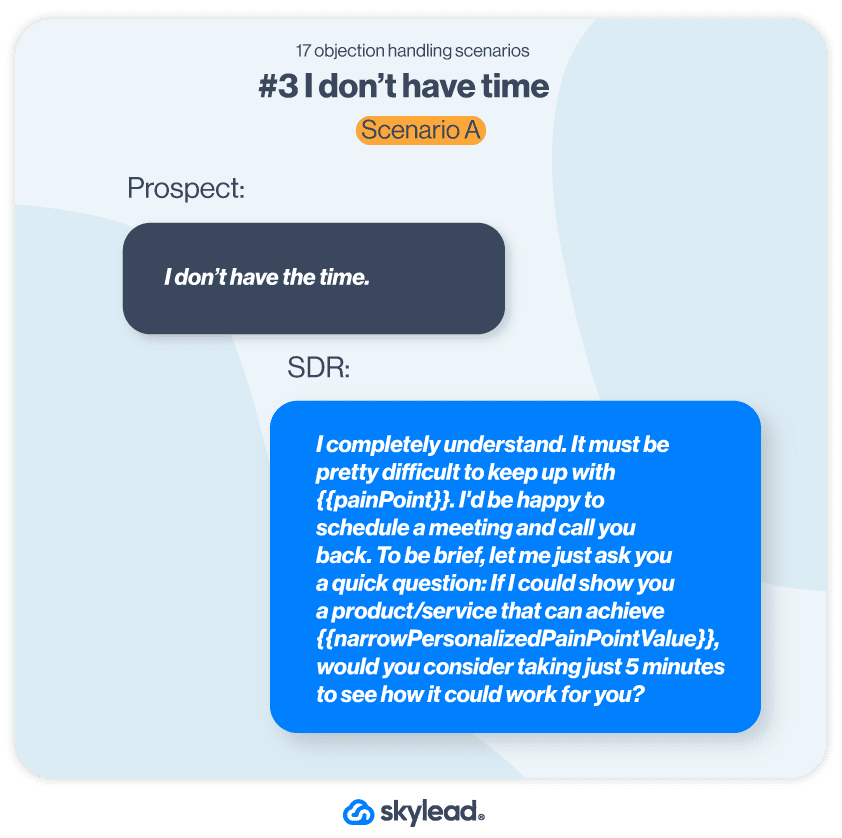
With this question, you are providing the value and solution right away and showing you are respecting their time. They may or may not have the time right now, but you teased enough to schedule a call another time and soon. Ask them again if they have that 5 minutes right now, or if they do not, when you should schedule a short call.
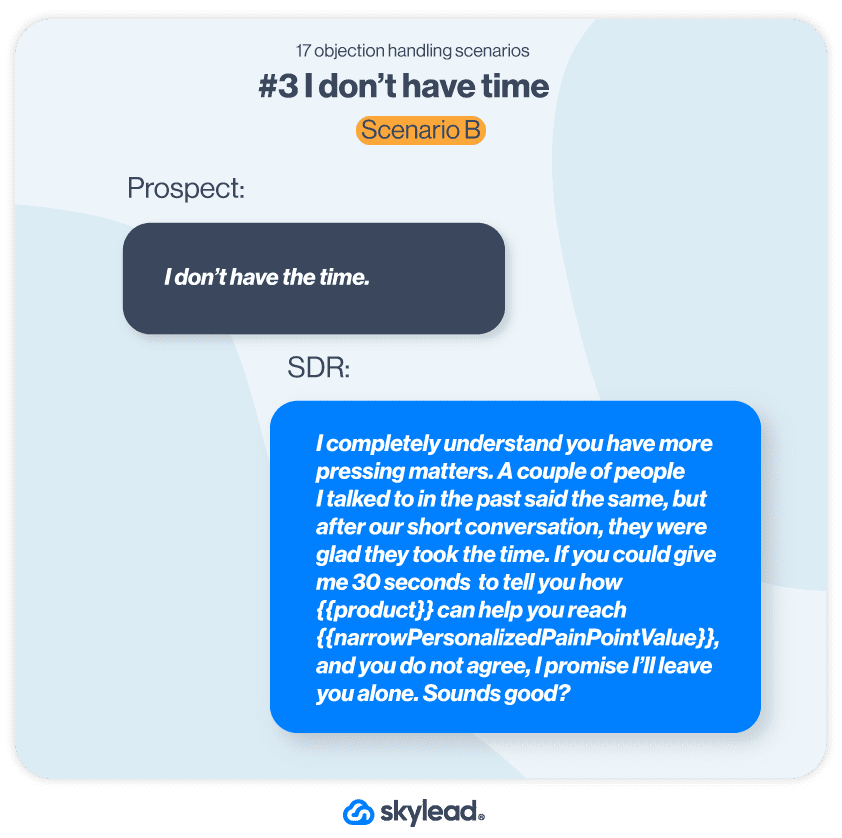
With this statement, you get the chance to pitch right away, so try to be as brief as possible, and finish by asking for another call.
#4 The budget is a little tight at the moment
Price objections are the type of sales objections you want to hear, as it shows the prospect thought of buying your product/service, but had to reconsider because of the price. These prospects usually need a little nudge value-wise and they’ll convert.
Rebuttal example
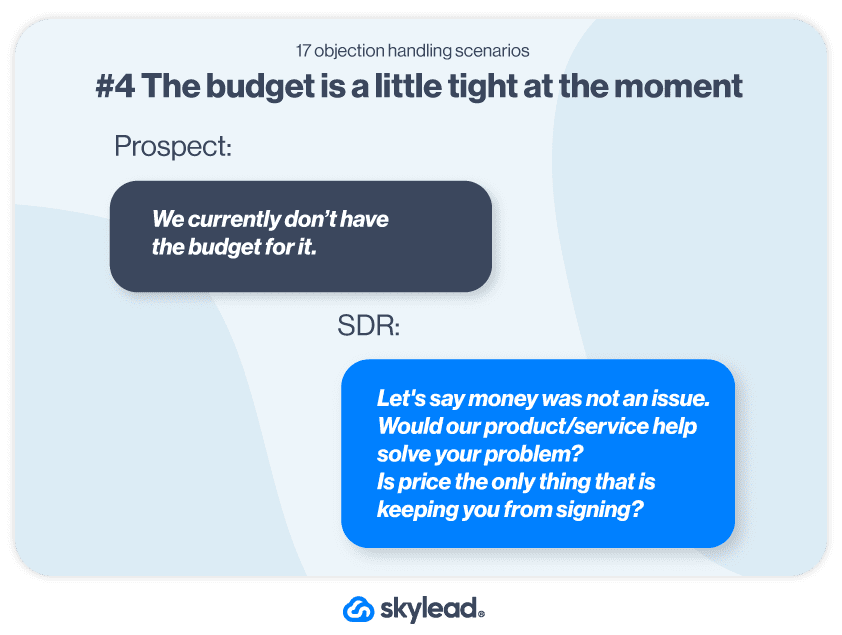
If the answer is yes, you have the opportunity to offer a discount code to push them towards the closing process. If not, ask more questions to find out the real reason, then leverage it to remove it with personalized value.
#5 You are more expensive than your competitors
Similar to the previous one, this objection has the money issue involved, but with an added spicy competitor comment. Try to stay calm as this is solvable 90% of the time. You overturn this by showing how they can win with your product as opposed to losing with the cheaper alternative.
Rebuttal example
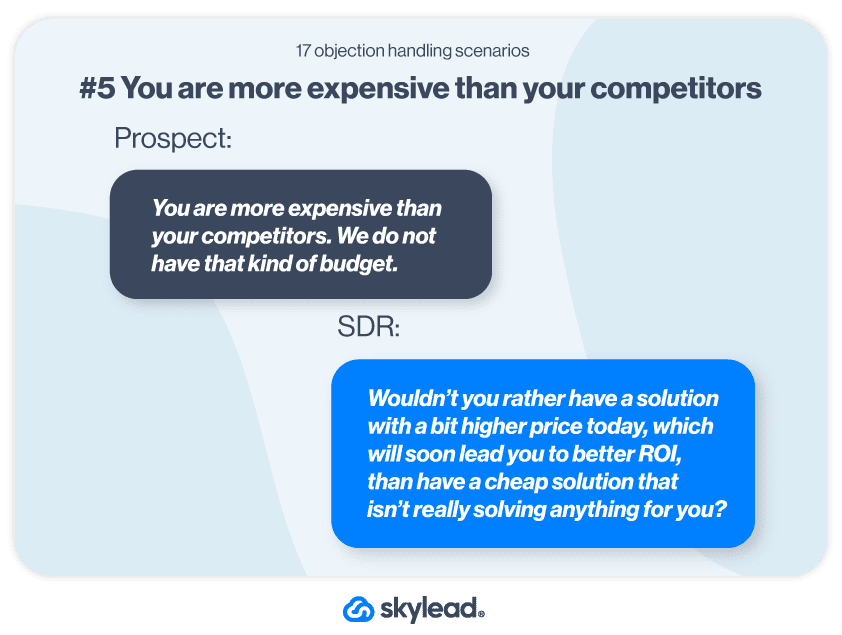
The moment you start justifying the price, you’re bargaining with the prospect. Rather than addressing the price issue alone, our Andrea says that you should link the price to the higher value that your product offers. If they still don’t understand, then they probably do not match your Ideal Customer Profile.
#6 I need to check with the boss, or my boss doesn’t like this product, but I do
Sometimes, the person you are pitching to will not have the authority to make final decisions. However, you should not lose interest in pitching to this person, as they might be the ones who will use the product in the end. If you make a good impression, they might pitch it to their boss, and the conversation and the conversion will continue.

Rebuttal examples
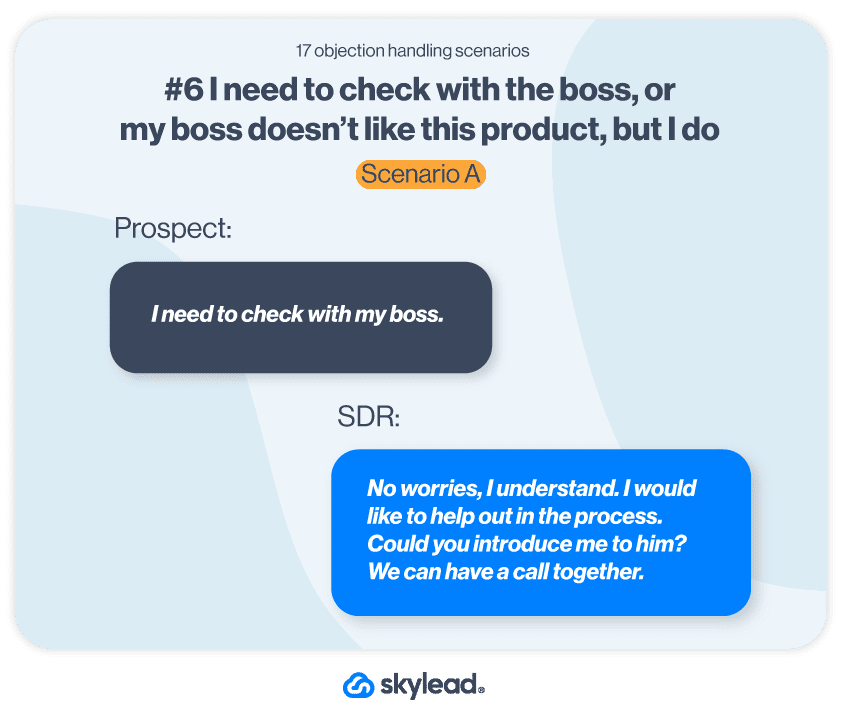
Andrea says that you shouldn’t never allow anyone else to deliver your sales pitch to the decision-maker. Instead, aim to schedule a call with them to provide value. Be careful not to make the person not in charge feel inferior, though. So, instead offer them help and support in the pitching process. If they don’t want to schedule the call, offer to send the necessary info.
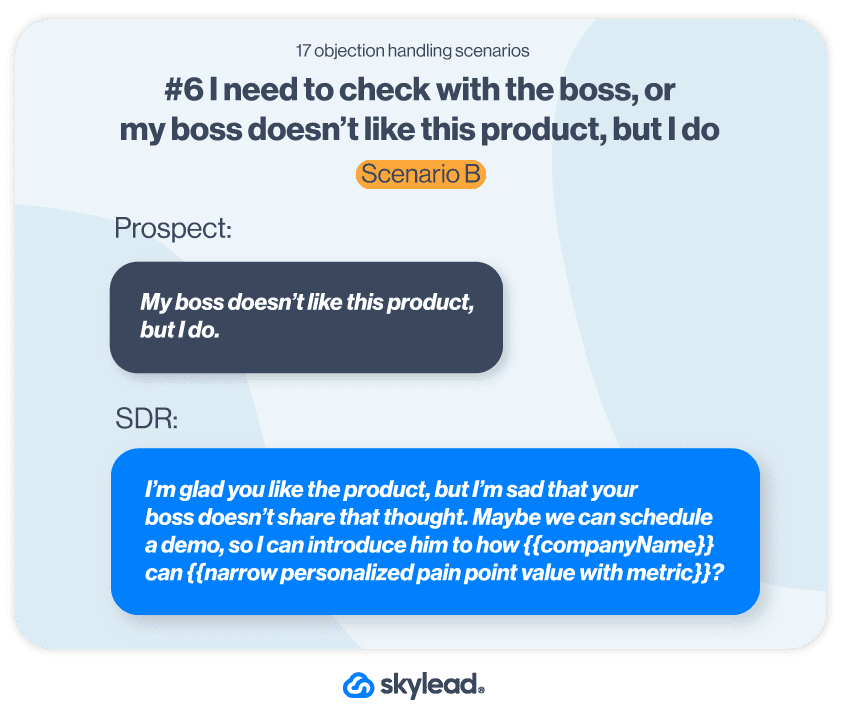
Give them the exact metric of the value your product offers so that the person can use that as leverage to schedule a call with their boss.
#7 Reach out to me next month/year
Sometimes the prospects will be busy with their heavy workloads. In this situation, you should approach by explaining that you understand. Also, highlight the fact that your product/service can actually help them and improve their work experience.
Rebuttal example
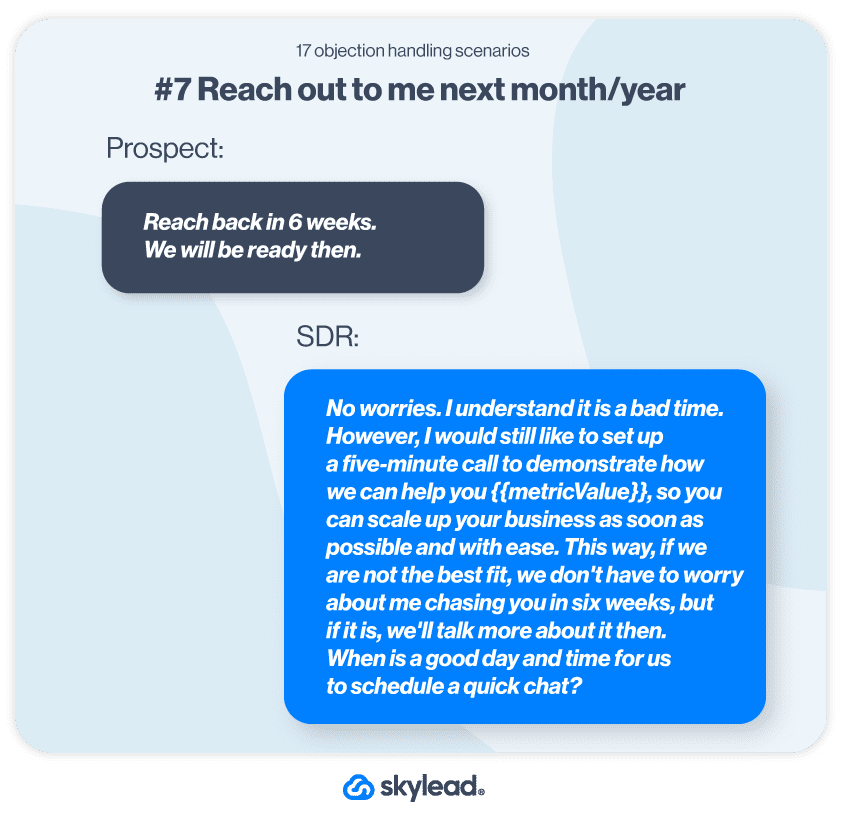
Reassure them that this is not a buying conversation. You just want to show them how valuable your product is and what it can do for them right away.
#8 Send info over the email
This is a common objection when cold calling or after a demo. In most cases, this means that the prospect has already made up their mind. By asking you to send more information, they hope to cut the conversation short. Don’t let that get to you. 👇
Rebuttal example
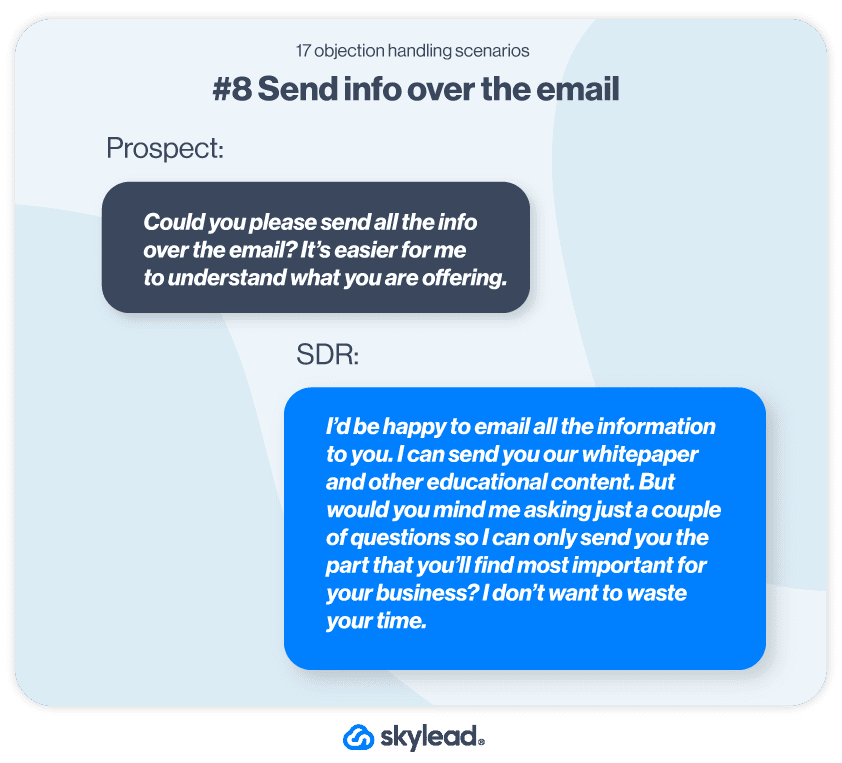
Agree to send the information, but not before asking questions about their business to understand their pain point better.
#9 I’m not interested in your offer
Ouch! This objection is also a pretty common one, but again, you should not let it throw you off your game. You should ask yourself this: How are they not interested if they didn’t even hear your offer? The truth is that this objection usually means that they are busy. Turn it to your advantage by restructuring your introduction to focus on the expertise.
Rebuttal example
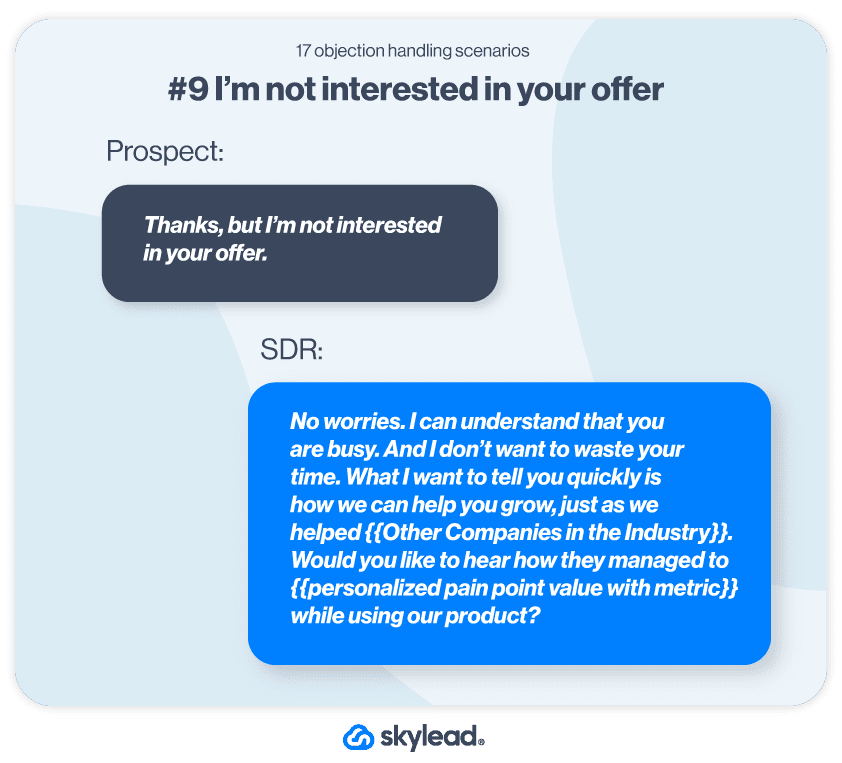
Try to keep the conversation going, just so you can demonstrate expertise using their pain point. This way, your prospect can see that you have relevant experience to back up your claims and that you know your worth. A true objection handling win! 💪
#10 Pitching back
This is an objection that became pretty common nowadays. It’s when B2B companies pitch you back, usually on demo calls. Translation? They are not interested in your product/service - they are just using the chance to show you their own. The audacity, right?
There is nothing wrong with presenting your solution, but if they only agree to the call to pitch you back, that’s just sneaky.
Rebuttal example
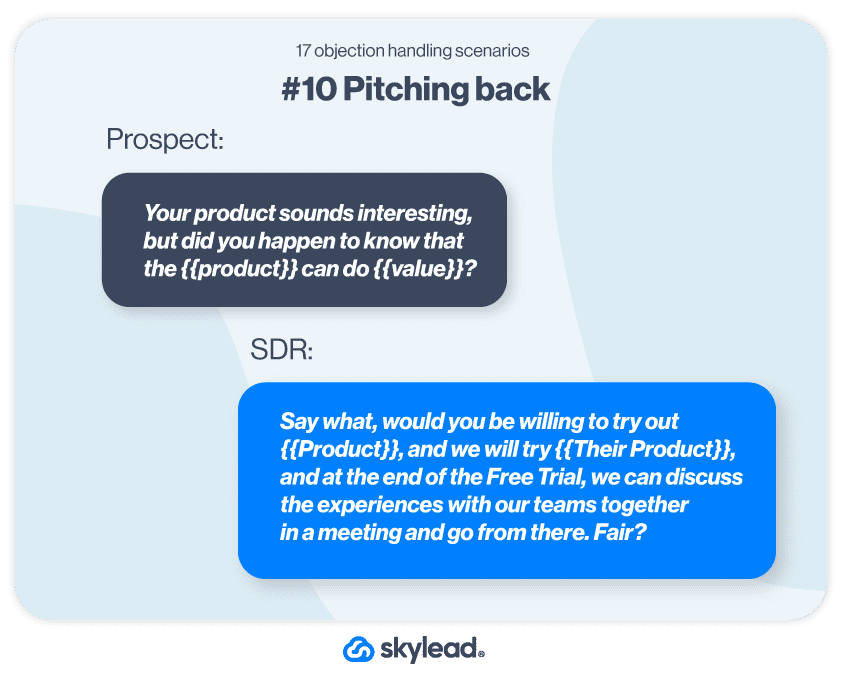
Proposing a collaboration will definitely catch them off guard, and there is a chance that their decision-maker will see the value you offer.
#11 Your product doesn't have {{feature}}, and we need it.
This objection could be a tricky one, but try to suggest an alternative solution used alongside yours. In case this need is a must for them and your product can’t solve it, then your prospect might not be the one for you. Before you write them off, try this 👇
Rebuttal example
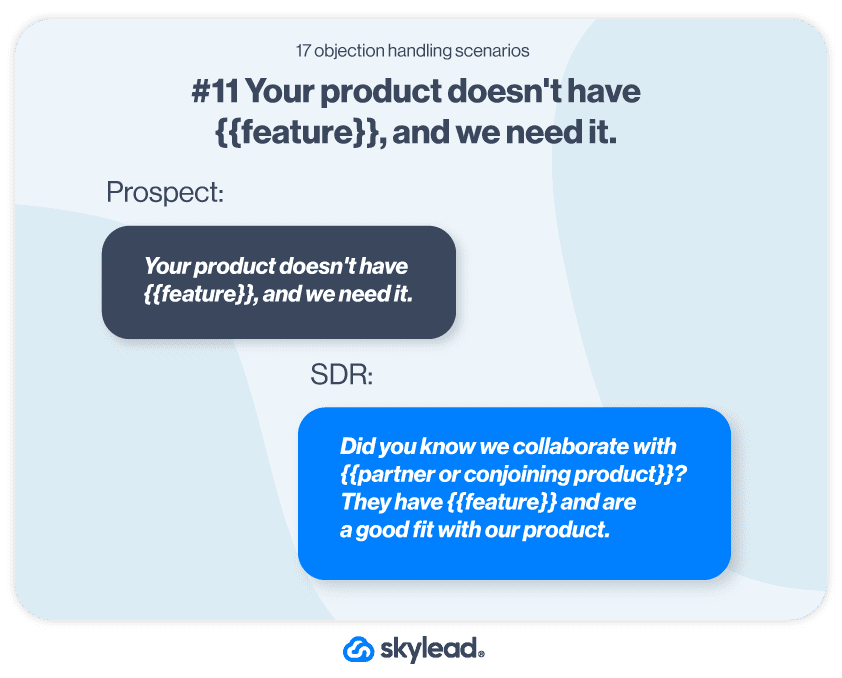
#12 We're happy with the way things are now.
Sometimes, this could be the case. But that doesn’t mean you should believe them right away. Ask more questions to get into potential problems they might be facing. If the answer is still no, move on. ⏭️
Rebuttal example
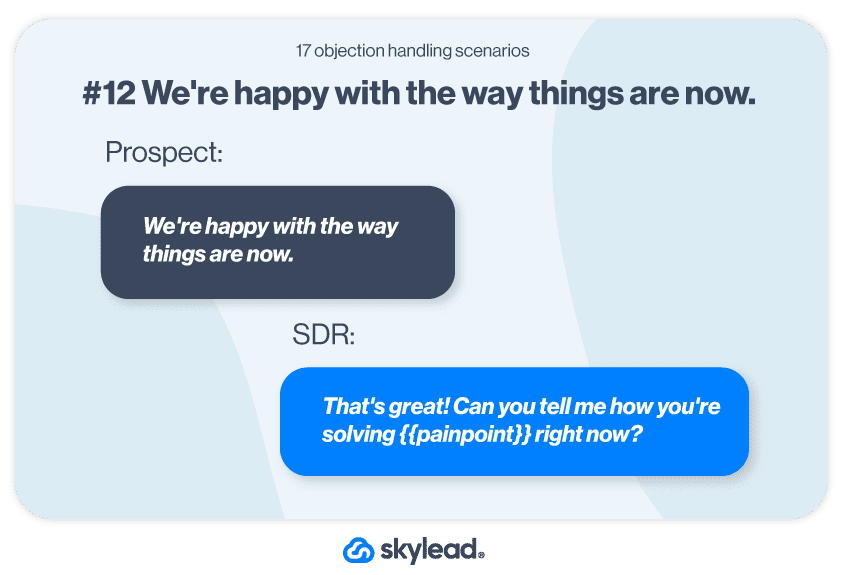
#13 Your product is too complicated.
In this case, make sure to ask questions and find out if a specific feature or the entire product is too complicated for them. In both cases, you should clarify any concern they might have and add that your customer support team will, by utilizing inbound call center software and other channels like chat, help them set everything up smoothly if they choose to buy.
Rebuttal example
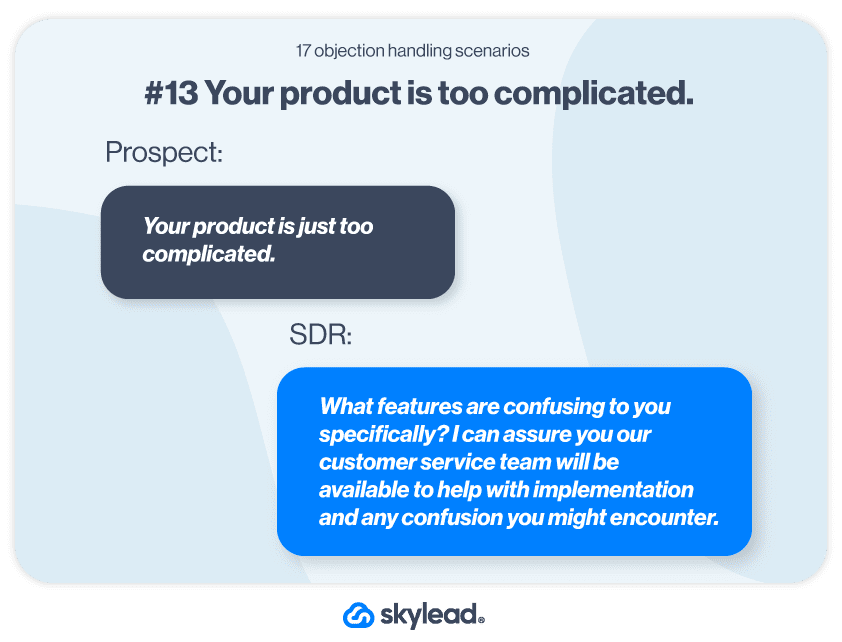
#14 I don't see what your product could do for me.
This objection usually means there’s some information that needs to be presented. So, your job here is to confirm their goals and pain points, and then explain how your product/service fixes these issues for them.
Rebuttal example
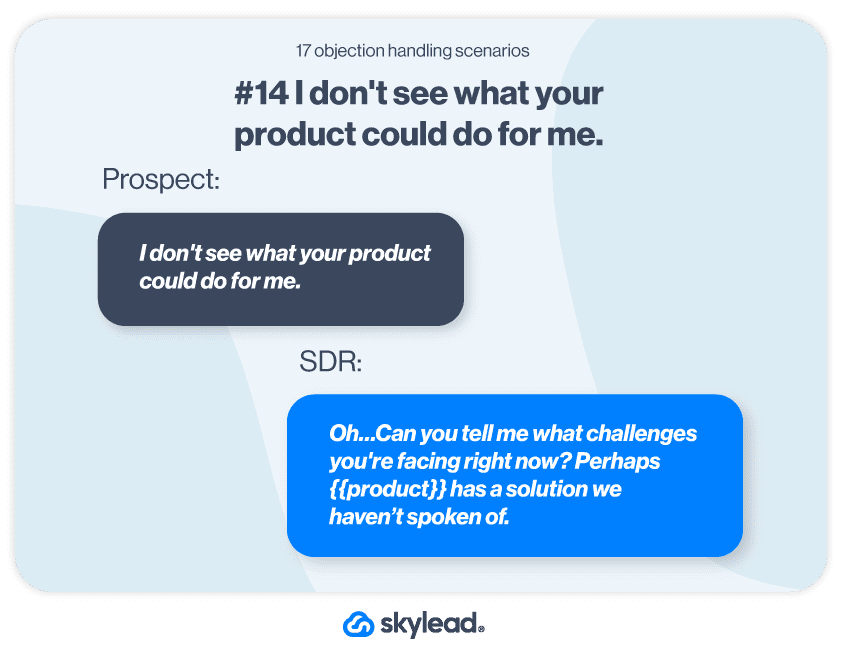
#15 {{Painpoint}} isn't important right now.
In this case, there might be two reasons the prospect is stating the objective. First, they might want to let you down easy, or you need to ask more questions to find out why this isn’t important right now, so you can explain why it’s a great time to rethink their priorities. Try to create a sense of urgency and work from there.
Rebuttal example
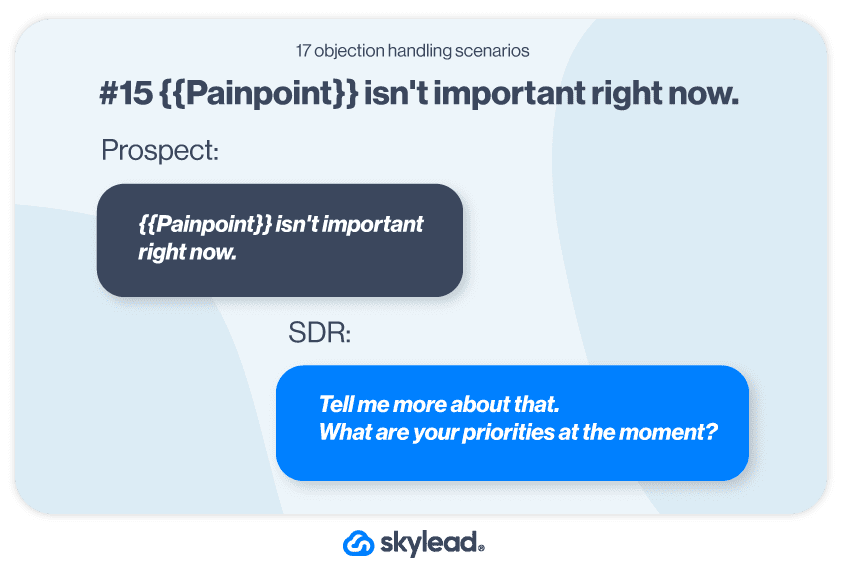
#16 I'm happy with {{competitor}}.
What do you do if the prospects say they’re happy? You don’t buy it! First you find out why they are content with the way your competition works for them. Second, try to identify potential weak points and subtly underline how your product solves them.
Rebuttal example
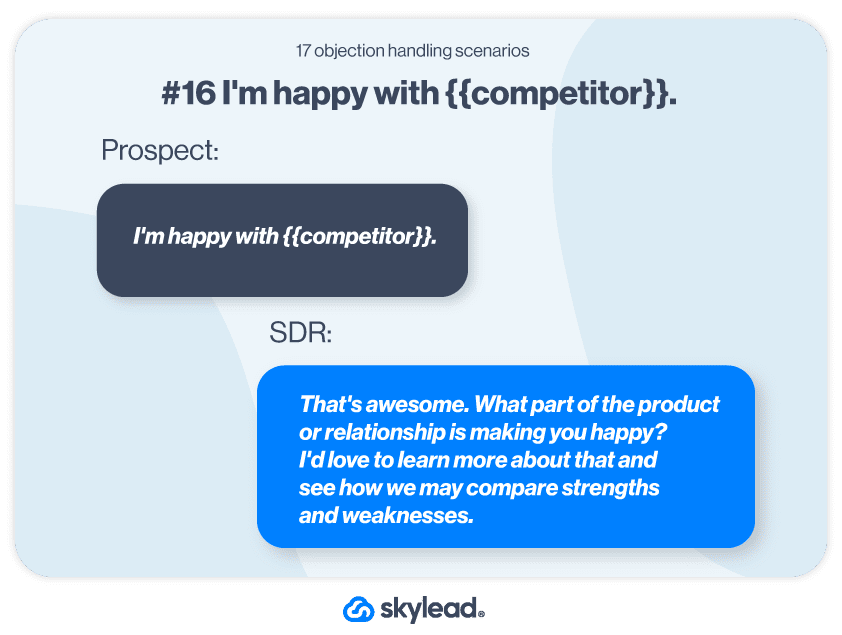
#17 We need to use that budget somewhere else.
If this objection shows up, your main goal should be to make them believe that the budget should be redirected, or rather, invested toward your product/service. This is where social proof comes in as your best friend, so don’t be afraid to throw around some numbers.
Rebuttal example
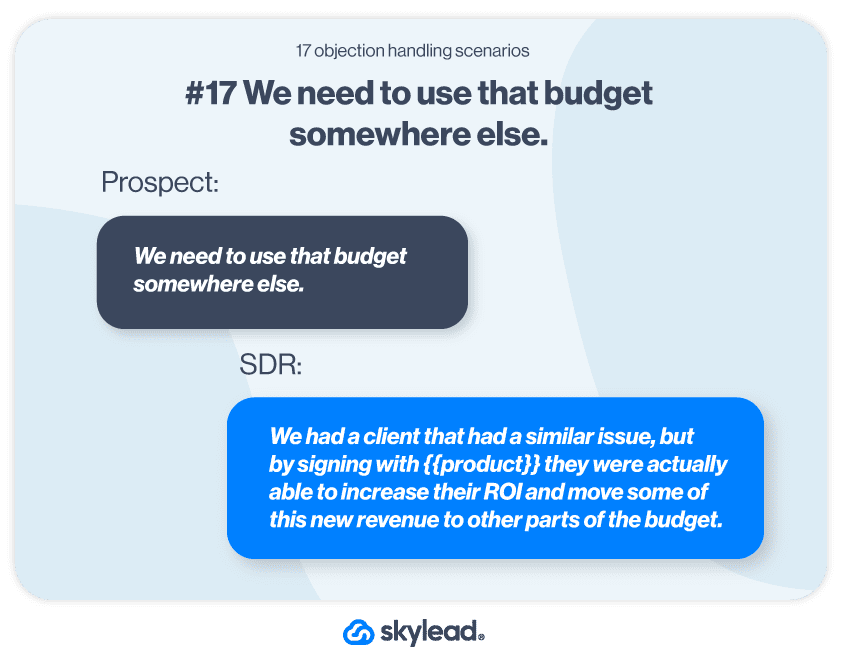
Frequently asked questions - FAQ
How do you tailor objection handling strategies for different industries or sectors?
Tailoring objection handling strategies to different industries or sectors requires an understanding of the unique challenges and needs of each market. For instance, objection handling in the tech industry often involves addressing concerns about integration and compatibility with existing systems, whereas in healthcare, the focus might be on compliance and patient privacy. Sales reps should research industry-specific pain points and prepare tailored responses that resonate with their audience.
Can objection handling techniques be applied to digital sales channels, like social media or email marketing, and if so, how?
When it comes to digital sales channels like social media or email marketing, objection handling techniques need to be adapted for the medium. Since direct interaction is limited, sales reps can use targeted content to preemptively address common objections. For example, FAQs, customer testimonials, and detailed product information can help overcome objections before they are even raised. Engaging with comments or inquiries promptly and thoughtfully on social media can also mirror the empathetic listening aspect of objection handling in a more public forum.
How do you measure the effectiveness of your objection handling efforts?
Measuring the effectiveness of objection handling efforts involves tracking sales metrics such as conversion rates, the number of objections encountered versus those successfully addressed, and customer feedback. Sales teams can conduct regular reviews of sales calls and meetings to identify patterns in objections and assess how well they are being handled. Customer feedback, through surveys or follow-up conversations, can provide valuable insights into whether objections were adequately addressed. Over time, this data can inform training and strategy adjustments to improve objection handling and, consequently, sales outcomes.
Ready to handle these objections with ease?
We know the answer: Yes, you are! With the knowledge we’ve gathered, you can up your sales game and handle objections like a pro. If you face an objection that gives you sales nightmares, you can always come back to this blog for inspiration on how to handle it.
Remember to collect all information and to approach each objection-handling situation as if you’re there to help them. That’s the only way you can build a solid relationship with your prospects. 🤝
But before we let you go outreach away, we think you should also give Skylead a try. It's a sales engagement tool that will help you save 11+ hours a week on time-consuming sales processes, which you can use to build and nurture strong relationships with prospects.
The best thing about it is that you can sign up for a 7-day free trial and check how the tool works with your own eyes. You won’t regret it, plus those objections will be easier to handle now that the tool is handling half of your workload. 👀
Disclaimer: Skylead is not affiliated, endorsed by, or connected with LinkedIn in any way.
A well-crafted LinkedIn connection message can make a busy decision-maker click Accept to yours and leave pending the other 50+ connection requests they received that day on the platform.
With over 65 million decision-makers, LinkedIn is THE #1 professional social network that made it possible for the entire world to connect business-wise.
However, while it’s true that, today, you can find anyone you need on the platform, the volume of messages certain professionals get on a daily basis is so high that you need to find a way to stand out from the crowd to get their attention.
To understand how important connections are on LinkedIn, bear in mind that 98% of sales representatives with more than 5,000 LinkedIn connections mostly surpass their selling quotas.
The maximum size of your network on LinkedIn is limited to 30,000 connections, so you want to use that number to connect with LinkedIn members relevant to your business (and you want to do so before your competitors, so… ⬇️ )
In this blog, we will:
- Answer some of the most common questions about LinkedIn connection requests;
- And give 25 proven LinkedIn connection message examples with up to a 78% acceptance rate that you can use right away to improve your sales engagement.
How to send a connection request on LinkedIn?
To connect with a LinkedIn member from the search result, click on the Connect button in the top right corner of the member’s LinkedIn profile section.
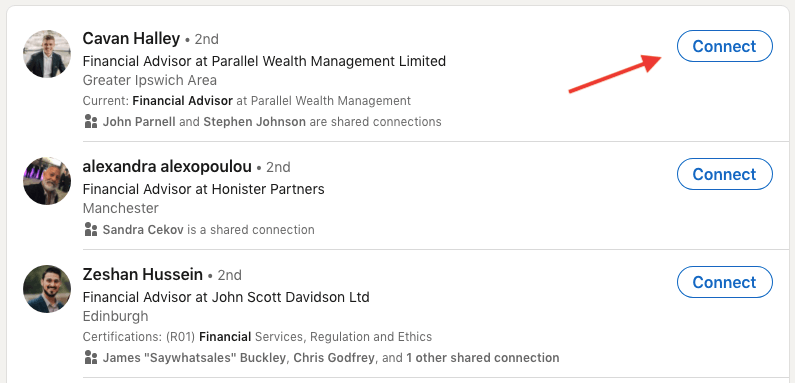
OR
Open the LinkedIn member’s profile. Click Connect.
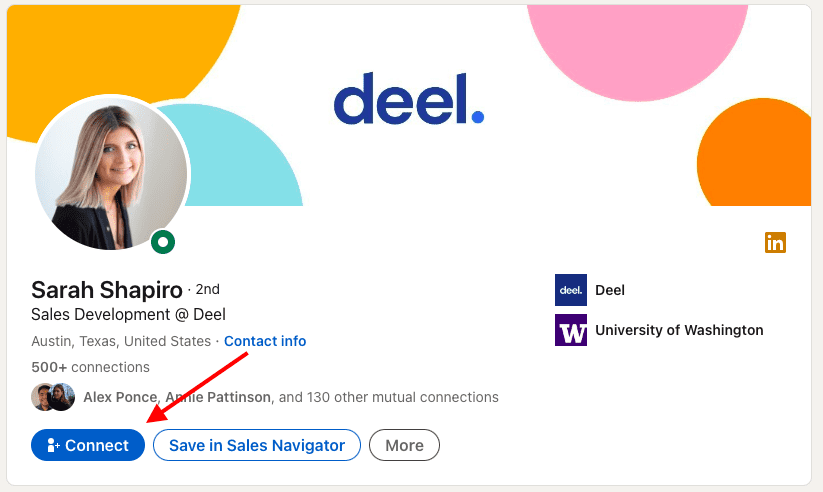
How to cancel a pending LinkedIn connection request?
Not a lot of people monitor their pending LinkedIn connection requests, which is wrong because the integrity of their LinkedIn profile could get damaged.
That’s why, we wrote a complete guide on How to cancel your LinkedIn invite, and, above all, explained in detail:
- Why do you need to cancel your LinkedIn invite;
- What you need to know about the cancellation process;
- How to cancel LinkedIn invitations that are pending for a long time;
- Why your LinkedIn invites aren’t getting accepted;
In, short, if you just wish to cancel a pending LinkedIn connection request, first click My Network on your LinkedIn profile home page.

Choose Manage or See all.

Choose Sent and the Withdraw option that’s next to the LinkedIn member’s name.
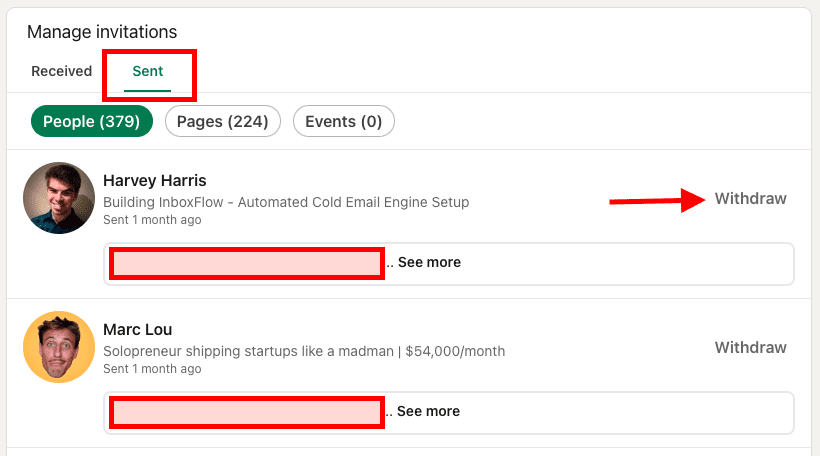
If you cancel a LinkedIn connection request, you won’t be able to send it again to the same member for the following 3 weeks.
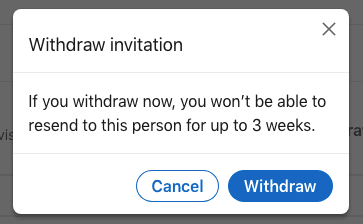
How to message someone on LinkedIn who is not a connection?
There are 3 types of connections on LinkedIn, and here is how to message every one of them.
- 1st-degree connections are LinkedIn users who are already part of your network. Reach out to them via regular LinkedIn messages using some of these LinkedIn sales message templates.
- 2nd-degree connections are LinkedIn members who are connected with your 1st-degree connections but not with you. Send them a LinkedIn connection message first, followed by a Thank you message on LinkedIn once they accept.
- 3rd-degree connections are LinkedIn members connected with your 2nd-degree connections. The platform encourages to reach out to these members via LinkedIn InMail first ( ➡️ here are LinkedIn InMail templates with a 25% reply rate formula tested by our Head of Sales, Andrea)
How to write a connection message on LinkedIn [5 best practices]
So, as mentioned above, it takes only a few people to deny your LinkedIn connection request and click I don’t know this person for you to be flagged on LinkedIn.
So, we decided to share 5 guidelines followed by our sales team when writing a LinkedIn connection message.
Look for common ground.
Mentioning any common ground turned out to be a positive practice. It could be a community you both belong to, a shared interest, a school, an industry, or even the same point of view on a specific topic.
Stay professional.
Reach out to other members in a professional manner. Avoid making personal references or giving compliments that are not business-related or argued.
Personalize your LinkedIn connection messages.
Addressing your lead by name is a must. Then, any other detail that you can mention, such as - the company name, the exact job title, set of skills, or job description, shows that you did your research. The more you know about your lead, the higher the chances of getting accepted on LinkedIn and turning that lead into your customer.
No generic nor irrelevant LinkedIn connection messages.
Even a blank LinkedIn connection request is better than I’d like to add you to my network.
Also, it’s hard for a pharmaceutical sales representative to be interested to read your article on SEO. Know who you are talking to.
Avoid selling straight out the gate.
Even if they need and like your product or service, no one will purchase anything without any additional info, chat, or call.
25 LinkedIn connection message examples [Up to 78% acceptance rate]
Tailor-making a LinkedIn connection message to each lead might seem a bit time-consuming, but it doesn’t have to be (not if you’re using Skyleaaaad 😂 ).
Jokes aside (or not!), the results of sending personalized LinkedIn connection messages are pretty rewarding.
Once you get used to the principles of writing in a compelling, LinkedIn-friendly way, your LinkedIn outreach will become a much more enjoyable experience.
Until then, use the LinkedIn connection message examples below that our team and users tested to grow their networks with relevant prospects.
Mention a mutual connection
Template
Hello {{firstName}},
I noticed that you are connected with {{mutualConnection}}.
{{mutualConnection}} and I worked together at {{company}}. I really loved {{whatYouLovedAboutMutualConnection}}.
I see that we are both in the {{industry}} industry and would love to have you in my network.
Example
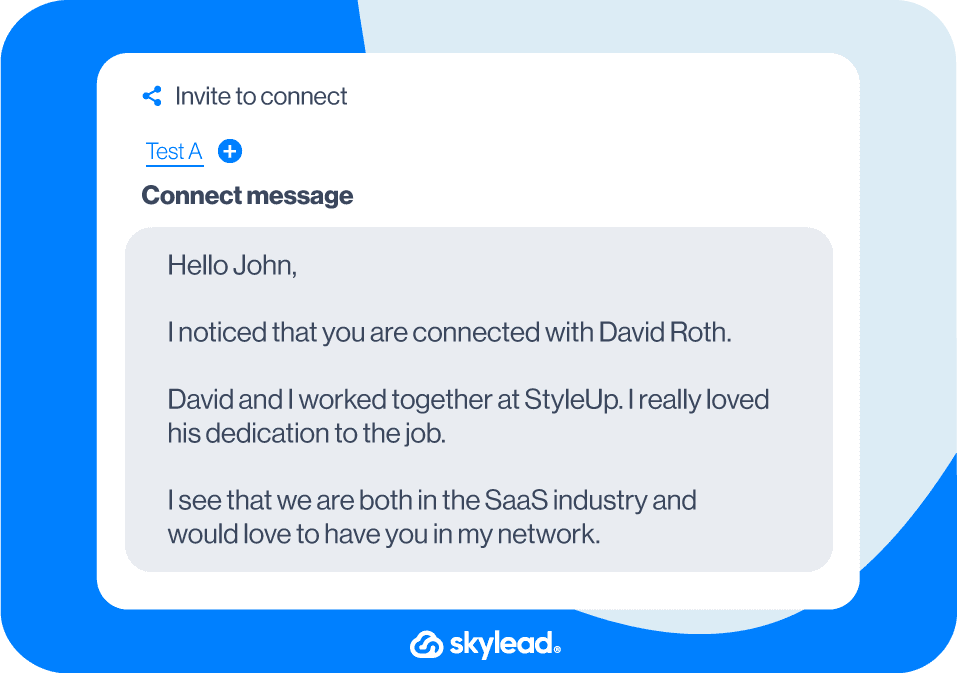
OR
Template
Hello {{firstName}},
{{mutualConnection}} pointed me your way for B2B lead generation services – would love to connect.
Example
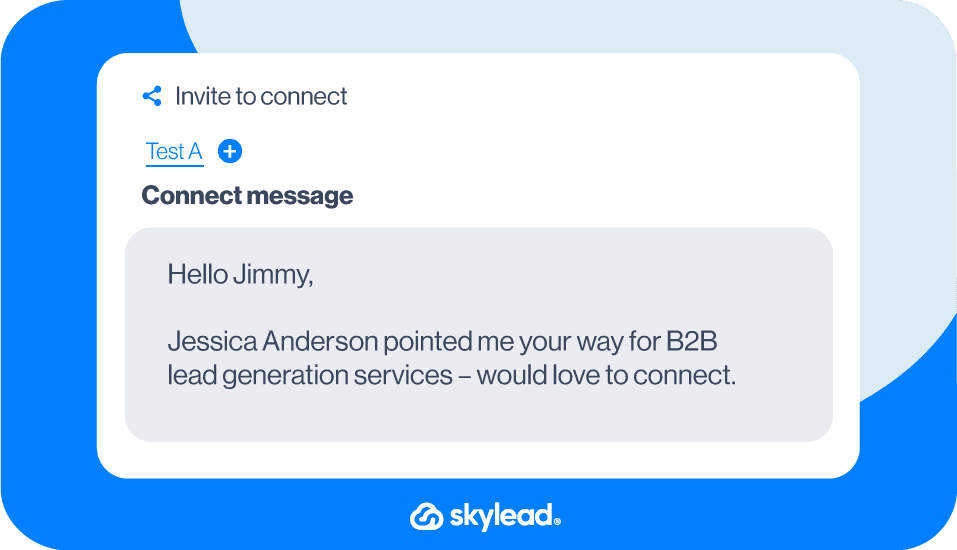
Reaching out to a candidate (as a recruiter)
Template
Hello {{firstName}},
It seems that you’ve been a great addition to your team at {{company}}. Way to go!
I would like to talk to you about a business opportunity.
But even if you’re not interested, it would be great to have you as part of my network!
Example
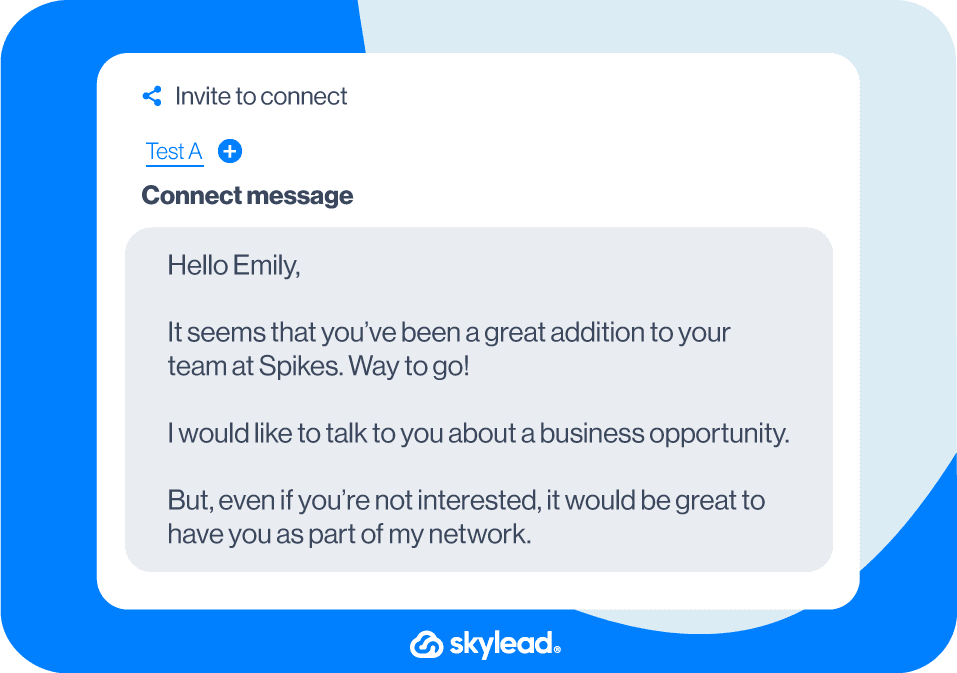
OR
Template
Hello {{firstName}},
I am reaching out to you for your vast experience as a {{occupation}}.
{{company}} is currently searching for a {{position}}.
If this sounds interesting to you, let’s connect.
Example
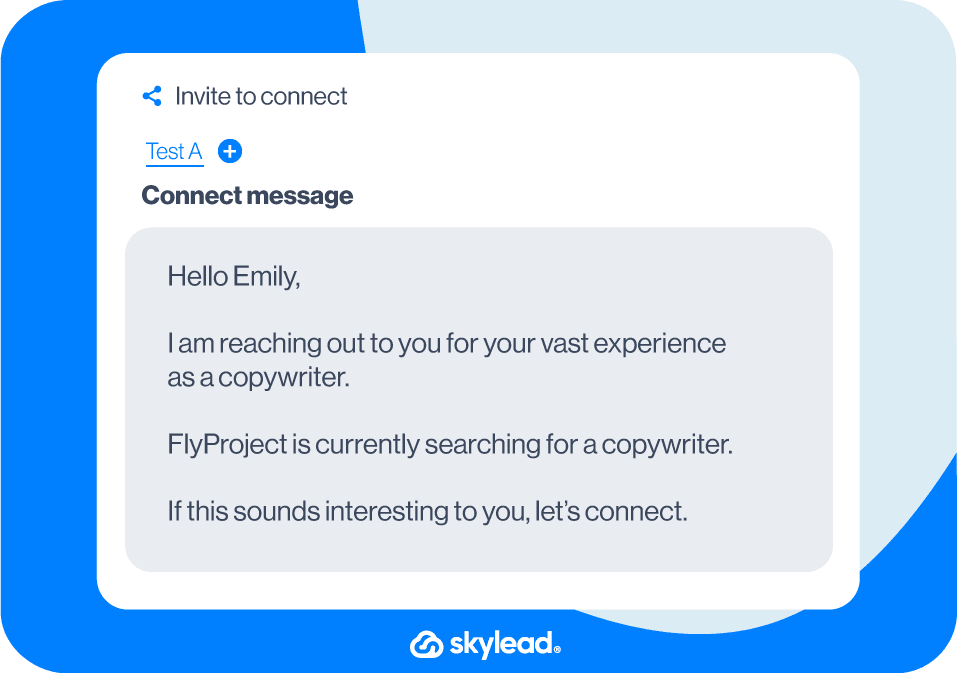
Reaching out to a recruiter (as a job seeker)
Template
Hello {{firstName}},
I saw that you are a recruiter at {{company}}.
I am a {{occupation}} with {{number}} years of experience in the {{industry}} industry, currently seeking new opportunities.
I’d like to connect and chat to see if my background fits any of your openings.
Example
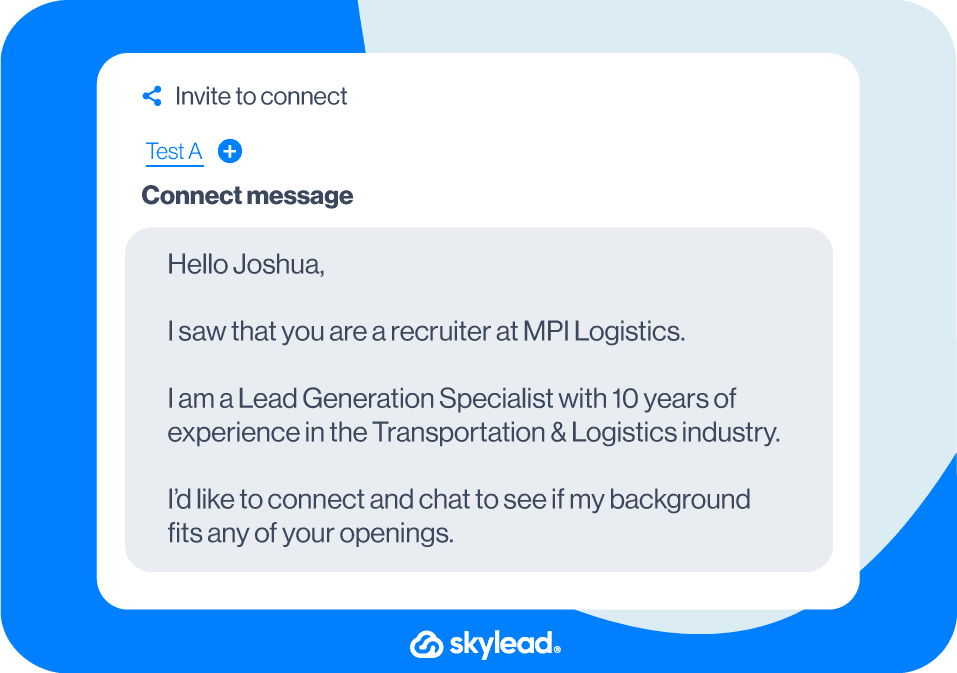
OR
Template
Hello {{firstName}},
I see that you’re the recruiter in charge of the {{occupation}} position at {{company}}.
I am very interested in applying but would like to ask you a few questions first.
Let’s connect.
Example
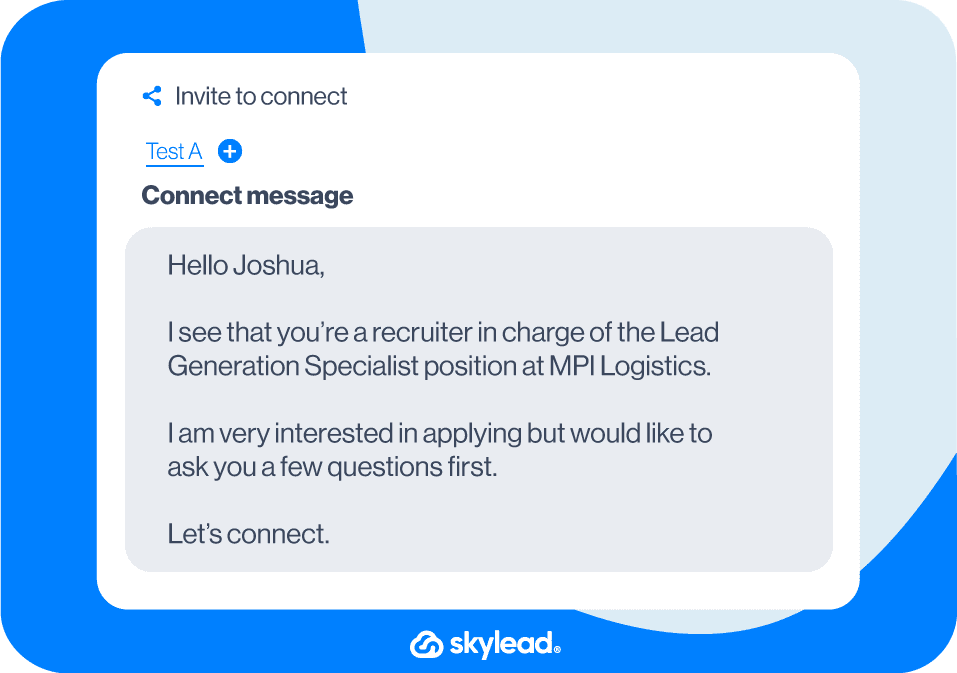
Intro to a collaboration proposal
Template
Hello {{firstName}},
I am a long admirer of your work.
I followed your advice regarding {{topic}} that you shared {{where}}. {{achievedResult}}.
Thank you once again!
Would love to connect!
Example
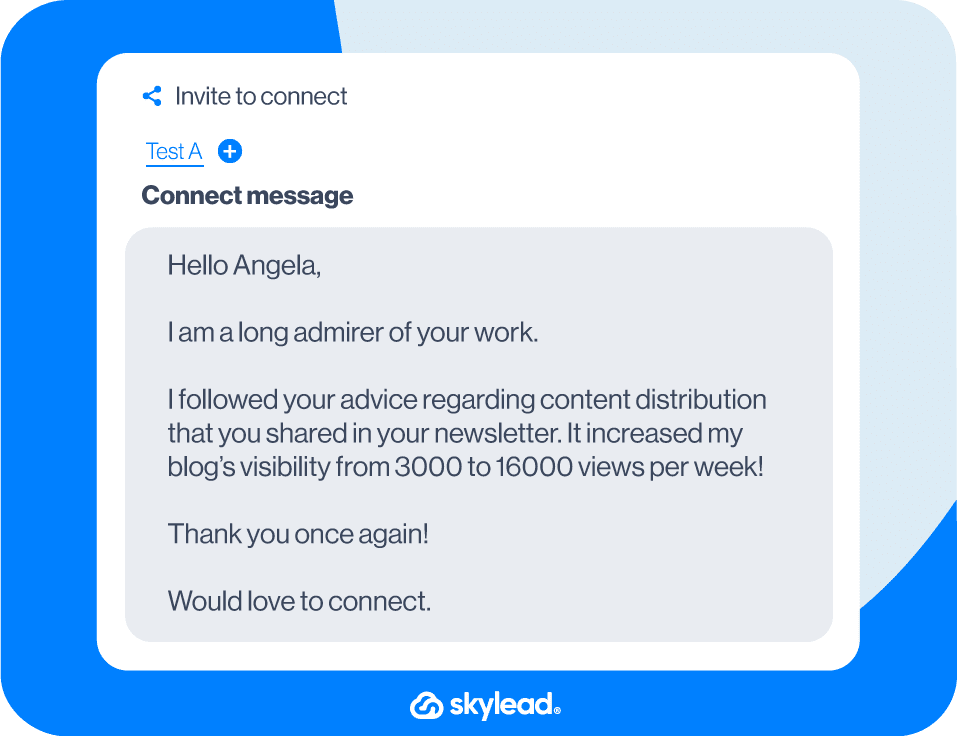
Connect with a member of the community
Template
Hello {{firstName}},
Your post in {{mutualCommunity}} was quite insightful.
I particularly liked the part where you said {{quote}}.
I would like to discuss it further with you. Let’s connect.
Example
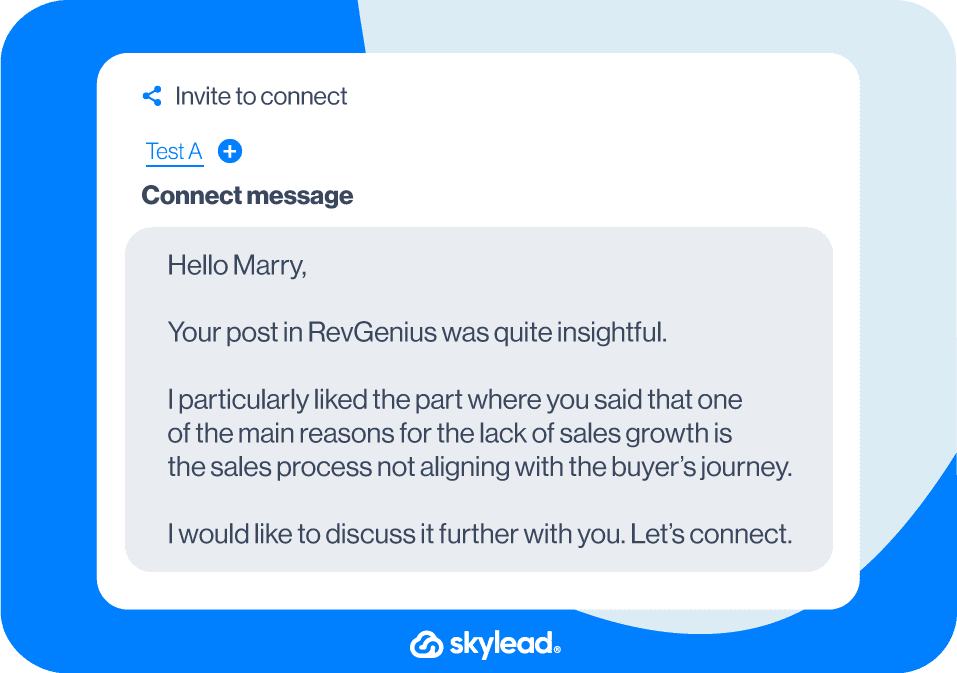
OR
Template
Hello {{firstName}},
I saw that you are also a member of {{mutualGroup}}.
I would love to connect with you since we both work in the {{industry}} industry.
Example
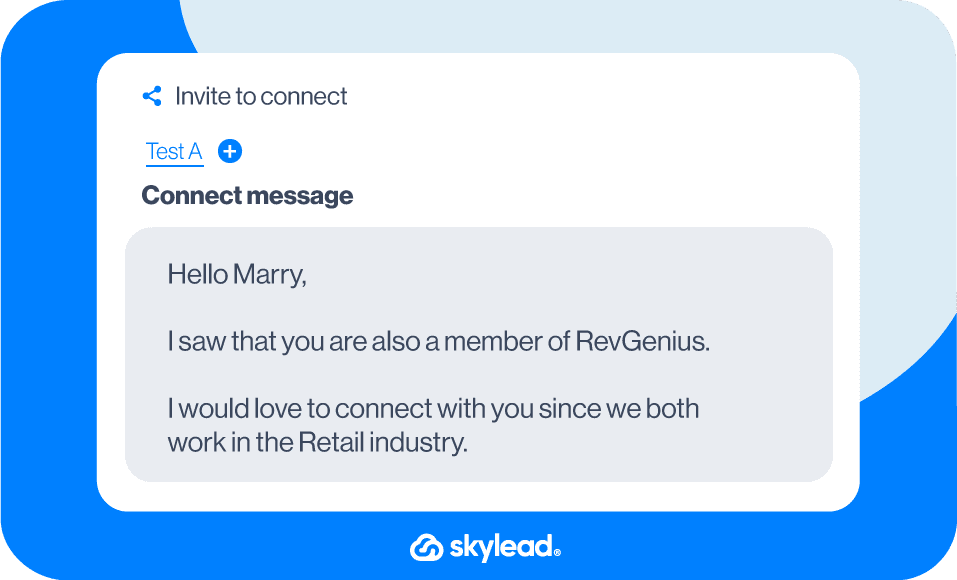
Approach an event attendee
Template
Hello {{firstName}},
It was great speaking to you at the {{eventName}} {{when}}.
What you do at {{currentCompany}} sounded fascinating and it totally inspired me!
I’d definitely like to stay up-to-date with your work.
Thank you in advance for connecting!
Example
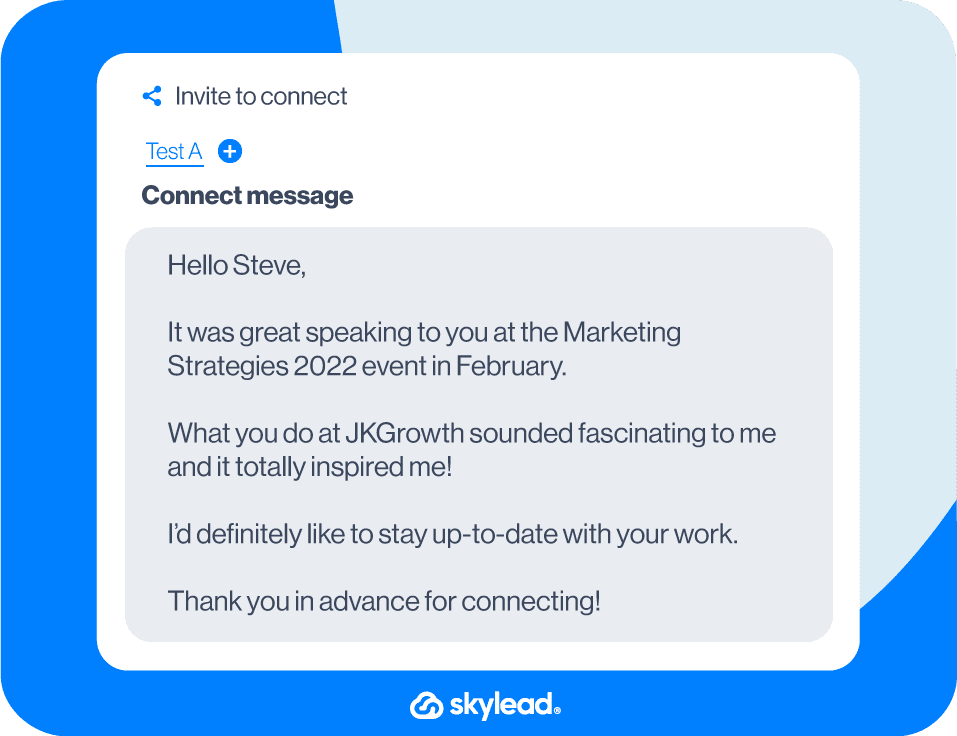
OR
Template
Hey {{firstName}},
I saw you at the {{eventName}} but I didn’t get the chance to approach you and introduce myself. How did you like the {{eventName}}? Would love to connect here and stay in touch!
Example
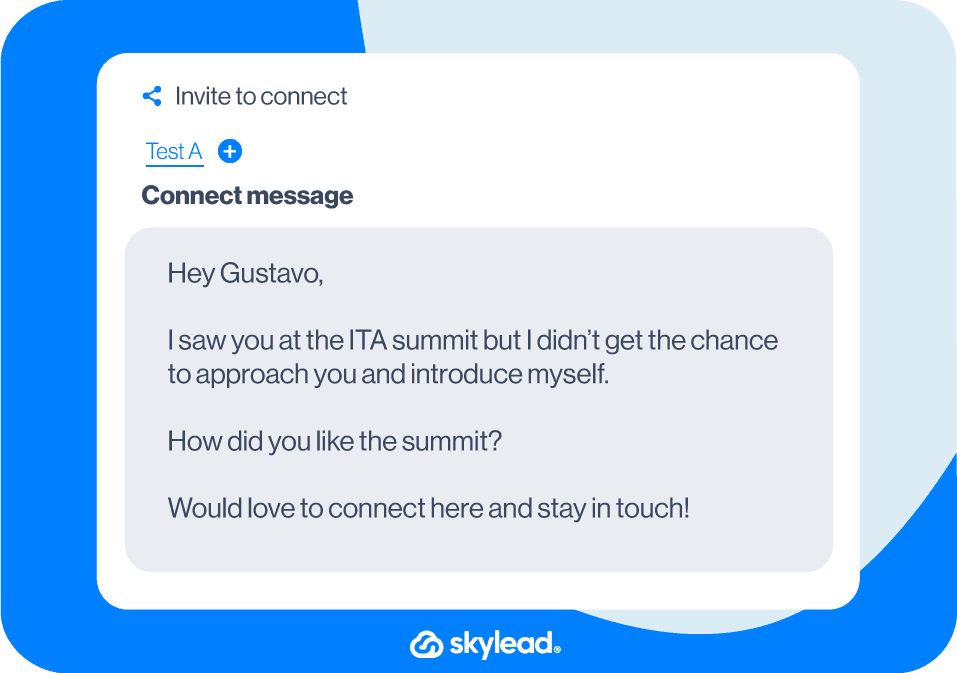
Reach out to a LinkedIn event attendee
Template
Hello {{firstName}},
I saw that you too attended the {{eventName}} LinkedIn event.
Learning {{what}} was particularly useful for my business.
Anyways, I would love to connect and exchange feedback on the event.
Example
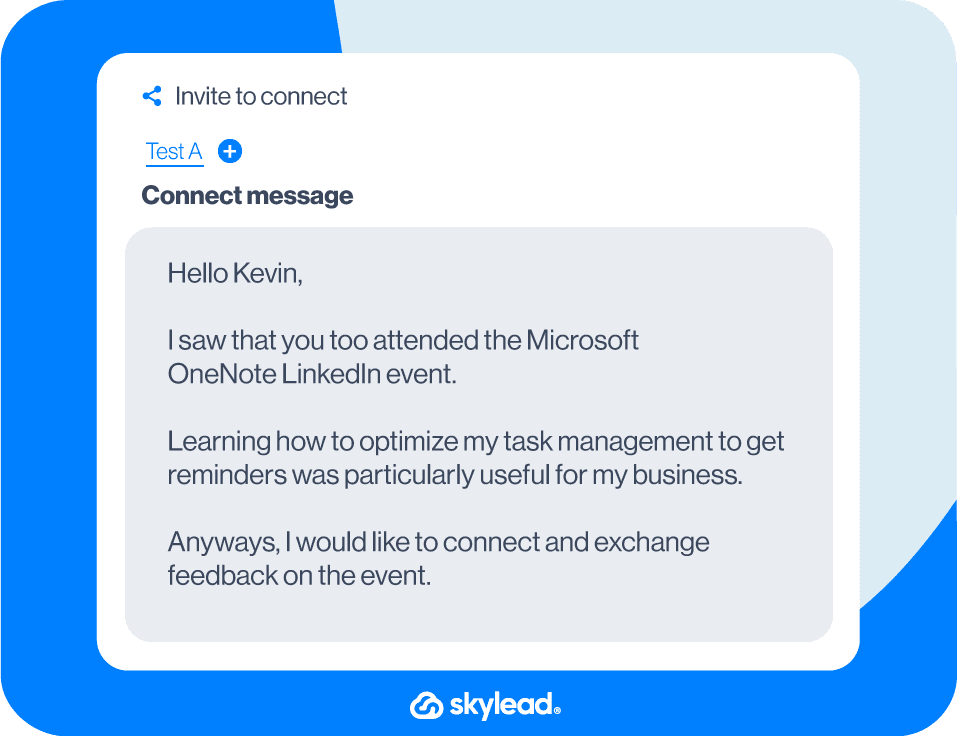
Reach out to an author of a LinkedIn article or post
Template
Hi {{firstName}},
I came across your LinkedIn article on {{topic}}.
I really resonated with your thoughts on {{topic}}.
I’d love to keep in touch and learn more about your work.
Example
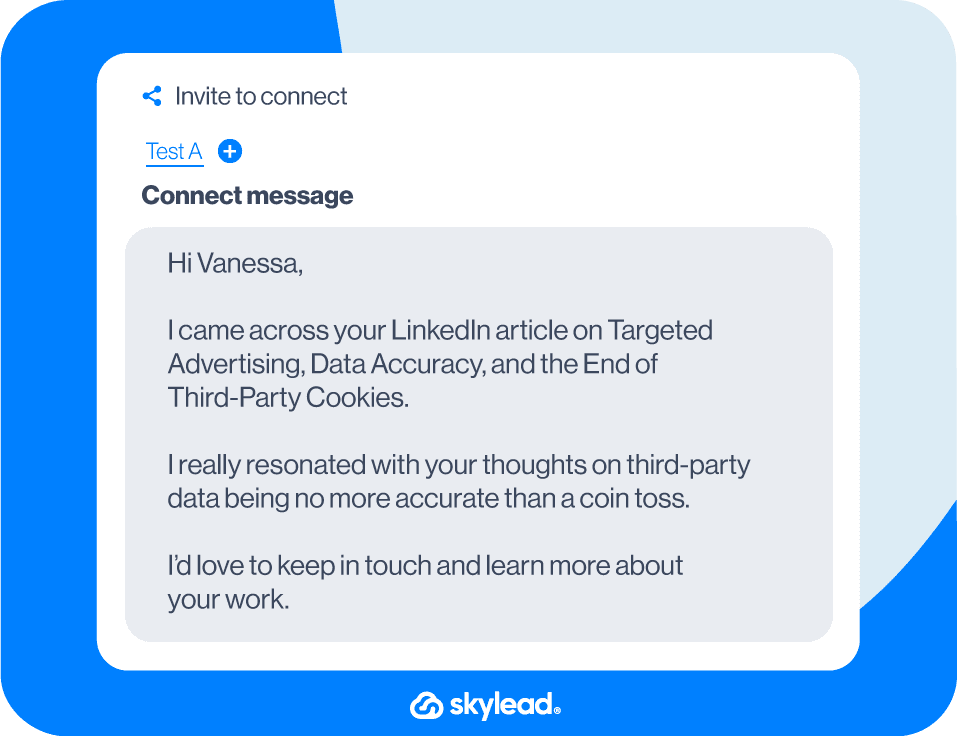
Break the ice using industry humor or a joke
Here are 35+ industry jokes that you could use in your LinkedIn connection requests as an icebreaker.
Template
Hi {{firstName}},
How many therapists does it take to change a light bulb?
Just one - but the light bulb has to really want to change.
Jokes aside, I would love to connect!
Example
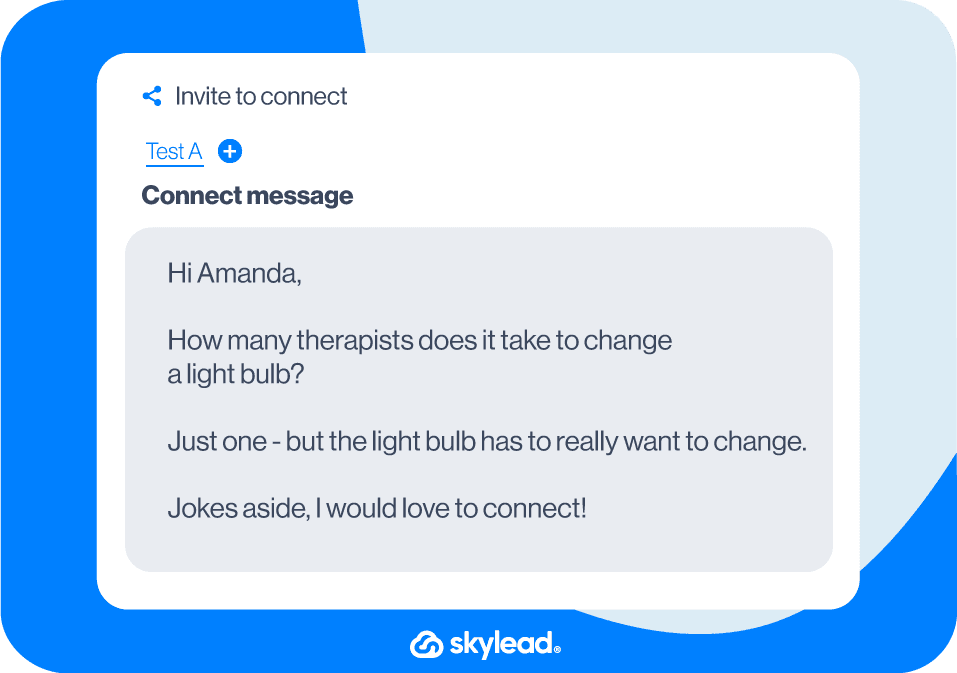
OR (something as silly as this)
Template
Hello {{firstName}},
I noticed we both breathe oxygen.
Sounds like a perfect fit to me, let’s connect!
Example
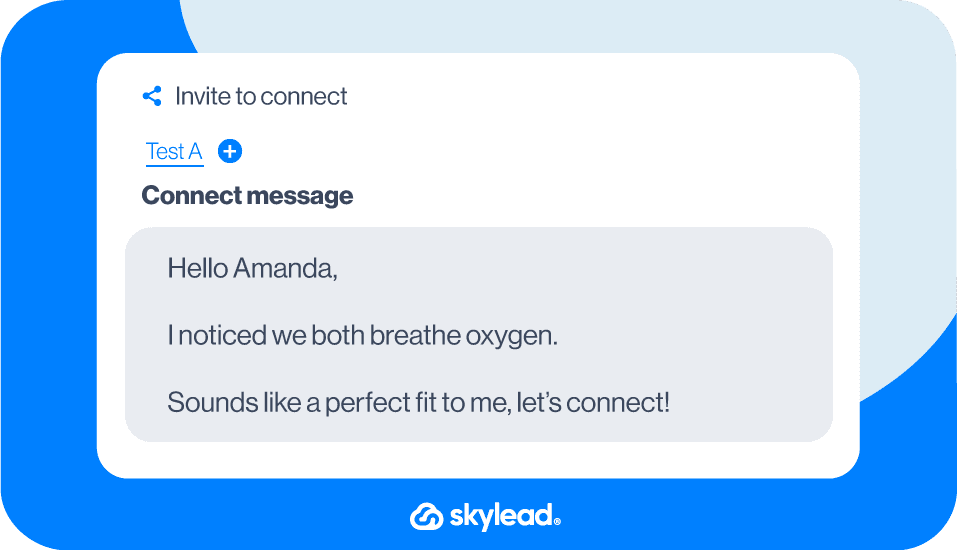
Connect with a former colleague
Template
Hello {{firstName}},
Remember me?
We used to work together at {{company}} back in {{year}}.
Let’s connect and catch up, I would love to hear how it is going at {{currentCompany}}!
Example
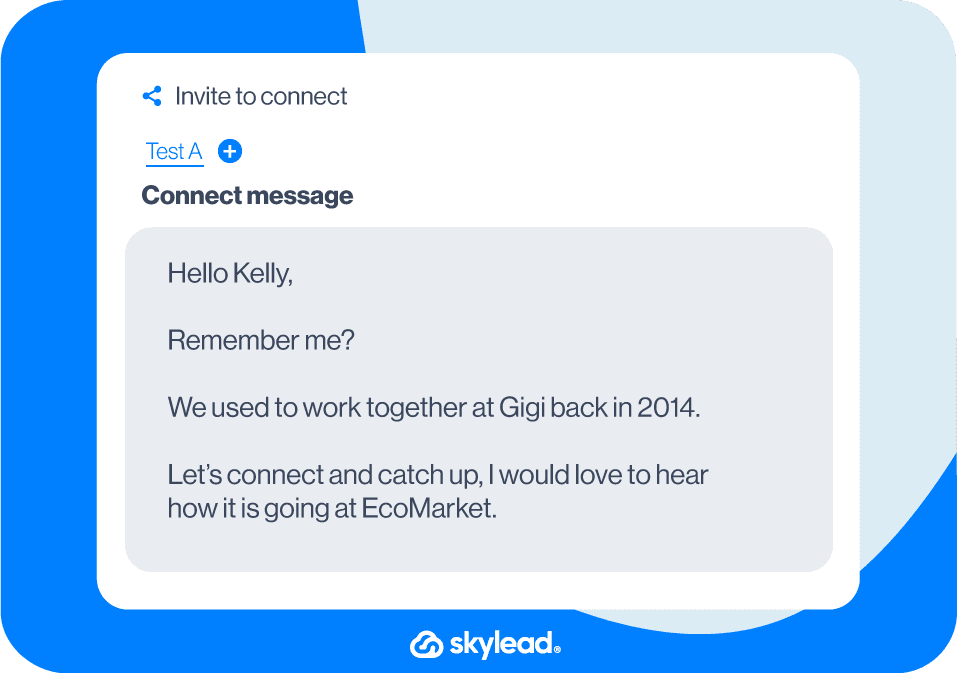
OR
Template
Hello {{firstName}},
It was such a pleasure working with you at {{company}} back in {{year}}.
Let’s connect! I would like to hear what you’ve been up to professionally since.
Example
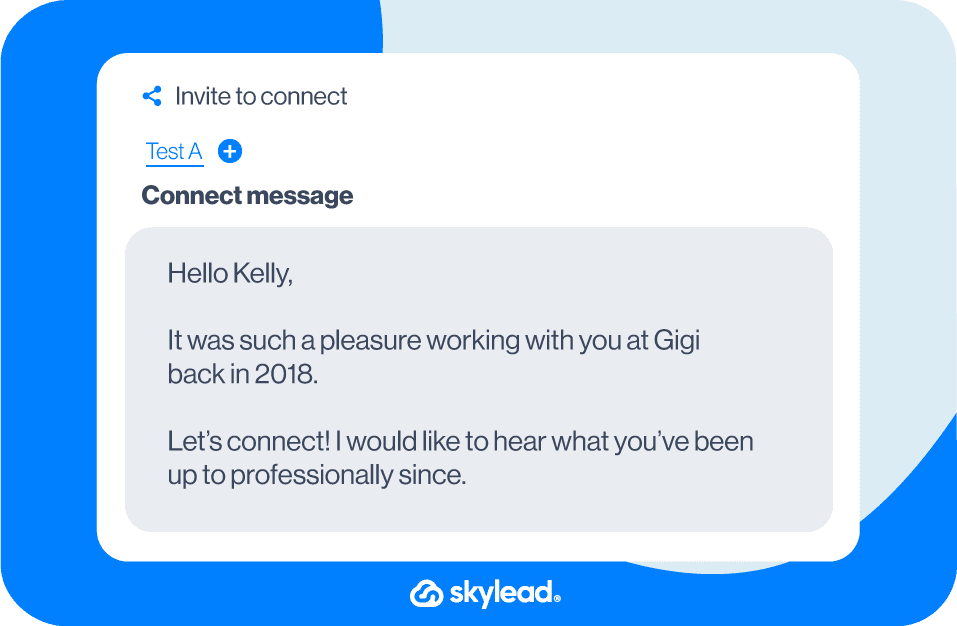
Reach out to a colleague
If a company is big, knowing everyone you’re working with is hard.
However, connecting with colleagues is a good practice for expanding your network on LinkedIn.
Remember that they also might have some interesting connections, and you never know who they could introduce you to.
Template
Hello {{firstName}},
Good news travels fast! I heard about you {{achievement}}. Great job!
Anyways, I am {{yourName}} from the {{department}} team and would love to connect!
Example
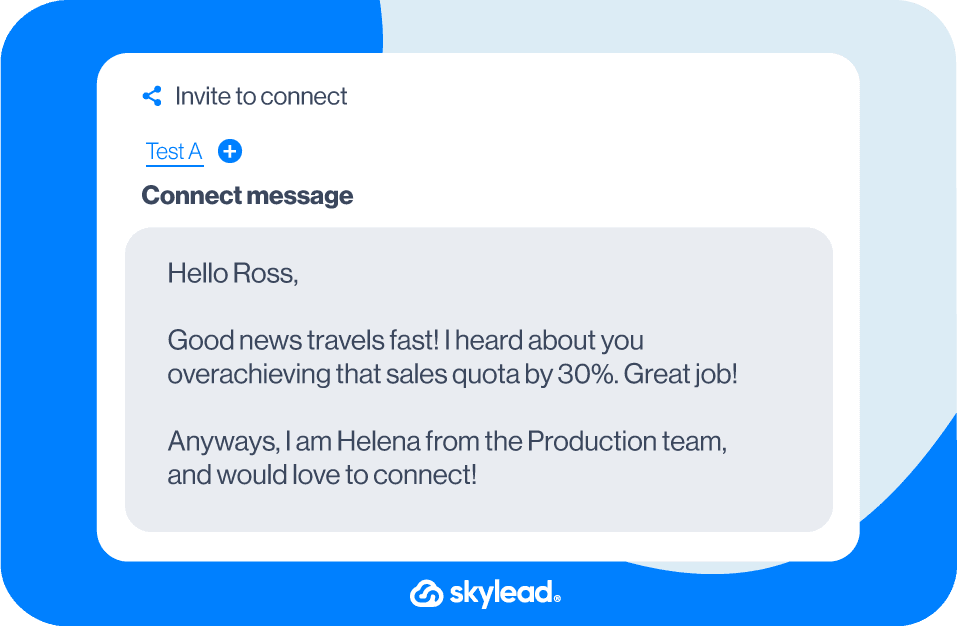
Connect with former alumni
Template
Hello {{firstName}},
I see that we graduated from the same university. Go {{school’sSportsTeam}}! 🙂
I would like to connect and learn more about your experience at {{company}}.
I myself majored in {{major}} and currently work in the {{industry}} industry.
Example
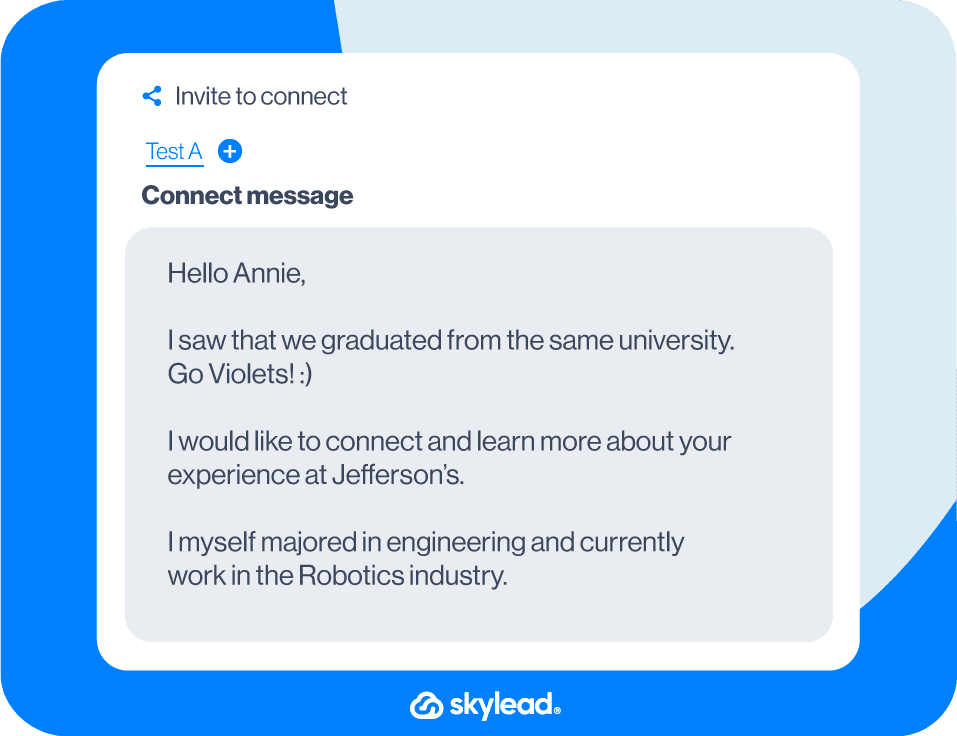
Reach out to members who reacted to your or someone else’s LinkedIn post
Template
Hello {{firstName}},
I saw that you are also a fan of {{name}}’s content and just wanted to connect with you.
Example
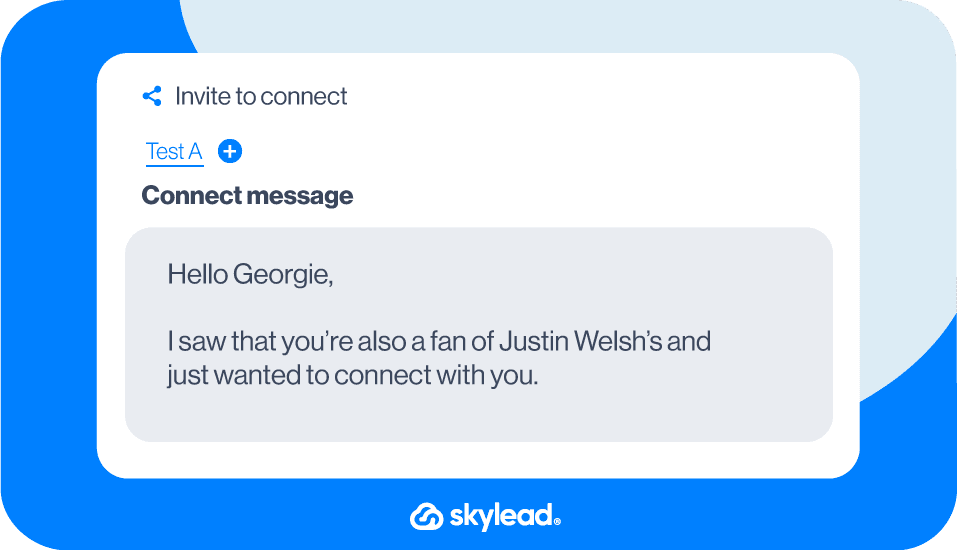
OR
Template
Hello {{firstName}},
I saw that you also liked {{Name}}’s post on {{topic}}. I am a big fan of his/her work.
His/her advice worked well for me!
Anyways, I would love to connect and maybe even discuss it further.
Example
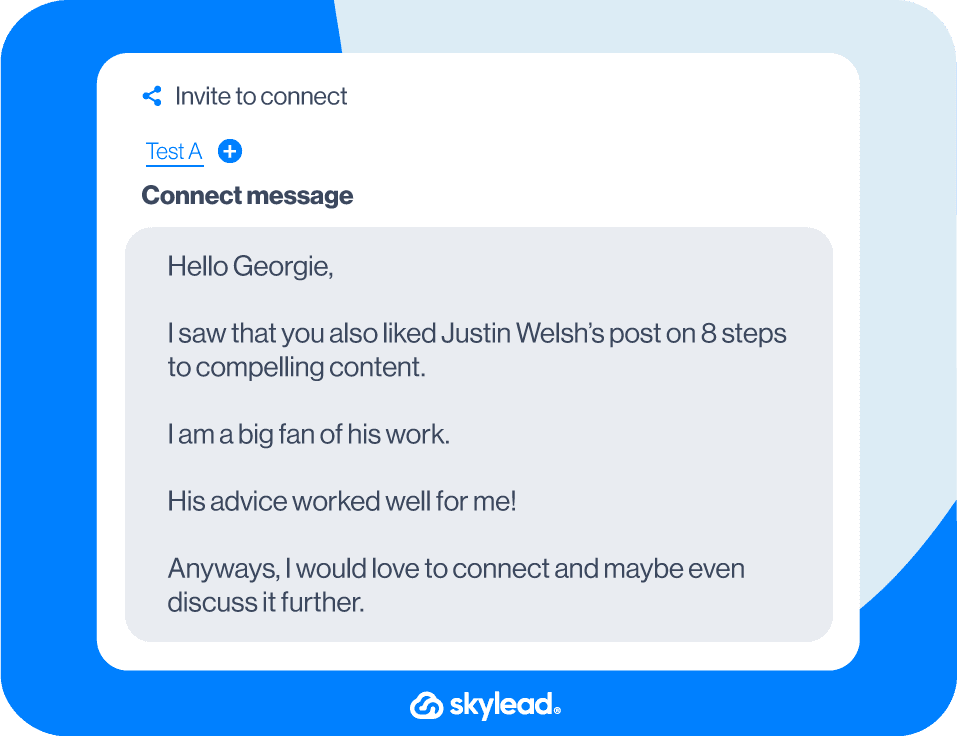
Connect with a member who asked a question in the post comment
Template
Hi {{firstName}},
I saw that you commented on {{name}}’s post about {{topic}} and asked {{question}}.
I would like to connect and share some resources with you that could be helpful.
Example
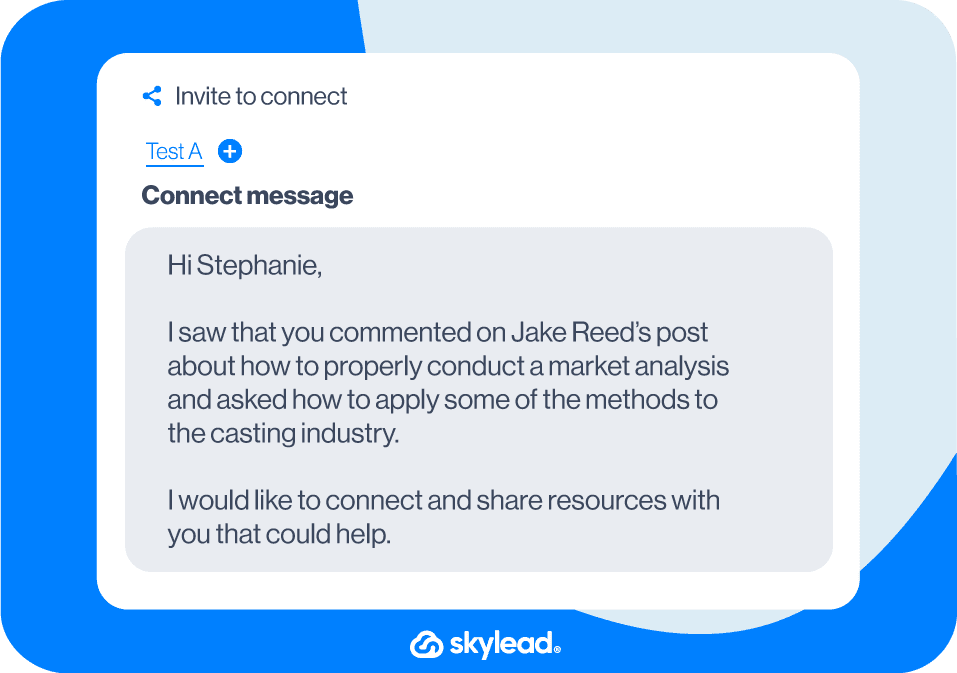
Reach out to members suggested by LinkedIn
The People also viewed feature displays a list of LinkedIn members that the platform’s algorithm found important for your LinkedIn experience, whether you are using it for networking, job search, or lead generation.
Use this template to reach out to them.
Template
Hello {{firstName}},
Your profile came as suggested through the People also viewed section, so I was curious and checked it out. I saw that we’re both in the {{industry}} industry, so I thought we connect and exchange experiences.
Example
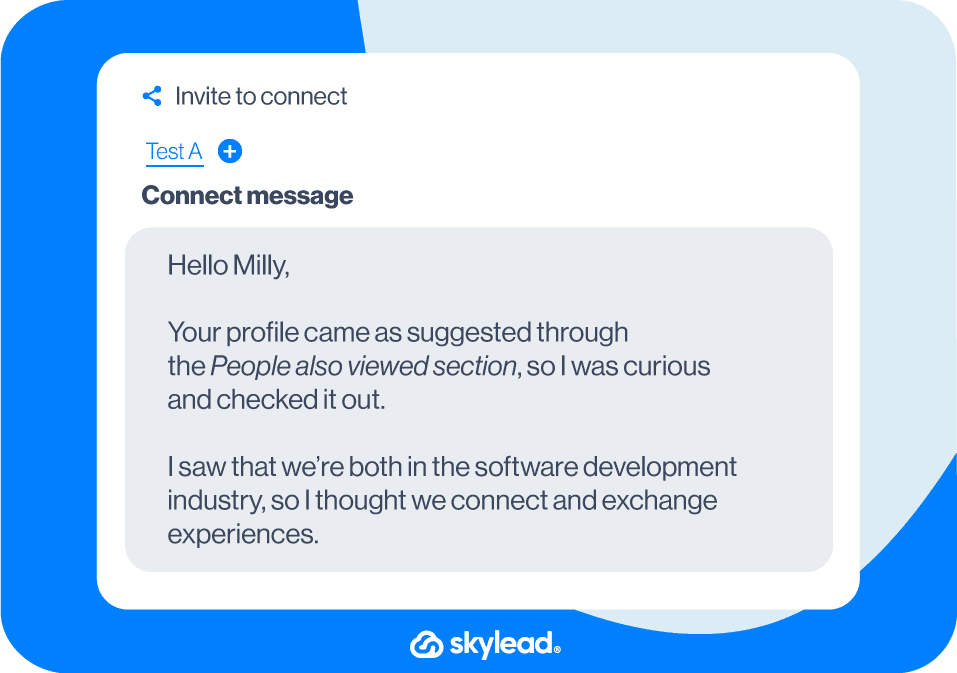
OR
Template
Hello, {{firstName}}
LinkedIn suggested your profile several times now, so I was curious and checked it out. I saw that we’re both {{occupation}}, so I thought it would be good to connect with professionals from the industry. Let’s exchange experiences:)
Example
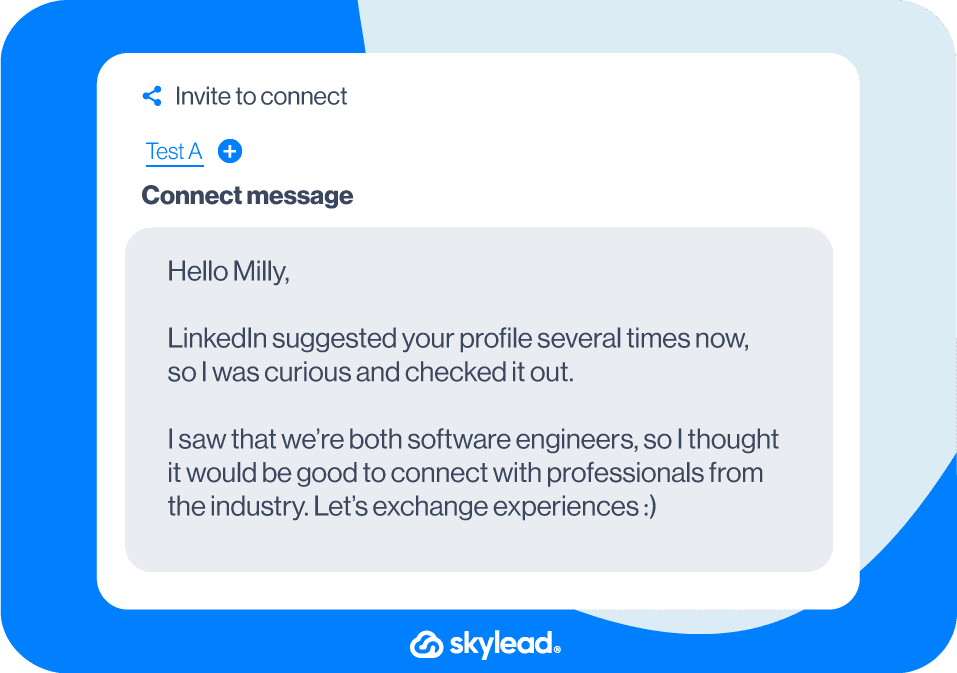
Start with a genuine compliment
Template
Hi {{firstName}}
I have been following your work for some time now, and I must admit your career path in the {{industry}} industry impressed me. I would love to connect with you and ask you a few questions about your beginnings in the field.
Example
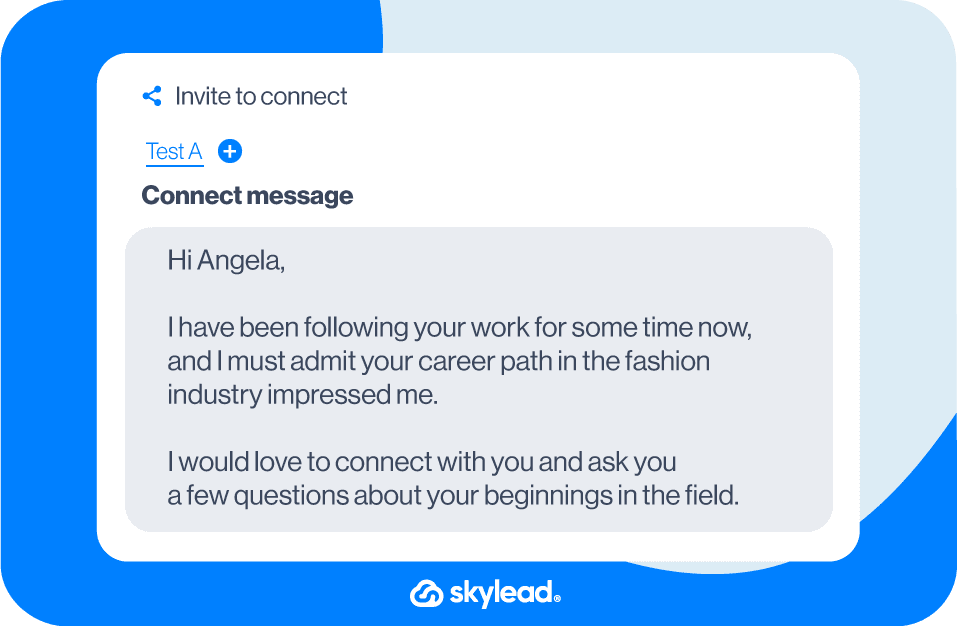
LinkedIn Connection Message: FAQ
How can one effectively track and measure the success rate of these LinkedIn connection message templates, especially in terms of resulting in meaningful professional relationships or business opportunities?
To effectively track the success of LinkedIn connection message templates, monitor acceptance rates and follow-up interactions. Analyzing these metrics can provide insights into which templates foster meaningful connections and opportunities. Adjust strategies based on this data for improved outcomes.
What are the best practices for following up on a connection request if there's no response initially, without coming across as too persistent or spammy?
Following up on a LinkedIn connection request requires a delicate balance. If there's no initial response, a polite and concise reminder after a reasonable period can be appropriate. Avoid being overly persistent; one InMail or email follow-up is generally considered tactful to maintain professionalism without seeming spammy.
How do you politely ask for a connection on LinkedIn?
Asking to connect with someone on LinkedIn has become as common as asking or giving your business card to someone. Many professionals include links to their profiles in the paper or QR code business cards or in the signature section of their emails.
Should I send a message with a connection request on LinkedIn?
Adding a message with a connection request on LinkedIn is generally considered good practice that increases your acceptance rate. However, sending a blank request rather than a generic message is better if you decide not to use a personalized approach. Check out our examples above.
What message to write with a connection request on LinkedIn?
Mentioning something that you have in common with the person you are trying to connect with is generally considered good practice that increases your chances of getting accepted. However, there are many other LinkedIn connection request messages that you can use. Check out our examples to get inspired.
How do I send a cold connection request on LinkedIn?
The cold connection request is not “as cold” as it seems if you follow the golden rule of connecting to people relevant to your business or with whom you have something in common. Therefore, the best way to connect on LinkedIn is by mentioning something relevant to both of you.
Did someone reject my connection request on LinkedIn?
You can ignore someone’s connection request on LinkedIn by clicking “Ignore” instead of “Accept” or by ignoring it and letting it pend. LinkedIn does not notify the sender when their connection request has been declined. Also, LinkedIn automatically deletes pending connection requests after 6 months.
What happens when you ignore a connection request on LinkedIn?
To decline someone’s connection request, just click “Ignore”. LinkedIn will not notify the member of their request being declined, but they can send you another connection request. If you literally ignore the request and leave it pending, LinkedIn will automatically delete it after 6 months.
Do LinkedIn requests expire?
Yes, LinkedIn requests expire. All pending LinkedIn connection requests will be automatically deleted after 6 months. After that, the member whose request has been deleted can ask for another connection again.
Can people see withdrawn LinkedIn requests?
Your recipient won’t be notified if you withdraw your connection request on LinkedIn. To do that, go to My Network > Manage (top right corner) > Sent > Withdraw. If the LinkedIn member already accepted your invitation to connect, they can be removed as a connection.
How do you know if someone accepted your LinkedIn request?
You will get a notification when someone accepts your connection request. To set up notifications, go to Settings & Privacy > Notifications > Connecting with others > Invitations to connect. Or, go to My Network > Connections (top left corner) > Recently added > See the list of recently added connections or search them by name.
Disclaimer: Skylead is not affiliated, endorsed by, or connected with LinkedIn in any way.
How many content writers does it take to change a lightbulb?
Doesn’t matter, the head of marketing will change it anyway.
Jokes aside, the answer is - none. Because content writers don’t like to change anything.
Plus, the light bulbs don’t really change, they’re replaced.
I’ll stop now.
Ok, maybe your first thought was not to add me to your LinkedIn network after reading my cringe jokes, but you would be surprised how well people react to humor in outreach. So, if you ever wondered what the best way to expand your network is or how to outreach the leads you found via prospecting on LinkedIn, then industry-related jokes in your Connection Request Messages, LinkedIn InMails, or LinkedIn Messages are definitely top of the list.
A good industry-related joke not only helps your acceptance and response rates, but also creates a positive first impression between the two. I personally tend to use them in my Connection Request Messages, but they can be a great conversation starter in messages for LinkedIn lead generation as well.
Since I know how hard it is to find industry-related jokes, I decided to do a little research for you and put them all in one place. This way I want to make using humor to expand your network on LinkedIn a little bit less time-consuming and to encourage you to get bold and creative in your outreach.
Expand your network: How to use humor in outreach?
As mentioned before, a good joke finds its place anywhere you want. Use it to connect with other LinkedIn members, to start a conversation, or to make a hook for a potential business proposal in an InMail.
There are multiple ways to use an industry-related joke in your outreach.
Example #1
Use the joke as the opener when networking on LinkedIn.
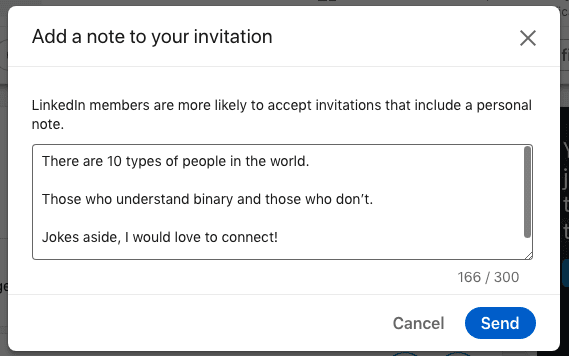
Example #2
Use the joke as the opener, but add a personal note to it.
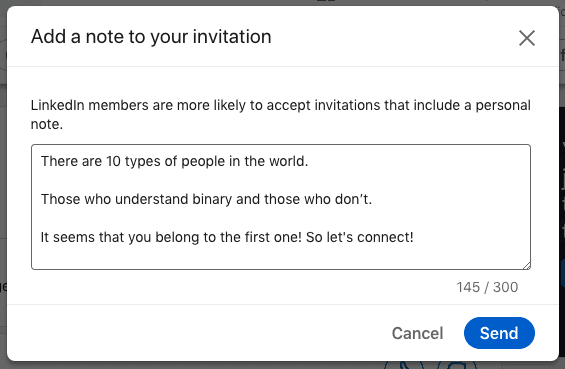
Example #3
Make the joke part of your hyper-personalized message to expand your network on LinkedIn.
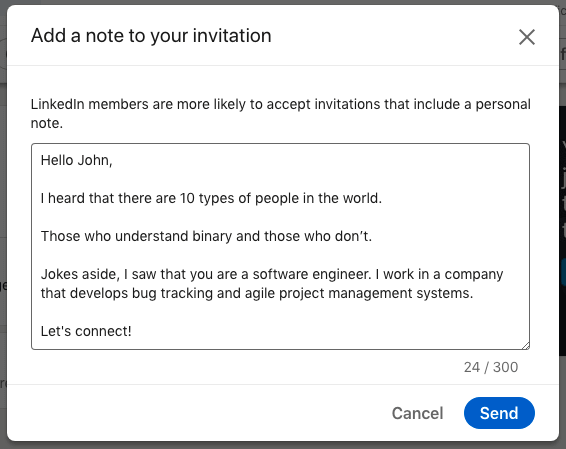
Here is the list of jokes for:
- Sales representatives;
- Marketers;
- Managers;
- Developers;
- Customer Support Specialists;
that you can use right away or combine them in your outreach.
Dos and Don’ts when using humor to expand your network
DOS
- Do the research before you choose the joke that you want to use. Consider each person’s unique cultural background and personal story. You want it to be relevant to the person you are talking to.
- Make sure that the joke is not offensive or maybe on the edge of being offensive.
- Have in mind that you are reaching people whose sense of humor you don’t know. A joke that is funny to you might not be to them. So don’t take things too personally in case they don’t take the direction that you wanted. However, people usually react well to humor.
- Do get to the punchline fast. Be short.
- Do laugh at yourself when you get a chance. Telling a joke that you made up from your personal experience always works. It makes you more human and approachable, and people generally love to work with people who don’t have a problem laughing at themselves.
DON’TS
- Don’t force a joke where it doesn’t belong.
- Don’t use jokes that talk bad about someone or call someone out, even if it’s their/your competition. It is not only rude and pathetic but unprofessional and it doesn’t make you look good at all.
- Avoid jokes that have to do with current hot-topics, that are political, or have to do with anyone’s sexual or religious orientation. No one wants to hear that or have those kind of people in their professional (or personal, for that matter) network.
- Don’t overdo it. Know when to stop. If someone answers back with a joke or a funny punchline, make sure that you know when joking about the same topic becomes too much.
Jokes for salespeople
Expand your network on LinkedIn by incorporating these sales jokes in your LinkedIn Connection Request Messages, Messages, or InMails.
Sales Joke #1
Always trust a glue salesman.
They tend to stick to their word.
Sales Joke #2
How do salespeople traditionally greet each other?
Hi. Nice to meet you. I’m better than you.
Sales Joke #3
What did the horrible buyer say to the salesperson who had a 24h deadline?
Give me another week to think about it.
Sales Joke #4
What salesman has the slickest line?
A hair grease salesman.
Sales Joke #5
How many salespeople does it take to change a light bulb?
None. You don't need a new light bulb - you need to upgrade your socket to the newest version.
Jokes for marketers
Expand your network on LinkedIn by incorporating these marketing jokes in your LinkedIn Connection Request Messages, Messages or LinkedIn InMails.
Marketing Joke #1
How did Yoda get his first lead?
He used the SalesForce.
Marketing Joke #2
What is the safest place to hide a body?
The second page of Google.
Marketing Joke #3
Why did the marketing couple break up?
They weren’t on the same landing page.
OR
Lack of engagement
Marketing Joke #4
How many marketers does it take to screw in a light bulb?
None – they’ve automated it.
Marketing Joke #5
Why don’t marketer’s like trampolines?
They’re scared of high bounce rates.
Marketing Joke #6
How do SEO experts celebrate improved search rankings?
SERP-rise parties.
Marketing Joke #7
Why do digital marketers love to shop at Whole Foods?
They have a lot of organic content.
Marketing Joke #8
What’s a marketer’s favorite drink?
Brand-y.
Marketing Joke #9
What’s a pirate’s favorite type of content?
A webinAAARRRR!
Marketing Joke #10
What does the SEO professional see when they see twins?
Duplicated content.
Marketing Joke #11
Why do SEO experts love driving during peak hours?
They appreciate the traffic.
Marketing Joke #12
An SEO copywriter walks into a bar, bars, tavern, pub, pubs, public house, Irish, bartender, drinks, beer, wine, liquor.
Jokes for managers
Expand your network on LinkedIn by incorporating these management jokes in your LinkedIn Connection Request Messages, Messages, or InMails.
Management Joke #1
What is the hardest part of being a product manager?
Explaining what you do to your parents and friends.
Management Joke #2
How many managers does it take to change a light bulb?
A roomful - they have to hold a meeting to discuss all the ramifications of the change.
Management Joke #3
Don’t stand around doing nothing.
People will think you’re the manager.
Management Joke #4
How many project managers does it take to change a lightbulb?
None, they are all still discussing the best way to do it.
Management Joke #5
A product manager walks into a bar.
It isn't what he expected so he immediately blames development for no reason.
Jokes for developers
Expand your network on LinkedIn by incorporating these software engineer jokes in youConnection Request Messages, Messages, or InMails.
Developer Joke #1
Why did the front-end developer buy the flat under his?
He always wanted a sub-domain.
Developer Joke #2
A developer’s wife asks him - Would you go to the store and pick up a loaf of bread? And if they have eggs, get a dozen.
The developer returns home with 12 loaves of bread. They had eggs, he explained.
Developer Joke #3
Why do programmers always mix up Christmas and Halloween?
Because Dec 25 is Oct 31.
Developer Joke #4
If doctors were like software engineers, they would say things like “Have you tried killing yourself and being reborn?”
Developer Joke #5
A developer is a tool that transforms caffeine into code.
Developer Joke #6
Give a man a program, frustrate him for a day.
Teach a man to program, frustrate him for a lifetime.
Developer Joke #7
Software undergoes beta testing shortly before it’s released.
Beta is Latin for 'still doesn’t work’.
Developer Joke #8
What do you call a software wizard that installs applications?
The Wizard of OS.
Developer Joke #9
What's the difference between a junior software engineer and a senior software engineer?
A senior software engineer writes wrong code faster.
Jokes for customer support specialists
Expand your network on LinkedIn by incorporating these CSS jokes in your LinkedIn Connection Request Messages, Messages or InMails.
CSS Joke #1
Evil queens are just Disney princesses who worked in Customer Support too long.
CSS Joke #2
Those who say “there is no such thing as a stupid question” obviously never worked in Customer Care.
CSS Joke #3
Anyone who ever said that “the customer is always right” has never worked in Tech Customer Support.
CSS Joke #4
Customer Service is like…
If you understand English, press 1.
If you do not understand English, press 2.
Frequently asked questions
How effective are humorous templates across various industries, especially in more conservative fields?
Humorous templates' effectiveness varies across industries. In conservative fields, they may be less appropriate. Tailoring the humor to suit the industry's tone can improve reception.
What are the best practices for personalizing jokes to ensure they resonate well with specific audiences or sectors?
Personalizing humor involves understanding the recipient's background, industry norms, and possibly their company culture to ensure the joke aligns with their professional environment.
Are there examples of negative reactions or feedback to consider when using humor in professional outreach?
Negative reactions to humor in professional outreach are possible, especially if the humor is misinterpreted or deemed unprofessional. It's crucial to balance humor with professionalism and consider the potential for diverse interpretations.
Summary
Jokes that you use in your sales engagement or in real life quickly impact your personal brand image and reputation, for good or bad. Ideally, whoever you talk to shares your sense of humor and can understand a light-hearted critique of the industry.
As mentioned above, here we’ve listed jokes that you can use right away for:
- Sales representatives;
- Marketers;
- Managers;
- Developers;
- Customer Support Specialists.
Be bold in your outreach. It will for sure pay off.
And for the end:
How many marketers does it take to generate 10 times more leads in less time?
None, they use Skylead.
Disclaimer: Skylead is not affiliated, endorsed by, or connected with LinkedIn in any way.
At first mention, cold outreach tends to have a bad reputation.
It's no wonder, as no one likes unsolicited emails, LinkedIn messages, or calls.
However, real cold outreach is not useless or annoying. On the contrary, it helps your and your clients' businesses grow and builds strong, lucrative, and long-lasting relationships.
It starts with thoroughly researching the ICP and Buyer Persona, defining a precise outreach strategy, writing sales messages and follow-ups in advance, predicting objections and preparing for objection handling, and much more.
That's why, in this blog, we will dive into a detailed explanation of:
- What cold outreach is;
- How sales, marketing, and recruiting can benefit from it;
- Best practices for successful cold outreach;
- And will give you a list of resources with ready-to-use cold sales message templates.
What is cold outreach?
Cold Outreach is a form of outbound marketing. It implies contacting prospects with whom you had no prior relationship and introducing them to your product/service. It can be conducted via various channels such as email (cold emailing), phone (cold calling), or by combining these channels (multichannel outreach).
Companies with a business-to-business work model mainly use cold outreach. For optimal results, each cold outreach campaign should be based on a well-thought-out outreach strategy. This strategy should aligns with the company's needs, goals, and possibilities.
Cold outreach VS warm outreach
Cold outreach, as mentioned above, implies reaching out to prospects with whom you had no prior relationship and who most likely have little or no awareness of your product/service.
On the other hand, warm outreach implies contacting prospects who know about your product/service and have expressed interest in it. The communication channels can be the same as cold outreach strategies - via LinkedIn, email, call, or combining several communication channels. However, the approach is, of course, different.
Cold outreach strategies in marketing, sales, and recruiting
Cold outreach is a form of outbound marketing and sales. It is a traditional form of marketing in which a company initiates contact with a potential customer.
Since cold outreach is mainly implemented by companies with a B2B work model, these potential clients are other companies that could benefit from their products/services the most.
The most common forms of outbound marketing are:
- cold outreach (cold emailing, cold calling, cold messaging on LinkedIn),
- billboards,
- events,
- advertising through TV or radio,
- print,
- online,
- in-person contact, etc.
This chapter will discuss the role of cold emailing, cold calling, and cold messaging on LinkedIn as a cold outreach strategy in sales, marketing, and recruiting.
Cold outreach strategy in marketing
Network with industry peers
LinkedIn networking with industry peers positively impacts the exposure of your business. Furthermore, it brings meaningful connections, and provides additional insights into different marketing trends and practices.
What once was reserved for in-person business events only today is happening on LinkedIn. LinkedIn is a social media platform aimed at building B2B relationships that gathers over 810 million professionals worldwide. In other words, it allows you to find and network with all your industry peers from all over the world in one place.
Connect with thought leaders and influencers
Word of mouth is the best marketing tool, especially from industry experts.
LinkedIn is also an excellent place to connect with thought-leaders and influencers. This way you can talk about your product/service reach your target audience through their content or mention.
Also, you can get in touch with their followers through the Sales Navigator filter Connections Of. Or, use a sales engagement tool, such as Skylead, to scrape LinkedIn members who reacted to specific posts and reach out to them.
Invite top speakers to participate at your event
Whether a startup or an established business, having high-profile speakers at your event (webinars, in-person conferences, seminars, etc.) puts your company in the spotlight. It is an excellent way to gather people from your industry and potential customers in one place.
Additionally, top-level speakers usually have a broad audience and many followers on social media. As a result, they could attract professionals from an industry branch you didn't consider initially. This gives you a significant insight into the direction your business can take.
Submit your content to be published on external resources / Generate backlinks for your website
Create cold outreach campaigns to get in touch with platforms or other brands that could go hand-in-hand with yours.(obviously, skip your competitors!). In return, be open to hosting their content or exchanging backlinks.
Having your content published or backlinked on other places rather than just on your gives your brand significant exposure, whether a startup or an established business. Furthermore, it places you and your team members as field experts.
Send out press releases
A new software release, reaching a business milestone, announcing a new product/service, or anything worth mentioning should be publicly announced. Use cold outreach to get in touch with online magazines relevant to your industry and get extra publicity.
Cold outreach strategy in sales
Simply put, sales represents the group of activities that lead to exchanging goods or services for money or other assets.
Not long ago, the entire sales process, from lead generation to the pitch, was reserved for face-to-face contact. Then, unsolicited calls to prospects without prior contact, known as cold calling, became a crucial part of sales teams' cold outreach strategies. This way, teams managed to reach geographically more distant clients.
Today, with the internet becoming available to almost everyone, sales reps are using more and more social media networks to understand their customers and to reach out to them. However, the social selling process is far more complicated than that.
There are over 63 million decision-makers on LinkedIn. You can now offer your product/service to the entire world, but so can everyone else. That's how social selling was born. It is a sales and marketing strategy that prioritizes relationship building with potential clients and makes the act of selling its consequence rather than a goal. Social selling has many processes, but it usually starts with cold outreach.
Cold outreach strategy in recruiting
Due to the global talent shortage, recruiters must develop an employer branding strategy to present their company in the labor market and a cold outreach strategy to approach ideal candidates and attract them to work for their company.
Furthermore, LinkedIn developed a series of platforms designed to help recruiters find the most qualified candidates for their companies - LinkedIn Recruiter.
What is cold email outreach?
Cold email outreach is an outbound prospecting technique that uses email to approach prospects to establish professional relationships and sell your product. Therefore, a cold email is any unsolicited email sent to someone who knows nothing or very little about your product with the goal of selling it.
B2B Cold email response rates
A generally accepted average cold email open rate is 21.33%, while an average response rate is 1% to 5%.
As you may see, the difference between an open rate and a reply rate is significant. The email open rate depends on your email subject line and your reply rate of how good you are at writing sales messages and follow-up emails after no response.
One of the many benefits of using Skylead, the tool for sales engagement, is the possibility to find and verify your prospects' email addresses. The verification process is critical, as it ensures higher deliverability (chances of your cold email landing directly in your prospect's inbox instead of spam) and safeguards your domain from restrictions.
Furthermore, every day Skylead team strives to educate our users and beyond on sales and anything sales-related, how to put our tips, tricks, and templates for better open and reply rates, and finally, conversion rates into good use through our tool. You can find sales email templates and LinkedIn templates in our resources or subscribe to our newsletter for the latest industry and software updates and ready-to-use sales templates.
Cold outreach on LinkedIn
LinkedIn is a social media platform that, besides connecting professionals from around the world, gives you significant insights into your prospects' needs, desires, and pain points through their LinkedIn profiles.
Unlike other social media focusing on people's private lives or B2C communication, LinkedIn is majorly oriented towards the B2B business model.
It offers detailed insights into your ideal customers, such as your prospect's name, company name, contact information (email, website, phone number), professional communities they like, and content with which they engage.
Despite LinkedIn being majorly mentioned as a platform for salespeople, sales teams, and marketers, it's important to highlight that it's pretty valuable for recruiters and people looking for new job opportunities.
When fishing for the best talent to join your company, the process is the same as social selling. On the other hand, potential employees rely on LinkedIn before applying to a position that might interest them. They can draw conclusions from the company's employer branding campaigns, growth insights, etc., just like sales reps and marketers do for their potential clients.
What is multichannel cold outreach?
Multichannel cold outreach implies combining channels of communication, usually LinkedIn outreach, email outreach, and cold calling to get prospects to engage in the process of social selling. It can also be performed through your multichannel contact center.
Multichannel outreach is the most effective approach for starting a conversation with your ideal prospects because you are creating more than one touchpoint with your prospects and, at the same time identifying their preferred channel of communication for further conversations.
Benefits of cold outreach
- Cold outreach is cost-effective. You don't need a specific budget to invest in ads, event planning, advertising, etc.
- It's scalable. If you use automation tools, hyper-personalized cold emails and follow-ups can reach thousands of people in a few clicks.
- You can include personalized images, gifs, and videos to make your cold emails or LinkedIn messages more attractive.
- You can reach potential clients and industry peers from all over the world. Cold outreach allows you to expand your business and networking efforts outside a specific geographic area.
- Consequently, cold outreach offers broader brand exposure. Cold emails and cold LinkedIn outreach can reach anyone on the globe. Additionally, LinkedIn provides specific features to promote your business through its feed, online events, sponsored InMails, communities, etc.
Cold outreach: Best practices
Understand your prospects' needs
LinkedIn is a gold mine of qualified prospects and information on those prospects. So, check out:
- the content your prospects share or like,
- the communities they participate in,
- their professional and educational background,
- and their interests.
You can learn all of this by visiting their LinkedIn profile.
Personalize
Once you've understood your prospects' affinities, needs, and goals, it's time to put this information into practice. Personalizing your outreach goes far beyond calling your prospects by their names. Some successful sales reps import CSV files (with email lists) into outreach tools. They also personalize entire paragraphs to each prospect for the best results.
For example, let’s say you have an email list of your ideal prospects. Create a column where you write a personalized intro for each of them where the rest of the sales message copy stays the same for every prospect. If you use Skylead, your email message can be personalized like this:
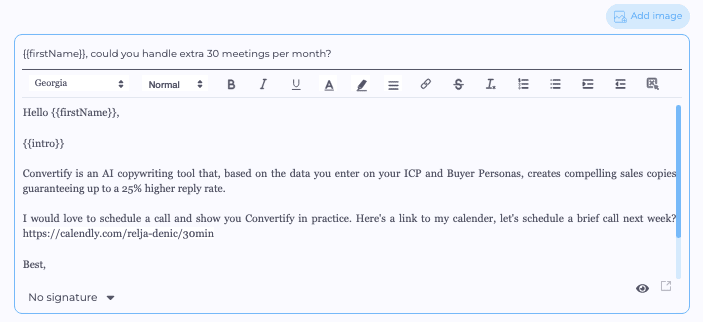
Each prospect will receive a combination of the personalized intro as in the csv file with the rest of the message.
Address the pain points
Your best pitch lies in proving that your product/service solves your prospects' pain points most quickly and directly. Make that clear in your sales messages, from the intro to CTA.
Connect on a human level
However, addressing the pain points doesn't mean selling repeatedly. Keep in mind that your prospects are humans and that you should always try to connect on a human level. Sales reps who genuinely show that they care and want to help their potential customers improve their businesses have higher conversion rates.
Build relationships before selling
As part of social selling, cold outreach is all about building relationships with prospects. People are more likely to buy products from people they trust and with whom they feel comfortable opening up.
Don't quit - follow up
Don't give up after the first try. Decision-makers to whom you're trying to get are busy. They receive numerous LinkedIn connection requests and cold emails and, believe it or not, often forget to reply. So sending a follow-up email is always a good choice.
Qualify your prospects
Qualifying a prospect means determining whether or not someone interested in your product/service is a good fit for it. Therefore, a qualified prospect is a potential client whose pain points your product/service solves in the most direct way. By qualifying your prospects, you will have higher customer lifetime value while lowering churn rates.
A/B test your cold outreach
One cold outreach template won't fit all prospects. That's why it's smart to A/B test message templates of all kinds. A/B test is a randomized experimentation process where two or more versions are sent to different target users simultaneously to determine which one makes results and influences the desirable business action. It's the only way to know what really works for your target prospects.
Automate your cold outreach
It's 2026, and we're far past manual outreach. Sales engagement tools progressed and are now an indispensable part of any sales, marketing, and recruiting process. Skylead, for example, optimizes your time by finding the fastest way to your prospects, makes sure your cold emails land directly in your prospect's inbox, which positively affects your deliverability, gives you real-time reports and campaign status, and supports all sorts of integrations with CRMs (i.e., Hubspot, Salesflare, Zoho) newsletter tools, databases, etc. through Zapier and API.
What is a good cold email
A good cold email must show that the sender has thoroughly researched the recipient (prospect) and their company to understand their needs, desires, and pain points. Furthermore, it also includes a concrete and straight-to-the-point explanation of how your product/service can help improve a specific aspect of their business.
The characteristics of a "good cold email" are the same for recruiters and candidates writing to hiring managers to search for job opportunities.
For example, if you're a recruiter reaching out to the ideal candidate, you should show that you've researched that person and why you consider them the right fit for the position. The "spray and pray" approach doesn't work, not it makes your company look good.
The same goes another way around. If you're a candidate searching for an opportunity, make sure you've done thorough research on a specific company's product/service. Even if you're an expert in your field, the hiring manager is less likely to consider you if they notice you don't particularly care about the company itself and that you just go and apply for random jobs.
Cold outreach email template
Now, let's look at some proven cold email formulas (and cold email templates) that increase your reply rates and generate results.
The most basic structure of cold emails, whether a first email or a follow-up, consists of an email subject line, email body copy, call-to-action (CTA), and email signature.
As mentioned above, the email open rate majorly depends on your email subject line. Your response rates depend on how well you researched your recipients, hence, how relevant your offer is to their company. Also, if you included links or hyperlinked words, ensure the anchor words are attractive enough (but not misleading) to improve your click-through rate.
Here are some cold email formulas/templates.
The BAB (Before - After - Bridge) formula
Before - a paragraph on your prospect's pain point.
After - what your prospect's business looks like with a solution you're offering.
Bridge - how your prospect can get there.
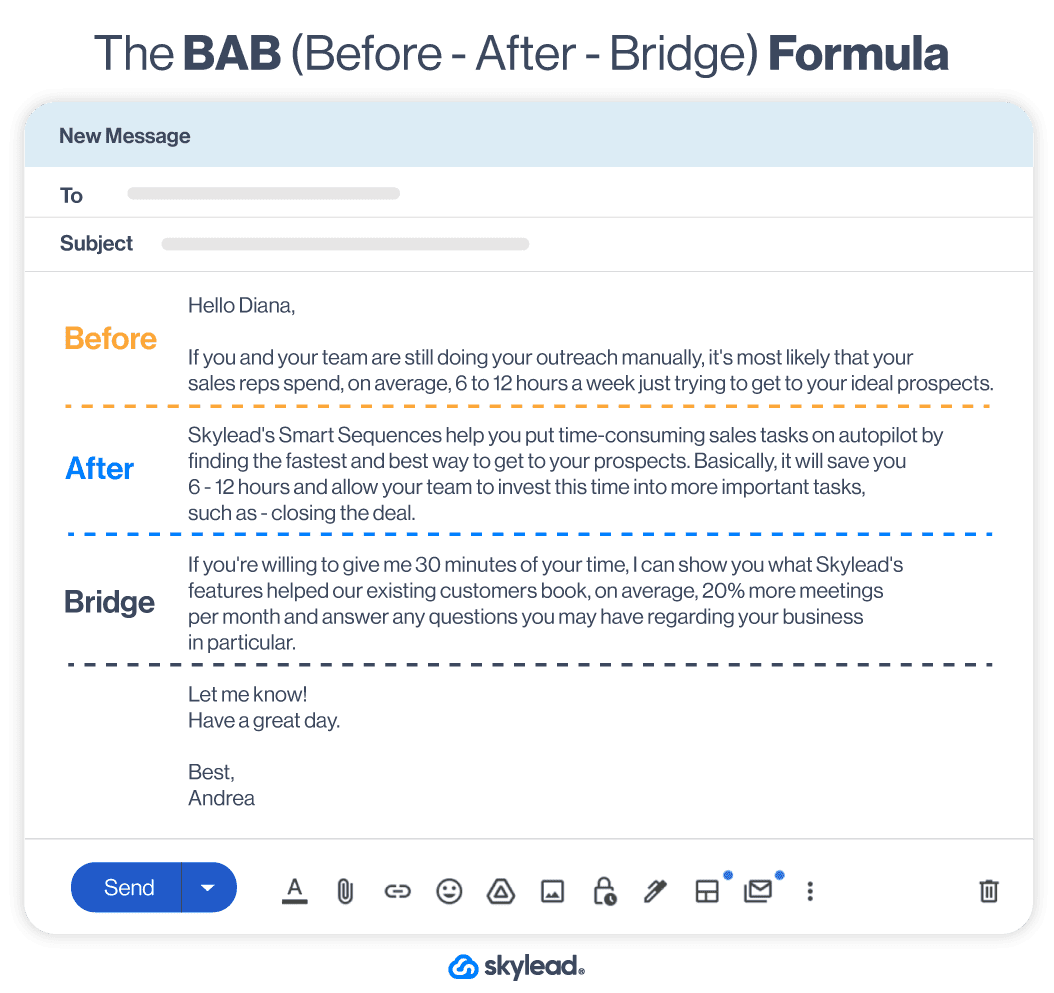
The PAS (Problem - Agitate - Solve) formula
The PAS formula is also known as "a pessimistic version of BAB". However, it works equally well in different situations. You have to evaluate which principle works better for you and your prospects, or you can always AB test them.
Problem - open your cold email with the problem your prospect's facing.
Agitate - emphasize the problem until it "hurts".
Solve - offer a solution to your prospect's problem.
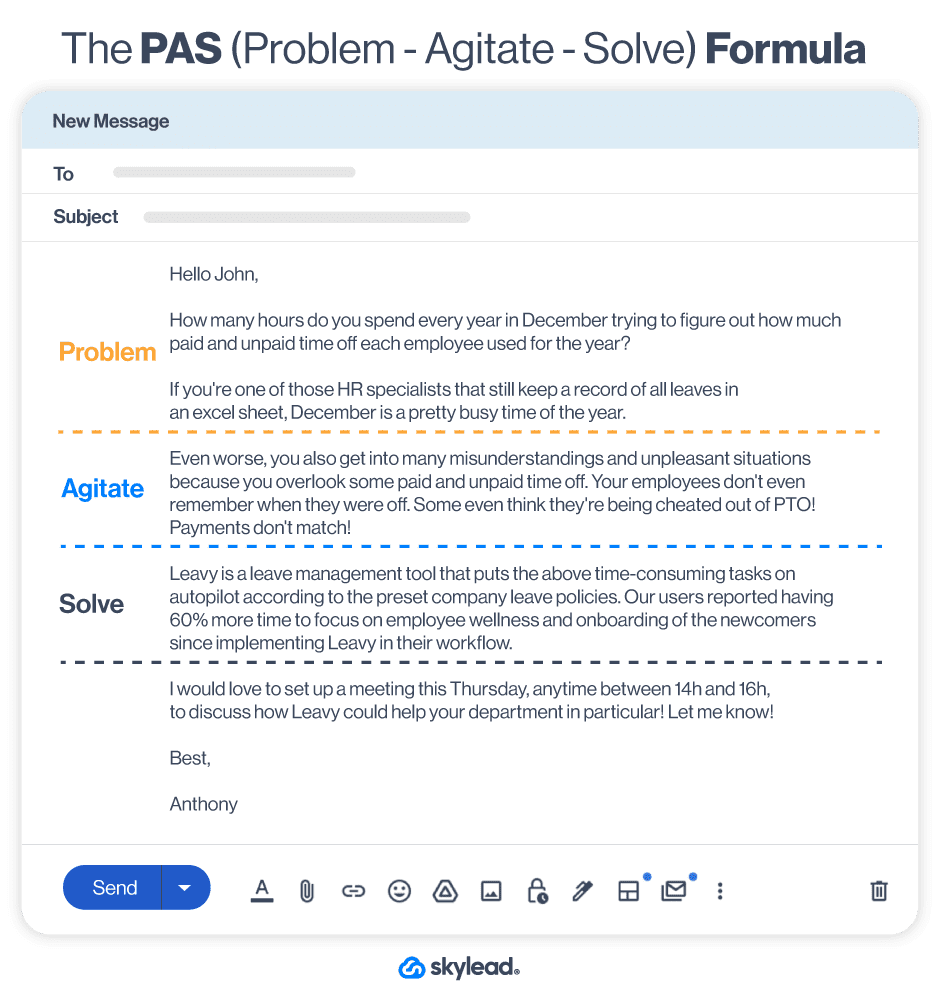
The SSS (Star - Story - Success) formula
Star - introduce the main character, that should be either your prospect or someone with whom your prospect can identify.
Story - tell a story about your character in which they face the same problem your prospect does.
Success - share how your character got out of the problem and offer the same solution to your prospect.
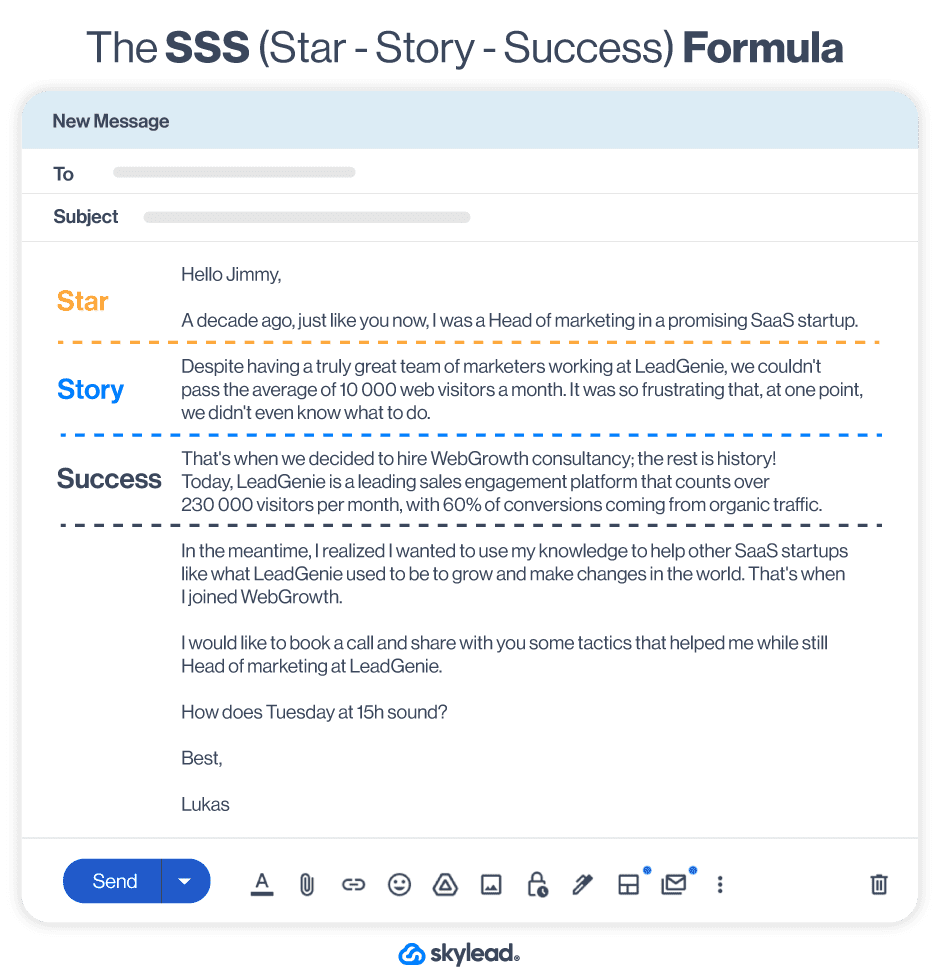
The ACCA (Awareness - Comprehension - Conviction - Action) formula
Awareness - show your prospect that you know what their pain point is.
Comprehension - explain how this pain point affects them, and tell them you have a solution.
Conviction - create a desire for the solution.
Action - call-to-action (CTA).
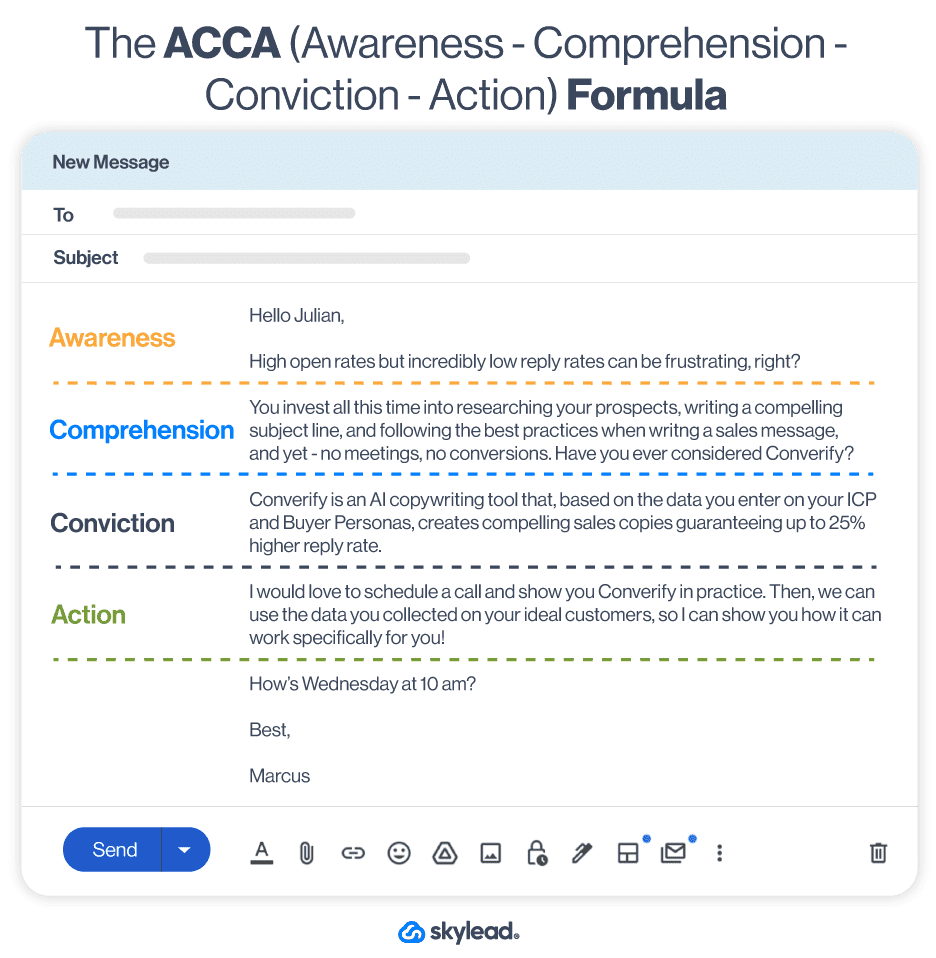
The AIDA (Attention - Interest - Desire - Action) formula
Attention — Grab the prospect's attention.
Interest — Make it personal to engage their interest.
Desire — Build desire for what you're offering.
Action — Ask for a response.
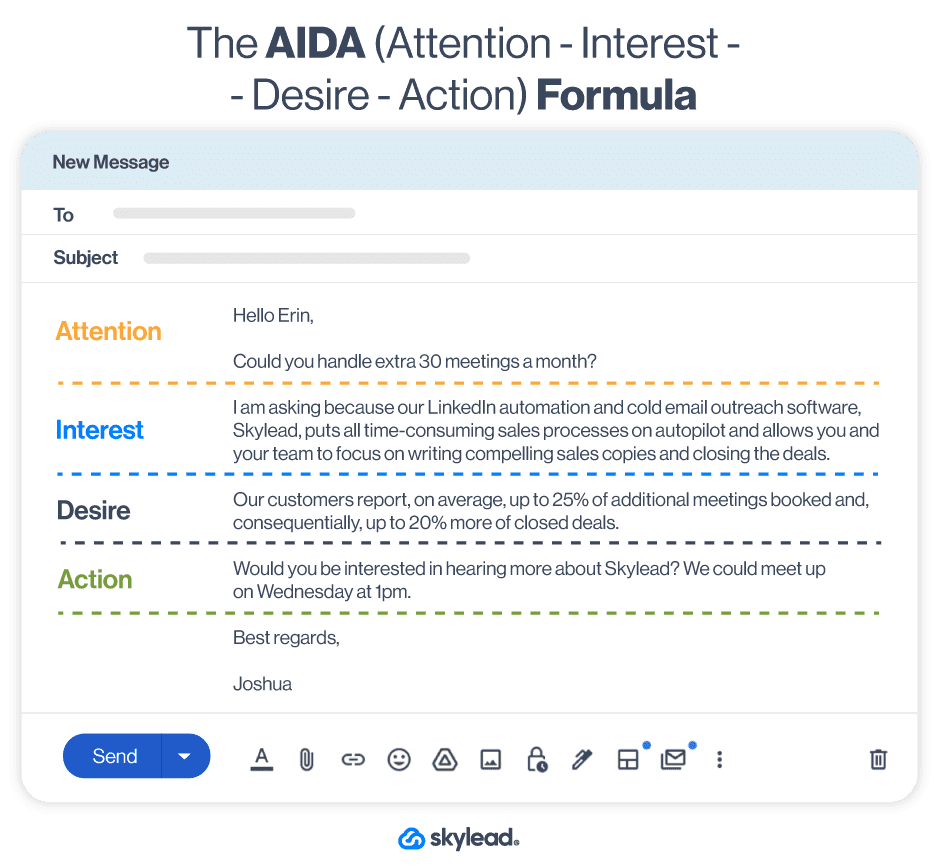
Also, remember to check out our ready-to-use follow-up email after no response templates, as well as the most common email mistakes and the most effective email calls-to-action (CTAs) for higher response and conversion rates.
Best cold email outreach subject line
Whether a first or a follow-up email, your email subject line is crucial for your open rates.
Subject lines should be compelling but not misleading. If you used tricks to get your email opened, and the subject line doesn't reflect the email body, don't expect your prospect to reply. People generally get angry when misled and are less likely to open your follow-up emails, too.
Here are email subject line guidelines, best practices, and over 107 subject line examples that you can use immediately or draw inspiration from.
LinkedIn outreach templates
In simple words, LinkedIn outreach implies using the platform to connect and nurture professional relationships with the goal of selling your product/service to those members that would benefit from it the most.
For this purpose, LinkedIn offers different types of messaging, such as connection requests for better acceptance rates, regular messages for members of your network, LinkedIn InMails for busy decision-makers, and 3rd-degree connections.
From this point of view, LinkedIn outreach is different from cold email outreach for classifying members based on your connection level, whereas you can send a cold email to pretty much anyone whose email address you have. However, LinkedIn as a platform offers other benefits, such as networking opportunities, significant insights into your prospect's professional achievements, pain points, and professional aspirations, etc.
You will find over 30 ready-to-use LinkedIn outreach templates in our resources LinkedIn connection message templates, sales messages for starting sales conversations, and LinkedIn InMails examples.
Frequently asked questions
How does cold outreach automation compare to manual outreach in terms of effectiveness and personalization?
Cold outreach automation can scale efforts and maintain consistency while keeping a deeper level of personalization, potentially increasing effectiveness by making recipients feel uniquely considered. While manual outreach can be personalized as well, automation is a preferred option because it saves so much time.
What are the ethical considerations or potential drawbacks of using cold outreach strategies, especially regarding unsolicited messages?
Ethical considerations in cold outreach include respecting privacy, avoiding spam, and ensuring messages provide value. Misuse can lead to negative brand perception and legal issues.
Can the effectiveness of cold outreach vary significantly between industries, and if so, how should strategies be adapted for different sectors?
Effectiveness of cold outreach can indeed vary across industries. Sectors with high digital engagement may respond better. Tailoring strategies to industry-specific preferences and pain points is crucial for relevance and effectiveness.
Is cold outreach effective?
If done right, cold outreach is a powerful prospecting tactic used by many salespeople for its high ROI, the possibility to reach potential clients from all over the world, and the ability to build long-lasting business relationships.
Why is cold outreach important?
Cold outreach can help you gain broader brand awareness and reach potential customers from all over the world. Furthermore, it's cost-effective and can be used for sales, marketing, recruiting, and job searches.
Is cold email legal?
You will not get into trouble if you use your prospects' business email addresses for cold email campaigns.
Can you cold email B2B?
Yes, B2B companies' sales teams use cold email outreach and LinkedIn outreach more often to accomplish their sales goals.
What is cold outreach in marketing?
Cold outreach in marketing is a form of outbound marketing that implies contacting prospects who could turn into your potential clients but don't know about your brand and have no previous experience with it. It could be done through email marketing, LinkedIn outreach, and cold calling.
What is cold lead generation?
Cold leads (referred to as "top of the funnel" leads) are those who are most likely not familiar with your product/service and haven't expressed interest in it. Cold lead generation is the process of gaining cold leads' attention, usually through LinkedIn (LinkedIn lead generation), cold emailing, and cold calling.
What is the difference between cold calling and prospecting?
Prospecting is the process of identifying and building relationships with potential customers who probably don't know about your product and haven't shown interest in it so far. Cold calling is one of the prospecting techniques which includes reaching out to potential customers via phone.
Is it better to cold call or email first?
It majorly depends on your sales outreach strategy. However, some outreach experts find cold emailing less invasive and advise starting by reaching out to your ideal customers in written form (cold emailing and/or LinkedIn outreach).
How long should a cold outreach email be?
Generally, shorter cold sales emails of around 50-200 words have higher response rates. However, the most important aspect of cold emails is that they are personalized and highly relevant to the recipients. Also, their subject lines must be catchy while reflecting the emails' topic.
Disclaimer: Skylead is not affiliated, endorsed by, or connected with LinkedIn in any way.
LinkedIn private mode or LinkedIn incognito mode is a LinkedIn feature that allows you to browse other people’s LinkedIn profiles without sharing any or some of your LinkedIn profile information with the owners of the profiles you’ve viewed.
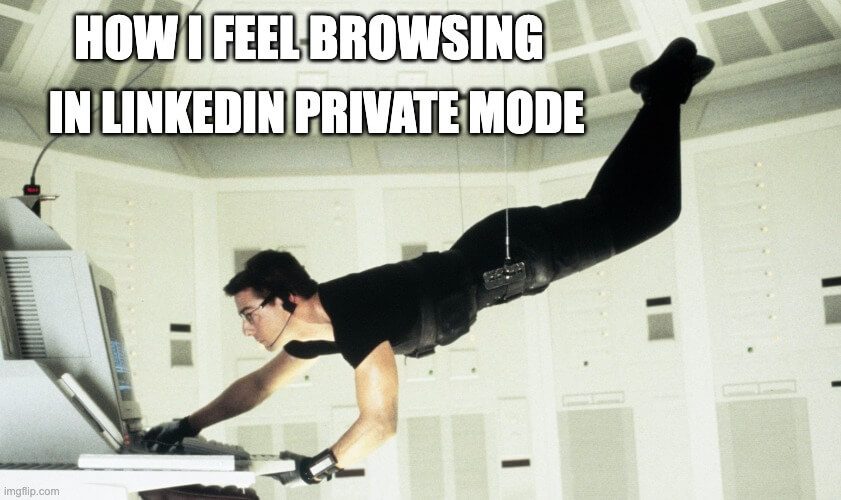
As you may already know (or not?), every time you visit someone’s profile, LinkedIn notifies the profile’s owner via the Who’s Viewed Your Profile feature, providing an opportunity to check you out on LinkedIn.
So, suppose you don’t want people whose profiles you’re viewing to know you took a sneak peek at their professional activities.
In that case, the platform allows you to go incognito partially (LinkedIn semi-private mode) or completely (LinkedIn private mode).
LinkedIn incognito mode is available to ALL members, independent of their LinkedIn subscription type.
Therefore, continue reading if you wish to know the following:
- What LinkedIn private mode is;
- How to make your LinkedIn private;
- Ways to customize your private mode on LinkedIn;
- How to know if someone else viewed your profile in the incognito mode;
- A few lesser-known hacks on LinkedIn private mode, and much more.
Ready?
Let’s get started!
[Mission Impossible Theme Song Playing]
What is a LinkedIn private mode?
LinkedIn private mode or LinkedIn incognito mode is a LinkedIn feature that allows you to browse other people’s LinkedIn profiles without sharing any or some of your LinkedIn profile information with the owners of the profiles you’ve browsed.
There are 3 visibility modes on LinkedIn according to the platform’s Visibility settings:
- LinkedIn public mode (or ‘Name and headline’) shows your picture, full name, headline, geographical location, and industry to people whose profiles you’ve viewed.
- Semi-private mode shows specific profile information, such as - either only the company you work at or your job position and the company you work at.
- (Full) private mode doesn’t show any profile information.
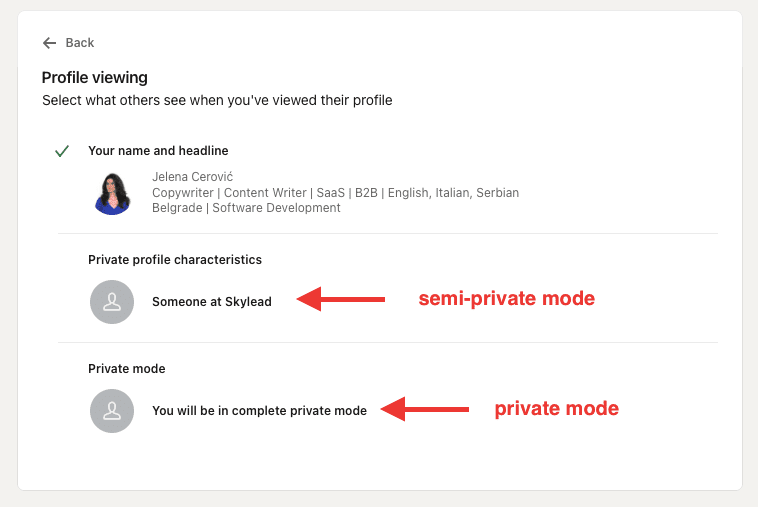
Do I have to pay for LinkedIn incognito mode?
LinkedIn private mode is available to ALL LinkedIn subscribers free of charge.
However, if you have a free (basic) LinkedIn plan, switching to private or semi-private mode will turn off the Who’s viewed your profile feature and erase your viewer history.
We’ve tested it ourselves, and we can confirm you will lose all previously collected data and can only see who's viewed your profile after switching to one of the private modes on LinkedIn.
Once you turn off the LinkedIn incognito mode, the feature Who’s viewed your profile will be back in a maximum of 24 hours and will show only those members who viewed your profile after turning off the private mode.
Also, you won’t be able to retrieve information on who’s viewed your profile during the time spent in private mode on LinkedIn.
On the other hand, all other users on paid LinkedIn plans such as - LinkedIn Careers or Business, any Sales Navigator plan, and any Recruiter plan will still be able to see these analytics and statistics despite keeping their profiles in private mode.
Furthermore, no LinkedIn plan subscriber, free or paid, can ever know the profile information of members browsing in private or semi-private modes on LinkedIn. Also, no LinkedIn plan subscriber can block or prevent other members from viewing in private or semi-private mode.
How do I view profiles in private mode on LinkedIn?
Here are 2 ways to switch from browsing in public to browsing in private mode on LinkedIn, whether you’re accessing your profile on a desktop or mobile.
Private Mode on Desktop
Click the Me icon in the top right corner, then choose Settings & Privacy.
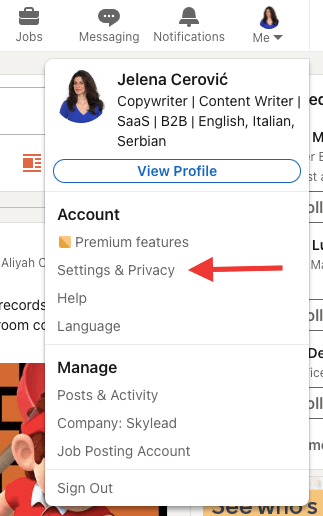
Then, choose Visibility on the left toolbar and click on Profile viewing options.
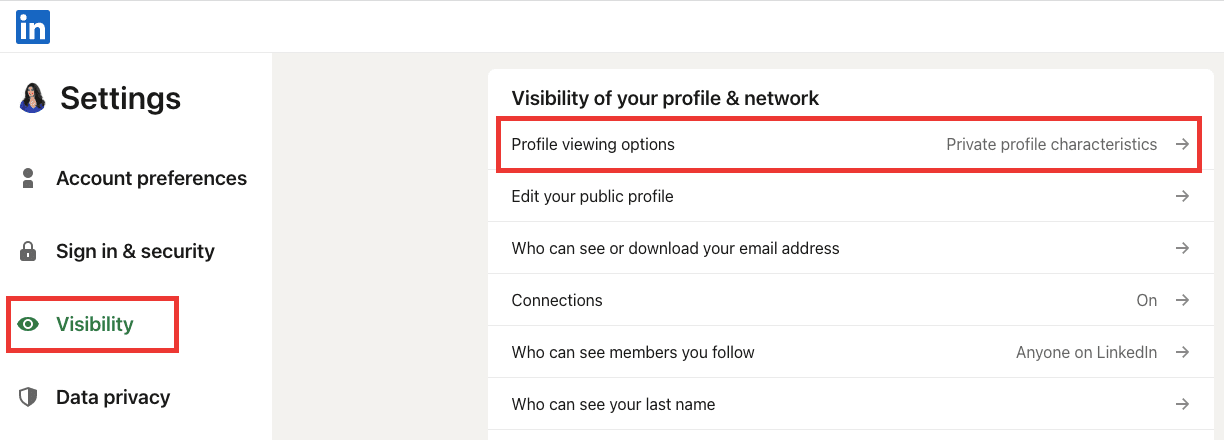
Finally, choose among the 3 visibility modes.
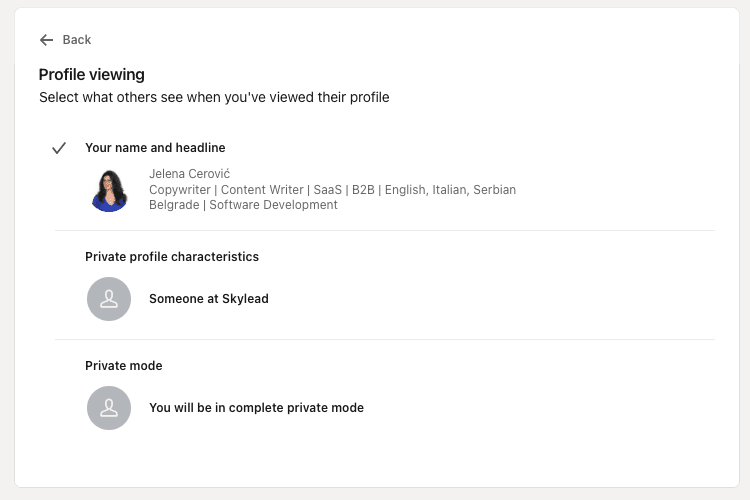
Private mode on mobile
Open your LinkedIn app, and click on your picture in the upper left corner.
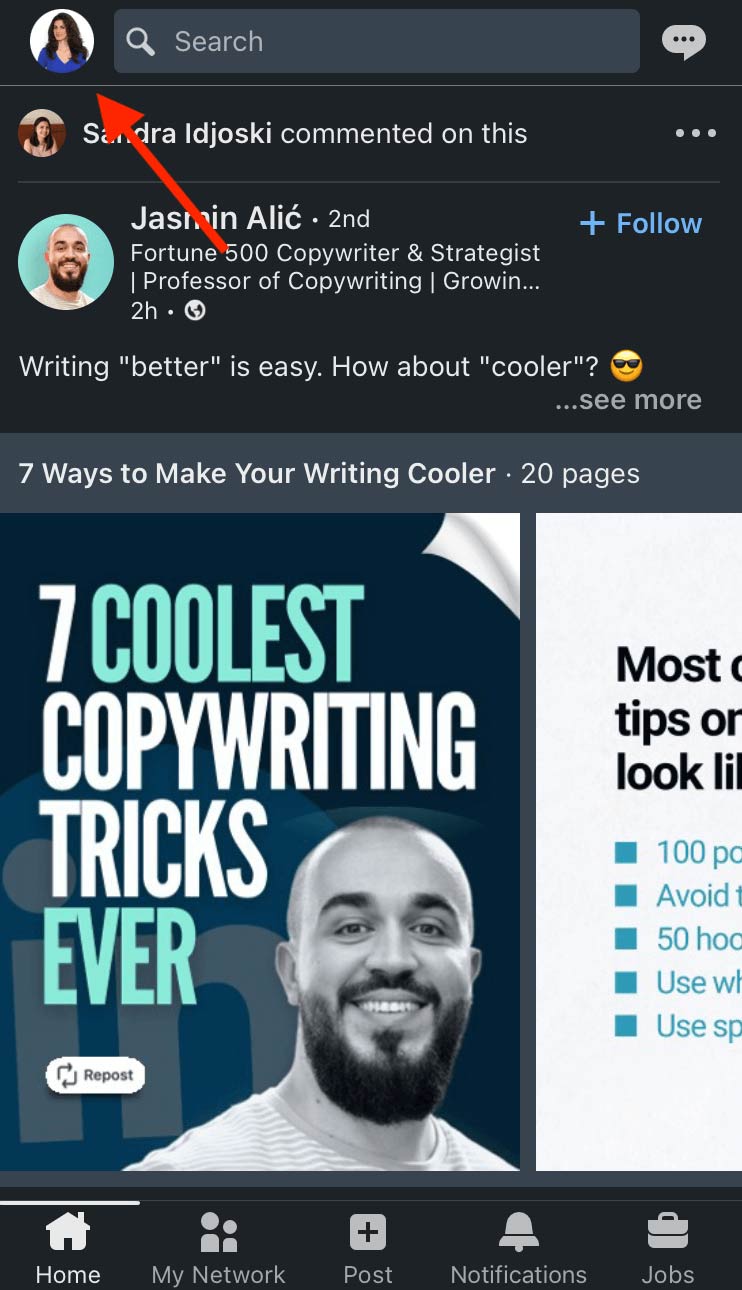
Then, choose Settings.
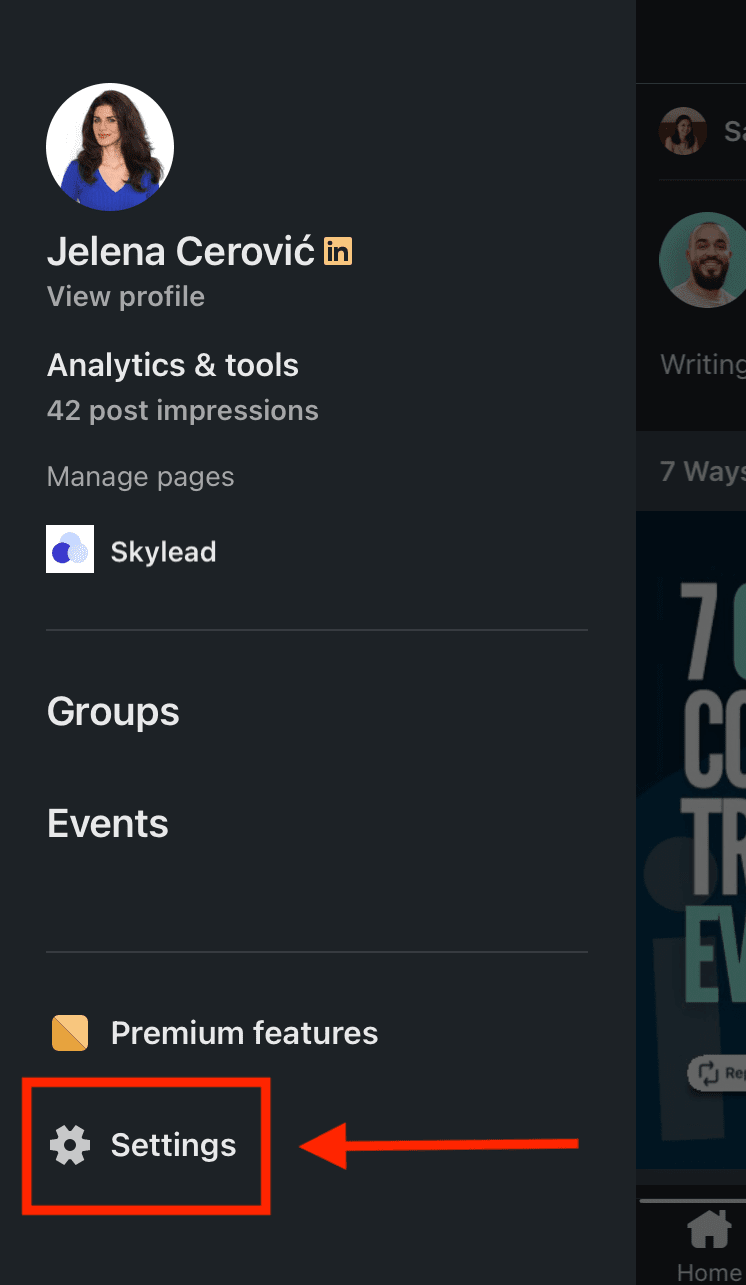
Click Visibility.
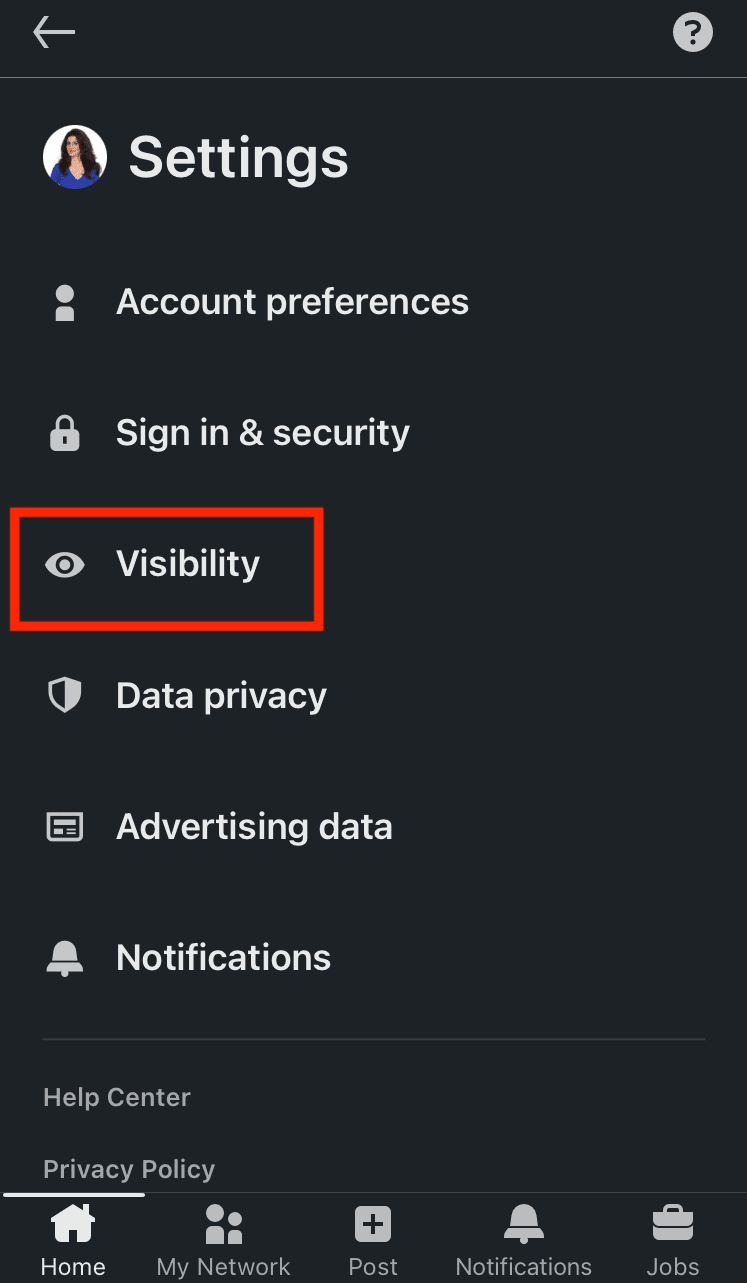
Then, choose Profile viewing options.
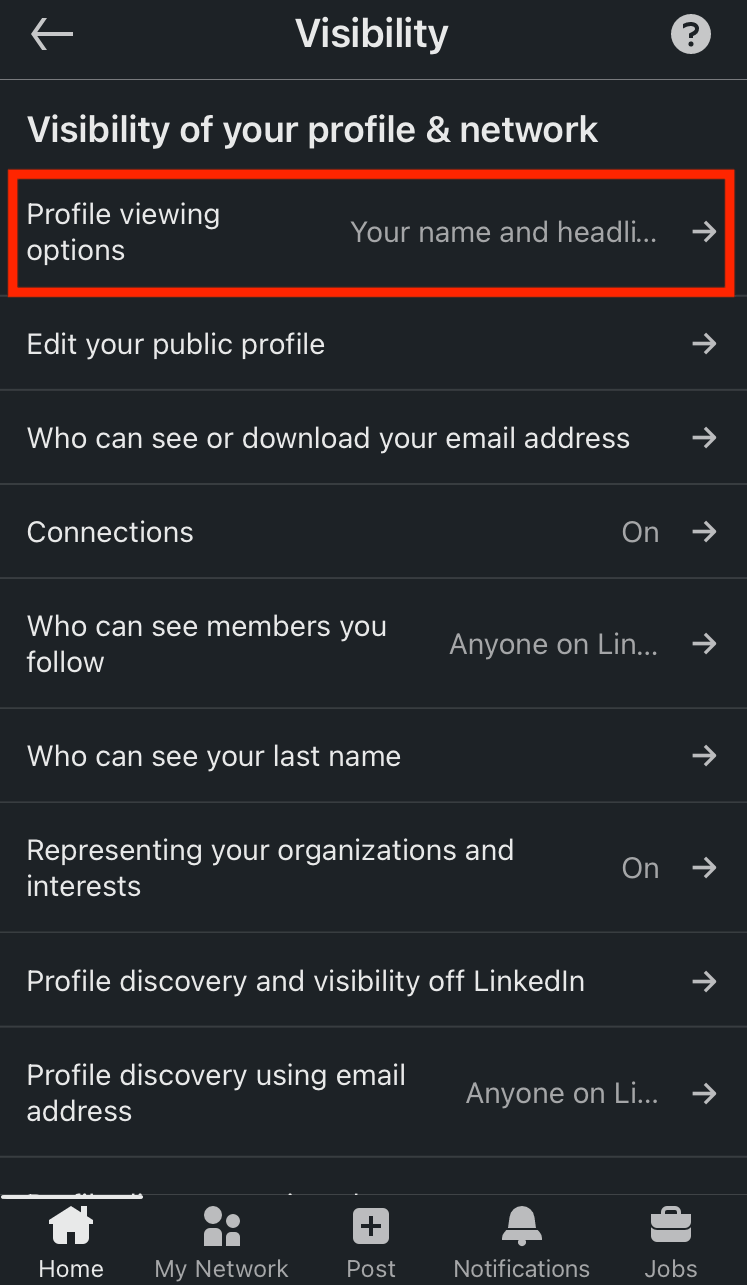
Choose in which mode you wish to browse other members on LinkedIn.
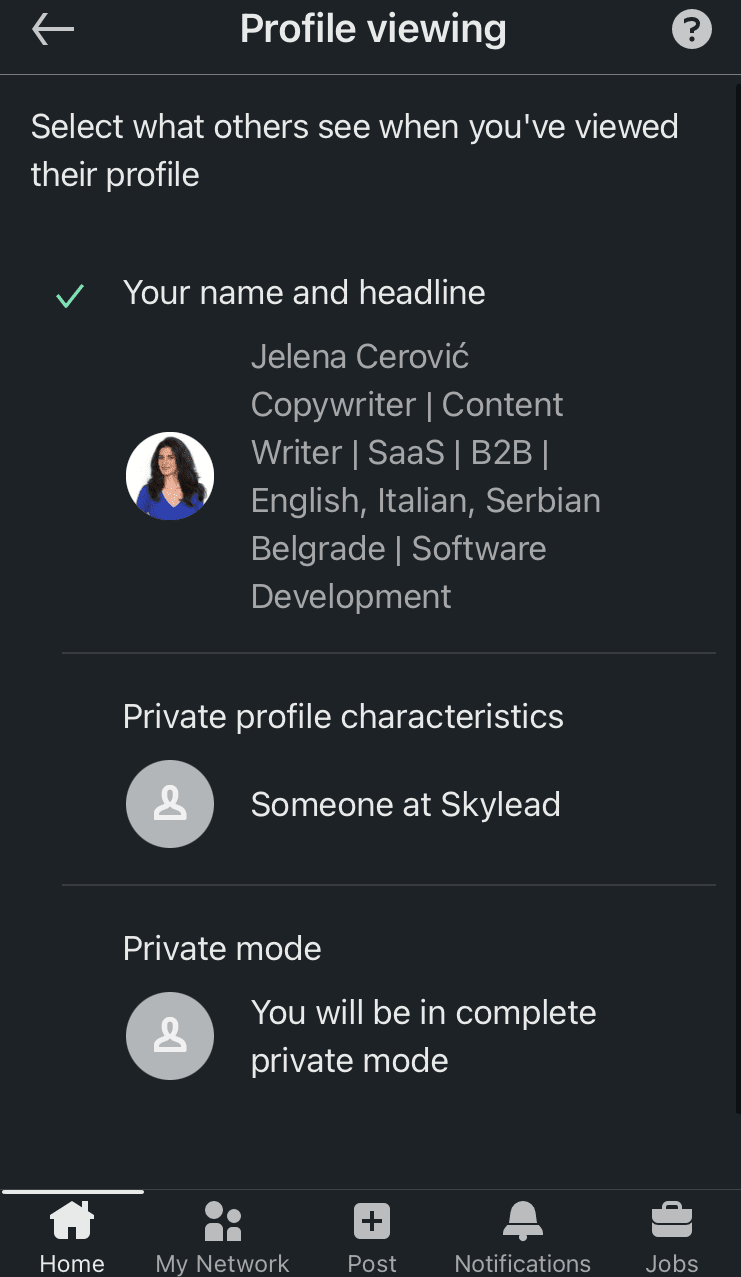
How do I customize my public mode on LinkedIn?
If you decide to browse in public mode on LinkedIn, you can still determine what information to make available to members not part of your network.
As you may already know, LinkedIn profiles rank on Google (and other search engines) based on the keywords used on your LinkedIn profile, such as name, profession, LinkedIn URL, LinkedIn headline, summary, etc.
Therefore, this option is advantageous if you don't want everyone to access your LinkedIn profile or wish to keep specific information to your 1st-degree connections only.
Go to Settings & Privacy.
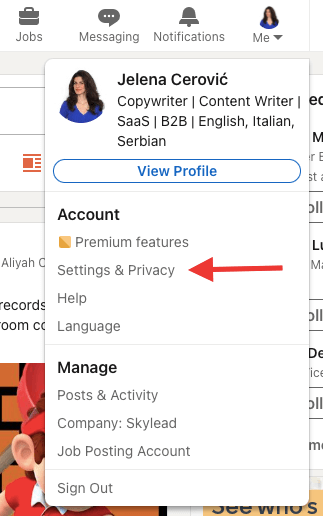
Go to Visibility, and then choose Edit public profile.
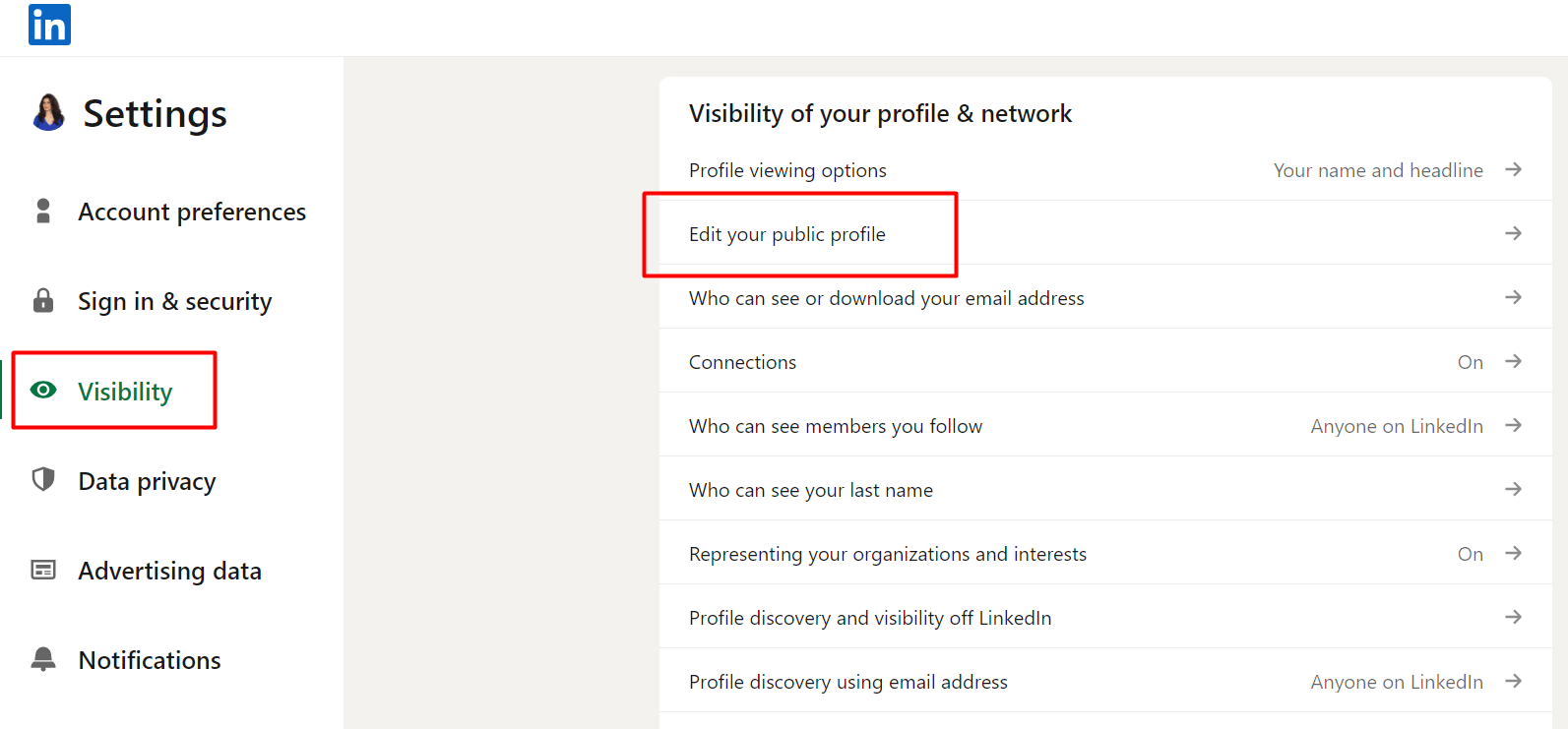
Scroll down the right sidebar and move the toggle buttons depending on what parts of your profile you wish to make available to anyone on LinkedIn and which ones should be reserved for your 1st-degree connections only.
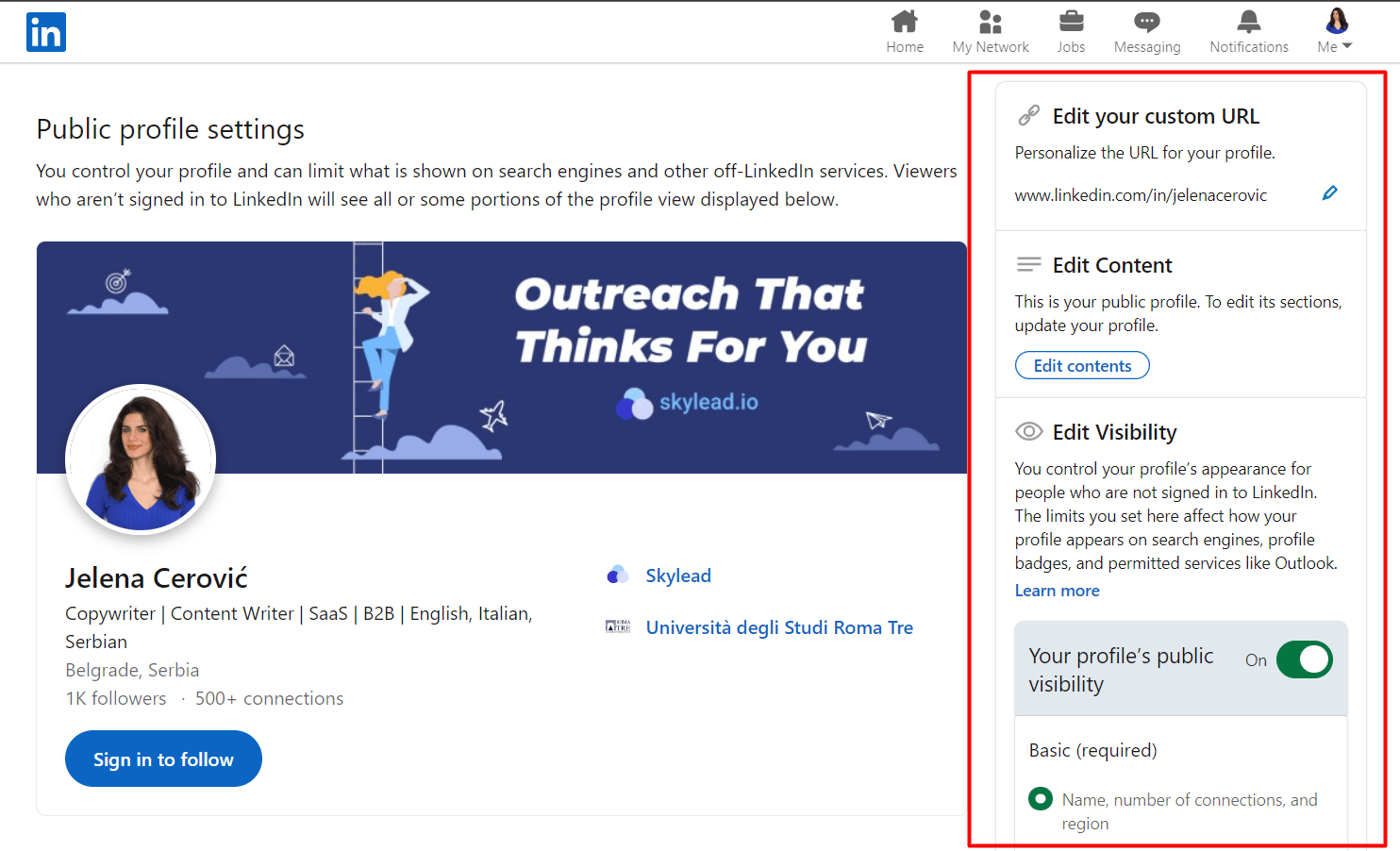
How do I know if someone viewed my LinkedIn in private mode?
LinkedIn subscribers get a notification each time someone views their profile.
If a member views your profile in semi-private or private mode on LinkedIn, it will appear in your notifications just like other alerts here (picture below).
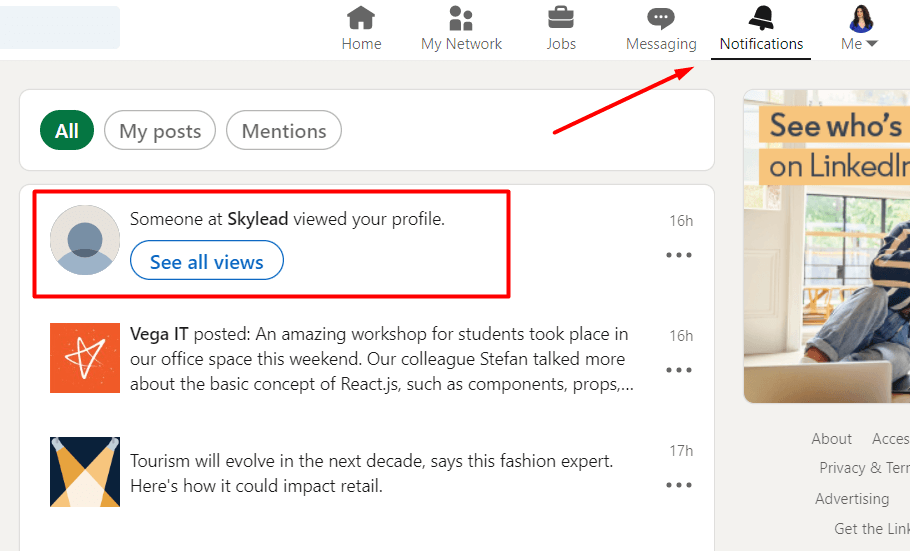
If you click on See all views right below the notification, it will take you to the Who’s viewed my profile LinkedIn page with the list of all viewers in the past 90 days, statistics, and additional filters.
Here are a few examples of what a notification regarding members browsing in semi-private mode on LinkedIn looks like.


Here are a few examples of what a notification about members browsing in private mode on LinkedIn looks like.


As you may have noticed, there’s a Search button next to members viewing your profile in semi-private mode.

Clicking on it will take you to LinkedIn search results of all people who work in that company and have LinkedIn profiles.
However, Recruiter subscribers don’t have the Who’s viewed your profile feature on their Recruiter pages. They must go to their LinkedIn profiles to check these types of notifications.
Sales Navigator subscribers will not see these notifications in the All alerts section because this is a purposely focused section that notifies about saved leads, saved accounts, and unsaved leads from saved accounts.
Sales Navigator subscribers can click on the profile picture in the top right corner of their Sales Navigator home page and choose Who’s viewed your profile.
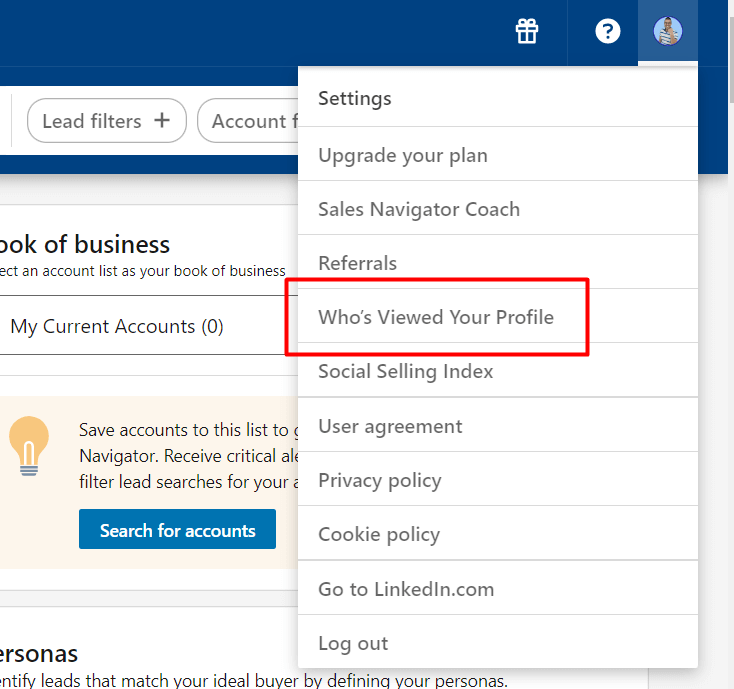
This action will take them to the LinkedIn statistics page.
When should I use LinkedIn private mode?
From our experience, it’s better not to keep your profile in private mode when browsing on LinkedIn.
Why?
By viewing other people’s profiles, you are showing some kind of interest - whether for LinkedIn lead generation, finding ideal candidates for a company position, expanding your network, showing an interest in a job opening by viewing the hiring manager’s profile, etc.
Also, viewing someone's profile on LinkedIn can help you connect with them faster and even bypass LinkedIn weekly invitation limits.
However, there are a few scenarios in which keeping your profile in LinkedIn incognito mode makes sense.
#1 You’re researching your competitors.
This one is pretty straightforward.
If you want to see what your competitors are up to, what they are posting on LinkedIn, or to scrape their network, you should keep your profile in private mode.
However, it’s not just competitors.
You may wish to check something on your former employer’s profile, former or current customer, or anyone else to whom you don’t want to reveal your profile information.
#2 You still need to optimize your profile.
Here, you have 2 scenarios.
Scenario 1 implies you wish to browse relatively random profiles to identify good practices to optimize your profile.
These members are not necessarily the ones you wish to connect with on LinkedIn or relevant to your business, but they've done an excellent job earning the all-star status.
Scenario 2 implies you wish to browse people who are relevant to why you joined LinkedIn, but you don’t want them to know because your profile is still not optimized.
If they check you out, they might lose interest or ignore your LinkedIn connection request because incomplete profiles on LinkedIn seem scammy.
#3 You’re a recruiter shortlisting candidates.
If you don't want all potential candidates to think they are being considered for a job opening at your company, you can view their profiles using LinkedIn incognito mode.
That way, you will avoid people not matching the requirements approaching you on LinkedIn and not get someone's hopes up.
LinkedIn Incognito Mode FAQ
Is private mode on LinkedIn really private?
Yes, LinkedIn private mode is really private. The platform cares about keeping its members' privacy, and there is no way to see members' profile information browsing in private mode on LinkedIn. Also, no member can block or prevent other members from viewing in private mode.
Should I be private or public on LinkedIn?
Staying private or going public on LinkedIn will depend majorly on your goal on the platform. It’s better not to keep your profile in incognito mode because showing interest in other members’ profiles can help you connect with them and even bypass LinkedIn weekly connection limits.
LinkedIn private mode vs. private profile on LinkedIn
LinkedIn private mode or LinkedIn incognito mode lets you browse other LinkedIn members' profiles anonymously. On the other hand, when you set your LinkedIn profile to 'private profile status, ' it means no one can find you on the platform or in any search results (e.g., Google search results).
How do I stay private on LinkedIn (private profile status)?
To switch your profile to private profile status and not even appear in the platform’s search results at all, go to Settings & Privacy > Visibility > Edit your public profile > Your profile’s public visibility (push the toggle button to the left in the right rail).
Does LinkedIn show who viewed your profile?
Yes, LinkedIn notifies members who have viewed their profiles. However, if you set your profile to browse in incognito mode, members whose profiles you’ve viewed won’t be able to see your profile information partially or at all, depending on the visibility mode of your choice.
Do I have to pay for LinkedIn private mode?
No, LinkedIn’s semi-private and private modes are FREE of charge and available to all members. However, when free LinkedIn members switch to private mode, they lose access to the Who’s viewed my profile in the past 90 days feature, unlike paid LinkedIn members who can still see these statistics.
Why would someone use private mode on LinkedIn?
Reasons to use private mode are infinite, but members usually browse LinkedIn in incognito mode if they are researching their competitors, checking out former or current customers or employers, shortlisting candidates for open positions, or don't feel their LinkedIn profiles are optimized enough to reveal their identity.
Who can see my private LinkedIn profile?
A private profile on LinkedIn means that you've set your entire profile to 'private profile status' and that it won't appear in LinkedIn or any other search results (e.g., Google search results). If your LinkedIn is set to private, no one can find your profile on the platform or online.
Can people see if I viewed their LinkedIn?
Unless you are browsing in semi-private or private mode on LinkedIn, other LinkedIn members will get notified once you’ve viewed their profile and can check out your LinkedIn profile to see who you are.
Can LinkedIn Pro see private viewers?
LinkedIn cares very much about keeping the privacy of those members who browse in semi-private or private mode on LinkedIn, and there is no way to see their profile information, no matter what LinkedIn subscription plan you have. Also, you cannot prevent anyone from browsing your profile in incognito mode.
What is the disadvantage of private mode on LinkedIn?
If you have a free LinkedIn plan and switch to private mode, it will turn off the Who's viewed your profile feature and erase your viewer history. You will lose all previously collected data and can only see who's viewed your profile after switching to incognito mode.
Why do people browse in private mode on LinkedIn?
People usually use the private mode on LinkedIn to research their competitors, check out former or current customers, former employers or employees, shortlist candidates for open positions, or simply because their LinkedIn profiles are incomplete and they don’t want to reveal their identity yet.
Can to hide your profile on LinkedIn?
You can either choose to browse in semi-private or private mode on LinkedIn, or you can switch your profile to private profile status and not even appear in the platform or other search engines' search results at all.
How can I view someone on LinkedIn without them knowing?
You can view someone’s profile on LinkedIn without them knowing by browsing in semi-private or private mode on LinkedIn. To turn one of these 2 modes on, go to Settings & Privacy > Visibility > Profile viewing options > Choose between Private profile characteristics (semi-private) and Private mode (fully private).
To Sum Up
While it's true that LinkedIn's private mode offers privacy, it can also compromise the transparency vital for building trust and credibility — the core of LinkedIn's purpose.
Balancing privacy and transparency is crucial for maximizing LinkedIn's effectiveness in lead generation.
And, speaking of lead generation, take Skylead for a spin for 7 days for free, and see how this sales engagement tool can help you generate more opportunities and grow your pipeline.
Disclaimer: Skylead is not affiliated, endorsed by, or connected with LinkedIn in any way.
Did you know that LinkedIn lead generation is one of the most vital activities for the sales departments of B2B companies?
“Why?” you ask.
Well, because LinkedIn is the #1 social media for generating leads. Its lead conversion rates are 3x higher than any other major social media platform. Moreover, LinkedIn alone generates 80% of B2B leads coming from all social media channels a company uses.
We can go on with the metrics, but you get the gist. LinkedIn is one of the best social media platforms for generating tons of qualified leads that convert successfully.
Sadly, many people do not take advantage of this social media platform. Or they do not have the desired results using LinkedIn lead generation and just give up.
So, in this complete guide, we will walk you through everything you need to know about LinkedIn lead generation. To be more precise, you will learn:
- What is LinkedIn lead generation;
- How to generate qualified leads on LinkedIn whether you are a marketer or a sales person;
- What you need to do before you even think about a LinkedIn lead generation;
- Top intent-based strategies to make your LinkedIn lead generation flow in with results and shorten the buying cycle;
- Answers to most frequently asked questions about LinkedIn lead generation.

What Is LinkedIn Lead Generation?
LinkedIn lead generation represents activities associated with identifying, gathering, and warming up potential clients on LinkedIn. Sales and marketing teams do so by using ads, forms, various tools, strategies, and outreach to generate qualified leads. It is an ongoing process that creates steady income for all B2B companies.
Why LinkedIn?
With the competitive market, generating high-quality leads has become somewhat of a challenge for B2B companies. Thus everyone needed to step up their lead generation efforts to stay relevant in the market.
That is where LinkedIn comes in. With 875 million members from 200+ countries, this #1 social media for professionals became a goldmine for B2B marketers and sales executives.
Due to a large pool of professionals, 4 out of 5 LinkedIn users drive certain business decisions. Hence this audience has 2x buying power of the average web audience. Therefore, LinkedIn has been recognized as a perfect place where companies can find ideal leads and offer a solution to their problems.
To make it easier for you to find the perfect lead, LinkedIn provides insights such as job titles, company they work in and its size, content they like and more. Moreover, this social media platform offers many ways sales and marketing teams can use to acquire qualified leads. So we will talk about all of them today.
How To Generate Leads From LinkedIn?
To generate high-quality leads on LinkedIn you need to perform different sales and marketing activities, leverage performance data, and improve. These activities include but are not limited to defining target audience, outreach, creating or sharing gated content, communicating benefits, and lead nurturing.
Depending on whether you are a salesperson or B2B marketer these activities may vary but do have the same goal. So let’s break them down and check out what is the main focus for each professional.
LinkedIn Marketing For Lead Generation
LinkedIn marketing is a form of digital marketing where B2B marketers use LinkedIn to promote businesses, share content and generate leads. In most cases, marketing managers use LinkedIn to provide value and raise awareness through posting educational or gated content on the company page, thus generating more leads.
In other words, marketers use LinkedIn to:
- Provide value through posting educational and engaging content on the company’s LinkedIn page;
- Raise awareness about the product/service by creating and sharing case studies or specialized landing pages;
- Grow following and increase engagement with target audience;
- Create gated content and share it on LinkedIn with benefits and call-to-action for the said content;
- Optimize LinkedIn page and content for SEO;
- Host and share an online event ( webinars, hangouts, etc).
As a part of their marketing strategy, some content marketers even become influencers or thought leaders themselves. This way, digital marketing managers can expand their network and have an additional channel to share their content.
The previously-mentioned activities are heavily based on organic content marketing. However, as a part of LinkedIn marketing, you can get paid traffic, engagement or generate leads by publishing sponsored content, aka ad campaigns.
LinkedIn Ads
Digital marketers often publish sponsored content through the LinkedIn campaign manager as part of lead generation efforts. They do so by specifying their target audience with certain demographics or other parameters and presenting them with the purposeful ad they create.
For example, they can create an ad campaign with a call-to-action button to visit a landing page with gated content. The target audience then goes to a landing page and leaves contact information.
For those who don’t know, gated content is digital material, such as educational videos, ebooks, or other documents that request users to fill out a contact form before they can download or access them. This is one of the classic ways marketers use to generate leads.
Therefore, to get their lead gen forms to a wider audience and gather potential customers for their sales team, digital marketers can opt-in for sponsored content on LinkedIn as a part of their marketing strategy.
What does this mean in terms of activities? Well, marketers can use LinkedIn campaign manager to:
- Raise awareness about their business or product;
- Boost content engagement;
- Launch lead generation campaign (LinkedIn lead gen forms or landing page promotion);
- Or message your potential customer directly through ads.
They say a visual is worth more than a thousand words, so here is how sharing gated content or launching a lead generation campaign works in real life.

Even though LinkedIn ads are a part of overall LinkedIn marketing, they are not mandatory for LinkedIn lead generation, as you can do certain things organically. However, they can be immensely beneficial if you wish to go all in.
That said, here is what all LinkedIn marketing activities would look like in a funnel.
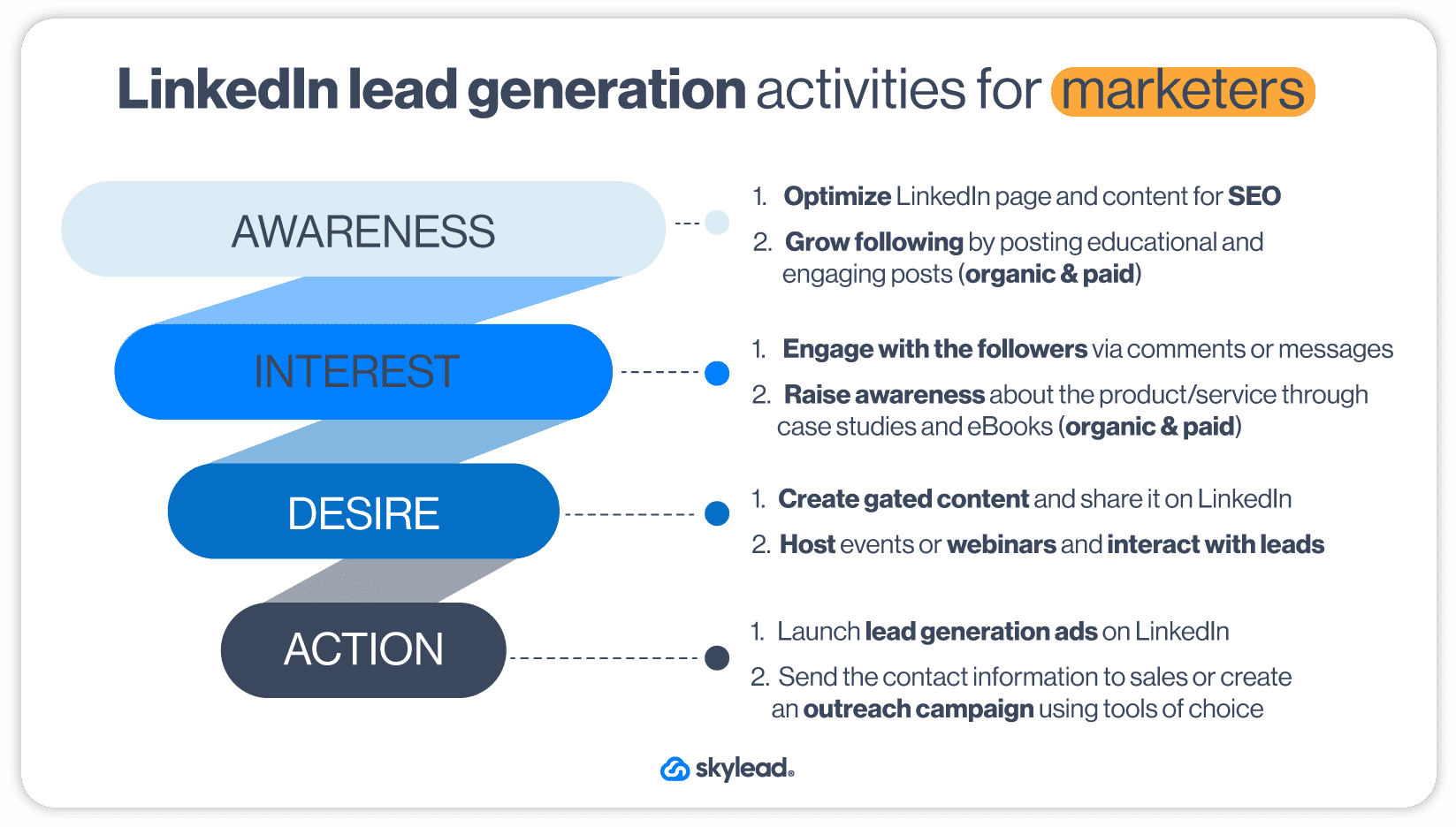
Using LinkedIn Outreach For Lead Generation
LinkedIn outreach signifies contacting and warming up potential customers on LinkedIn. It is the next step in the lead generation process, once salespeople finish with LinkedIn prospecting or after the marketing team acquires contact information through gated content. LinkedIn is the preferred social media for outreach due to communication simplicity.
Salespeople can outreach two types of leads to generate and qualify them: inbound or outbound leads. Inbound leads are the ones who have already interacted with your company (e.g. gave their information due to lead generation strategy or contacted via chat). On the other hand, sales professionals outreach outbound leads by themselves after finding them via prospecting.
Outreach on LinkedIn is definitely a long and separate subject on its own. However, there are definitely a couple of main principles we must mention for the sake of this article.
LinkedIn Outreach Principles
Firstly, LinkedIn outreach is the main part of the social selling strategy, and one of the main components of any successful sales engagement process. In other words, it focuses on building relationships, offering a solution to problems, and nurturing leads throughout the buying journey.
For example, you will usually find sales professionals starting the conversation on LinkedIn by asking about the lead's workflow. Or they will offer educational content or case studies long before they pitch their product or service.
Secondly, LinkedIn outreach is about quality, not quantity. So make sure to find and outreach the right people according to your ICP or Buyer Persona.
Lastly, as marketing can retarget website visitors, salespeople can use retargeting of their own. To clarify, they can reach out to people they already had contact with in some shape or form and didn’t convert. The outreach message can be a simple follow up to catch up after a while or a full product update, depending on where they left off the conversation.
With that in mind, here is a funnel with all the activities that sales people go through regarding LinkedIn lead generation.
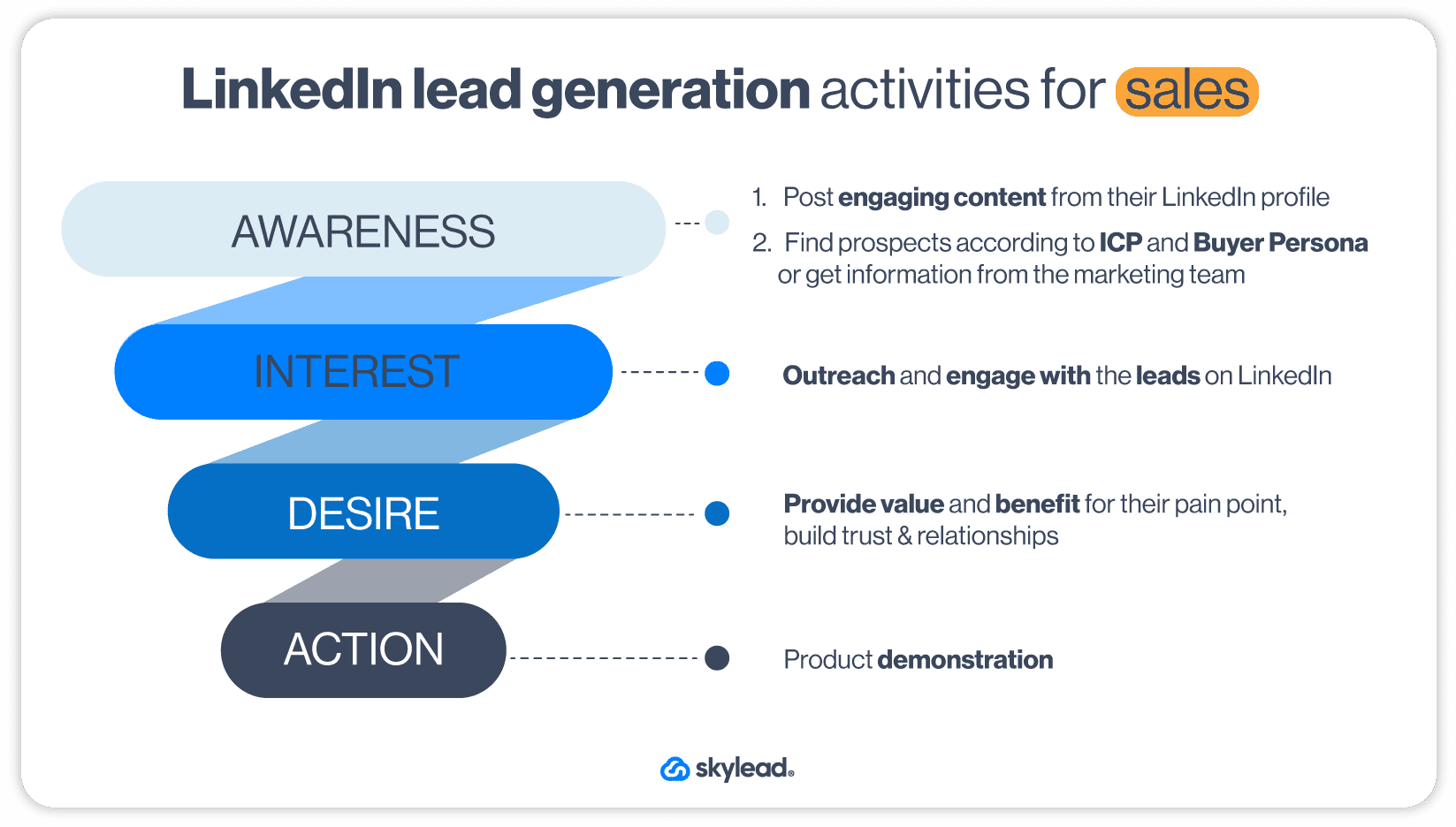
What Do You Need to Do Before LinkedIn Lead Generation?
As previously stated, LinkedIn lead generation is undoubtedly the main focus for B2B companies. However, you can’t just dive right into LinkedIn lead generation without first establishing the basics.
If you do, you will generate a miserable number of leads and not the good ones either. The reason for such an outcome is poor LinkedIn lead generation basic steps, strategy, targeting, and outreach method. Luckily we will cover everything below.
Are you ready? We will start with what you need to do first.
Create Highly Converting LinkedIn Profile
Before you start any LinkedIn lead generation activity, you must improve your LinkedIn profile and optimize it for conversions. If you do it thoroughly, it will stand out from other profiles and attract more people to visit it.
For example, your LinkedIn URL optimized for SEO and the LinkedIn headline created to boost LinkedIn lead generation will get you more profile views. Even a profile and LinkedIn cover photo can get you 14x more profile views. More visits will result in a lot more connection requests and engagements.
Let’s take a look at this way. What profile photo captures your attention first in the following example?
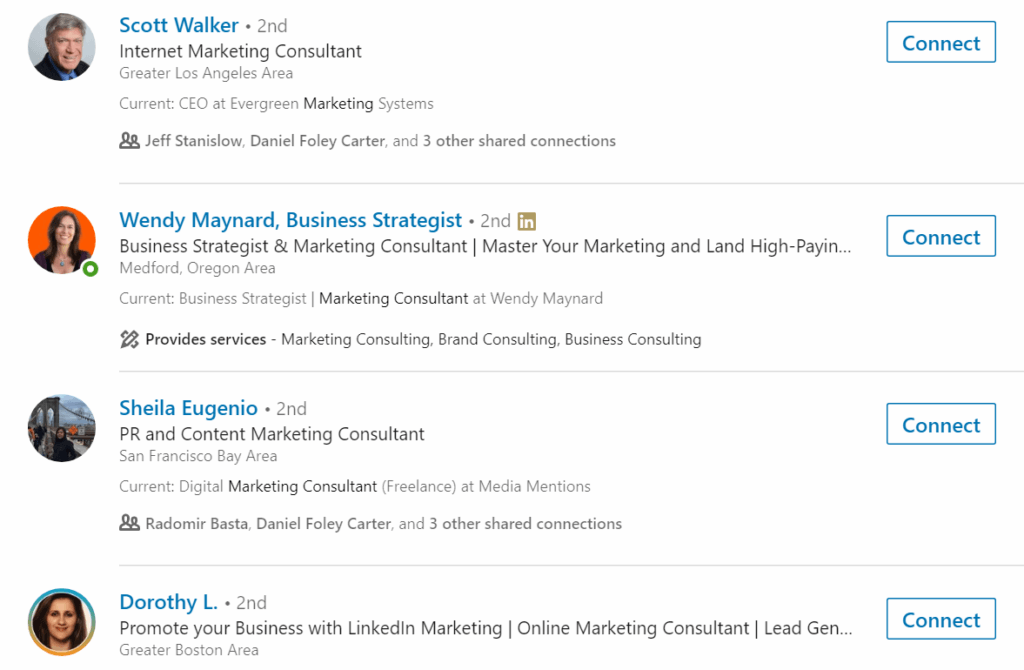
We would guess that your answer is the lady with the orange background.
The reason she captured your attention is the fact that she implemented steps that more than 80% of LinkedIn users don’t.
People are more prone to send you a connection request if they like your profile. Furthermore, they will accept your requests frequently. Thus, your success in generating new leads, acquiring new users, and even selling will increase significantly.
Marketers, this goes for the company’s LinkedIn page, as well. Set the high-quality logo as your profile picture, add a high-quality cover photo that mirrors your branding, and import as much info as possible. Lastly, don’t forget to optimize your LinkedIn public URL for SEO, as LinkedIn users and search engines will use it to find your page.
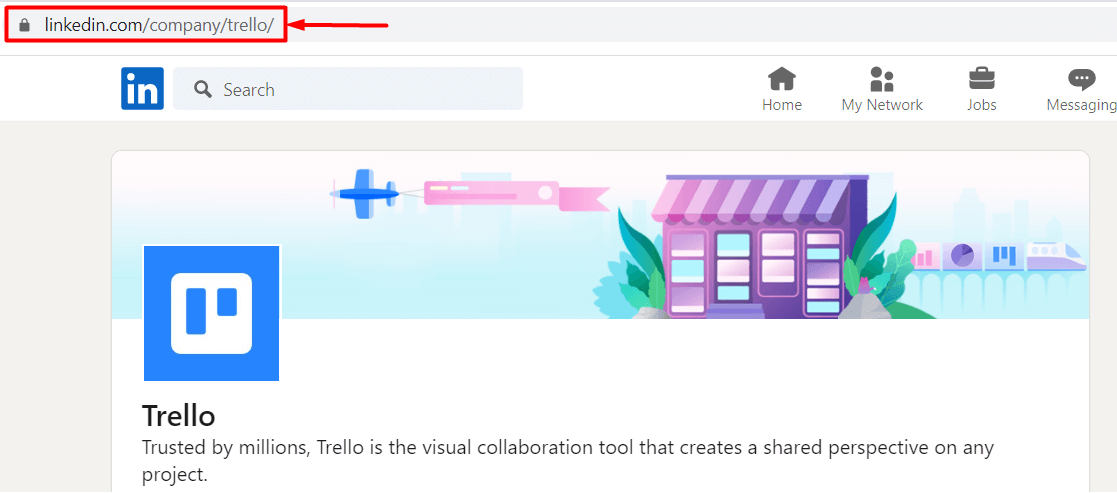
So, to stand our case, optimizing your profile will improve the conversion rate. Thus, it is one of the most important first steps to successful LinkedIn lead generation.
Define Your ICP And Buyer Persona For LinkedIn Lead Generation
Ideal Customer Profile and Buyer Persona are complementary documents that define your perfect customer and their company. In other words, they contain lead specification variables such as job title, the industry they work in, company size, or location.
You should create your ICP and Buyer Persona based on your current customer data. This way, these documents will contain what type of lead:
- Has the shortest buying cycle;
- Keeps high retention rate and LTV;
- Refer your product elsewhere.
If you do not define your ICP and Buyer Persona, you won’t be able to:
- Prepare your LinkedIn lead generation outreach message that converts;
- Generate high-quality leads;
- Or create thought-leadership content to appeal to your ideal potential customers.
In other words, you can’t do all these things because you don’t know who you are doing it for, to begin with. So be sure to define both to make your LinkedIn lead generation strategies more effective.
Become A Thought Leader
Here is an interesting fact for you. Did you know that many decision-makers, 54% of them to be more precise, claim they spend 1+ hour per week reading and reviewing thought-leadership content?
Being someone others follow to discover more about their position-related news is one of the essential activities of LinkedIn lead generation. Keep in mind that being a thought leader is a continuous process. Once you get started with it, you need to be consistent to grow your network.
The best hook for any thought leader is offering valuable and actionable content to your network. Moreover, you will have better engagement if you add proof of success, for example, the exact results you achieved.
By offering a lot of valuable content, you’re earning people’s trust and building the image of an expert in your field. This will help you gain influence status in your market and get tons of leads through your posts.
Whatsmore, you will connect with people on a much deeper level by being proactive and initiating different conversations based on your content.
How To Become Thought Leader?
Provide people with actionable steps to implement in their business. In addition, these steps should demonstrate your experience in improving your own or someone else’s business. Or, you could share stories about tools and strategies you used to get incredible results.
To clarify the previously stated, let’s go through an example.
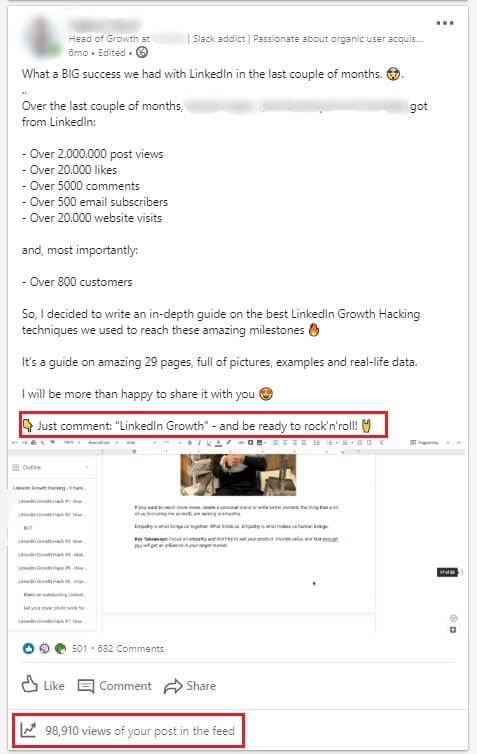
Why did this post work?
Firstly, the opening line promises a lot and entices readers to discover more about the story.
Secondly, the author showcases the astonishing results and what they could bring to anyone who follows the same steps.
Thirdly, by explaining how the content they share helped his company, the author provides the direct benefit and why people should read the document.
Lastly, they include an alluring CTA so people continue engaging with the post. Moreover, said CTA plays the main role in increasing this post’s tremendous reach (98,910 people).
How?
Well, this post uses the LinkedIn algorithm to its fullest potential. To clarify, when you publish a post, this is what the LinkedIn algorithm does:
- First, it shows your post to a small group of people called a test group;
- Secondly, if the test group engages with your post, LinkedIn starts showing your post to all your 1st-degree connections and their friends;
- Lastly, if the 2nd or 3rd-degree connections engage with it, it will appear in their network too.
That’s how the wider audience can see this post and engage with it.
What the author asks of people who want to see the guide, in this case, is to first engage with the post by commenting on it.
That’s why the post became viral. And not only did the post become viral, but it paved the way for network expansion and lead generation. All that from the post alone. Wow!
Build Your Network And Relationships On LinkedIn
Being a thought leader is all nice and fun. However, you won’t get far unless you use this social media for what it truly is for: building a network and nurturing real relationships with other members.
There is no workaround for this one. The only way to build a relationship with your network is to reach out and start a conversation with them (read between the lines - LinkedIn outreach). Talk about their work experience, and what they find most challenging or exchange tips. You can also have a digital coffee with them.
That said, establish a habit of finding new people to interact with each day. After all, from honest and good relationships, great customers are born. And that is Social Selling for you folks.
Understand Buying Signals When Doing LinkedIn Lead Generation
If we needed to label the urgency of what you should do before LinkedIn lead generation, this would be Very Urgent on our list. Why? Because marketing and sales change their approaches rapidly. So you must keep up with these changes to stay relevant in the market.
To be more precise, you need to be aware of this change called buying signals. It is the activity that leads perform to indicate buying intention for a specific product or a service. Or a buying signal can be an event that has taken place within the company that changed the company’s needs.
For example, a prospect can post about a service explaining their good or bad experience and demonstrate their (dis)satisfaction.
Content marketers and sales are already using buying signals to generate high-quality leads with specific intent because it is a way to faster and better conversion. Consequently, LinkedIn is no exception.
For example, marketing may notice a buying signal if visitors from LinkedIn go to several pages and end up on a pricing page in one session. Marketing then can post sponsored content on LinkedIn, retargeting those who ended up on a pricing page with another highly-converting landing page.
The sales team, on the other hand, can notice a person liking a case study they shared. After checking if the person has interacted with the business in some other way, they will outreach them on LinkedIn to connect or follow up on the said topic.
That is what is happening in sales and marketing at the moment. People are figuring out holistic high-intent and signal-based approaches, and you should be one of them. So if you plan to work on LinkedIn lead generation, first learn to detect these signals on LinkedIn and use them to their fullest potential.
Top LinkedIn Lead Generation Strategies To Generate More Leads in 2026
Do not worry if you are still unsure of buying intent and how to create your strategy based on it. We’ve got your back. Some of the LinkedIn lead generation strategies listed below will give you an idea of how to do the prospecting on LinkedIn to detect these signals, find them, influence them, and reach out to your leads at just the right moment.
1. Use LinkedIn Sales Navigator Search For Lead Generation
LinkedIn Sales Navigator, a platform for sales executives, is a the first method for B2B lead generation.
Apart from the leads they get from marketers, who use LinkedIn lead gen forms, sales executives can generate their own leads using Sales Navigator’s extensive list of filters.
Sales Navigator offers Lead filters to search for your Buyer Persona and Account filters if you wish to find your ICP.
However, amidst all the filters, we wish to highlight one in particular that every sales expert in SaaS or BaaS companies would like to see - the Technology used filter. This filter allows you to find people who use software similar to yours or even your competitor's products and reach out to them.
Simply go to your Sales Navigator Account filters and find Technology Used or search by keyword.
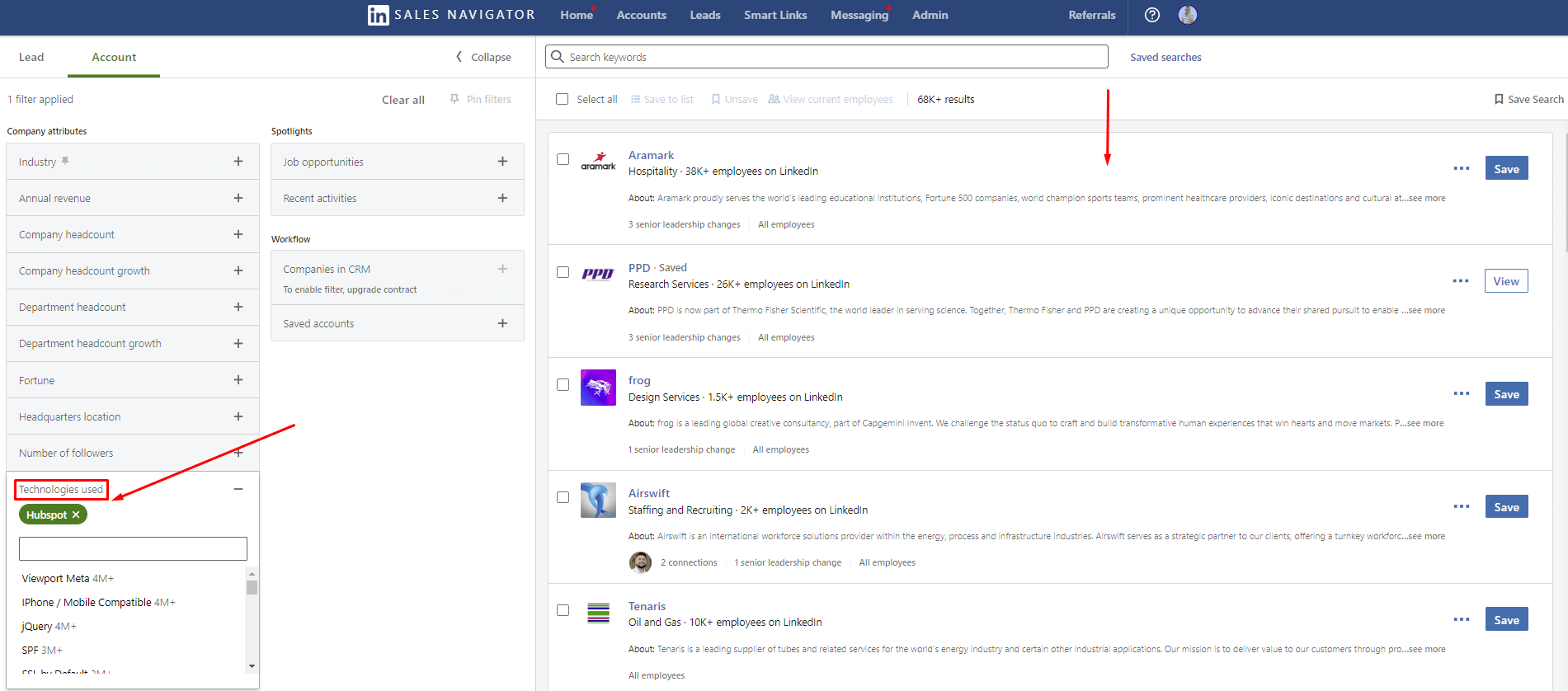
Once you do, go to that company page and find the decision-maker and reach out to them.
You can also send them gated content that will act like a LinkedIn lead gen form for your marketing team. They can use it to target the leads with other beneficial content. Whatsmore, you will raise awareness and establish contact with them without pushing them to buy, but rather pulling them towards your company.
2. Search According To Your ICP Or Buyer Persona
One of the well-established ways for B2B lead generation is to use the LinkedIn search filters to their fullest.
Dear sales teams, this is where your ICP and Buyer Persona come into play. If you read our guides, then you already know that each piece of information in these documents should be actionable.
Set the filters according to the documents using either LinkedIn Premium or Sales Navigator accounts to narrow your search. Once you do, copy the search URL. You are going to need it soon.
Trust us. By combining LinkedIn lead generation with your ICP or Buyer Persona, you will notice far better results than before since your leads will be more qualified.
3. Use LinkedIn InMail Templates For Lead Generation
LinkedIn InMails are direct and private messages you send or receive from a LinkedIn account that is not in your network.
InMails is a nifty feature for salespeople to use if they cannot get a hold of the lead using other methods (e.g. by sending a connection request). To clarify, once you send an InMail, the person will receive a notification as they would for regular messages.
If you are unsure what type of message to write to generate leads and get additional contact information via InMail, stop by our other blog and check out 13 LinkedIn InMail examples with a 25% response rate formula.
4. Job Posting Search
If a company publishes a job post, it usually means that they:
- Got funding for the department;
- Something is not right in the current process;
- Or a person from the team is leaving for some reason.
Whatever happened here, this is your chance to investigate and detect the buying signal.
In other words, this LinkedIn lead generation strategy focuses on job vacancy search, adding companies to a spreadsheet, and then finding decision-makers and reaching out to them.
Here is how you can generate leads by discovering specific job posts. For example, let’s say your company outsources sales specialists. To find these job posts, simply type that keyword in the LinkedIn search field. For example, you can search for a Sales Manager and use all filters to get as close to your ICP as possible.
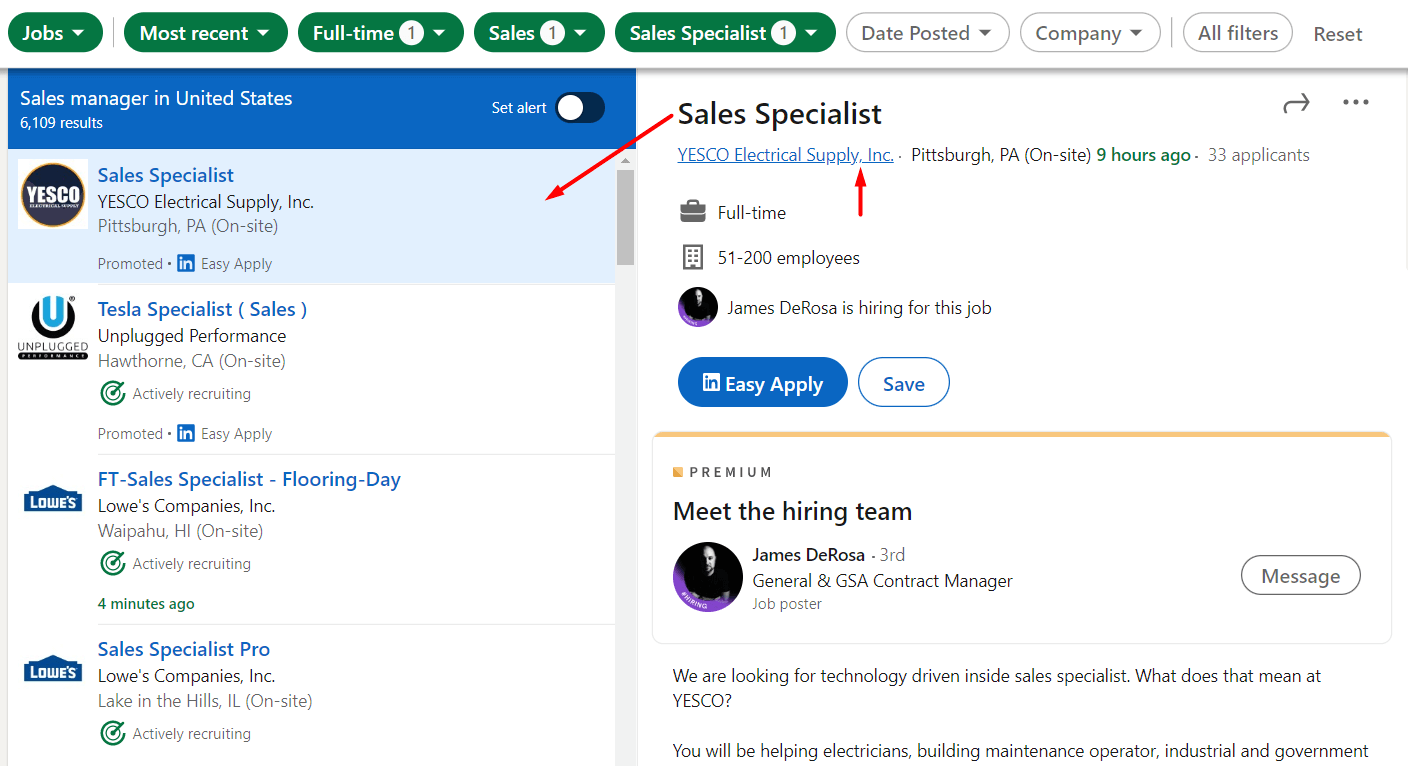
Once you find the desired company, go to their LinkedIn page and search for decision-makers within those companies. Lastly, write them down in your Personalization Spreadsheet so your outreach can later be more effective.
5. Team Up Sales And Marketing Efforts For Ultimate LinkedIn Lead Generation
We cannot talk about LinkedIn lead generation and miss mentioning the marketing and sales synergy. Today people research services of interest first before contacting sales or support. Thus, it became essential for marketers to cater to these research needs by creating content and working alongside the sales department to generate leads with personalized sponsored content.
On the other hand, salespeople are responsible for inbound contact and outbound activities. They do this through thought leadership, prospecting, and personal contact once the lead lands in the funnel.
Here is an example of how sales and marketing activities should be in synergy.
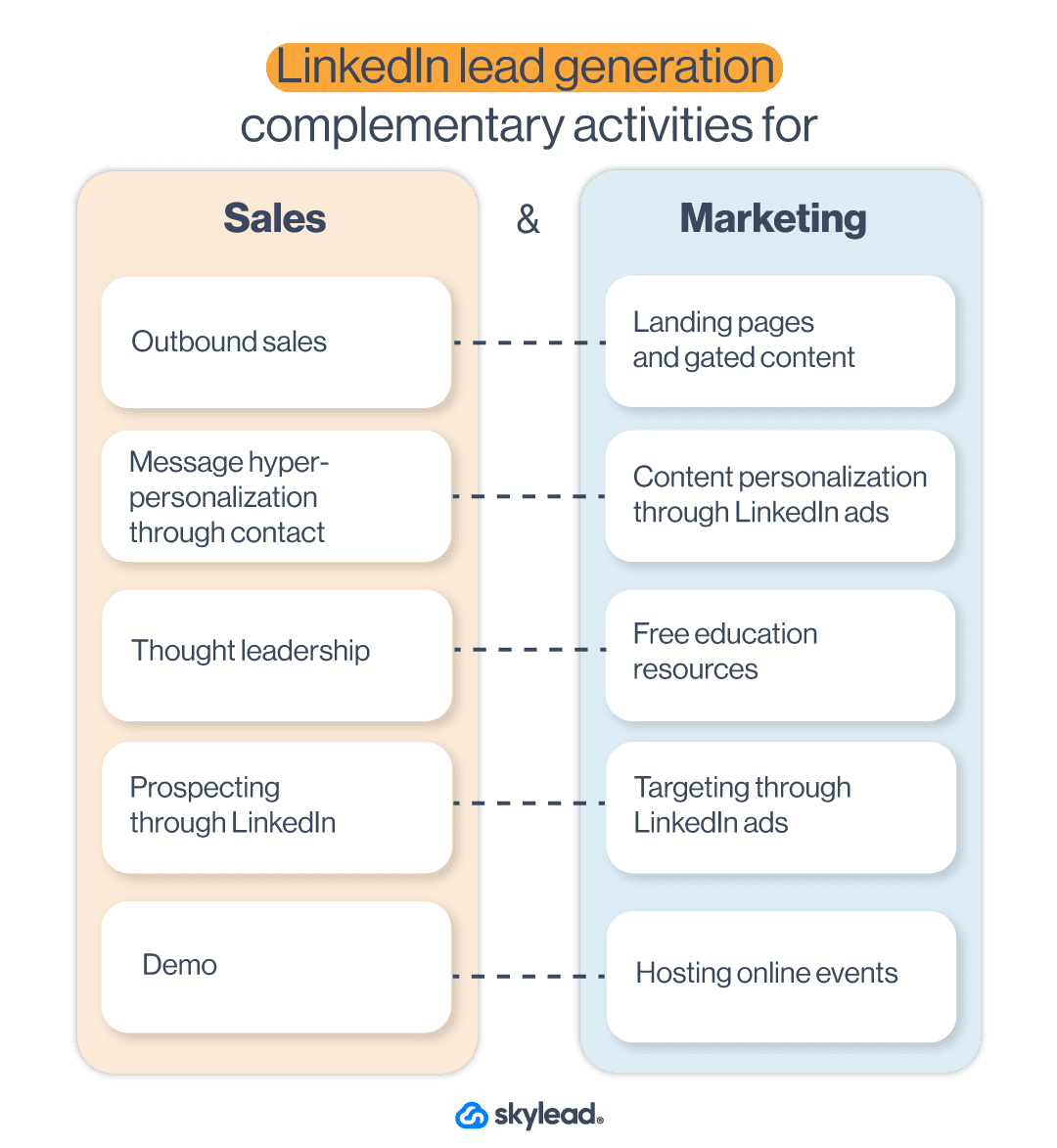
Thus, one of the main LinkedIn lead generation strategies should be aligning their activities on LinkedIn too. In other words, marketing and sales should:
- Communicate the same benefits and messaging;
- Create gated content;
- Serve personalized content on LinkedIn;
- Address immediate pain points and buying signals.
It is essential to align your sales and marketing teams since they are equally valuable. In other words, if the sales team targets the leads using buying signals, marketing should do the same as one of their activities. For example, if sales send the leads to a book-a-demo page, marketing can create a LinkedIn lead generation ad to target people who visited the demo page but didn’t convert.
Note: To reach the ultimate results using lead generation, the best-case practice is to extend your lead research beyond LinkedIn. In other words, discover other places to find B2B sales leads according to buying signals and trace them back to LinkedIn for outreach.
6. Check For Buying Impulses By Searching LinkedIn Hashtags
LinkedIn offers many holistic ways to generate leads. Thus, searching for the leads who shared their pain points or someone who wasn’t satisfied with your competitors via hashtags is one way to do it.
This strategy is perfect for zeroing in on the leads based on buying signals. However, it might need some time as it requires manual work.
All you need to do is type your competitor’s name to find dissatisfied customers, search for the hashtag. Or explore hashtags to find a person who asked for advice on their pain point.
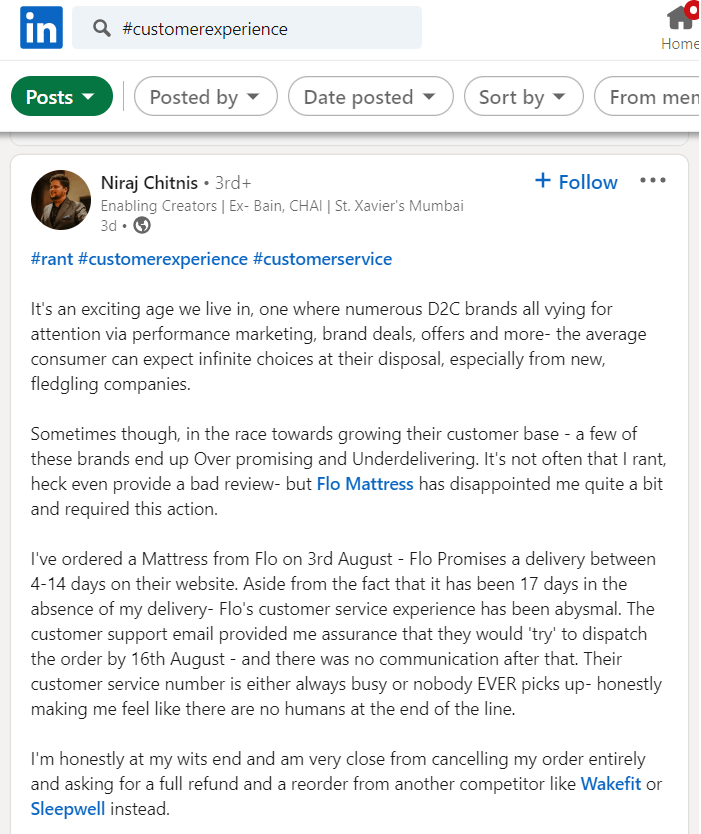
Once you do, write down everything you discover in your personalization spreadsheet. This way, you will gather all the information you need to personalize the message for the outreach.
7. Combing Through LinkedIn Groups
You can also find the leads by searching through LinkedIn groups - the themed places for professionals of all caliber to share their thoughts and experiences or ask questions about the group topic in one place.
Unfortunately, post-engagement-wise, LinkedIn groups are dead. However, that doesn’t mean that your leads aren’t there or their content. In other words, these groups still hold a place for LinkedIn accounts that joined the group in the first place. So go ahead and find the groups your Buyer Persona would be in. Join those groups and leverage them for LinkedIn lead generation by reaching out to its members or finding a post that demonstrates buying signal or intent.
For example, if your target group is marketers, you can search the group by keyword and find your ideal leads.
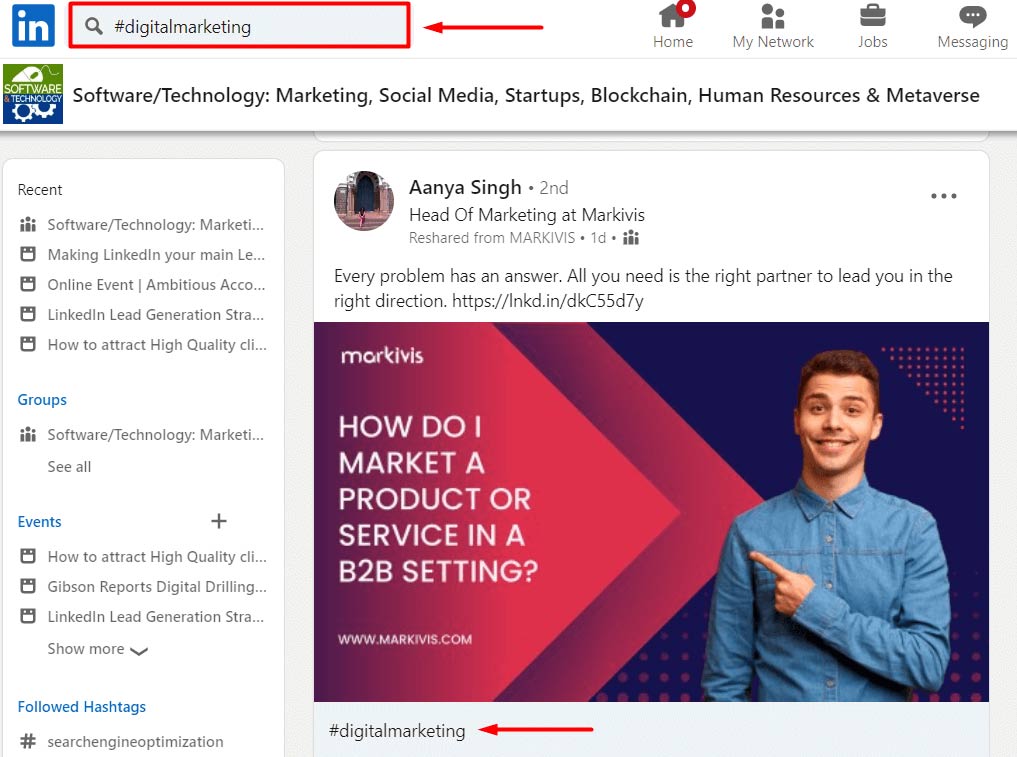
From there, you can invite them to connect with you by writing a message such as this:
Hey Aanya, I’ve seen your interesting posts on the right partnership in digital marketing in the Software/Technology group. So I’m reaching out in hope to connect with you on that topic.
8. LinkedIn Lead Generation Strategy That Includes Targeting Posts
One way to jump over gatekeepers and reach decision-makers directly is to find content that appeals to them. Let’s take a look at the following post, for example.
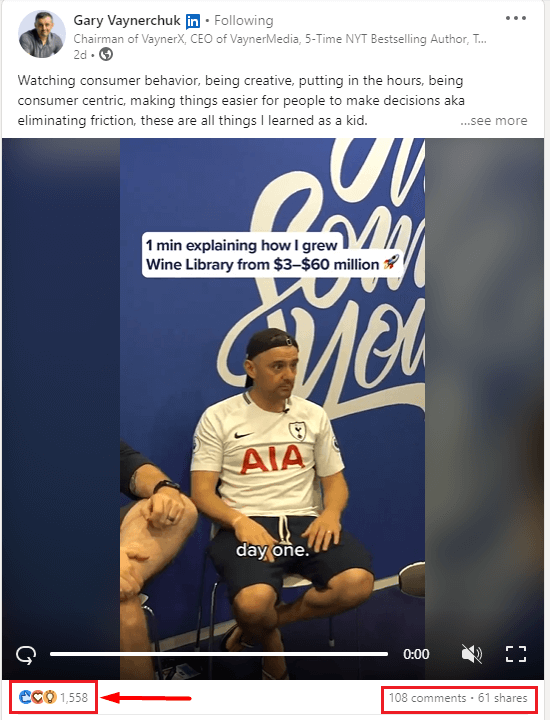
If you click the reactions or comments, you will for sure find some decision-makers out there.
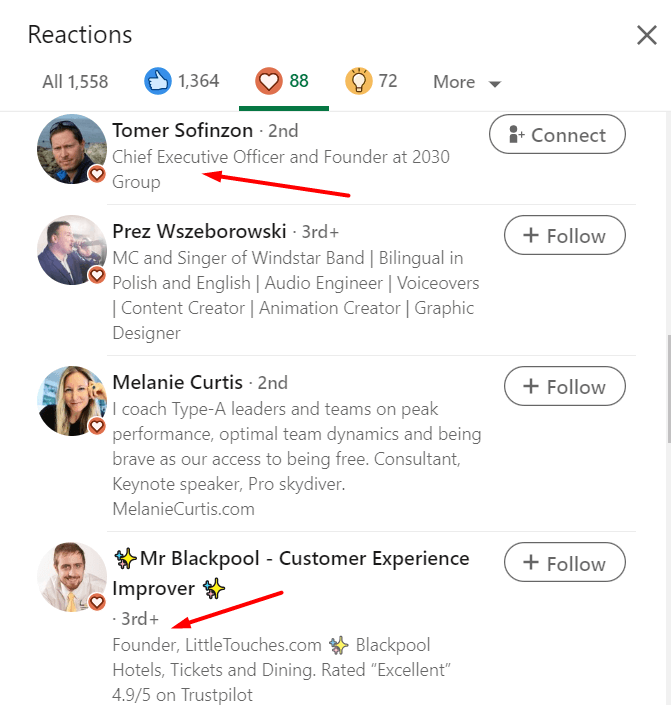
This is a valuable LinkedIn lead generation strategy, as you will have the perfect conversation starter once you outreach the decision-maker. For example, your conversation starter, based on the previous example, could be:
Hey Tomer, I noticed you liked Gary Vaynerchuk’s post on making decisions easier by watching consumer behavior, being customer-centric, and putting in the hours. I wanted to ask you how you make decisions in your company. Are there any obstacles and challenges in what Gary mentioned? Let’s connect on this.
Furthermore, you can check the post reactions a dissatisfied customer wrote on your competitor and generate the people who agreed with their opinion. The possibilities are endless.
9. Generate Leads From Event Attendees List
If you wish to research your leads’ buying signals, you need to start thinking about what LinkedIn events your ideal audience attends. Whatsmore, you can find them all in one place. Attending an event of this kind gives you valuable insight into their problems and needs.
To target event attendees, you need to first search for the events. Then, choose the event and click the Attend button.
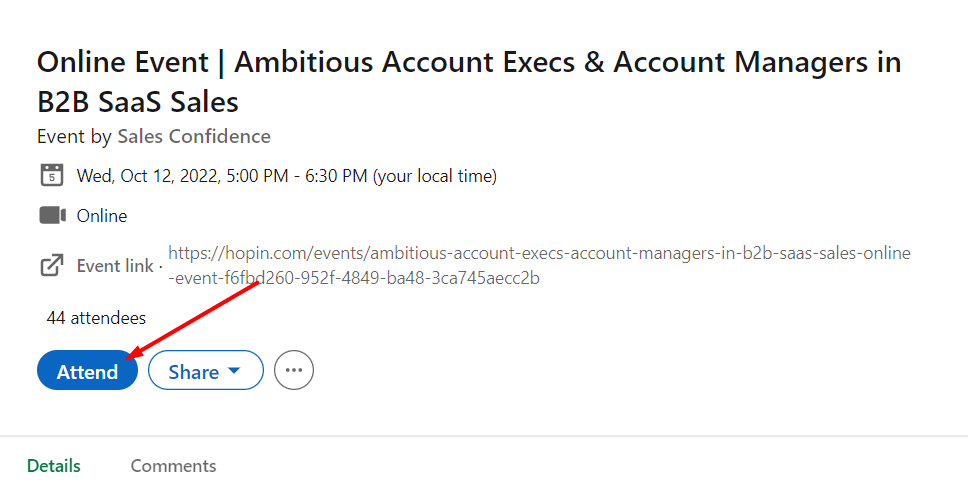
Next, click the Attendees button and check for the list.
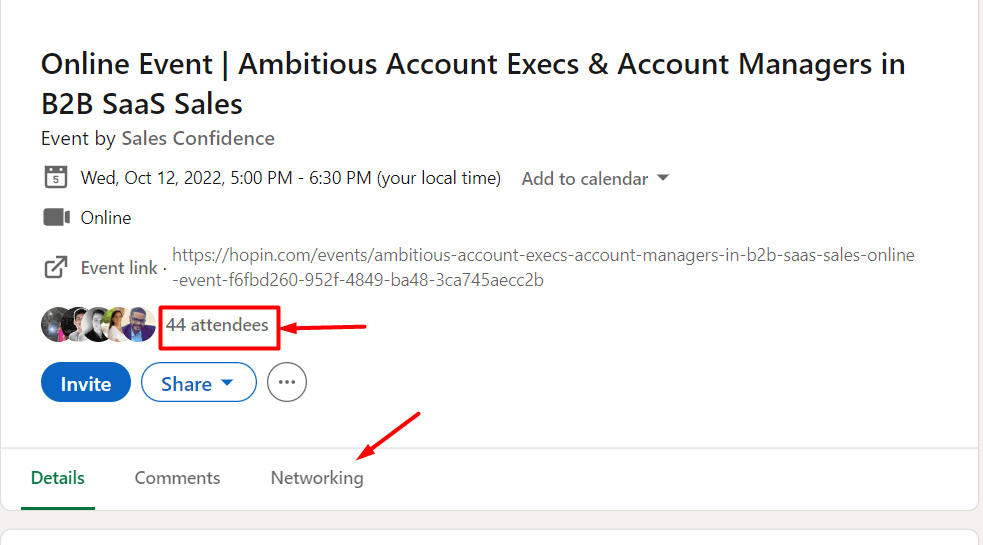
Once the event is live, be sure to write down all the questions, concerns, or comments your leads have so you can personalize your outreach later on.
10. Referral Program For LinkedIn Lead Generation
LinkedIn’s main benefit is networking. So why shouldn’t you use this benefit for LinkedIn lead generation?
The key here is to connect with your customers and offer them an incentive to refer your service to people who might be interested in using it. In other words, you can create a referral program for your current customers.
Here is an example of how the LinkedIn lead generation referral program works. First, you can offer a 20% discount for 1 month to your customer for every LinkedIn user who comes to your demo. If they find three people, that’s a 20% discount for 3 months.
What happens, in this case, is that if the recommended leads convert, they can branch out and find other leads for you to contact and convert.
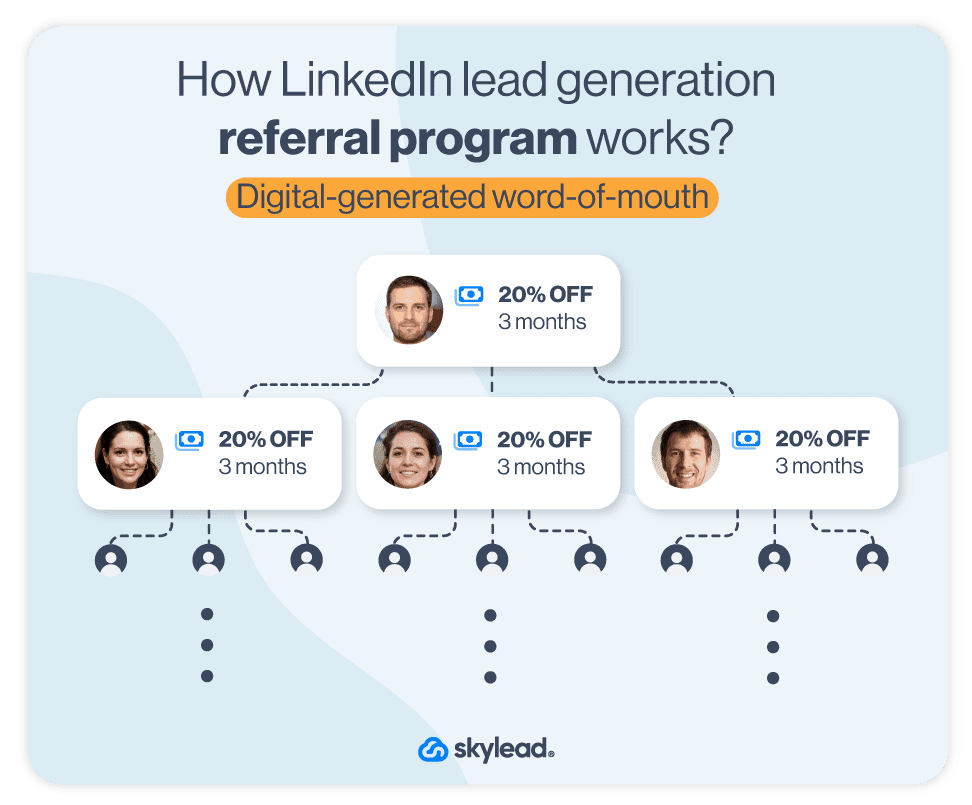
This referral program acts as word-of-mouth and a passive LinkedIn lead generation. You get leads with the buying signal, and your clients become your advocates. In return, they receive an incentive. Win-Win.
11. Generate Leads From Your LinkedIn Post
Posting content on LinkedIn as a thought leader is the most beneficial way of attracting the leads you wish. The type of content you post is your decision and creative liberty. However, for LinkedIn lead generation purposes, be sure to post in a way to appeal to high-quality leads in a unique and personalized way.
Once you see the reactions piling in, you can gather the LinkedIn profiles in one place, and outreach them manually or use the sales engagement tool to do it for you. But we will talk about this soon.
12. Gated Posts As LinkedIn Lead Generation Strategy
Another thing you can do for LinkedIn lead generation that includes posts is to create a piece intended for acquiring new B2B leads.
To clarify, B2B marketers publish lead generation campaigns to boost their overall lead generation efforts. The type of sponsored content they publish the most are gated content and LinkedIn lead gen forms with call to action.
Similarly, salespeople can share gated content with their network. The catch is to write about the benefits of said content within your post. At the end of your post, you can share a landing page that leads to a form. Or you can ask the network to leave a comment on your post for two reasons:
- To appeal to LinkedIn’s algorithm and get more eyes on your post (more engagement leads to more impressions);
- And to have a reason to contact the leads directly and keep the conversation going (or use a lead generation tool to do the outreach for you).
Here is an example. Do you remember the post example from the How to become a thought leader section? Yes, that was gated content designed specifically for starting a conversation with new leads who are already interested in seeing the valuable content. What’s best is that they are the ones who initiated the contact. Thus social selling can go upright from here on now.
To post about gated content for LinkedIn, you can share any valuable piece your marketing team prepared for you. Or you can write one from your experience – the choice is yours. However, keep in mind that this content needs to showcase good results as proof, be industry-specific, and aim to cater to your prospects’ pain points.
Just try it, and you will see why this strategy is one of the best for B2B lead generation.
13. Linkedin Lead Generation Forms (Lead Gen Forms)
LinkedIn lead gen forms are a type of LinkedIn ad where the leads need to fill in a form to access the promoted material. It is similar to gated content on the website. However, the only difference is that LinkedIn alone hosts the lead gen form.
Once the lead clicks on the call to action, LinkedIn prefills the form, making it easier for leads to submit the information. You can then easily access the leads list, download it, and send them to your sales team. 🙂
LinkedIn charges this type of ad by cost per lead. In other words, you pay once the lead fills out the form. However, it can get quite expensive. It all depends on the industry and other parameters, but the projection for 2023 is that the average cost per lead on LinkedIn will be $75.
In addition, please keep in mind that not all LinkedIn lead generation ads need to have a LinkedIn lead gen form. They can be a single image or a video that leads to another landing page with the form. So let’s talk about them.
14. LinkedIn Lead Generation Ads
As we previously stated, LinkedIn ads are powerful thus, they are one of the best strategies marketers can apply. However, many shy away from launching the ads due to their complexity at first glance.
However, marketing teams, to be fair, LinkedIn lead generation ads are not for a scare. They are just a tad more expensive. 🙂
So here is how to launch any other type of lead generation ads in 7 simple steps.
7 Steps To Create LinkedIn Lead Generation Ad
Go to the Work section and navigate to the Advertise button.
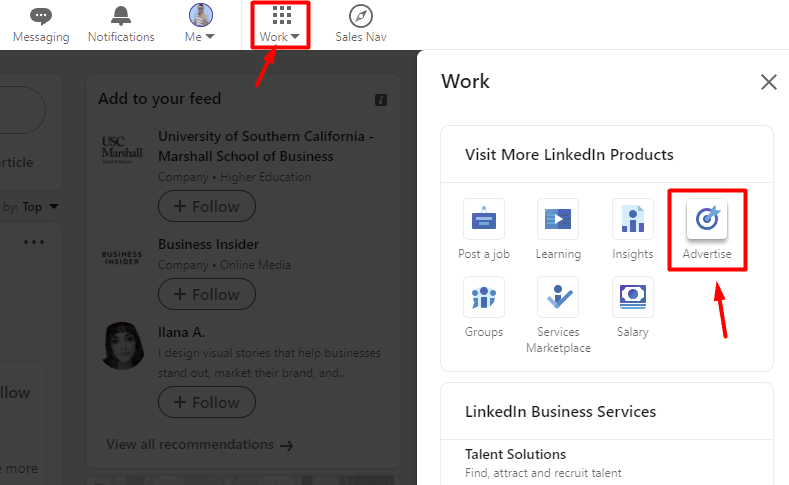
Next, if you already have your account set up, choose your account and click the Create button and choose Campaign.
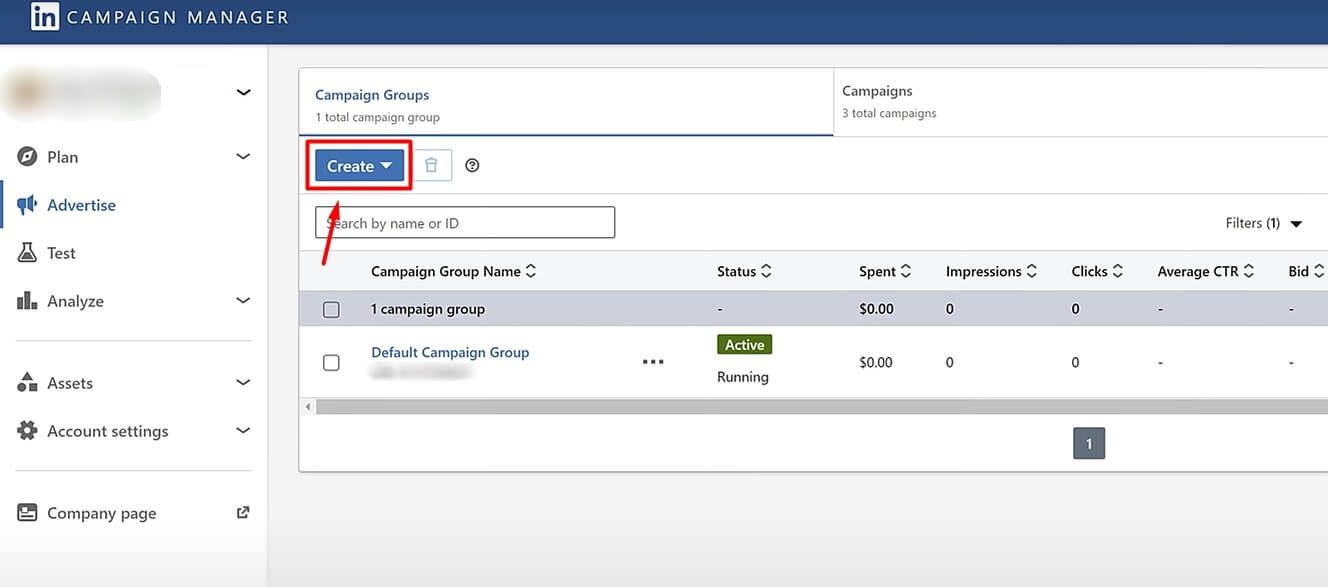
Then, select the goal of the campaign. You can choose among awareness, website visits, engagement, video views, and conversions. If, for example, you wish to promote your LinkedIn group or company’s LinkedIn page, choose the engagement campaign type. Or, if you wish to publish the LinkedIn lead gen form, use the Lead generation under Conversion.
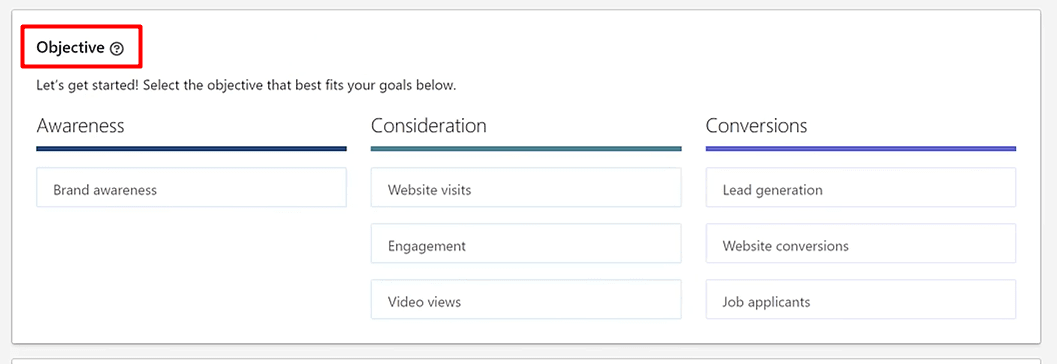
Next, define their target audience. While choosing who you wish to see your LinkedIn ads, you can set parameters such as demographics, job titles, or similar parameters. Or, you can opt-in for retargeting your website visitors via LinkedIn Insight Tag. In both cases, do not forget to set conversions to track metrics.
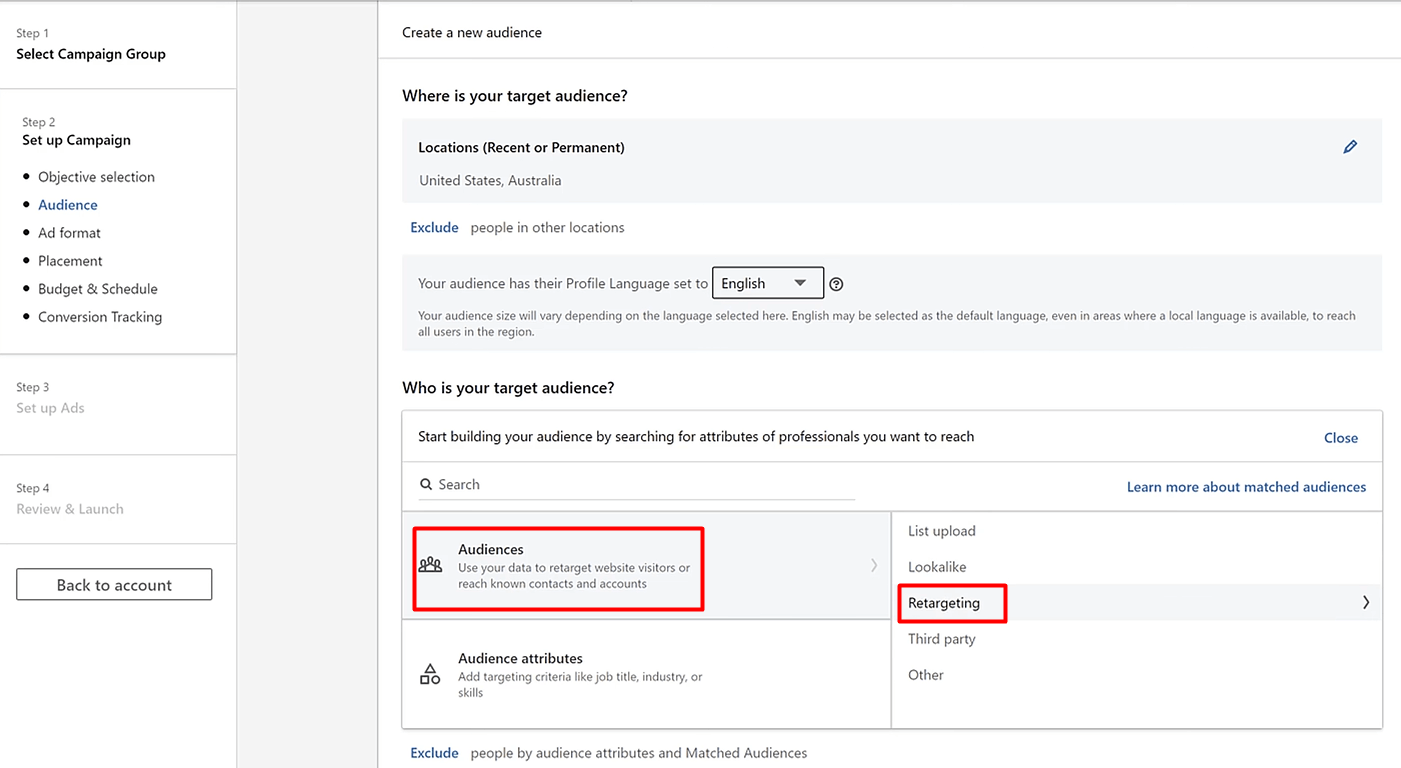
Then, select ad format and placement (should you wish for LinkedIn to distribute your ad elsewhere). Keep in mind that message type ad acts as LinkedIn InMails, and will be labeled as Sponsored (unlike regular InMails). Moreover, the recipient will receive a notification for a message but won’t be able to respond or follow up with you. They can only interact with your call-to-action button.
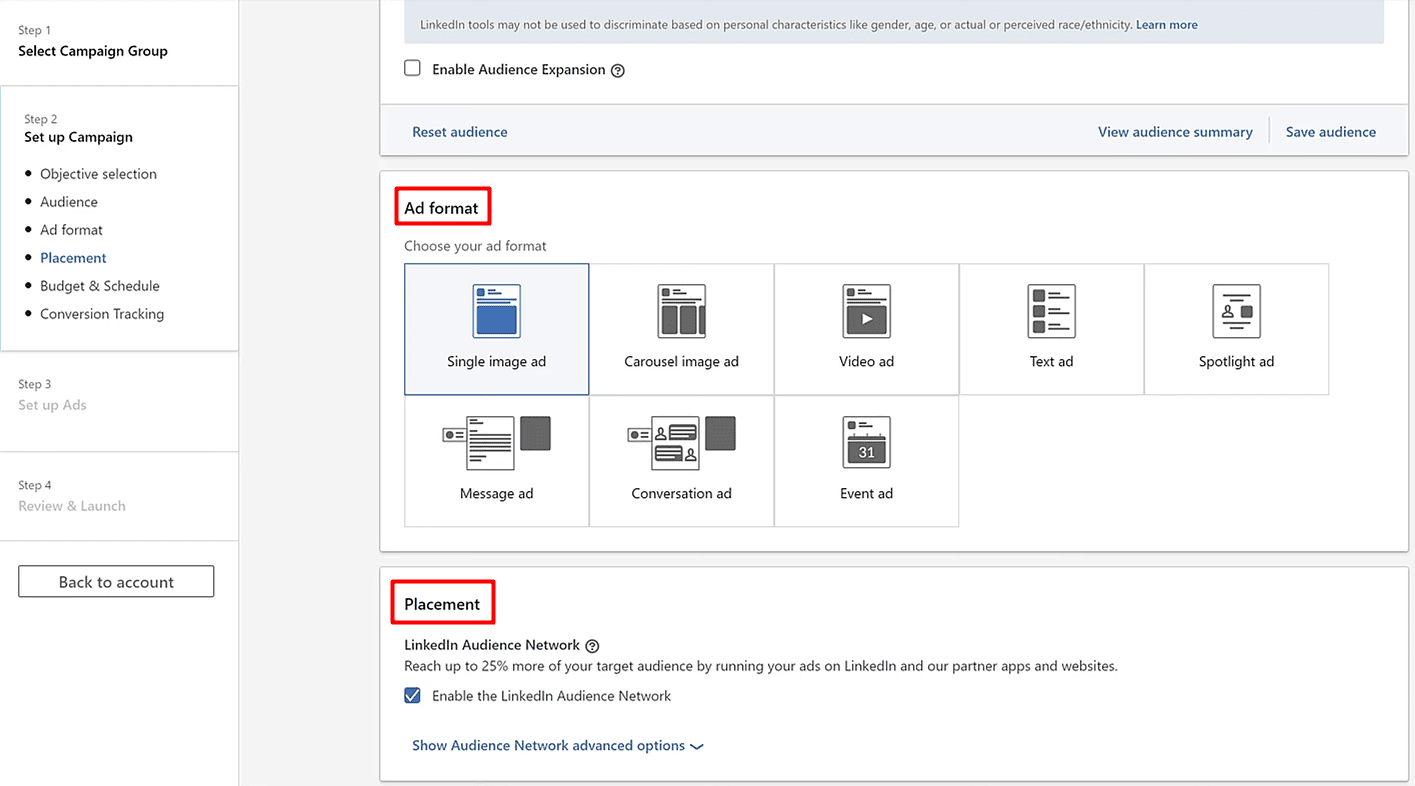
Your next step is to select the budget and conversion tracking if needed.
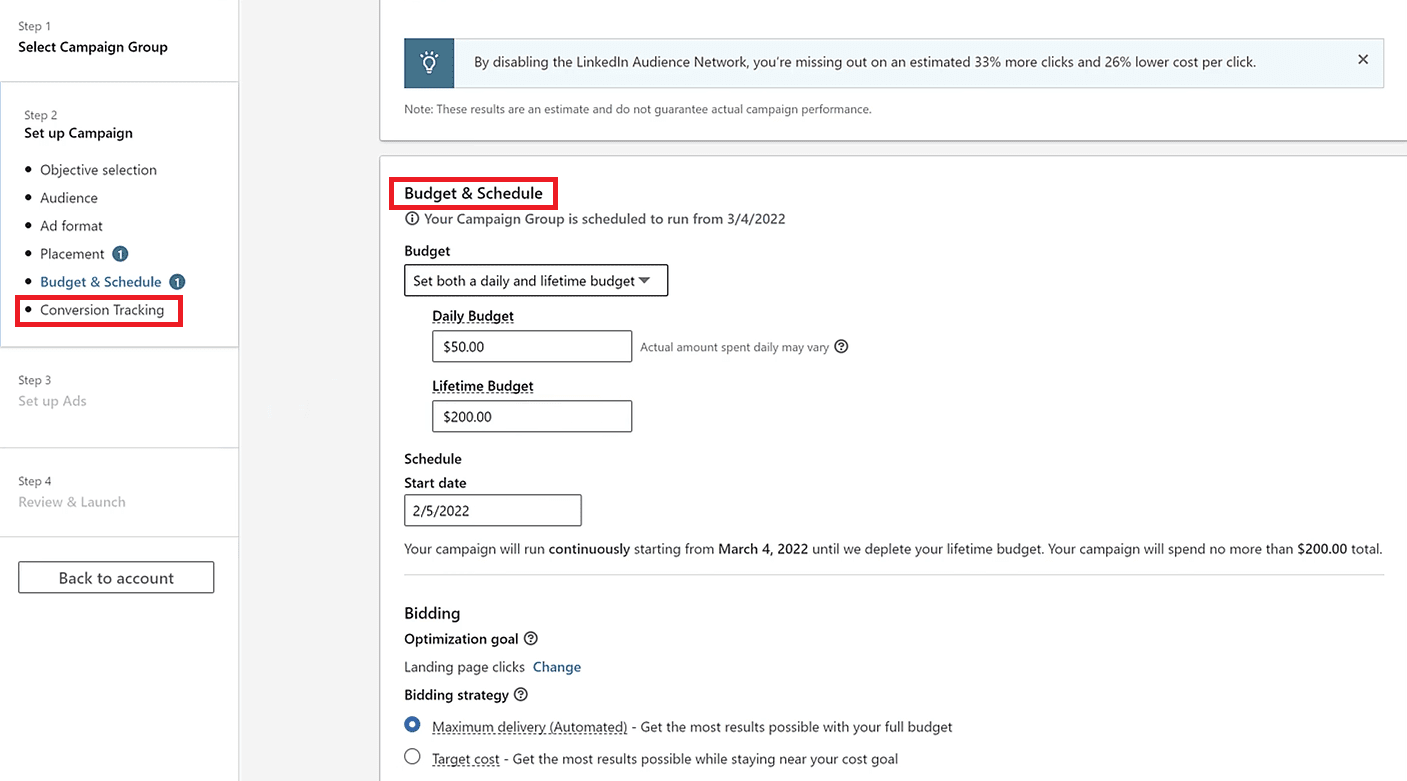
Create Your Ad
Now the real fun begins. Once you click Next, you will arrive at the ad dashboard. To start, click the Create new ad button.
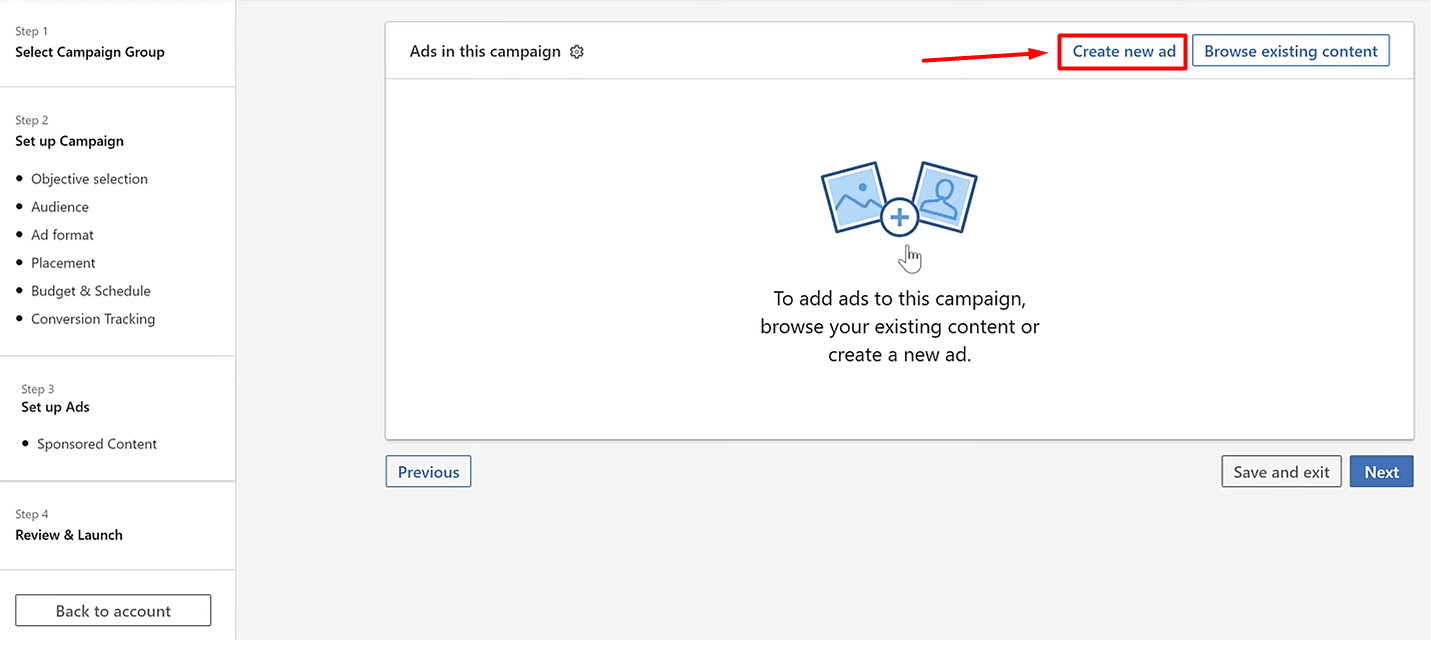
Lastly, create your message, enter the website URL where your gated content is and define a call-to-action button. Here, you are making sure that the core message resonates with the selected target audience, depending on where they are in the buying journey.
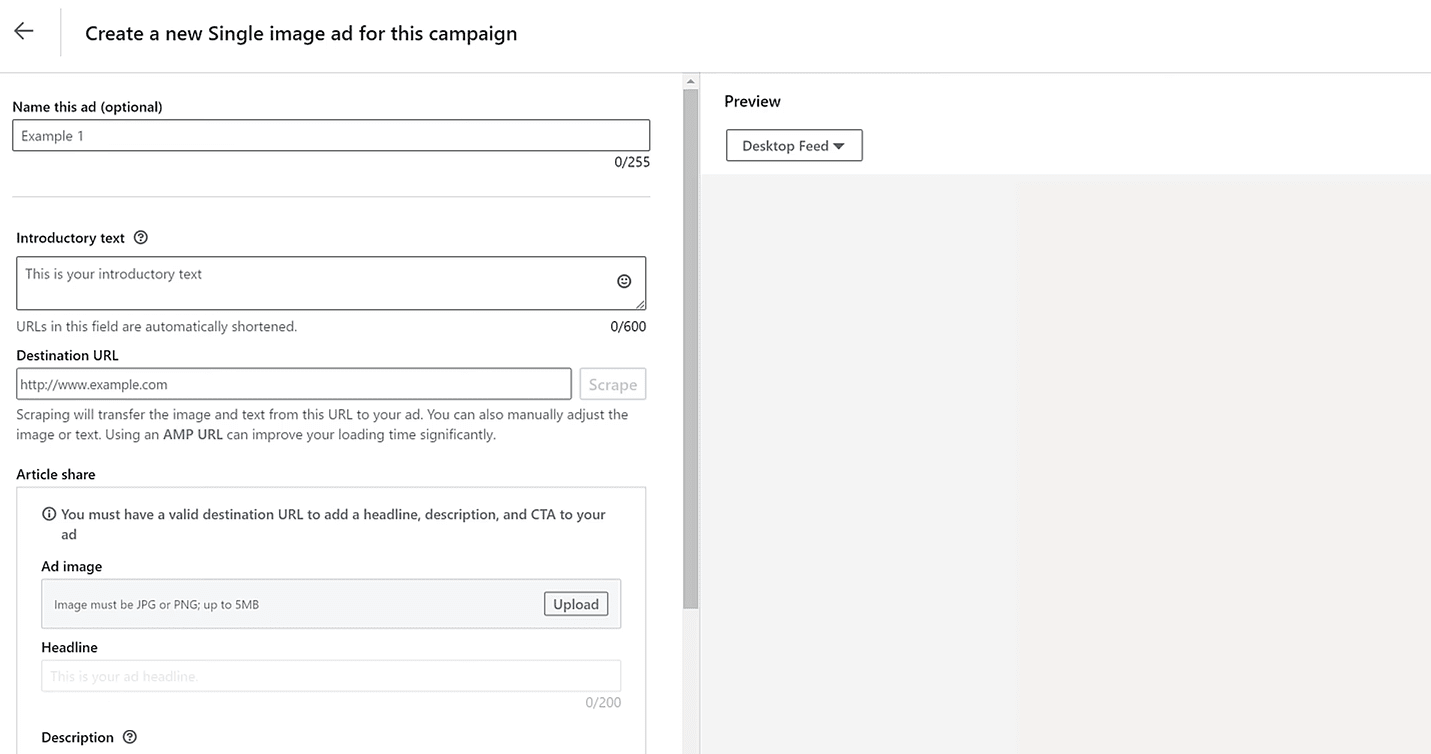
What’s more, keep in mind that this interface differs depending on the ad form you choose. Here is how it should look if you wish to create a LinkedIn lead gen form.
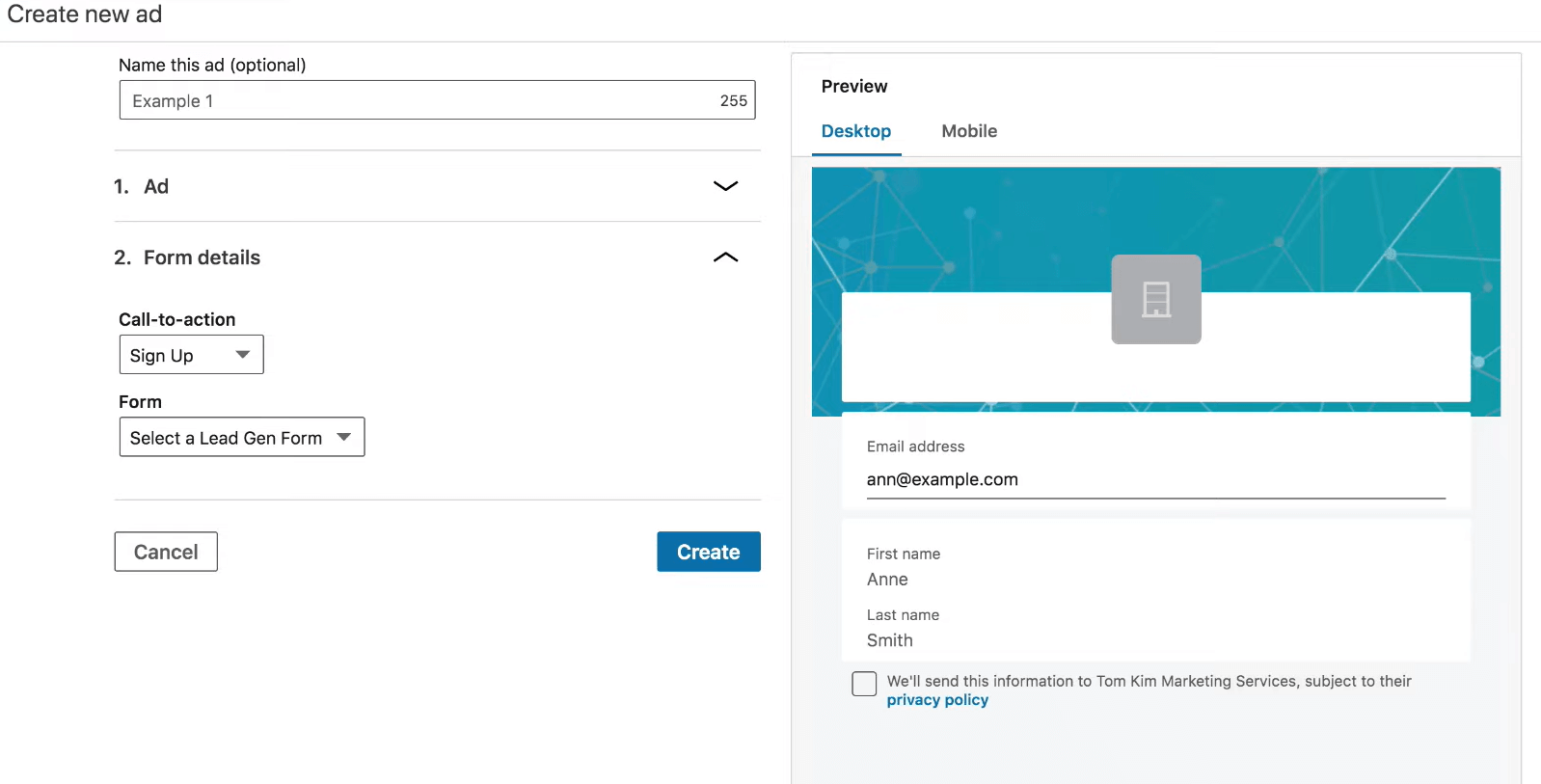
Once you insert the ad details, click Create at the bottom right of the screen, and your ad will be ready. You can then track your metrics and success back in the campaign manager.
LinkedIn Lead Generation Ads Examples
One of the shortest and sweetest ads we’ve seen must be the LinkedIn lead gen form that Hubspot published. It carefully emphasizes benefits - everything one needs to promote their business on Instagram and offers a cheat sheet as an easy solution. Moreover, the LinkedIn lead gen form auto-populates the fields, and the leads need only to click the Submit button.
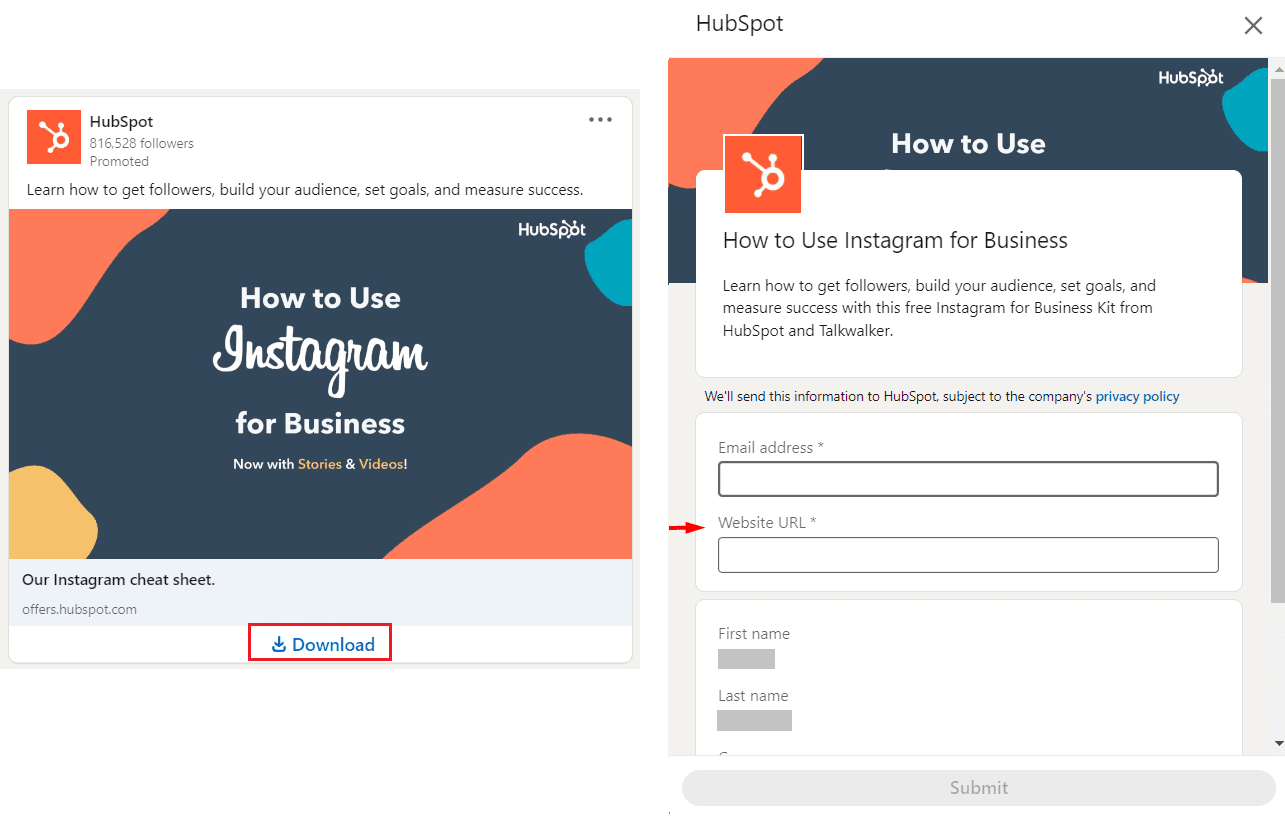
Next on our list is GetResponse, who asked one of their customers to create a short video.
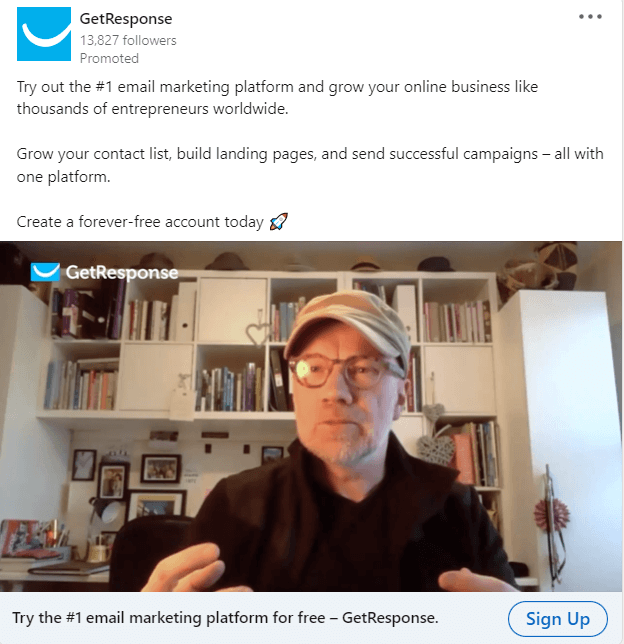
This ad is a win because of three reasons. Firstly, they used video format, which is the preferred format nowadays. Secondly, their customer gives a testimonial, a live word, and their experience with the product. Lastly, they promote their forever-free account, so it’s easier for the leads to sign up without any obligations.
Last, but not least, we have Atlassian’s webinar promotion.
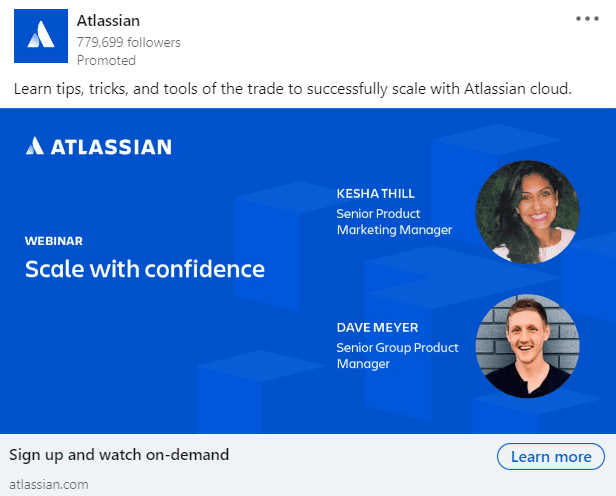
Not every lead generation ad needs to have a service sign-up as the ultimate goal. Webinar sign-ups work for different buying cycles just as well, and Atlassian recognized it.
What is a win in this situation is not the copy above, nor a visual (though it helps), but the wording “on-demand”. You see, many of us do not have time, or have different schedules. So it makes it harder to fit one webinar by the time it is up live. The phrase “on-demand” makes it easier for leads to sign up, as they can watch the webinar whenever they find the time.
15. Use Sales Navigator’s Buyer Intent Feature For Lead Generation
Lastly, Sales Navigator introduced its Buyer Intent feature. It offers insights into accounts showing the level of interest. Buyer Intent helps sales professionals reach out to the right people and companies at the right time.
How it works is that LinkedIn tracks accounts that interacted with your business on many levels (e.g. if the leads viewed your profile or a company page, accepted your request, etc). It then labels them by the level of interest and recommends them to you. It is a perfect way to generate leads that previously showed some level of interest in your company.
However, keep in mind this feature is only available for Sales Navigator Advance and Advance Plus users. Thus if you have a Sales Navigator Core account, you won’t have this functionality.
Frequently asked questions about Linkedin Lead Generation
Oh, what a journey has been so far, hasn’t it? However, we still want to cover everything there is to know about LinkedIn lead generation. Therefore, here are a couple of FaQs to sum up LinkedIn lead generation.
What specific challenges do companies face when implementing these strategies, and how can they overcome them?
Companies may face challenges like creating engaging content and measuring ROI. Overcoming these involves using analytics for insights and continuously refining strategies based on performance data.
Which LinkedIn Ad Format Is The Best For Lead Generation?
The LinkedIn ad format best for lead generation is a Single Image ad because it looks organic with other content you see in the newsfeed. Moreover, if combined with Lead gen form, it can bring amazing results. The next best thing is to promote gated content on your website.
How Do I Target A Lead On LinkedIn?
You can target leads with your ads by using LinkedIn campaign manager. All you need to do is to define demographics, firmographics, and other parameters of your target audience or choose to retarget your website visitors via LinkedIn Insight Tag. Then create an ad, and publish it.
How Do I Generate B2B Leads On LinkedIn?
You can generate B2B leads on LinkedIn by using any of the strategies mentioned in this article, such as posting gated content, using lead generation form ads, and generating leads from event attendees. Moreover, you can generate leads from job postings, leveraging Sales Navigator’s buying intent feature, and more.
Why Is LinkedIn Best For Lead Generation?
LinkedIn is best for lead generation because it’s the #1 professional network in the world. According to LinkedIn, lead conversion rates are 3x higher than any other social media. Moreover, 4 out of 5 LinkedIn users drive certain business decisions and have 2x buying power of the average web audience.
Ready To Scale Up Your LinkedIn Lead Generation?
LinkedIn is the #1 place to generate new leads by creating valuable content and reaching out to new connections.
However, before you get started with LinkedIn lead generation, you need to make sure to:
- Create a highly converting LinkedIn profile;
- Define your ICP and Buyer Persona;
- Become a thought leader;
- Build your network and relationship regularly;
- Create a personalization spreadsheet;
- Learn more and understand buying signals.
Once you do, you can apply one or all LinkedIn lead generation strategies to generate leads.
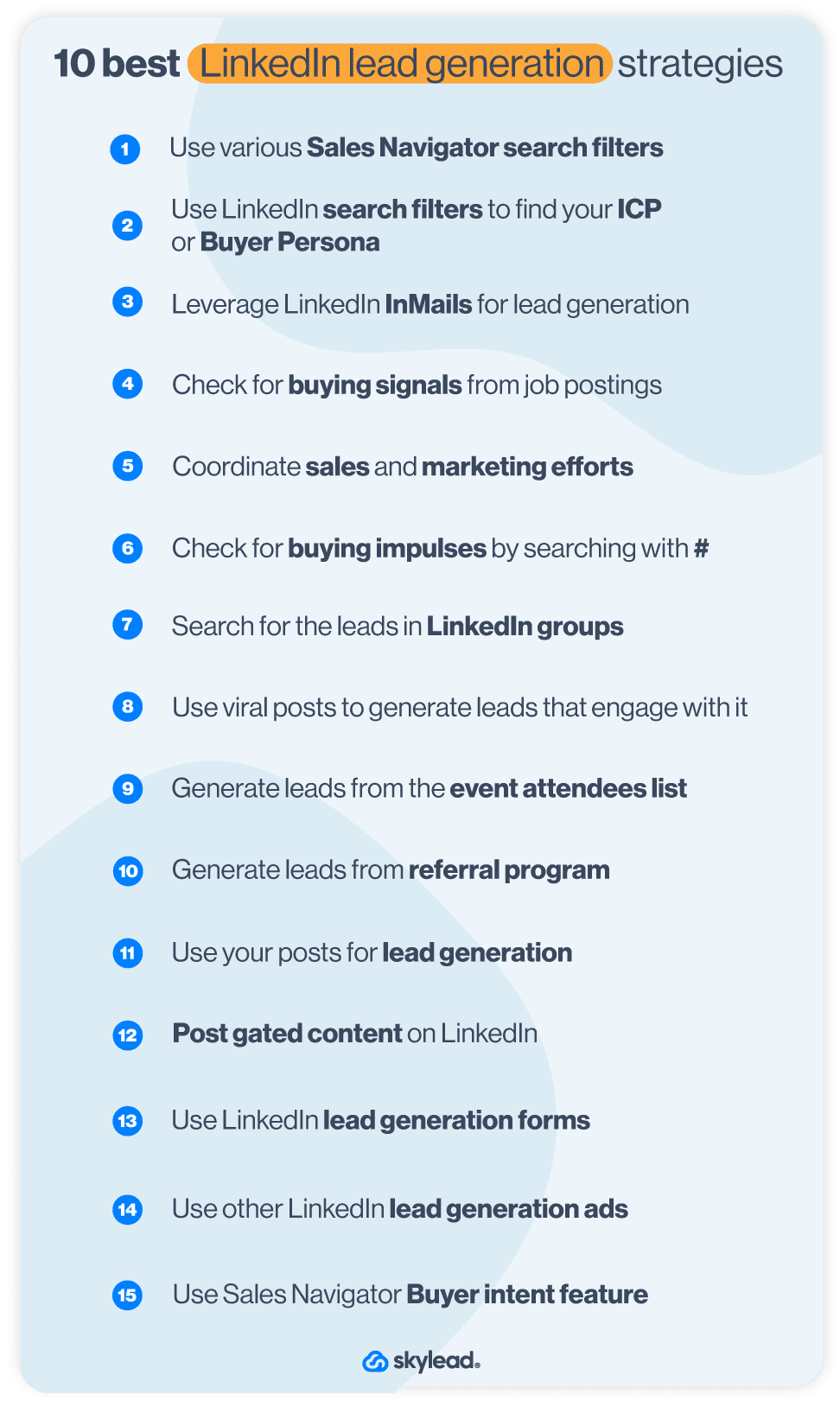
LinkedIn lead generation works best if you combine it with other lead generation methods outside of LinkedIn and then circle back to LinkedIn to outreach them.
Disclaimer: Skylead is not affiliated, endorsed by, or connected with LinkedIn in any way.
It’s 2026, and LinkedIn is still the most essential and fastest-growing professional network globally. As such, it is full of potential clients, connections, and different growth opportunities.
It takes only one wrong step to lose the deal of a lifetime or make a wrong impression that could cost you money and your business image. That’s why proper professional etiquette is important for building and maintaining your brand.
To ensure this doesn’t happen to you, we decided to share how to network on LinkedIn and some dos and don’ts from our own experience.
How to network on LinkedIn
Networking on LinkedIn is a powerful tool for building professional relationships, expanding your career opportunities, and staying updated in your industry. And we, as a company, can vouch for that.
We’ve been in the industry for 5 years, and LinkedIn is our second nature. For example, our CEO, Relja Denic, first started networking on LinkedIn in 2019. Since then, he managed to gain about 25K connections and 22K followers. Not to mention our other crew members.
That said, here are the actions that will help you understand how to network on LinkedIn.
#1 Connect with people from your area of expertise
To expand your network on LinkedIn, the first choice would be to find people whose occupation is the same or similar to yours. You can exchange tips, tricks, and valuable resources.
That said, your connection request message can sound something like this:
Hey {{firstName}},
I saw that you are also {{Occupation}} and wanted to connect with you and exchange our experience, tips, and tricks. 😊
#2 Connect with your target audience
One of the best ways to network on LinkedIn and research your market is to ask your target leads yourself - a practice rooted in modern sales engagement where listening comes before pitching.
Don’t be afraid of how to network on LinkedIn with them. Simply say you’re exploring their position and current challenges. Like this:
Hey {{firstName}},
I noticed you work as {{Occupation}}. I am currently researching {{Occupation}}’s challenges and pain points, so I was wondering if you’d like to connect and chat about it. 😊
#3 Attend LinkedIn events and mingle
Another way to network on LinkedIn is to attend LinkedIn events and chat with other attendees. To find a list of attendees, apply for the event yourself by clicking the Attend button.
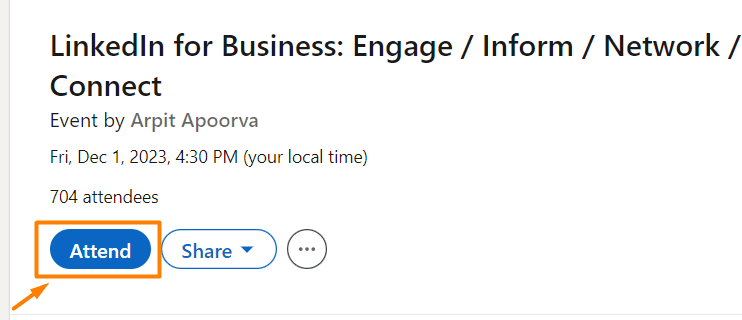
Then, hit Attendees to get a list of all the people who are attending the event.
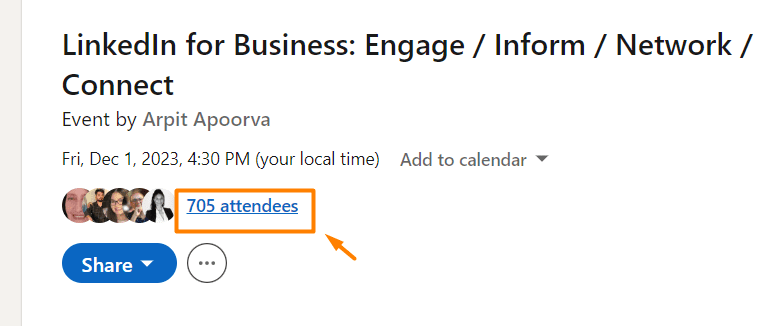
You can then send them a connection request such as this one:
Hey {{firstName}},
I noticed you’re also attending {{eventName}}. I’d love to connect and chat about our experience and the value we get from there!
Or you can simply send them a message from the Networking tab.
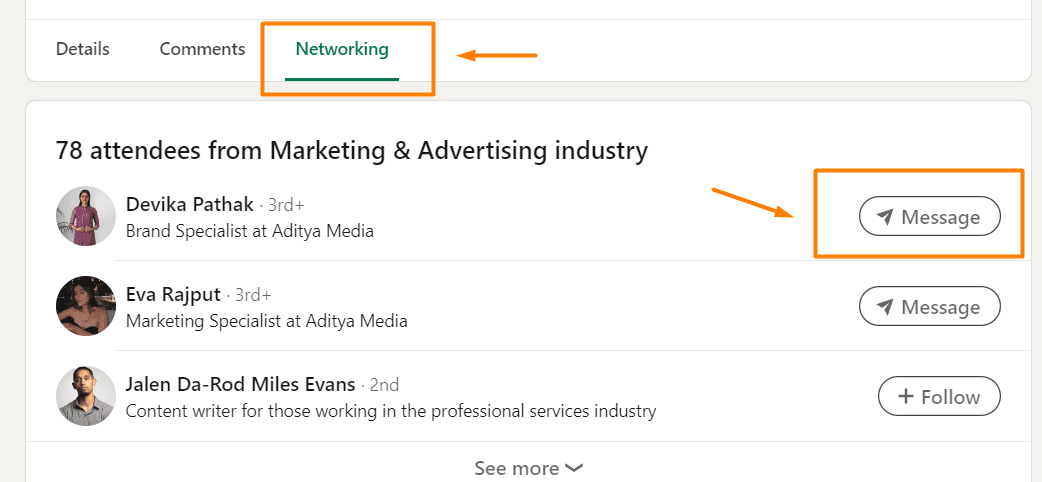
#4 Join LinkedIn groups
LinkedIn groups are considered to have no engagement whatsoever. However, that doesn’t stop you from approaching each member individually and genuinely connecting. That said, join the LinkedIn group that aligns with your and your potential client’s interests and industry.
Being part of a LinkedIn group whose members are from the same industry as you gives you a chance to learn from other people’s experiences, know what your competitors are up to, and connect with your colleagues.
On the other hand, being part of a LinkedIn group whose members are your potential clients helps you understand their needs, concerns, and what they expect from certain products or services (that might be the ones you are offering).
In any case, it’s a win-win situation!
Extra tip: You can also target members of a specific LinkedIn group if you upgrade your LinkedIn plan to Sales Navigator.
That said, to get to the members’ list, hit Show All in the upper right corner.
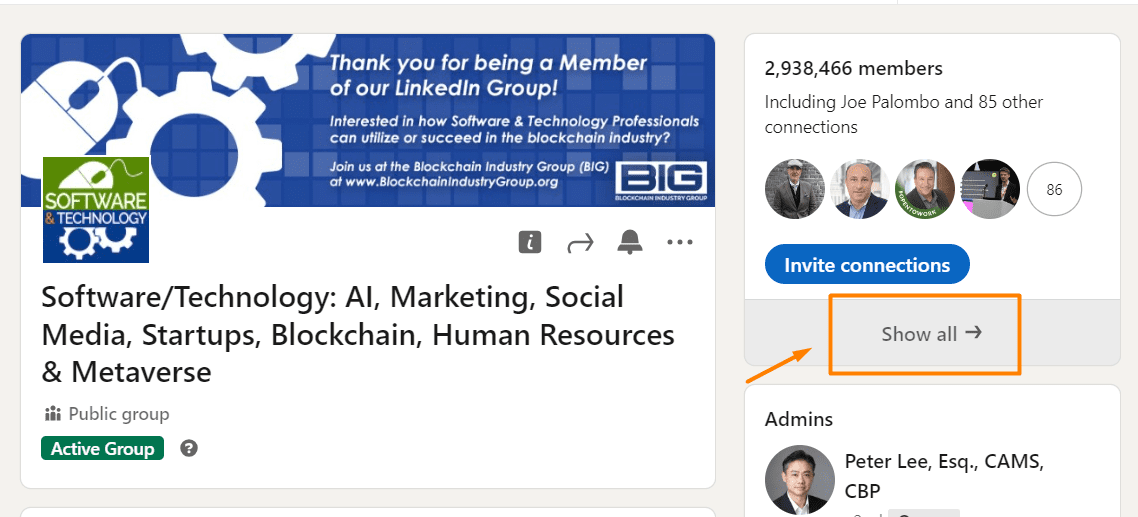
Then, send them a message explaining why you wish to connect with them. If, for example you joined a group with people from your industry, give this message a go:
Hello {{firstName}},
I noticed you are also a member of {{groupName}}. I would love to connect with you since I can see we're both in the {{industry}}.
#5 Create content and engage with people who comment
If you’re passionate about creating and posting content on LinkedIn, you should know that this can be another form of networking on LinkedIn. For example, a 1st-degree connection can comment on your post. In return, you can like their comment, respond, or message them and continue the conversation.
In addition, if your post reaches your 2nd or 3rd-degree connections and they comment or like a post, send them a connection request. However, be sure that your connection message is not out of context.
6 dos for networking on LinkedIn
Personalize invites to connect
LinkedIn is a place to network, but that doesn’t imply randomly adding anyone you run into.
It is rather a platform for meaningful business connections and as such it is highly recommended to reach out to people you either know or are interrelated with due to the nature of your industry.
Either way, it is always a good practice to send a personalized Invite to Connect.
Firstly, if you are reaching out to someone you don’t know, why risk being banned on LinkedIn in case they click on the I don’t know this person option? A certain number of these will get you restricted, you know?
Secondly, many people on LinkedIn appreciate Invites to Connect with an explanation of why they should connect with you. It doesn’t need to be a full-on sales pitch, but rather an interest or a reference in common. This is why a well-planned LinkedIn prospecting and targeting people attending the same event or those who are members of the same LinkedIn group can work so well to your advantage.
If you follow one simple tip such as this one, you will significantly increase your success on LinkedIn and stand out from numerous people who don’t consider it at all.
Complete your LinkedIn profile
Most people will not reply if your LinkedIn profile is incomplete. Or if they’re nice, they will do it reluctantly. This is because without a profile picture, experience, and LinkedIn summary, nobody can get an entire picture of who you are and what you’re about, and they would think the profile is fake. That said, to keep your integrity, finish up your entire LinkedIn profile.
Respond promptly
Just like with Emails, responding promptly to your Messages, Invites to Connect, and LinkedIn InMails is a sign of professionalism.
Good etiquette implies replying within 24 h.
Of course, the timeframe within which you answer is equally important to the content and tone of your message.
Any of the people you are responding to might be your future client, collaborator, or colleague. Make informed decisions and give confirmed information.
This way you will build the image of a trustworthy, knowledgeable professional with integrity.
And that’s what we all want, don’t we?
Introduce people
Introducing connections to each other creates positive social capital for you.
It shows that you genuinely care about people making meaningful connections that could benefit the industry.
Furthermore, a highly appreciated gesture of this kind will invoke the law of reciprocity.
Namely, your connections will most likely return the favor by introducing you to other professionals that are, in their opinion, good for you.
There is no better way of growing your business network than through positive word of mouth. Remember that the best advertising for business is free. But it takes time to build trusted and loyal connections.
So, stick to our dos over here.
Stay top of mind
Your lone presence on LinkedIn is not enough for staying top of mind of your connections.
- Post quality content.
- Respond promptly to Messages, Invites to Connect, and InMails.
- Congratulate people on promotions and new jobs in a professional manner, while still showing that you genuinely care.
- Respond to comments and reactions to your posts and tag people you are replying to.
- Post authentic responses to the most interesting discussions.
- Join LinkedIn groups.
Check your SSI
If you run out of networking ideas, check your LinkedIn Social Selling Index Score. It will show you your overall networking status and what networking area you can improve.
5 don’ts for networking on LinkedIn
LinkedIn is NOT Tinder
Avoid adding people just because you like their looks.
Avoid adding people just because.
Don’t start messages with “Hello Dear”, give compliments that are not business-related or argued, or send any type of messages with a strong personal note.
Not only will you be ignored, but you will be marked as a spammer, and most likely earn a reputation as a weirdo.
News travels fast.
People will not be eager to connect with you, let alone do any business with you.
Don’t spam people
Sending irrelevant, long, impersonal messages that don’t bring anything to any of the sides involved cannot earn you a good reputation.
It’s like a story of a girl who cried wolf.
If you keep sending messages that are only spamming other users, once you send something meaningful, nobody will be interested in reading it or answering back.
Save your Messages and InMails for significant business outreach and communication.
Your contacts will appreciate hearing from you less but leading insightful conversations regarding your industries or any other business-related topic.
Don’t post self-serving content
Whether sharing content or replying to messages or a discussion, make sure to provide value first and foremost.
The biggest mistake on LinkedIn is the misconception that people care about what you have to say. They only care about finding solutions to their problems or gaining valuable insights into the industry trends and demands. That’s all.
There is always a way of giving something to your readers while managing to promote your product or services.
Don’t ignore job proposal & invitations
Even if you are satisfied with your current job, you never know what the future holds.
Don’t burn bridges.
Answer to any job or business proposal you might receive. Be polite and professional.
Firstly, you don’t know if life will take you in that direction. The offered position might not even be in line with your future aspirations. However, have in mind that that company has other departments as well.
Secondly, the world is small. The Human Resources Manager that contacted you for that particular job might be the Human Resources Manager for another company in no time. And they will remember if you ignored or were impolite when they reached out.
The same applies to LinkedIn users who write to you regarding business opportunities and collaboration. Maybe you are not interested at the moment, but that’s for sure not the reason not to keep the door open for future contact.
Don’t talk negative about competitors
Social media can be such a negative space.
People have had it enough already.
Not only does everyone want to belong to a positive, proactive, and like-minded community, but posting negatively about your competition is a sign of bad sportsmanship.
Did you know that when you are talking badly about someone, people who are listening are subconsciously attributing all the negative features to you?
Treat others with respect just as you would like to be treated.
Also, have in mind that even when you are commenting on behalf of yourself, people might ascribe your opinion to the general attitude of the company you are currently working for. Be careful about it, especially on LinkedIn which is, as we said before, a professional network.
You are representing your brand, your company, and the industry at the same time.
Frequently asked questions
How can one measure the effectiveness of their LinkedIn networking efforts beyond the Social Selling Index Score mentioned in the article?
Measuring the effectiveness of LinkedIn networking extends beyond the Social Selling Index Score through the analysis of connection growth rate, the relevance of new connections in your industry, engagement (likes, comments, shares) on your content, and direct feedback from your network, reflecting the value and impact of your networking efforts.
What specific strategies can be used to recover from a negative impression or mistake made while networking on LinkedIn?
Recovering from a negative impression on LinkedIn involves acknowledging the mistake directly if it affected specific individuals, demonstrating professionalism in your response, and consistently sharing valuable content to rebuild your reputation. Engaging positively with the community and offering genuine contributions can gradually restore trust and credibility.
Are there any tools or features within LinkedIn that can help automate or facilitate networking activities without violating LinkedIn's policies on automation and spam?
LinkedIn offers native features to help you network, such as LinkedIn Sales Navigator for targeted searches and LinkedIn Learning for professional development. While some third-party automation tools exist, they may violate LinkedIn’s Terms of Service and put your account at risk. That said, if you'd like to support your networking efforts, you can use a sales engagement tool like Skylead, which is 100% compliant with LinkedIn's ToS.
Now you know how to network on LinkedIn. Are you ready for it?
Networking, brand engagement, and generating leads on LinkedIn are the activities that are strongest than they have ever been.
Therefore, LinkedIn is not just your online resume.
It reflects your entire way of doing business and communicating with your leads and customers.
Everything that happens on LinkedIn has consequences, positive or negative, that you have to be ready to take responsibility for.
Since it’s better to be safe than sorry, stick to our tips and you will be just fine.
Disclaimer: Skylead is not affiliated, endorsed by, or connected with LinkedIn in any way.
The topic of how to cancel a LinkedIn invitation is rarely discussed, simply because people tend to leave invites pending for… Well, forever.
However, everyone should monitor their pending invites, especially if you are in sales or a recruiting business, as the integrity of your LinkedIn profile can get damaged. Yes, it’s that serious.
So to keep your integrity intact and help you reduce the number of pending invites in the first place, in this article, we’ll cover:
- Why do you need to cancel your LinkedIn invite;
- What you need to know about the cancellation process;
- How to cancel LinkedIn invitations that are pending for a long time;
- Why your LinkedIn invites aren’t getting accepted;
- How to create engaging invitations that will increase your acceptance rate.
Why should you cancel your pending invitations?
You should cancel LinkedIn invite because of 3 reasons:
- There’s a risk of getting your account restricted;
- Your LinkedIn experience can get damaged;
- LinkedIn won’t allow you to send new ones unless you clear the list.
Let’s clarify these statements.
Firstly, and most importantly, if you do not cancel your LinkedIn invite for a long time, you risk piling them up. It would be fine if LinkedIn didn’t have an eye out for suspicious activities. And, yes, LinkedIn does consider this suspicious.
In other words, if you do not withdraw your pending invites after a month or two and leave them piling up, LinkedIn can restrict your account. Moreover, you won’t be able to send any other connections until you clean out your pending invite list.
Secondly, if the connection doesn’t accept the invite for a while, the chances are they either are not interested, or they aren’t within your business industry.
To clarify. The quality of your network on LinkedIn plays a significant role in experiencing benefits while using this platform. So, one of the things that will boost your career is taking the effort and making a strategy to connect only with people related to you and your business, and cancel LinkedIn invites sent to those who are not.
Lastly, a word on the street is that if you have too many pending requests, LinkedIn won’t allow you to send new ones. Some people say they reached a whopping 3000 pending invites before LinkedIn restricted them from sending more invites. LinkedIn didn’t publish the precise number of how many pending requests you can have officially. However, to avoid this scenario some people experienced in the past, be sure to clean your list regularly.
What you need to know before proceeding to cancel LinkedIn invite?
Before you withdraw any of your LinkedIn invites, you should know a couple of things first.
First of all, you can’t cancel LinkedIn invites in bulk.
Also, if you send a LinkedIn connection request to a person, they will see the notification as soon as they log into their account. However, in case you cancel the LinkedIn invite before the user sees it, they wouldn’t even know that you’ve sent it.
In addition, canceling an invite will stop the recipient from receiving further LinkedIn notifications or emails to remind them of the request.
When can you cancel your LinkedIn invite?
You can cancel LinkedIn invite you’ve sent accidentally or that you regret sending, as long as the LinkedIn member hasn’t accepted your invitation.
In case the LinkedIn user accepts your connection request, there is always an option to remove them from your connections.
If you withdraw your request, you will have a tiny restriction.
After you cancel your invite, you won’t be able to resend it to the same recipient for up to 3 weeks.
How to cancel LinkedIn invite in 5 simple steps?
In case you’ve sent the requests you wish to withdraw or are pending too long, here’s how you can do it.
Cancel LinkedIn invite via desktop
First, go to Linkedin, and click on My Network in the header bar.
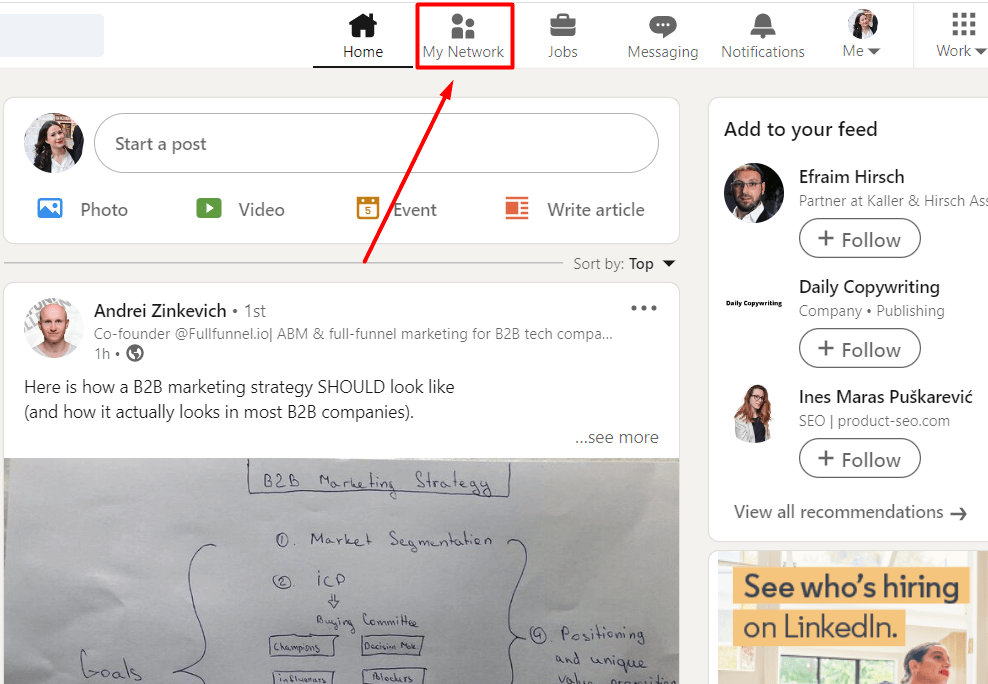
Once you do, you will see the list of invites other people sent you. Hit See all # in the top right corner.
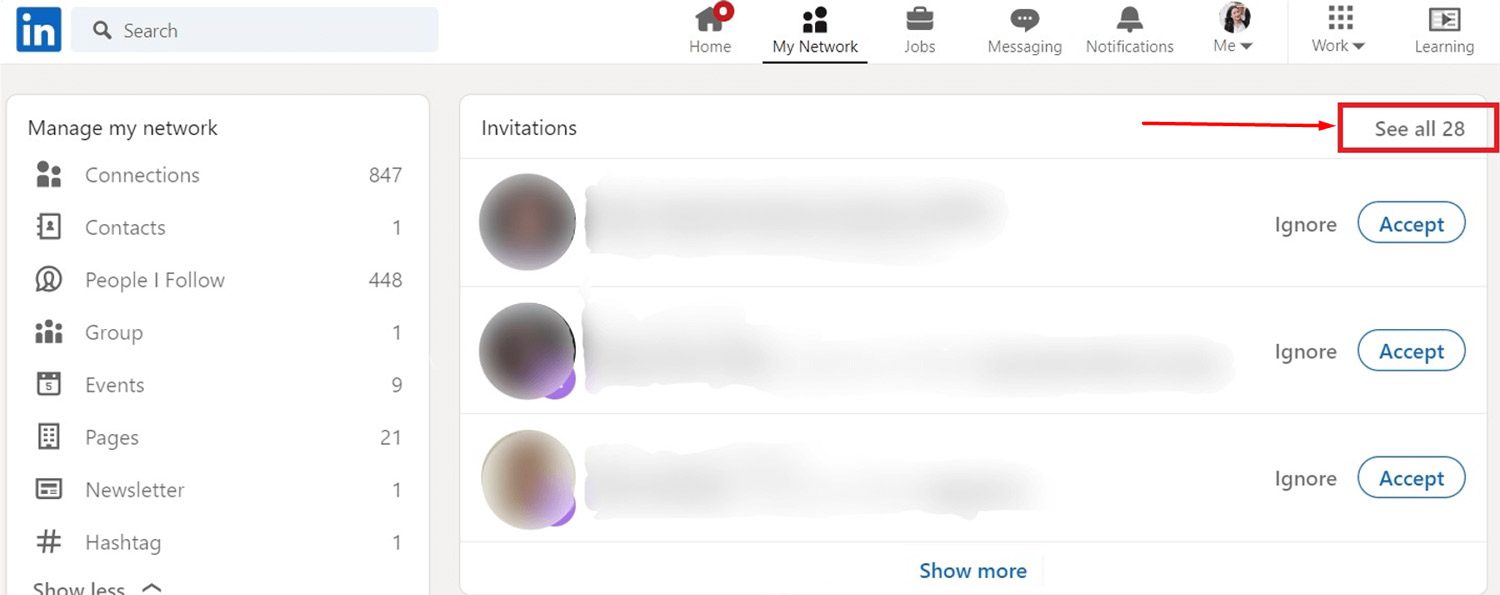
If you don't have any invites you need to approve on this page, the section will look slightly different. In this case, just click the Manage button.
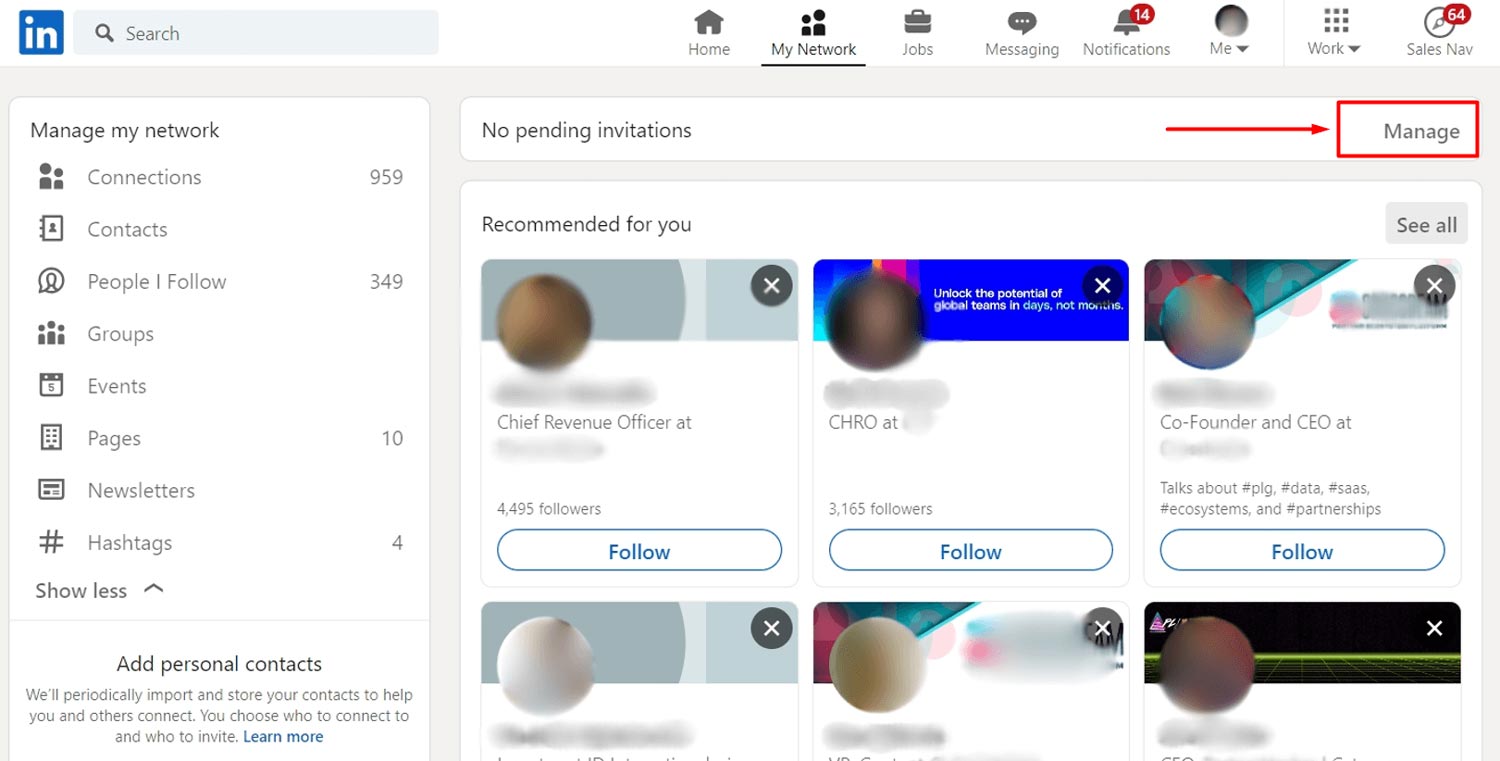
Here, you can see all the invites people sent you. To find the ones you sent out, go to the Sent tab and click the Withdraw button to cancel the LinkedIn invite.
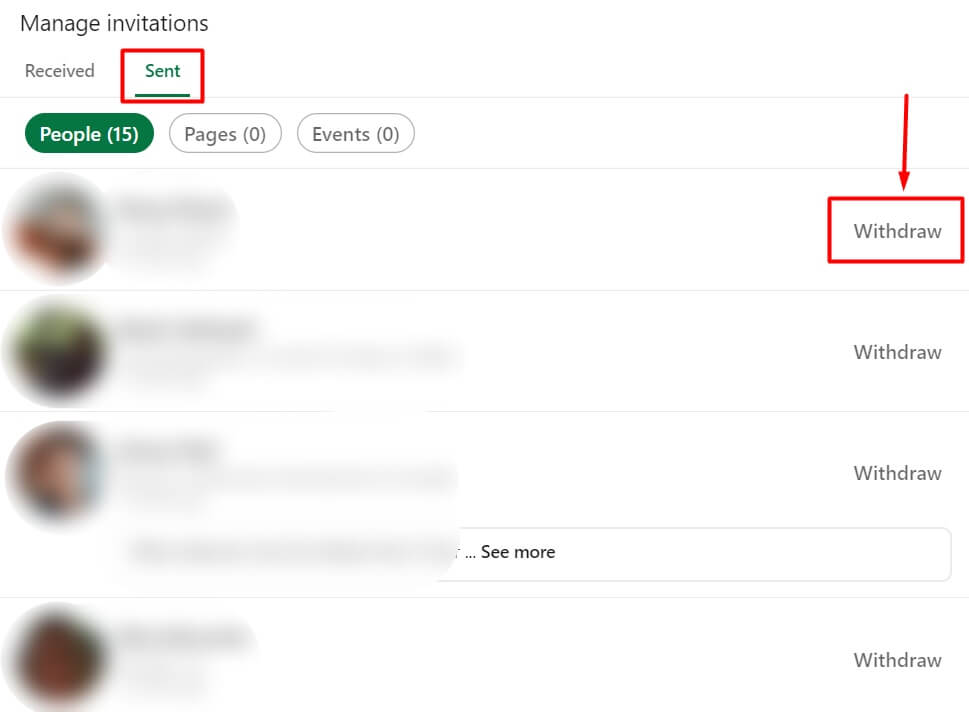
Lastly, LinkedIn will double-check if you wish to withdraw your invite with the notification. Continue the cancellation process, and you will be done.
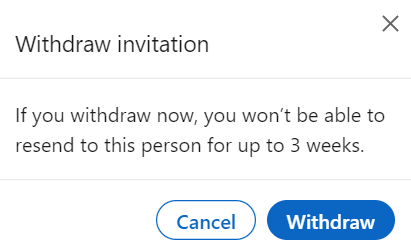
Canceling invites via Android
You can withdraw invitations using your android phone too, and the process is not that different than the one using your PC.
First, go to your Network page, and click the Invitations button.
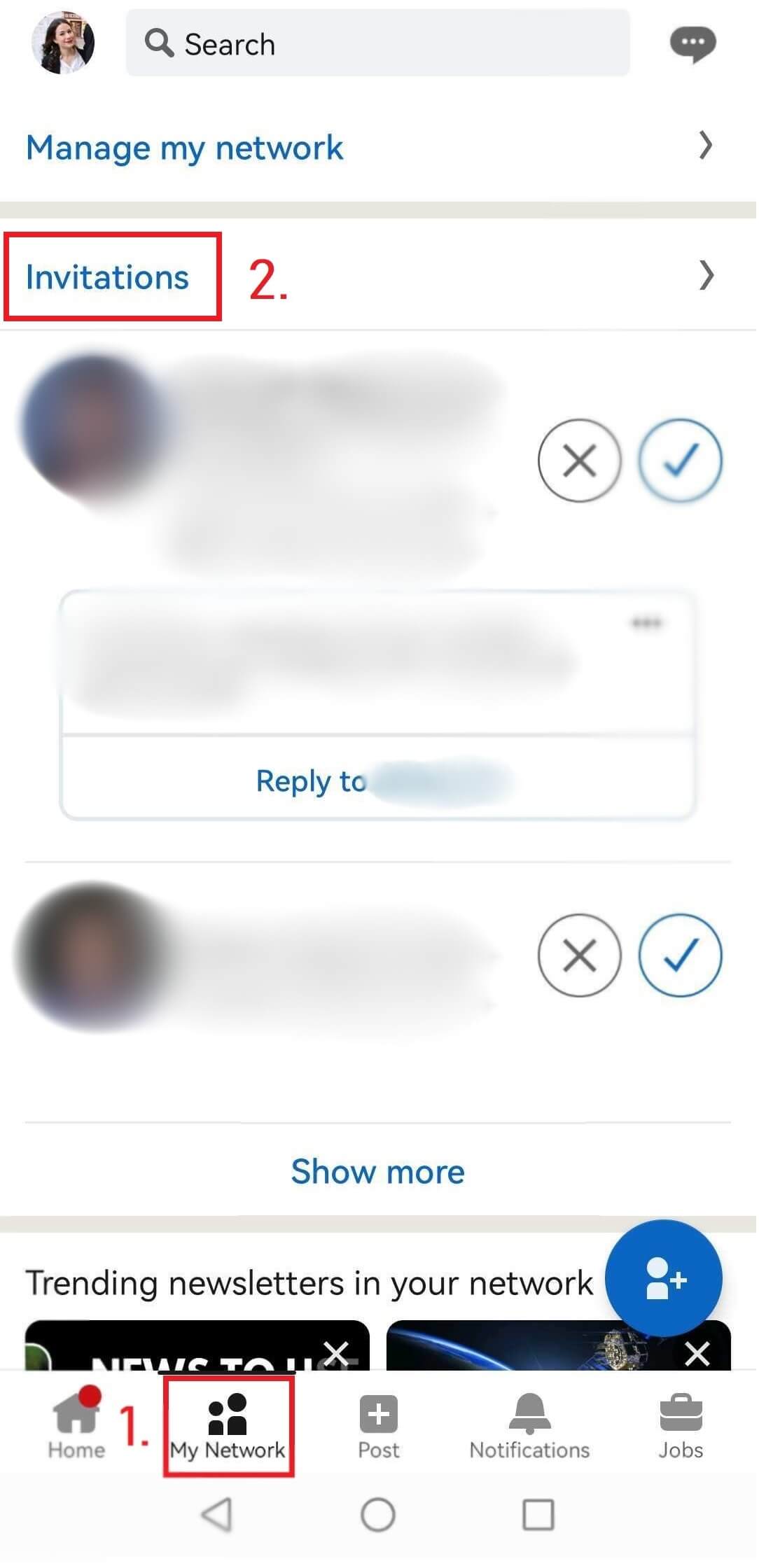
Next, click the Sent tab, and withdraw the invites you wish.
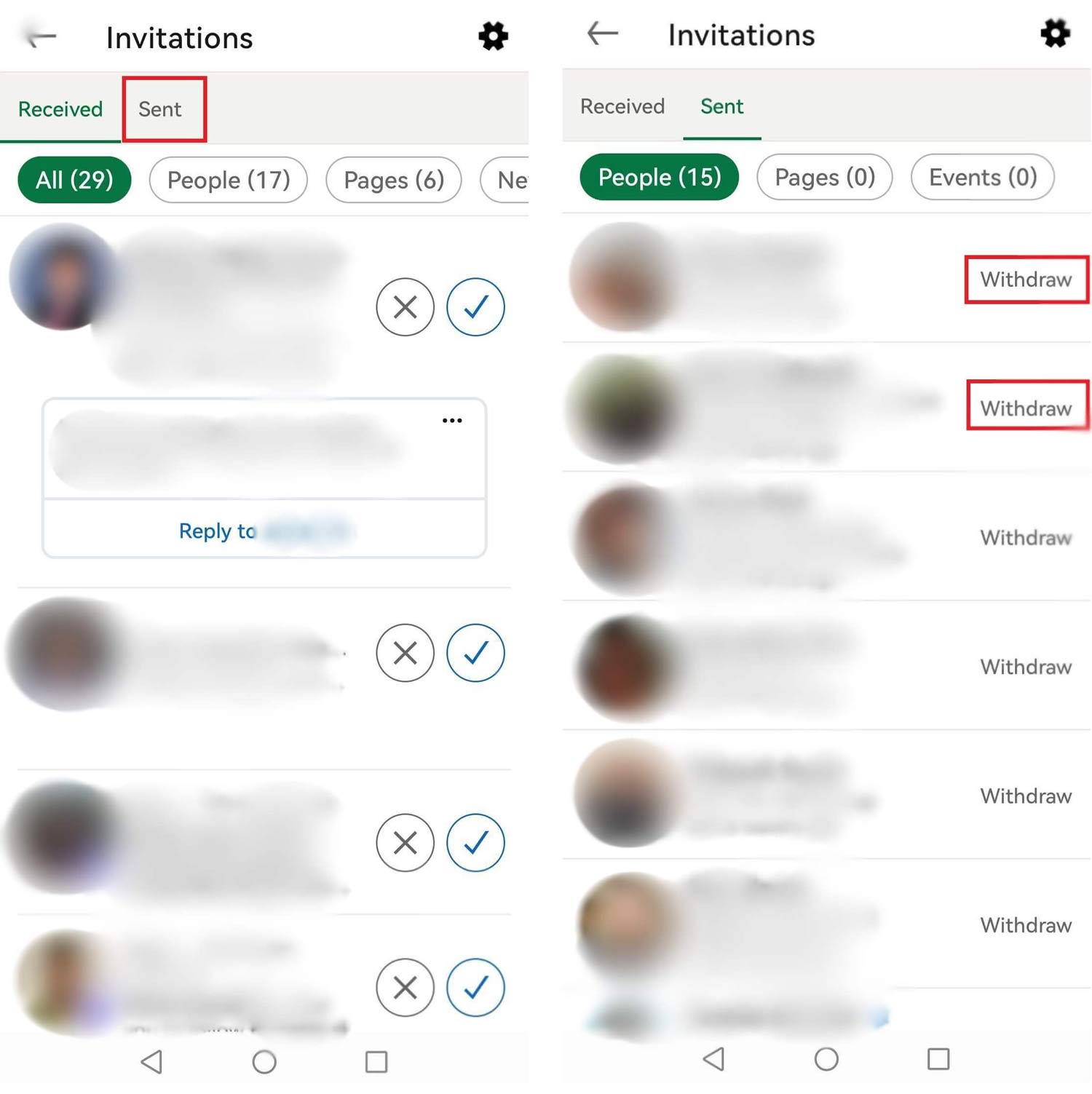
How to cancel LinkedIn invite on iOS
The process is somewhat different on iOS devices. So if, for example, you have an Apple phone, here is how you can cancel LinkedIn invite.
First, go to Notifications at the bottom of the screen. Then, click the Invitations button at the top. After the pop-up opens up, click View invitations you sent.
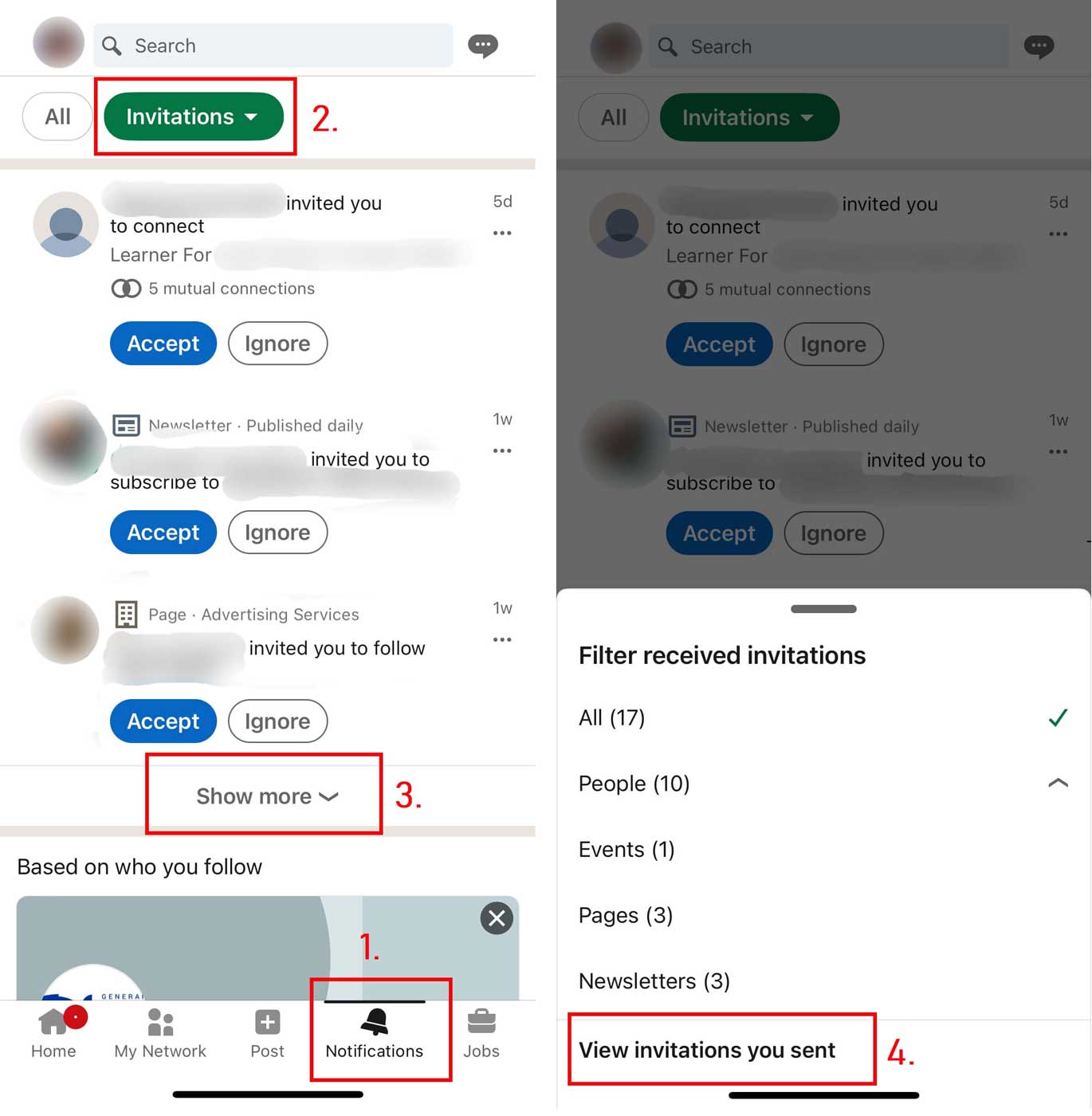
From there, choose the LinkedIn invites to withdraw and cancel them one by one.
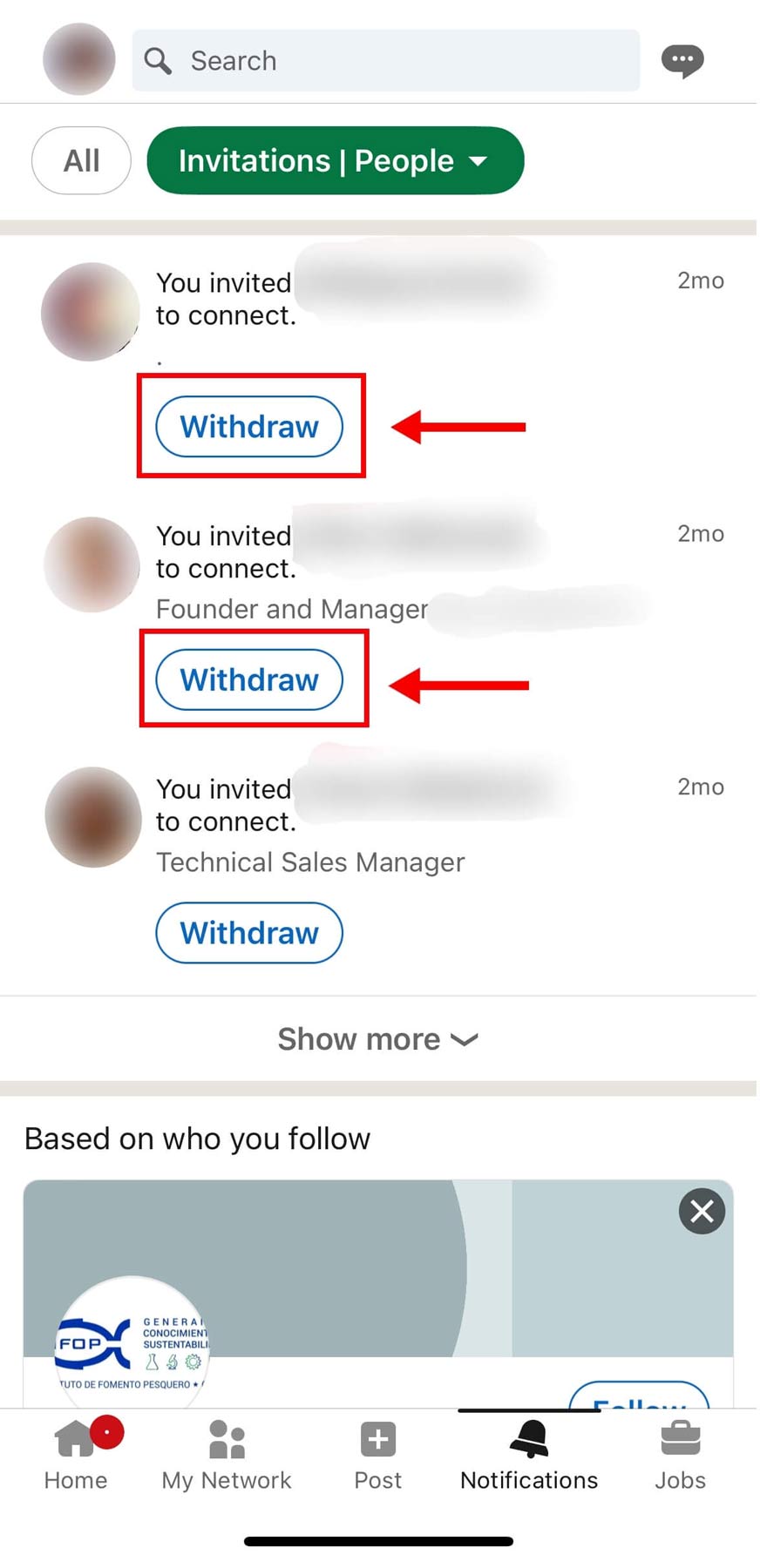
Why your LinkedIn invitations aren’t getting accepted
Speaking of connecting on LinkedIn, the best case practice is to connect with people related to you, your position, and your business industry. Naturally, if you are a salesperson or a recruiter using LinkedIn for lead generation, you’d go with your target group.
In the end, no matter who you wish to connect to and why, the goal is the same – to get the right message across and be accepted. However, there are numerous reasons why your LinkedIn invitations aren’t getting accepted or stay pending for a long time. So, to help you increase your acceptance rate, let’s first cover the possible reasons why this metric is not high at the moment.
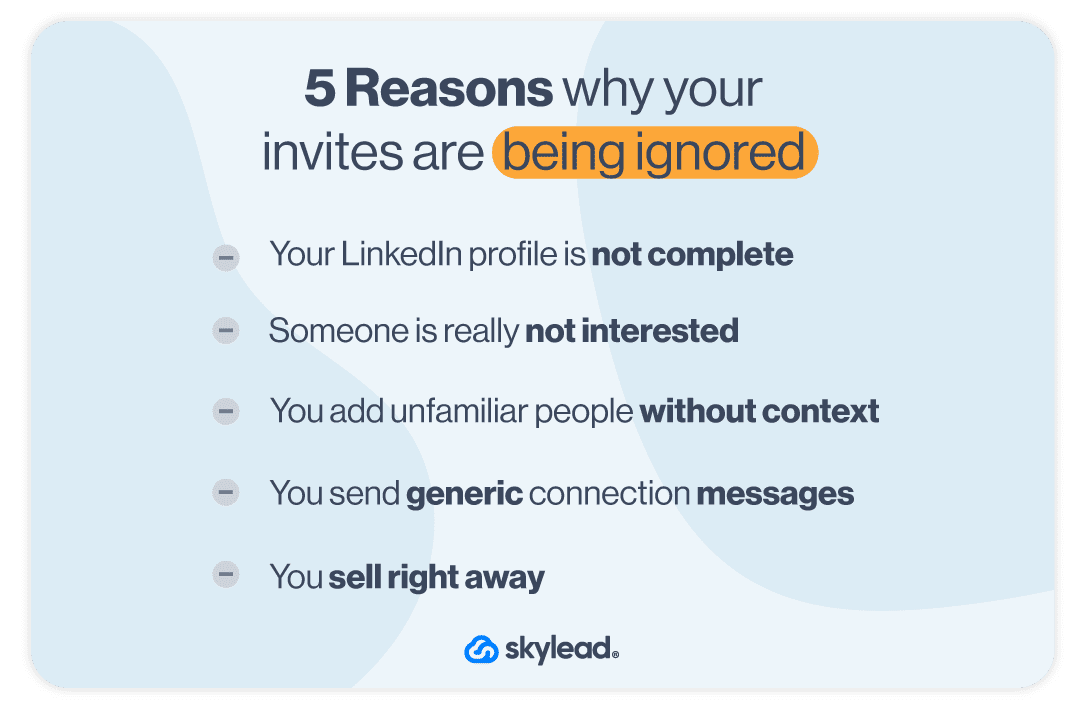
1. Incomplete LinkedIn profile
Sending invitations actively to users without previously setting up your profile is a huge mistake.
There are many profiles on LinkedIn that look like this, and you don’t want yours to be one of them.
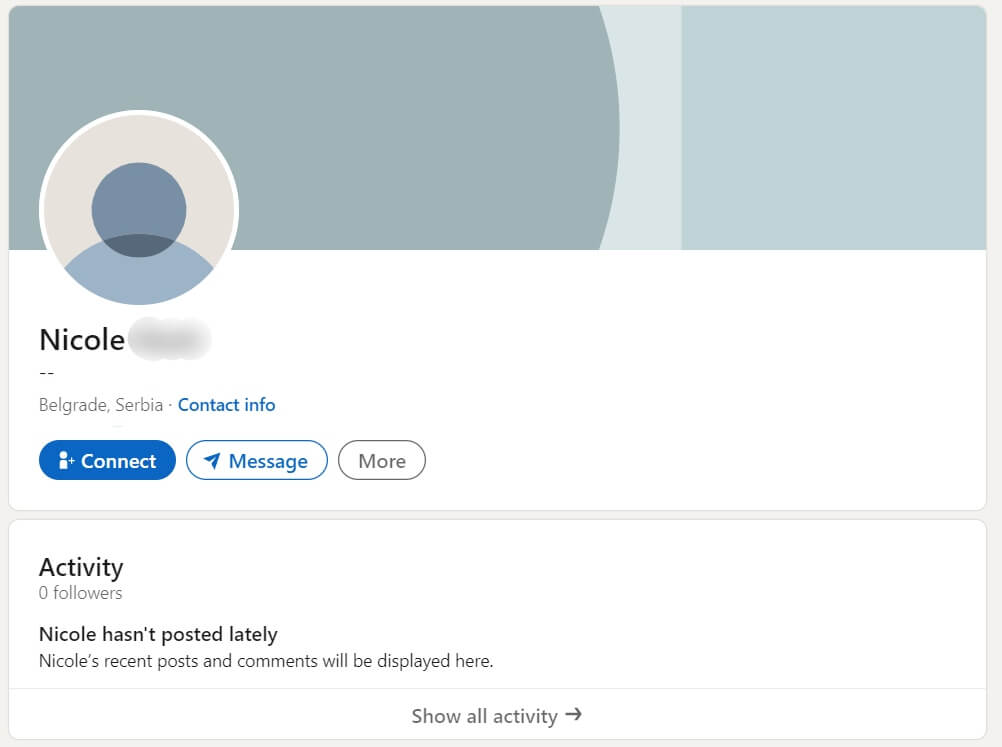
Start from yourself - would you accept an invite from this kind of profile? No, you wouldn’t.
If you have no photo, no description of any kind, and no experience details, no one on LinkedIn will take you seriously. Why would they want to connect with you without knowing who you are, right?
So if you send a request to someone with a profile like the one above, go back and cancel LinkedIn invite yourself. Then focus on setting up your LinkedIn profile first.
2. Someone is really not interested in accepting the invite
One reason may be that the user does not wish to connect with you and just prolongs declining your invite. I know - it’s like ripping off the band aid, but it had to be said.
3. Outreaching unknown people without context or common connections
This depends on the person, but some LinkedIn users don’t accept unfamiliar people. To clarify, those people sometimes see nothing they have in common with you, which makes them skeptical.
In this case, it’s good to have or reference a mutual connection, so they do not ignore your request.
4. Sending generic message requests
This mistake is the one that most LinkedIn users make. They think that writing something generic like “Hey, I’d like to connect with you” is enough to have their request accepted. Yeah, right!

These requests may be accepted in some cases, but not by a person who gets a lot of invites daily. Such people tend to get tons of messages that resemble yours and mostly ignore them. So, why would they make an exception for you?
What’s more, with this kind of message or no message at all, there is a chance the recipient can click the Ignore button and then the I don’t know this person option. With too many “I don’t know this person clicked“, you risk getting your account restricted by LinkedIn.
5. First touch selling
The chances of successfully selling something via the LinkedIn invitation request are close to zero.
You have probably received tons of invitation messages where someone is trying to sell insurance to you.
It is not the way sales work. Nowadays, it’s all about social selling and sales engagement, where building trust and delivering value come before the pitch.
In your invitation message, you should explain why you want to connect with the user you’re reaching out to, but not by trying to sell something. First, focus on personalizing, building normal human connections, and providing value before they buy anything you’re selling.
How to create engaging LinkedIn invites and boost acceptance rate
We cannot stress this enough. Before you even start creating and sending out your invitations, you need to optimize your LinkedIn profile first.
Almost every LinkedIn user will check your profile before they decide whether they should accept or ignore your invitation. That’s why it’s in your interest to give them a strong reason to accept your invitation, get value from you, and create a relationship.
After you’ve taken care of your profile, you’re ready to start inviting other users to connect. Here is our advice on how to do it more efficiently.
Prepare the ground for an invitation
It’s easy to connect with your colleagues or someone you know because those people know you personally.
However, even if you don’t know someone, you can try to remove that obstacle by becoming more familiar with that person. In other words, it’s good to start engaging with the posts of those potential connections.
Start liking their posts, create meaningful comments, and try to make a connection with them before sending an invite.
This will pave the way for you to build a relationship, and those users will start to perceive you as someone who is a valuable connection. Consequently, you won’t get in a position to cancel a LinkedIn invite that has been pending for a long time.
Personalize your invite messages
Before sending an invitation, make your messages as personalized as you can. It is a must if you want to improve your acceptance rate.
Sending personalized messages helps you leave a good first impression. Also:
- Addressing users by their names,
- Referencing something familiar to them,
- And avoiding generic phrases
play an important role in creating a strong relationship between you two.
Start by answering how you came across their profile and what made you want to connect. Don’t worry - the time you invest in LinkedIn prospecting your potential connection always pays off here.
Since you’re limited to 300 characters, you can use it to be more direct and honest.
Discover 20 ready-to-use connection invite templates with up to 78% acceptance rate.
Mention common interests
Adding many LinkedIn users who aren’t from your niche can decrease the quality of your LinkedIn feed and make it full of irrelevant content. That’s why connecting with someone that you share interests with is a great approach.
Mentioning the shared interests in your invite will show those users that you’ve invested some time into getting to know about them and their work. Moreover, you can mention the topic you wish to discuss with them. A message with these two elements will skyrocket your acceptance rate for sure. So, you won’t have to be in a position to cancel LinkedIn invite that has been pending for a long time. 😉
For example, start your message by commenting on your mutual job position, an event you both attended, or a post you both liked a while back.
Involve a little humor
It’s essential to have a professional tone of voice when you write your connection invite. However, “professional” doesn’t mean not having some sense of humor. You can always add a subtle joke here and there to make your invite stand out.
Moreover, using humor in your outreach is a nice pattern interrupt and has an immediate effect. Here is our example.
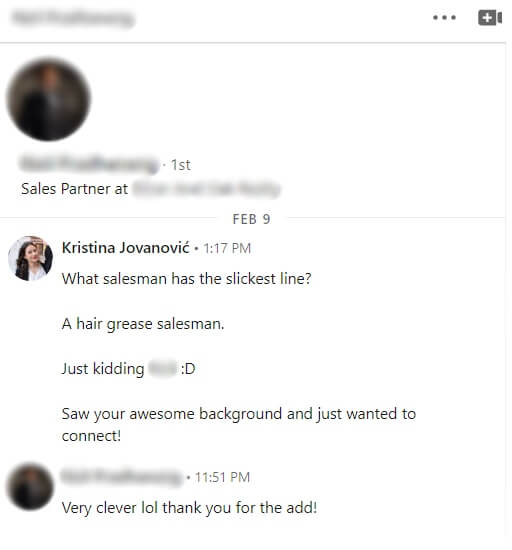
Check out our list of 35 position-related jokes ready to use in your outreach.
At the end of the day
We hope this article helped you understand why your requests have been pending for a long time and learn the tricks to improve the acceptance rate.
Remember: you must keep track of the requests you sent and clear the list on time. This is just so you don’t land on the LinkedIn radar for suspicious activity and get restricted.
That said, we recommend you invest time in your connection messages and your LinkedIn profile because, that way, you'll likely not be in the situation where you have to cancel a LinkedIn invite.
And if you wish to save 11+ hours a week, hours that you can better spend crafting winning messages and optimizing your profile, Skylead is here to help! It's the #1 sales engagement tool to use if you wish to optimize your sales processes.
Sounds good? Sign up for our 7-day free trial & take a glimpse at what it can do for you!
Disclaimer: Skylead is not affiliated, endorsed by, or connected with LinkedIn in any way.
Here are 13 proven LinkedIn InMail examples for 13 different LinkedIn scenarios to get you inspired and help you save the necessary time to compose compelling messages that get responses.
LinkedIn InMails are for many platform members a mystery, therefore underused and often wasted. That’s quite a shame, taking into account that, according to the official LinkedIn learning courses, InMails have an average response rate of between 18 to 25% compared to cold emails’ 3% average response rate.
For this reason, we’ve dedicated an entire resource to a detailed explanation of what LinkedIn InMails are, how many InMail credits each subscription plan has, how to check the status of your InMails, how to know whether you’re sending a free or paid LinkedIn InMail, and much more.
After you know this extremely useful LinkedIn feature to its finest details, check out our guidelines for writing a LinkedIn InMail that is likely to get a response and get inspired by the LinkedIn InMail examples shared below.
Some of the templates were directly used by our Sales Team in their outreach efforts, and some were directly inspired by our other teams’ examples used for LinkedIn lead generation, recruitment, and content promotion.
For more InMail examples, detailed outreach strategy, and sales templates for every step of the multichannel approach, check out our Sales E-Book: Sales Templates That Leveled Up Skylead. It is available for free download.
What makes a good LinkedIn InMail?
- Personalizing your InMails.
Not personalizing your InMails will make them look more like spam. Even if you wrote a compelling sales message and maybe even highly relevant to your lead, you MUST show that you’ve done your research. I mean, there’s no way to convey relevance by sending a generalized InMail anyway. This implies that personalizing your InMail should go beyond calling your prospect by name. Good LinkedIn prospecting starts with thorough research of who you are talking to and their pain points.
- Don’t make it all about yourself.
The 1900+ InMail characters at your disposal are not for self-promotion. Briefly introducing yourself and what your business is about can be beneficial for the outcome of your LinkedIn InMail. However, make sure it doesn’t take up all the space. Always focus on making it about the person reading the InMail.
- Investing time into coming up with a catchy subject line.
Think of a LinkedIn InMail as a cold email. Your open rate will depend on the LinkedIn inMail subject line and your response rate on how much relevance you manage to convey through the body of your email. But, we'll get to that later. For now, think about how to get your lead to open your InMail.
- Keeping it to a reasonable length.
Yes, we said that one of the LinkedIn InMail benefits is for sure its extensive character limit. However, this doesn't mean that you have to use all of it. Busy decision-makers that you are trying to reach out to via InMail are still very busy even when they do open your InMail. Practice the art of writing compelling and straight-to-the-point sales messages.
LinkedIn InMail template #1: Reach out to a potential collaborator
InMail example with variables
Subject line: Are you still providing {{service/product}} services?
InMail message:
Hey {{firstName}},
I am currently in need of a {{occupation}} in the {{industry}} industry. After doing some research, I came across your profile. I decided to reach out to you, due to {{reason}}.
Do you still provide {{service}} services?
If yes, I would love to discuss it further with you.
Thank you in advance!
Kind regards,
{{yourName}}
{{yourCompany}}
{{contact}}
LinkedIn InMail real-life example
Subject line: Are you still providing copywriting services?
InMail message:
Hey Jenny, I am currently in need of a copywriter in the SaaS industry.
After doing some research, I came across your profile. I decided to reach out to you, due to your vast experience in lead generation-related topics and your university degree in software engineering.
Do you still provide copywriting services? If yes, I would love to discuss it further with you.
Kind regards,
Edward Jones
LeadUp Technologies
edward.jones@leaduptech.com
This InMail template works because:
- It is clear that you’ve researched and picked a handful of LinkedIn members whose professional background you found relevant to the type of collaboration you need.
- You approached with a concrete reason and reference.
- Even if your lead is not interested in collaboration at the moment, it is always good to connect with someone who is a potential collaborator in the future.
LinkedIn InMail template #2 Invite your lead to an event
InMail example with variables
Subject line: Join us for {{event}}
InMail message:
Hello {{firstName}},
{{CompanyName}} is organizing the {{event}} event in {{location}} on {{date}}. Our goal is {{goal}}.
Since you work as {{occupation}}, I thought it would be interesting for you to check it out. Some of the main topics that will be covered are:
- {{topic1}}
- {{topic2}}
- {{topic3}}
If it sounds interesting, here are more details on the link - {{link}}.
In case you have any questions don't hesitate to contact me.
Best regards,
{{Name}}
{{Title}} at {{Company}}
{{Contact}}
LinkedIn InMail real-life example
Subject line: Join us for Best Digital Practices for 2023
InMail message:
Hello John,
TMS Advertising is organizing the Best Digital Practices for 2022 event in the Marriott Hotel on December 5, 2022. Our goal is to gather digital marketing professionals and discuss innovative digital practices and predictions for 2023.
Since you work as a Digital Marketer, I thought it would be interesting for you to check it out. Some of the main topics that will be covered are:
- 2022 tendencies expected to die out in 2023.
- Top challenges of 2022 digital marketers, and how to solve them in 2022.
- New types of influencers and how to approach them.
If it sounds interesting, here are more details on the link - http://www.bestpracticesevent2023.com.
In case you have any questions, don’t hesitate to contact me.
Best regards,
Jennifer Collins
Head of Growth at TMS Advertising
jencol@tmsadvertising.com
This InMail template works because:
- You’ve done the research, know who you are talking to and that the event can be of your lead’s interest.
- Mention their occupation to specify at whom the event is aimed Leads can work in different industries, yet it is their role/title in that specific industry that counts.
LinkedIn InMail template #3 Offer your service/product to a decision-maker
InMail example with variables
Subject line: Need help with {{problem}}?
InMail message
Hello {{firstName}},
We are currently helping {{companyType}} companies to {{service/product}}. I see that you are {{occupation}} at {{currentCompany}}, so I thought you might see the value in it.
{{product/service}} can provide the following for your business:
- {{problem1}}
- {{problem2}}
- {{problem3}}
However, our {{product/service}} is not limited to this!
I would love to have a chance to jump on a quick call and discuss each challenge you meet at your workplace that our {{product/service}} could help solve.
Have a great day.
Best,
{{yourName}}
{{occupation}}
LinkedIn InMail real-life example
Subject line: Need help with intent data?
InMail message:
Hello Steven,
We are currently helping SaaS companies to understand their audience and know exactly whom to target.
I see that you are the Head of Marketing at GetLeads, so I thought you might see the value in it.
DataCollector can provide the following for your business.
- Accurate analytics
- Increased on-site conversion
- Targeting specific prospects with ads
However, DataCollector is not limited to this! I would love to have a chance to jump on a quick call and discuss each challenge you meet at your workplace that DataCollector could help solve.
Have a great day.
Best,
Anna-Marie Peterson
Head of Sales
This InMail template works because:
- You reached out to a lead with a concrete reference.
- The person to whom you sent an InMail is a decision-maker. You’ve done your research and made a reference to it.
- Even if currently not interested in your product/service, they will probably still want to connect because it is the product/service that could be relevant for their business in the future.
LinkedIn InMail template #4 Content promotion
InMail example with variables
Subject line: To answer your question in {{group/post}}
InMail message
Hello {{firstName}},
I saw that you asked {{question}} in {{group}} / as a comment to {{name}}’s post, and I thought that the blog that we recently posted {{blogTitle}} could help answer your question.
Either way, I see that you work in the {{industry}} industry, and the content that we publish might generally be of your interest. If so, check it out here - {{link}}.
Let me know if you found {{blogTitle}} useful.
Best,
{{yourName}}
LinkedIn InMail real-life example
Subject line: To answer your question in Jane Durst’s post comment
InMail message:
Hello Susan,
I saw that you asked how to target leads attending a specific LinkedIn event as a comment to Jane Durst’s post, and I thought that the blog that we recently posted “How to target LinkedIn event attendees: A Full Guide” could help answer your question.
Either way, I see that you work in the Lead Generation industry, and the content that we publish might generally be of your interest.
If so, check it out here - www.leadgencontent.com.
Let me know if you found “How to target LinkedIn event attendees: A Full Guide” useful. Best,
Jane Johnson
This InMail template works because:
- You made a concrete reference to a comment a LinkedIn member left.
- The content you sent is relevant to their question and business/field of work.
- They are more likely to connect with you because your work is relevant to their business/industry.
LinkedIn InMail template #5 Reach out to a mutual connection by recommendation
InMail example with variables
Subject line: {{mutualConnection}} recommended I reach out
InMail message
Hi {{firstName}},
Our mutual connection, {{mutualConnection}}, and I were talking about {{topic/issue/specialty}}. I heard you are an expert on the issue.
I might need relevant insight on {{topic/issue/specialty}} for my business and would love to schedule a meeting with you. If yes, let’s connect on LinkedIn or you can send me an email to the address in the signature section.
Let me know what works for you.
Best regards,
{{yourName}}
{{contact}}
LinkedIn InMail real-life example
Subject line: Helen Goldberg recommended I reach out
InMail message:
Hi Jasmine,
Our mutual connection, Helen Goldberg, and I were talking about the difficulty and importance of building and maintaining an online presence of a business. I heard you are an expert on the issue.
I might need relevant insight on building and maintaining an online presence for my business and would love to schedule a meeting with you. If yes, let’s connect on LinkedIn or you can send me an email to the address in the signature section.
Let me know what works for you.
Best regards,
Justin Greene
justin.g@jbselectronics.com
This InMail template works because:
- The lead came to you as recommended.
- You made a concrete reference to a person who recommended the lead, and how their name came up.
- You are familiar with the person’s expertise.
- By expressing the need for concrete service/business help, your intention is clear.
LinkedIn InMail template #6 Reach out to a lead as a recruiter
InMail example with variables
Subject line: Loved your LinkedIn post on {{topic}}
InMail message:
Hello {{firstName}},
First of all, I loved your LinkedIn post on {{topic}}! It spurred me to reach out to you, as you seem to be the right fit for the position of {{position}} at {{company}}. I also see that you studied {{studies}} at {{university}} which I find to be a great asset to this role.
Anyways, as you may have guessed, I am a recruiter at {{company}}. I would love to take this conversation further in case you are interested. Here’s a link to the job description - {{link}}.
Please let me know!
Best,
{{yourName}}
{{Contact}}
LinkedIn InMail real-life example
Subject line: Loved your LinkedIn post on paid advertising on social media
InMail message:
Hello Nicolas,
First of all, I loved your LinkedIn post on paid advertising on social media! It spurred me to reach out to you, as you seem to be the right fit for the position of digital marketer at Jeffrey & Co. I also see that you studied Marketing at the University of Cleveland which I find to be a great asset to this role.
Anyways, as you may have guessed, I am a recruiter at Jeffrey & Co.
I would love to take this conversation further in case you are interested. Here’s a link to the job description - www.jeffreyco/careers/digitalmarketer.
Please let me know if you are interested.
Best,
Nancy Nicolson
n.nicolson@jeffreyco.com
This InMail template works because:
- You reached out with a concrete reference not only to the person’s education and/or experience but to their contribution to the LinkedIn community.
- It’s not just a random InMail, the person is truly qualified for the position and you are acknowledging it.
- Even if the person is not interested in the job offer, they will want to stay in touch with a recruiter who did not just randomly throw a link to a job post at them.
LinkedIn InMail template #7 Reach out to a recruiter for a specific position
InMail example with variables
Subject line: Inquiring about the {{occupation}} job opening
InMail message:
Hello {{firstName}},
I see that you’re the recruiter in charge of the {{occupation}} position at {{company}}.
As a {{occupation}} with over {{years}} years of experience in the {{industry}} industry, I am currently in search of {{positionType}} position in this sector.
I am interested in applying but would like to ask you a few questions first.
Let’s schedule a call.
Best,
{{yourName}}
LinkedIn InMail real-life example
Subject line: Inquiring about the Head of Sales job opening
InMail message:
Hello Tatiana,
I see you’re the recruiter in charge of the Head of Sales position at MTS Logistics.
As a Senior Sales Specialist with over 6 years of experience in the Transportation and Logistics industry, I am currently in search of a leadership position in this sector.
I am interested in applying but would like to ask you a few questions first. Let’s schedule a call.
Best,
Rosie Goldstein
This InMail template works because:
- You didn’t talk too much about yourself but highlighted the aspects of your career that are relevant to the position you’re applying for.
- There’s a hook, enough to schedule a call. On the call, you can discuss your qualifications, and also get the know the company and its culture.
- By sending this InMail, you will most likely stand out in the selection process.
LinkedIn InMail template #8 Reach out to a recruiter as a job seeker
InMail example with variables
Subject line: Inquiring about your {{department}}
InMail message:
Hello {{firstName}},
I saw that you are a recruiter at {{company}}.
I am a {{occupation}} with over {{years}} of experience in the {{industry}} industry, currently seeking new opportunities.
I’d like to schedule a call and further discuss my qualifications, as I am very open to hearing more about {{company}} and the dynamics of your {{department}}.
Best regards,
{{yourName}}
LinkedIn InMail real-life example
Subject line: Inquiring about your Sales and Marketing departments
InMail message:
Hello Miriam,
I saw that you are a recruiter at MTS Logistics.
I am a Lead Generation Specialist with over 10 years of experience in the Transportation and Logistics industry, currently seeking new opportunities.
I’d like to connect and chat to see if my background fits any of your openings.
I would like to schedule a call with you and further discuss my qualifications, as I am very open to hearing more about MTS Logistics and the dynamics of your Sales and Marketing departments.
Best regards,
Helen Rosenberg
This InMail template works because:
- You’ve done your research and know that your expertise could be relevant to the company to which recruiter you're approaching.
- The recruiter can tell you right away if they have a job opening or if you could potentially even be a fit for some positions.
- You included data that are relevant to the recruiter but didn’t talk about yourself all the time nor you said too much.
- You asked to schedule a call where you can obtain additional information about the company, and allow the recruiter to get to know you better.
LinkedIn InMail template #9 Invite industry professionals to join your community
InMail example with variables
Subject line: Invite to join {{communityName}}
InMail message:
Hello {{firstName}},
I would love to officially invite you to join {{communityName}}. It is a {{typeOfcommunity}} community aimed towards {{industry}} professionals with the goal of {{goal}}.
We would really love it if you joined. Your vast experience as {{occupation}} spurred me to reach out.
Here is the link - {{link}}, check it out and see.
Hope to see you there.
Have a great day,
{{yourName}}
{{occupation}}
LinkedIn InMail real-life example
Subject line: Invite to join Ads Growth Hacker
InMail message:
Hello Matt,
I would love to officially invite you to join Ads Growth Hacker. It is a Facebook community aimed toward advertising professionals with the goal of sharing knowledge, discussing current and past trends, and exchanging ideas on how to improve and grow your business through ads.
We would really love it if you joined. Your vast experience as an advertising manager spurred me to reach out.
Here’s the link - www.facebook.com/groups/adsgrowthhacker, check it out and see.
Hope to see you there.
Have a great day,
Michelle J. Spears
Director of Advertising
This InMail template works because:
- The lead’s occupation is relevant to the community. It is not just some random person you’ve invited to join your community.
- The community is relevant to the person’s occupation too.
- You briefly explained what the community is all about.
LinkedIn InMail template #10 Invite a guest speaker to your event
InMail example with variables
Subject line: Be our guest speaker
InMail message:
Hello {{firstName}},
I would like to use this opportunity to invite you to be a guest speaker at {{nameEvent}} event.
Due to your {{numberOfyears}} years of experience in the {{industry}} industry, we felt that your insight on {{topic}} would be an invaluable asset to the {{industry}} industry.
Here is a link to the organizer if you would like to check it out beforehand - {{link}}.
Please let me know if this sounds interesting to you.
Best regards,
{{yourName}}
{{title}}
{{contact}}
LinkedIn InMail real-life example
Subject line: Be our guest speaker!
InMail message:
Hello Ellis,
I would like to use this opportunity to invite you to be a guest speaker at the 2022 Online Sales Hacks & Tendencies event.
Due to your 8 years of experience in the Sales industry, we felt that your insight on the dying trends in online sales would be an invaluable asset to the Sales industry.
Here’s a link to the organizer if you would like to check it out beforehand - www.mpadvisory.com/events/educational/online-sales-hacks-tendencies.
Please let me know if this sounds interesting to you.
Best regards,
Joshua Henricks
Head of Training and Development
joshua.h@mpadvisory.com
This InMail template works because:
- You are making a concrete reference to the person’s years of experience and expertise. It points out that you’ve done your research and are not inviting a random person to be a guest speaker.
- There is a link to the event so the potential guest can inform themselves on the subject.
- Of the soft call-to-action at the end.
LinkedIn InMail template #11 Reach out to someone who’s using your competitor’s product or service
InMail example with variables
Subject line: {{competitor}} alternative
InMail message:
Hello {{firstName}},
The reason for my outreach is that I saw that your company {{company}} is using {{competitor’sProduct}} to {{mainPurpose}}.
{{yourProduct}} is {{uniqueSellingProposition}}.
If you would like to hear more about {{yourProduct}} and how it can benefit your business, I would be happy to chat with you.
Let me know!
{{yourName}}
{{contact}}
LinkedIn InMail real-life example
Subject line: FunkyMonkey alternative
InMail message:
Hello Jennifer,
The reason for my outreach is that I saw that your company FunkyMonkey is using SurveyGo to collect feedback on customer satisfaction.
UpSurv is also a customer-survey tool that has the option of exporting individual and all reports as a CSV file, comparing results among different data sources, and finding data matches.
These options speed up the entire survey and data analysis process 3 times. If you would like to hear more about UpSurv and how it can benefit your business, I would be happy to chat with you.
Let me know!
James Uri
jameruri@upsurv.com
This InMail template works because:
- You’ve done your research, and know that the company you are reaching out to uses your competitor’s solution.
- You’ve highlighted your solution’s unique selling propositions instead of just saying how your product is “better”.
- The InMail is wrapped up with a soft call to action.
LinkedIn InMail template #12 Value proposition
InMail example with variables
Subject line: Let me show you {{painPoint}}
InMail message:
Hello {{firstName}},
I heard about the amazing job your {{company}} has done by helping {{client}} {{result}}. Good job on that!
I wanted to reach out because {{whatYourBusinessSolves}}.
This way, you will be able to {{valueProposition}}.
I would like to show you my plan of {{personalizedHook}}. Let’s chat!
Best regards,
{{your Name}}
LinkedIn InMail real-life example
Subject line: Let me show you how you can get 3x more leads in less time
InMail message:
Hello Jimmy,
I heard about the amazing job your lead generation agency has done by helping Scavo's level up their business. Good job on that!
I wanted to reach out because our software takes care of time-consuming lead generation tasks and allows you to focus your efforts on finding quality leads and turning them into prospects for your clients.
This way, you will be able to manage more clients and make their companies grow more and faster. I would like to show you my plan of getting 3x more leads for your clients in 6h less a week.
Let’s chat!
Best regards,
Annie Matis
This InMail template works because:
- You’ve done your research and mentioned one of the biggest success stories of your clients.
- You connected your product with that story and showed them that their story could be even greater success with your solution.
- There’s a call to action with a concrete reference to what you can do for your potential client.
LinkedIn InMail template #13 Use InMail as the last resource
InMail example with variables
Subject line: Did I cross the line?
InMail message:
Hey {{firstName}},
I tried reaching you via email, so just wanted to check here one last time if I’ve crossed the line. Hopefully not.
Maybe it's me, but I get the feeling now is not the right time to connect.
As a parting gift, I wanted to share with you templates that could help you in your outreach {{gift}}.
I won't be sending you any more messages, don't worry.
All the best,
{{yourName}}
{{title}}
LinkedIn InMail real-life example
Subject line: Did I cross the line?
InMail message:
Hey John,
I tried reaching you via email, so just wanted to check here one last time if I’ve crossed the line. Hopefully not.
Maybe it’s me, but I get the feeling now is not the right time to connect.
As a parting gift, I wanted to share a templates that could help you in your outreach: www.skylead.io/templates.
I won’t be sending you any more messages, don’t worry.
All the best,
Nick Jefferson
Head of Sales
This InMail template works because:
- You tried multi-channel outreach, and nothing worked. That’s why you are using InMail as the last resource to reach your lead.
- There is a free resource included.
- You ask for an apology in case you crossed the line. People are more likely to either respond by saying that they haven’t seen your previous messages/emails/InMails or respond knowing you will not “bother” them anymore.
Frequently asked question
How can one tailor these InMail templates for highly specialized industries or roles to ensure relevance and increase response rates?
Tailoring InMail templates for specialized industries or roles involves researching the recipient's industry trends, challenges, and language. Incorporating this insight can make your message more relevant and compelling, thus increasing response rates.
What are the metrics or indicators to measure the success of these InMail strategies beyond the reply rate?
Beyond reply rate, success metrics for InMail strategies can include conversion rates (e.g., leads to meetings or sales), long-term engagement (follow-ups or continued conversations), and the growth of your professional network within your target industry.
Are there specific follow-up strategies recommended if the initial InMail does not receive a response, considering LinkedIn's limitations on InMail credits?
For follow-up strategies without a response, you should wait a few weeks before sending a polite follow-up InMail. Highlight new information or value you can provide while being mindful of LinkedIn's limitations on InMail credits to ensure efficient use. You can also check if a lead has an open profile. In that case, you can send free InMails without spending credits once a week.
Summary
With this blog, we’ve covered the main things you need for effective and smart use of a LinkedIn InMail, together with 13 LinkedIn InMail examples with a 25% reply rate formula for 13 different LinkedIn scenarios.
The above 13 LinkedIn InMail examples with a proven response rate can be used as they are or adjusted to fit your business goals.
Furthermore, if you wish to speed up your sales engement and put time-consuming tasks such as - finding the perfect path to your ideal leads, on autopilot, test out Skylead 7 days FREE of charge.
See how Skylead can help you focus on finding the qualified leads for your business and on closing the deal, while the platform thinks of the rest.
Disclaimer: Skylead is not affiliated, endorsed by, or connected with LinkedIn in any way.
According to the ManpowerGroup survey from Q3 2021, 69% of companies and talent acquisition specialists around the globe reported talent shortage. Moreover, according to Officevibe*, some top candidates have a 10-day window before landing a job.
Now, with the short time frame and a small pool to pick highly-qualified candidates from, talent acquisition specialists are in a difficult position. If they wish to hire the best employees, that is. This is more than enough reason to roll your sleeves and research talent acquisition and how to ace it.
So, if you wish to help your company, and find the best talent out there, then get ready for the jolly ride. We will uncover everything there is to know about talent acquisition and reveal tips to help you hire the best talent out there.

What is talent acquisition?
Talent acquisition is a process of recognizing and gathering the top employees for the company. In other words, talent acquisition means finding and nurturing the right employees according to the company’s needs.
The importance of talent acquisition has become evident to companies all over the globe, regardless the size. The reason is that talent acquisition specialists:
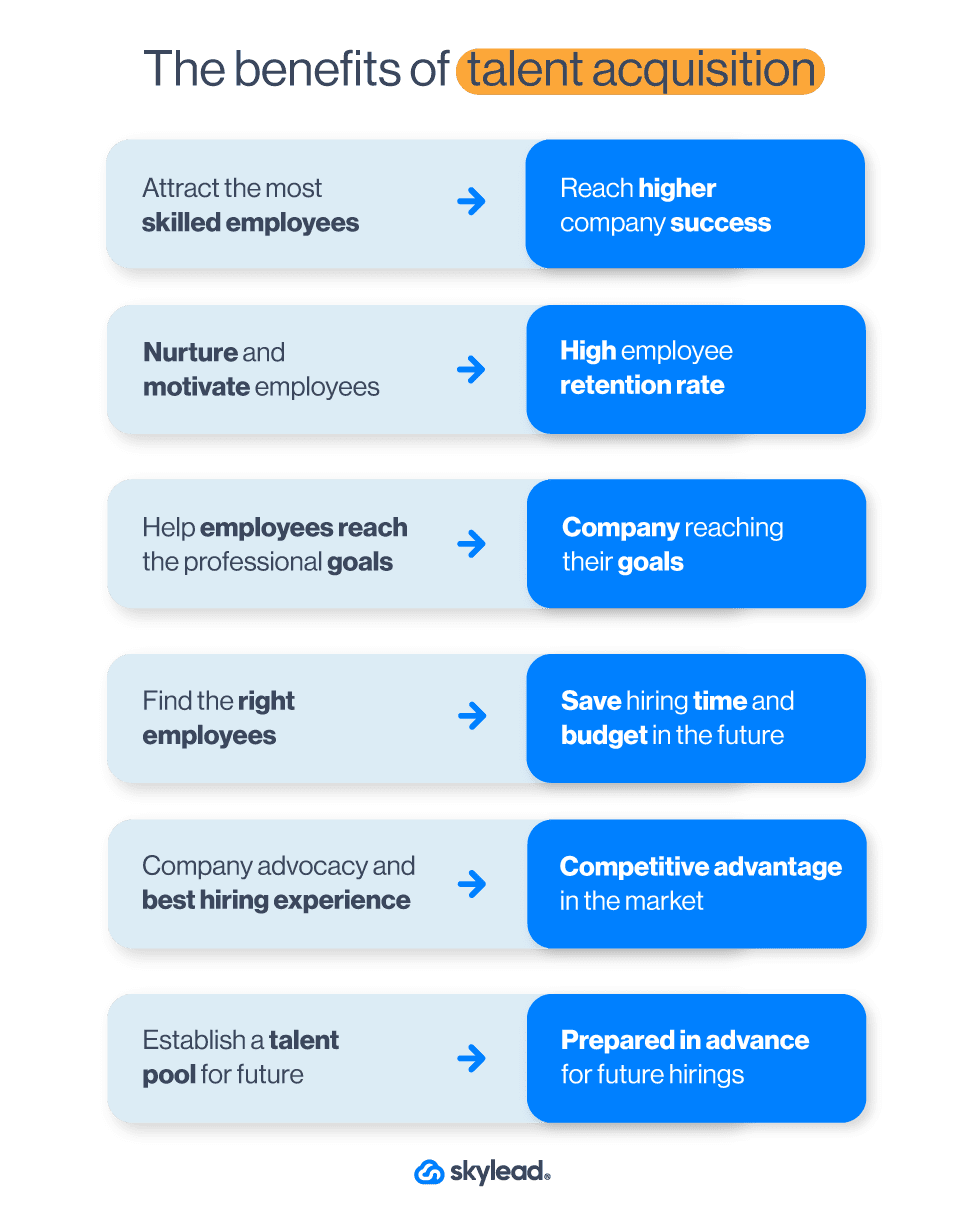
- Attract the most skilled employees on the market to fill the key roles according to company culture and strategy. This ultimately leads to the company’s improvement and reaching the desired results;
- Nurture and keep employees motivated, which leads to high retention rates and company advocacy;
- Develop and provide education to help employees reach their professional goals;
- Find the right employees and therefore save hiring time and money in the long run;
- Are advocates for the company and provide the best hiring experience, thus creating a competitive advantage in the labor market;
- Establish a talent pool for future hires, thus being prepared in advance.
And we just named a few 🙂
Recruiting and talent acquisition are often mistaken for one another. Yet, these two are the different sides of the same coin. Moreover, talent acquisition and recruiting may or may not be a part of the same sector. However, they are closely tied and cannot work without one another, which will cover in a second.
Talent acquisition VS recruitment
What is the Difference Between Recruitment and Talent Acquisition?
Talent acquisition is much more than just recruiting. It is a strategy on how a company should present itself in the labor market and become an ideal place to work in. Furthermore, the talent acquisition team is responsible for everything talent-related, including but not limited to:
- how to source the talent;
- supervise hiring;
- hire themselves in some cases;
- identify future leaders for the organization;
- lastly, they are responsible for screening candidates for leadership positions and the ones who need diversified training.
As opposed to the strategy, recruiting is the sole action of filling job vacancies and short-term company hiring requirements. In other words, recruiters:
- Find candidates or screen job applications;
- Interview candidates;
- Evaluate and select;
- Hire candidates.
What is a talent acquisition specialist and what do they need for a job well done?
So what does the talent acquisition specialist need to have for the job? First, they need to have a psychology background and to know their way around people. Secondly, they also need to know how to nourish relationships inside and outside the company. Thirdly, they need to keep employer branding at the highest level.
Another thing someone needs to have is strategic thinking and the ability to know what the company needs or will need in the future.
As their job is to find top talents, talent acquisition specialists need to know how to do their research. Moreover, they need to know how to track job search impulses, set candidate alerts, and find perfect candidates for the job at the right time.
Lastly, it is always handy to have a set of sales engagement skills for interviewing top-tier candidates. To clarify, the sales skills will help you get the employee who does not necessarily wish to change their job but would be just perfect for the role.
Process of talent acquisition
Talent acquisition includes the following stages:
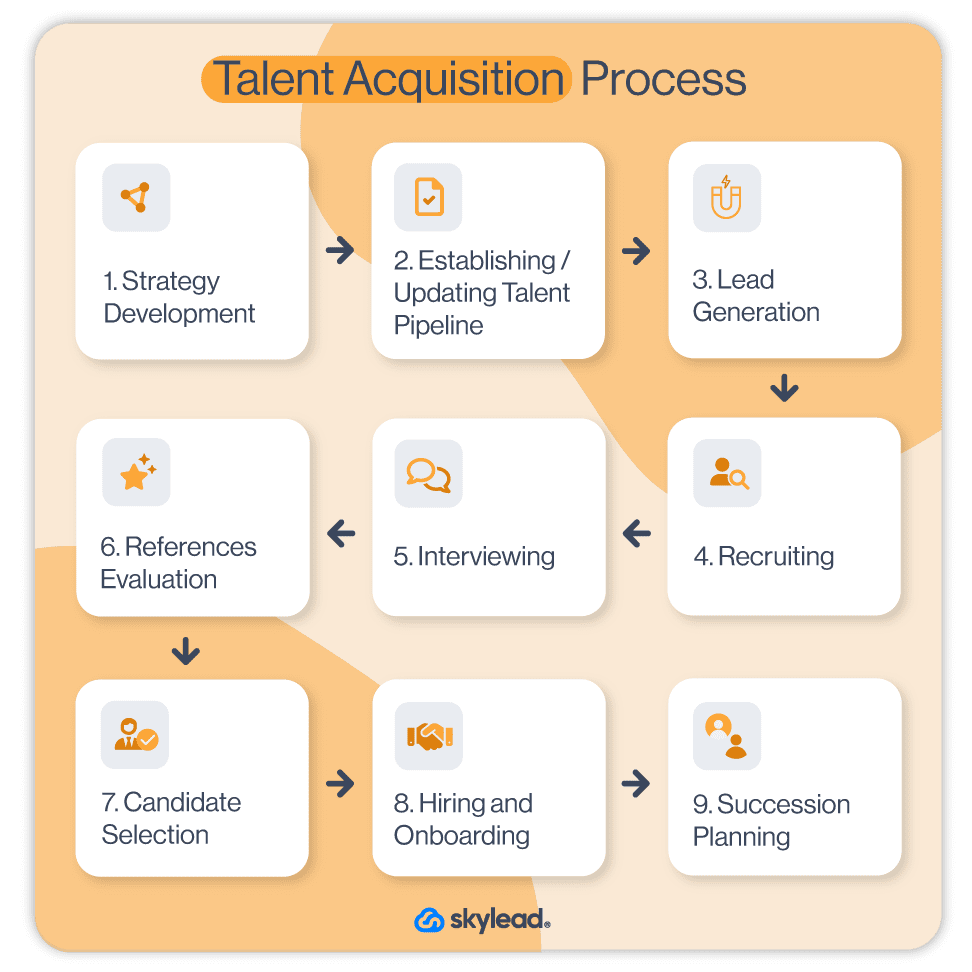
- Strategy Development
- Establishing/Updating Talent Pipeline
- Lead Generation
- Recruiting
- Interviewing
- References Evaluation
- Candidate Selection
- Hiring ( and Onboarding)
- Succession Planning
Let’s get into the details with every one of these activities.
1. Talent acquisition strategy development
Before developing any talent acquisition strategy, one must first define:
- The company’s position in the market;
- Budget available for talent acquisition activities;
- Who the competitors are;
- Competitors’ labor market behavior and their funding (if available).
Once you establish the previously mentioned, you can use that information to plan your strategy carefully.
There are two types of strategies that go hand in hand:
- Employer branding strategy
- Talent finding and acquiring strategy
The strategies can be any combination of activities. Participate in job fairs and universities, boost your employer's brand awareness and gather early talents, or referral programs, sponsor job fairs, and even outsource some parts of the process to RPO companies, for example. Only, whatever you decide your strategies are, be detailed, organized and mindful of your company’s industry, needs, and the budget.
2. Establishing talent acquisition pipeline
As talent acquisition strategy depends on talent pipelines, you need to create a mechanism to keep them full at all times. If your talent flow for every position in your company is continuous, you will always have someone to pick and choose from, should the need arise.
Otherwise, you need to discover what makes your pipeline “leaky” so you do not waste additional resources to fix the damage every time.
3. Lead generation
Once you have your strategies and talent pool in place, you need to define the online (and offline) channels you will use to find and generate your leads, aka candidates. Next, you need to write an alluring job post and an application form to start filtering out and identifying the best candidates. Lastly, distribute them across defined channels and according to your strategy.
4. Recruiting
If your company doesn’t have a separate recruiting sector, get ready to roll your sleeves. Recruiting is much more than just interviewing the candidates and choosing the right talent. Remember, they are also choosing you.
So apart from standard recruiting and evaluating the applications that landed in your inbox, you need to do something extra. Firstly, establish ways to create a positive experience for your candidates. Secondly, nurture them throughout the process. Lastly, keep the relationship with those who are not currently your ideal match but someday they might be.
5. Interviewing
This is where your psychological background and sales skills really shine. When interviewing the candidates, talent acquisition specialist should ask a series of questions related to:
- the candidate's specialty;
- problem-solving skills;
- resourcefulness.
And not to forget, they need to figure out if the candidate has skills for any current or future positions.
Interviewing is usually held between 2 to 4 instances, depending on position seniority. However, talent acquisition specialists are trying to shorten the number of instances to provide as pleasurable an experience as possible.
6. References evaluation
Talent acquisition specialists often forget to cross-reference the information their candidates provide during the interview. Reference evaluating can provide another perspective on your candidate, confirm your thoughts and opinions, or provide additional information you wouldn’t find anywhere else.
7. Candidate selection
Talent acquisition specialists and recruiters lean on many metrics and systems to make data-driven decisions and select the top candidate for the job. Some of them include candidate scoring, internal evaluating systems, and even software that can do that for them. So be sure to research these systems and choose one which works best for both you and your company.
8. Hiring and onboarding
In some companies, talent acquisition teams also onboard new employees. Thus, apart from showing them around the office, or workflow, talent acquisition specialists are responsible for establishing new relationships. That said, incorporating efficient Applicant Tracking Systems (ATS) can greatly facilitate talent acquisition specialists in streamlining the onboarding process, ensuring new hires are integrated smoothly into the company's ecosystem.
9. Succession planning
The last activity that talent acquisition specialists need to do is succession planning. a process of identifying and finding substitute candidates for the leadership roles within the company in case something unexpected should happen or in case of retirement.
Succession planning is beneficial due to several reasons. Firstly, the company is always ready for any unexpected events. Secondly, it encourages employee development within the organization. Lastly, succession planning allows filling the roles quickly without losing much of the workflow.
14 Tips and best-case practices to improve talent acquisition activities
1. Minimum requirements
When creating a job description, it’s best to define the minimum and the maximum requirements someone needs to have to be qualified for the initial interview. To clarify, the reason for the minimum requirements is that you might meet someone who doesn’t have the highest experience you need, but they might have it in the future.
This means you can put them straight into your talent pool and contact them at a later stage. Or perhaps the person with less experience is a perfect match according to other company parameters (e.g. cultural, behavioral), as opposed to the one with the maximum requirements.
2. Collaborate with other sectors
Every sector and job position within the company has its specialties and expressions different from what the talent acquisition team uses. It’s okay not to know them all, as long as you keep collaborating with the rest of the company during the previously mentioned process for individual positions.
3. Write job post that is alluring
With each vacancy comes a special job description. So, be aware of what kind of talent you wish to draw to your company and write job posts to appeal to them. Spice it up with some benefits, perks, and employer branding testimonies, and you’ll be good to go for initial lead generation.
4. Remote or hybrid workspace
To stay competitive in the labor market, you must keep up with the trends. And one of the most popular trends now is precisely Remote or Hybrid workspace. Be mindful of this, and if your company doesn’t offer a fully remote position, at least offer a hybrid position, so you don’t lose top talents over this.
5. Where to build a pipeline?
Different talent acquisition teams use different platforms to help them build their talent pipeline and keep track of the candidates. That said, the most widely used is LinkedIn Recruiter or Recruiter Lite, which allows you to get candidates inside the pipeline with just one click and to the appropriate pipeline stage.
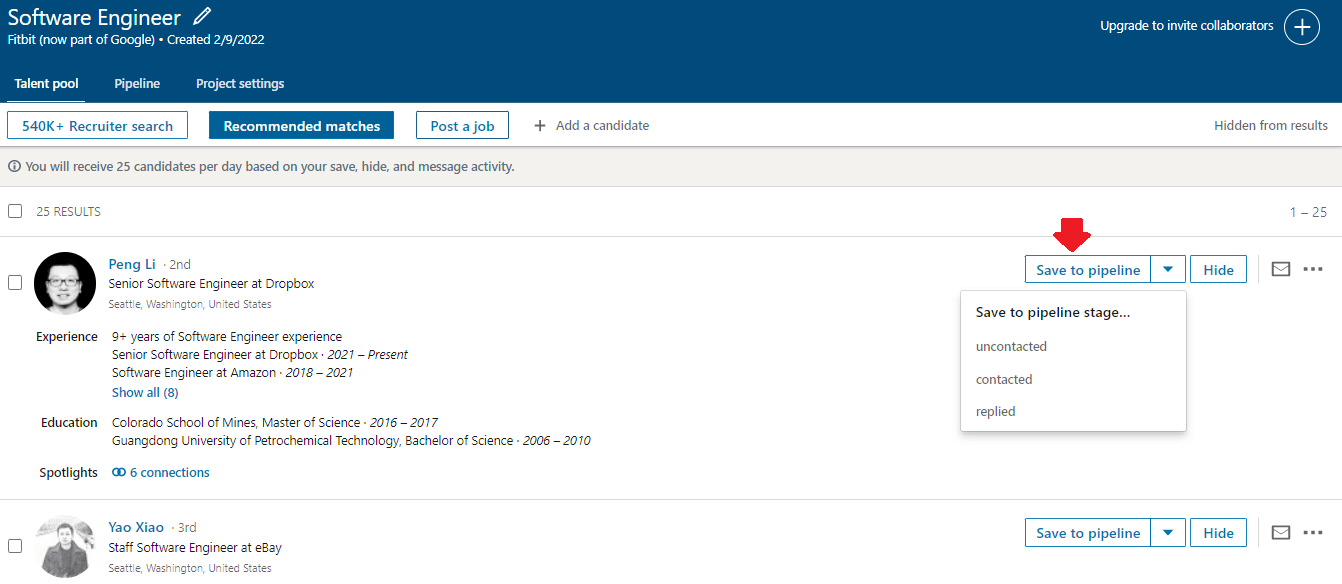
6. Include your co-workers in the process
It’s nifty to discover alternative ways to find and generate your candidates. However, remember that you, as a talent acquisition specialist, are not alone in your company. Thus, think about creating a referral program for your employees.
Your co-workers are the next best thing to know what kind of personnel your company needs, and if you set proper awards, you are more likely to find the right candidates quicker. After all, there is a “Six degrees of separation*” theory stating that any person can be connected to any other person in the world through six intermediaries at most.
7. Don’t rush
Finding the right employee is not an easy task, especially if we talk about C-suite positions. Thus, take your time and do not rush any activity. If you are thorough and dedicate time to each part of the talent acquisition process, you will save resources in the future.
For example, most talent acquisition specialists use LinkedIn Recruiter, and the one thing they never rush is filtering the right candidates for the job. Thus, take advantage of every LinkedIn Recruiter filter and take your time zeroing in on the candidates you will reach out to.
8. Research your candidates
If, for example, you use LinkedIn to find candidates, you should consider the following advice.
Firstly, to laser-target your candidates, be sure to specify your search as much as possible. In other words, use filters to import the most relevant skills needed for the role.
Secondly, when looking at LinkedIn profiles, observe the diversity of interests a person has. The information you find will contribute to your company and imply what you need to do to achieve employee satisfaction.
Thirdly, if you are searching for the people to fill in higher-up roles, be sure to analyze the skills they possess that served them in the previous positions that can be usable for the one you are reaching out to.
Lastly, if, for example, you're searching for a team leader for your programming team, you might consider how the team could contribute to the team leader’s development.
9. Personalize your messages
Nobody likes getting generic emails, nor will your ideal candidates for the top-level job. Thus, to provide the best experience for your candidates, make sure to personalize your outreach according to their resume or LinkedIn profile. For example, include their name, position, or the skills that stood out to you the most.
10. Don’t forget to proofread
Typos, wrong names, and grammatical errors in your email can come across as unprofessional and can put your company in a bad light. So, to avoid this, edit, proofread your messages, and double-check contact information for any mistakes before sending.
11. Timing is everything
Good timing is a desired virtue for talent acquisition specialists to have. Timing to recognize and outreach candidates at just the right time according to their job search impulses.
However, there is one other timing equally if not more important than that - responding to your candidates on time. If you wait too long, especially if you hire management roles, you risk losing your candidate’s interest and someone else taking them over.
12. Choose your questions carefully
Sometimes the candidates won’t be as direct as you would like them to be. So, to get the information, you need to get creative during the conversation. The best-case approach here is to ask so-called probing questions to specify their response. In other words, you can ask them a series of questions like:
- Tell me, how did you manage a group of people to achieve the best productivity throughout the day?
- What objectives did you set for the group?
- How did you motivate them?
- What was the most difficult part of this task?
In addition, take note of what the candidate asks you in return, how they prioritize their interest for the role, and what they are curious about the company (benefits, conditions, market share, organization culture, etc.).
13. How should talent acquisition team choose the best candidate?
Selecting the right candidate for the job can be a hard decision for a talent acquisition specialist. If you are lucky, you can pinpoint the person you wish for your organization. However, what to do if you have two or more top talents in your hand?
Hire them all 🙂
Jokes aside, here is what you can do to ease your decision.
The first thing you need to pay attention to is authenticity and synchronicity between the candidate's personal preferences and the information you get from the interview. In other words, analyze verbal and non-verbal communication, and the thought process and write your observation down.
The other thing you can also do is to walk the candidates through questions about personal preferences of informal, trivial topics and get to the main questions later. Using this method, the candidate could reveal themselves through potential incoherence.
Once you have all data in place, choose the candidate with the smallest amount of discrepancy and highest compatibility.
14. Honesty is the best talent acquisition strategy
Somehow in the business world, we always come back to honesty, and talent acquisition is no exception. I mean, have you heard about Microsoft’s promise to disclose salary ranges in January 2023?
Many talent acquisition specialists are true advocates for honesty, and there are major reasons for that. Firstly, it adds to the authenticity. Talent acquisition specialists often share why they work in a particular company, their motives, and what motivates them the most to be where they are. This way, candidates can see the true passion in the conversation and wish to work in that company, as well.
Talent acquisition specialists and recruiters thus act as a live banner of the company. If the candidates do not resonate with the passion, it’s best to reveal it from the start - it will save you so much time in the future.
So, keep in mind that being honest and believing in your company is one of the best things you need to show to your candidates. Not only will you filter and acquire the best candidates, but you will also contribute to the Employer branding strategy.
Lastly, your honesty and passion will be such a strong argument that negotiations and whether someone wishes to work for the company won’t even be a question anymore.
Summary
Talent acquisition and the labor market are one of the most changed segments due to technological development in the last couple of years. Apart from company Goodwill, talent acquisition sectors are the ones that represent a company directly to the outside world.
Speaking from the company’s point of view, it pretty much became a standard to have talent acquisition specialists simply because of all the benefits it comes along: from resource savings to reaching higher goals by finding a perfect match and employee satisfaction.
However, none of it comes without the talent acquisition team’s hard work and activities that involve:
- Strategy Development
- Establishing/Updating Talent Pipeline
- Lead Generation
- Recruiting
- Interviewing
- References Evaluation
- Candidate Selection
- Hiring ( and Onboarding)
- Succession Planning
And let’s not forget that our trusted talent acquisition specialists are the go-to guys for everyone in the company. They are somewhat of our genie in the bottle for professional development.
Nonetheless, talent acquisition specialists can perfect their craft by following the tips and best-case practices mentioned above. Lastly, people are dynamic, so if you, as a talent acquisition specialist, help others develop their talents, don’t forget about yourself.
Wish to discover how to streamline your talent acquisition process? Check out Skylead and schedule a Demo!
